Six road trips to see the best of Germany's countryside
Jul 29, 2023 • 6 min read
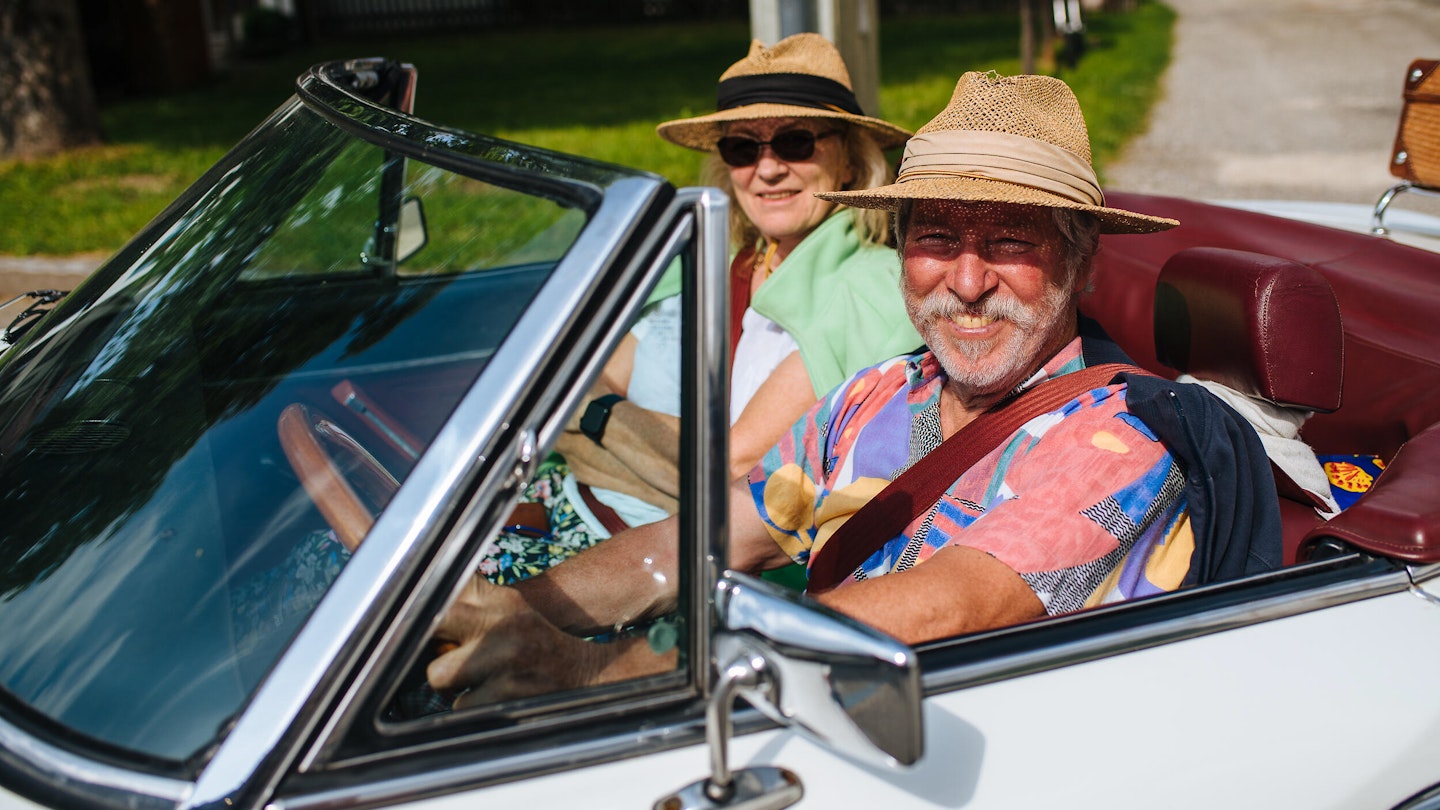
Germany is the perfect European country to road trip in, with manicured roads and incredible scenery © Lukas Bezila / Lonely Planet
Germany , birthplace of the autobahn , is a wonderful country for driving tours. It’s big and varied enough to allow longer, more ambitious trips, yet has plenty of small, distinctive regions begging for in-depth exploration. Throw in a superb road network (including over 13,000km of autobahnen ), an orderly and predictable driving culture and a wealth of rental options, and you’ve got everything you need for a driving holiday.
It’s also increasingly easy to minimize the carbon emissions of road trips in Germany. Electric vehicles are freely available from the many car-rental and -sharing operations vying for your custom, and most parts of the country are well served for charging infrastructure (check PlugShare for the closest options).
The road trips suggested below are given approximate distances, suggesting meandering, scenic itineraries between their start- and end-points, rather than direct drives. Read on for six best road trips taking you through the best of Germany.


1. The German Baltic Coast
Best road trip for beaches and islands
Lübeck-Binz; approximately 417km (259 miles); allow three to four days
Germany’s share of the southern Baltic Coast is adored by locals, but curiously under appreciated by international visitors. This scenic driving route strings together historic maritime cities of the Hanseatic League (a medieval confederation of trading ports) like Lübeck , Wismar and Stralsund , Greifswald plus the natural splendor of places like the Darss-Zingst Peninsula . Expect sandy beaches, historic architecture and opportunities to island hop (some islands like Rügen are accessible by bridge).
Planning tip: Seasonal variations are extreme in Germany’s far north. If you're heading here in winter, rather than summer, be prepared for bitter cold winds and the potential for snow.
2. The Fairy Tale Road
Best for fans of the Brothers Grimm
Hanau-Bremerhaven; approximately 707km (439 miles); allow five to six days
Starting in little Hanau, birthplace of famous folklorists, the Brothers Grimm, the popular Fairy Tale Road runs north through Marburg, with its handsome Altstadt ; Kassel, home to 560 hectares of stunning Unesco-listed baroque parkland known as the Bergpark Wilhelmshöhe ; Bodenwerder , home of the "Liar Baron" von Münchhausen; and Hamelin , of Pied Piper fame. With more than 60 stops along the way, this route can be tackled by public transport, but a car lets you fully explore any diversions at your own pace.
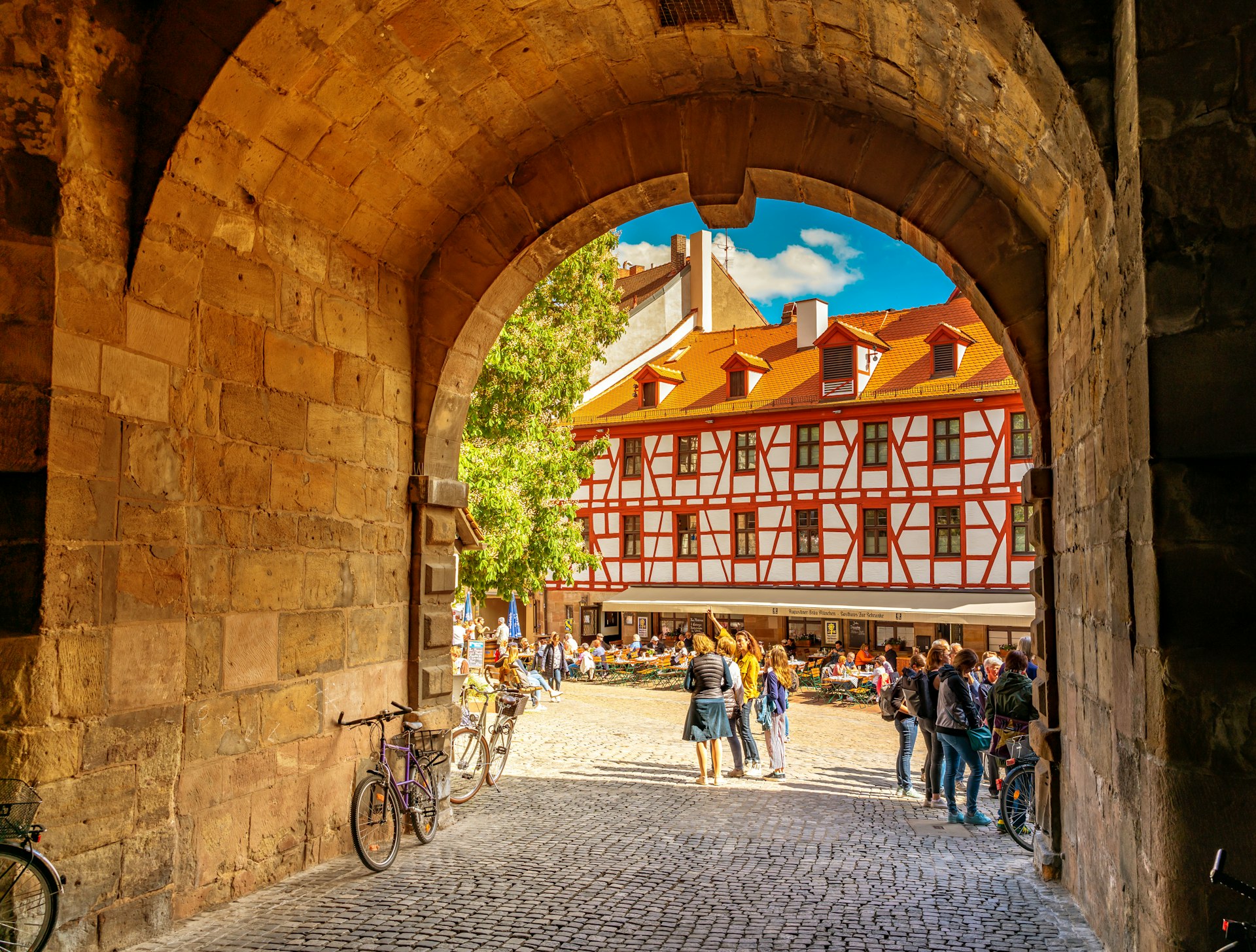
3. The German Castle Road
Best for medieval castles and baroque palaces
Mannheim-Bayreuth; approximately 600km (373 miles); allow four to five days
The towns and countryside between Mannheim and Bayreuth retain some of southern Germany’s most impressive medieval castles and baroque palaces. Particularly notable piles include the Barockschloss Mannheim , the largest baroque palace in the country; the Renaissance ruin of the Schloss Heidelberg ; the 14th-century Burg Guttenberg , looming over the Neckar Valley; and Nuremberg’s imposing Kaiserburg , which dominates its carefully reconstructed Old Town. If palace fatigue sets in, you can always escape to a contemporary art gallery, fascinating local museum, or settle into a traditional tavern to sample the local sausages and beer.
Planning tip: If you’re intending to linger in Nuremberg, you’ll get excellent value from a Nürnberg Card , available in advance from the website, and delivered to your email. Just €33 gets you 48 hours of unlimited public transport, free admission to the major sights and museums and 50% discount on activities such as tours of the underground tunnels and bunkers of Nürnberger Unterwelten .
4. The Romantic Road
Best for picture-perfect German landscapes
Würzburg-Schwangau; approximately 350km (217 miles); allow three to four days
The Romantic Road , a sublime meander through the Germany of popular imagination, is one of the country’s best drives. Its combination of sublime Bavarian landscapes, medieval villages, historic centers and alpine foothills pretty much ticks all the boxes. Of particular note are the Würzburg Residenz , a Unesco-listed baroque palace built for the local prince-bishops; the impossibly photogenic and gloriously intact medieval town of Rothenburg ob der Tauber ; the complete medieval walls, towers and gates of the similarly ravishing Dinkelsbühl; and the romantic excesses of Neuschwanstein and Hohenschwangau castles (the former famously used as the model for the castle in Disney’s Sleeping Beauty ).
Planning tip: It’s best to avoid touring the Romantic Road in the height of the summer school holidays when the region can be a victim of its own popularity. If you do this trip in winter, Bavaria's chocolate-box towns look even prettier under a layer of snow.
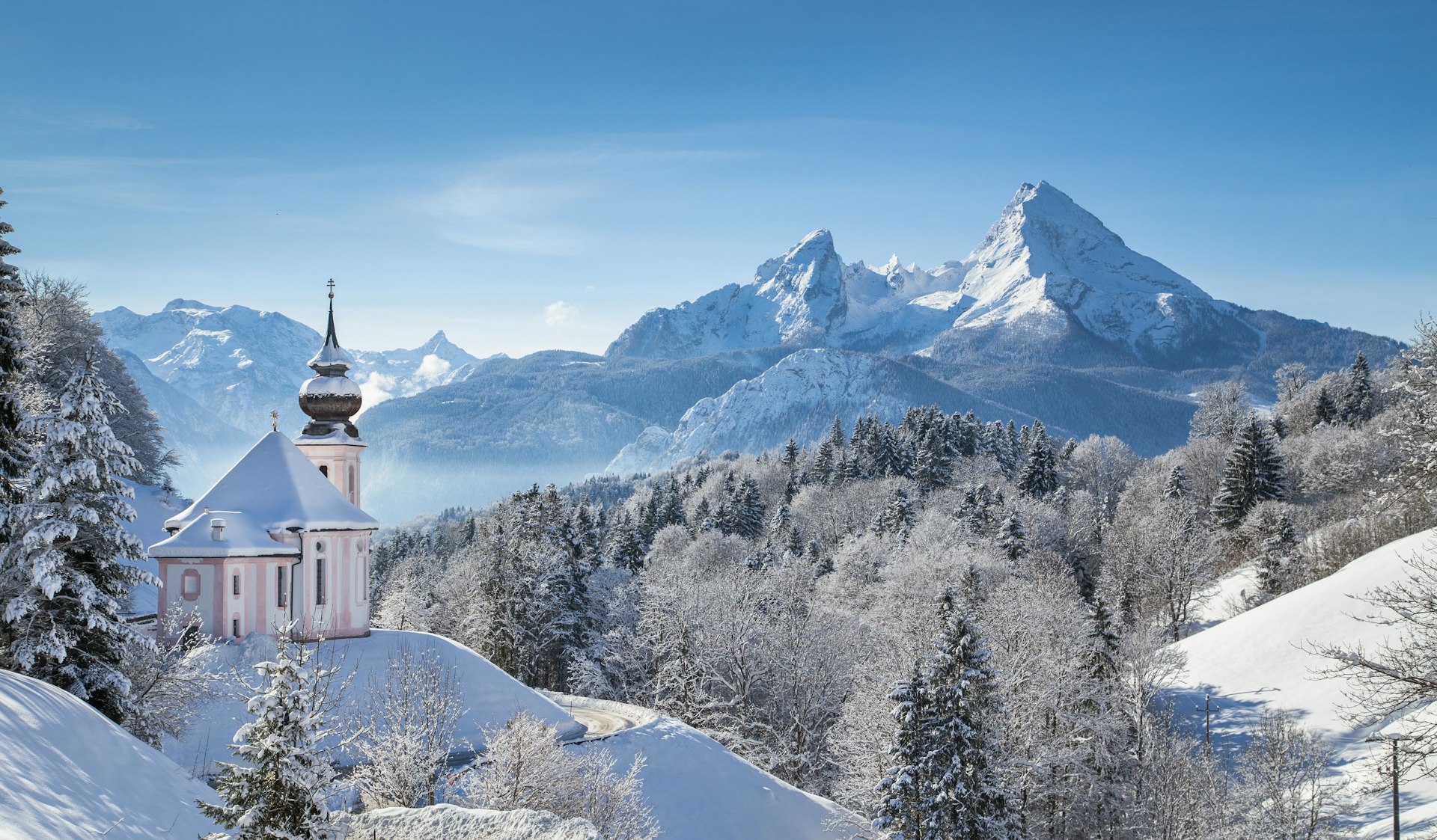
5. The German Alpine Road
Best for stunning scenery, spa towns and mountain lakes
Lindau-Königssee; approximately 450km (280 miles); allow four to five days
Skirting the mountainous border with Austria , this is the perfect road trip for those with a head for heights. From laidback Lindau on the southern shores of glittering Lake Constance to the mountain-framed waters of the Königssee in Berchtesgadener Land , it’s a procession of towering summits, alpine pastures, peaceful spa towns and glittering mountain lakes. Greatest hits include the sumptuous Schloss Linderhof ; the high-altitude honeypot of Garmisch-Partenkirchen ; and boat trips on the ravishingly photogenic Königssee itself.
Planning tip: Be prepared for snow and ice on high roads in winter; anticipate potential road closures and ensure your car hire includes extra such as chains.

6. The German Wine Route
Best for wineries and gastronomy
Schweigen-Rechtenbach-Bockenheim an der Weinstrasse; approximately 96km (59 miles); allow one or two days
Germany’s north-western Palatinate (Pfalz) region is rightly famed for its vineyards, forests, villages and castles. The short, well established German Wine Route takes in the best of the country’s biggest contiguous wine-growing area, including the Hambacher Schloss , known as Germany’s "cradle of democracy"; the appealing market-square and gastronomic excellence of diminutive Deidesheim; and the parks and hot waters of the spa town, Bad Dürkheim.
Tips for driving in Germany
Driving in Germany is a dream. The roads are excellent, as is road signage, and you’ll generally share the road with predictable and considerate drivers. The driving culture is law-abiding and pleasantly lacking in surprises. Here are some key dos and don’ts while road-tripping in Germany.
- Wear a seatbelt and stick to speed limits (30km/h in residential streets; 50km/h on main city streets; and 100km/h outside built-up areas, unless otherwise marked) – both are enforced in Germany, and speed cameras are ubiquitous.
- Make sure your vehicle is up to your chosen route, whether that means the high speeds on the autobahn or steep slopes and winter conditions on the German Alpine Road .
- Make use of the Allgemeiner Deutscher Automobil-Club (ADAC), Europe’s largest motorists’ association. Its site is full of information on driving routes, road laws, vehicle maintenance, accessibility issues and more.
- Don’t exceed the permissible blood-alcohol limit whilst driving – 0.05% (which is about one to two standard drinks only).
- If you can avoid driving in larger cities, where traffic is stressfully dense and parking scarce and expensive.
This article was first published August 2020 and updated July 2023
Explore related stories
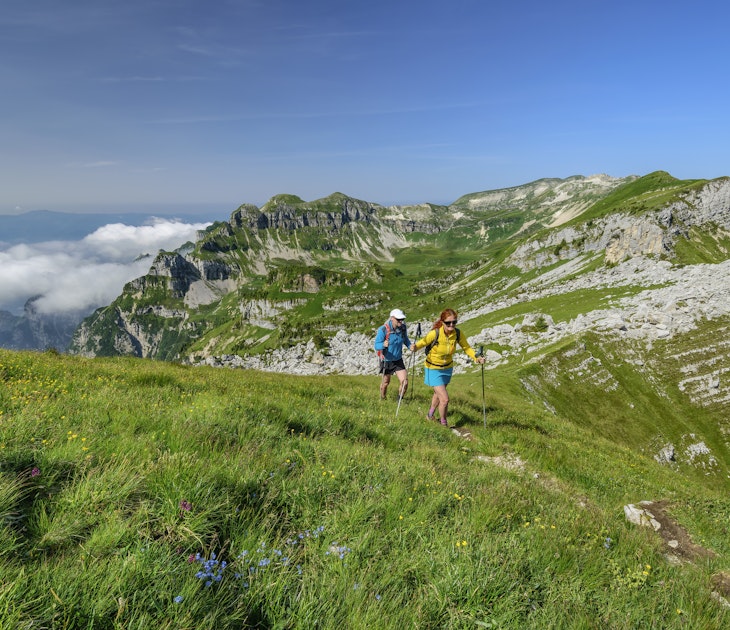
Mar 14, 2024 • 16 min read
Experience some of Europe's best wildlife, nature and landscapes this summer at these national parks.
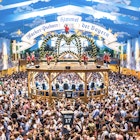
Feb 23, 2024 • 5 min read

Jan 19, 2024 • 11 min read

Jan 16, 2024 • 8 min read

Jan 5, 2024 • 20 min read
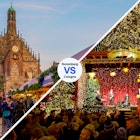
Nov 17, 2023 • 6 min read

Nov 13, 2023 • 6 min read

Nov 7, 2023 • 4 min read

Nov 6, 2023 • 5 min read

Nov 1, 2023 • 15 min read

- X (Twitter)

Germany Road Trip – The Perfect 7-10 Day Germany Itinerary
Are you looking for a Germany road trip itinerary? Or are you wondering what to do in Germany?
A trip to Germany allows you to see half-timbered houses, fairytale castles, dark forests and bustling cities. You get the chance to try traditional German food, visit stunning palaces and drive on the Autobahn , the highway without speed limits.
We want to show you where to go in Germany and how to plan your trip. This Germany road trip planner does not just help you discover the best of the country, we also give you lots of travel tips. As we are both living here, we know the country well and can tell you precisely what to look out for. Keep reading and start planning your trip now!
Table of Contents
General Advice
About this itinerary for germany.

If you only have around ten days or even less, you won’t be able to see all of Germany. That is why we have focused our post on a Southern Germany road trip. You’ll see lots of famous tourist attractions, like Neuschwanstein Castle, but you’ll also go off the beaten road when visiting the UNESCO pile dwellings at Lake Constance.
We have written this travel itinerary for Germany for 10 days, but you can easily adapt it if you have less time. Skip one day in Frankfurt at the beginning and try to see the highlights of the city on your last day. We would also advise you to skip the hike to Lake Schrecksee and drive onwards to Lake Constance from Neuschwanstein Castle instead.

Last, you can save an additional day by either skipping Würzburg or Blaubeuren. They are both fantastic places to visit, but if you’re pressed for time, you can always come back later to see them.
As an alternative, you can also turn this itinerary into a Frankfurt to Munich road trip. Start from the end, visit the Black Forest, Lake Constance and Neuschwanstein Castle and end your trip in Munich.
Also, this itinerary starts in Frankfurt. The airport of Frankfurt is one of the biggest in Europe, so you should find it easy to fly here. If it’s easier for you, you can look for flights to Munich and start your trip there. This itinerary is a round trip through Germany, so you are free to jump in at any time.
How to rent a car in Germany

We highly recommend that you book your rental car before you come to Germany. During the high season, prices can skyrocket, and it’s often much cheaper to reserve a car in advance.
Among the best websites to do so are rentalcars.com and Discovercars , as they compare prices from different rental car companies. This is much faster than going to the websites individually to find the best price! Plus, you can specifically search for offers that include insurance, and you have lots of filters that help you find the terms and conditions you want.
On the note of insurance, third-party liability insurance is mandatory in Germany, so it has to be included in your offer. However, we recommend covering any damage to the rental car as well, as otherwise, in the case of an accident, you might face high costs.
Click here to search for a rental car in Germany now!
When searching for a car, make sure to double-check the mileage conditions. Some companies offer contracts that include only a limited amount of kilometres. While it may seem cheaper at first, every additional kilometre will cost you so much that it’s usually not worth it.
Also, if you want to start your South Germany road trip in Frankfurt and finish in Munich (or vice versa), you need to specify that you are going to drop off the car in a different location. It might cost you a little extra, but if you have limited time, it’s going to be worth it as it saves you another day of driving.
When to visit Germany

As we just mentioned, you can visit Germany at any time. That said, some seasons are nicer than others.
Summer is generally a good time for a trip to Germany. The weather is great, and it’s fun to spend time outside. As a downside, you’ll run into lots of other tourists, and this is usually the most expensive time of the year.
As an alternative, you could visit during the shoulder season in spring and autumn. The weather starts getting better in May, and you can still experience warm days in September and early October. You’ll also see far fewer tourists than in summer.
In winter, you’ll likely encounter much more rain than during the other seasons. The trees drop their leaves, which can make regions like the Black Forest look slightly desolated. That said, you have the chance to experience some of Europe’s best Christmas markets in December, and you might also encounter snow in winter.
How to get to Germany

For this itinerary, you can either fly to Frankfurt or Munich. Frankfurt’s airport is bigger, so you might find better deals to go here. It’s best to check out both cities, though, so you can find the best deal.
When searching for flights, we usually use websites like Skyscanner that allow us to compare lots of airlines at the same time. It’s very useful for finding a good deal, so go and check out flight prices now .
Germany road trip itinerary – Discover the best of Germany
Days 1-2: frankfurt.

Start your road trip in Frankfurt.
Frankfurt is not just the financial centre of Germany; it also features an Old Town full of half-timbered houses, a pretty riverside and lots of traditional pubs where you can spend your evenings.
We suggest taking your first day easy (especially if you had a long flight) and then spending a whole day in Frankfurt afterwards. Even though this is not enough time to see everything, it allows you to get a good glimpse of the city and its main attractions.
If you only have one week in Germany, skip Frankfurt and pick up your rental car at the airport. You can visit the city’s main attractions at the end of the week when you return here. However, if you’re going to see Germany in 10 days, then you can wait to pick up your car and enjoy your time in Frankfurt first.

Highlights of Frankfurt:
- Römerberg and the Old Town: The half-timbered houses surrounding Römerberg are amongst the most impressive you can find in Germany. After World War II, most of this neighbourhood was in ruins. Fortunately, the city decided to reconstruct the historic houses, so you can admire them today. Make sure also to take a look at the Town Hall. If you need any further information, you can find the tourist information there.
- Eiserner Steg: Did you know that Frankfurt is the only German city with that many skyscrapers? From the bridge Eiserner Steg , you have one of the most iconic views of the skyline. It’s especially lovely in the evening when the sun sets behind the high buildings.
- Apfelwein: The local speciality of Frankfurt is called Apfelwein , which translates to “apple wine”. It’s a drink similar to cider but with no gas and a slightly more tart aftertaste. The best place to try it is on the Southern side of the river Main, in Sachsenhausen. Here, you can find many Apfelwein pubs, which can also serve you traditional foods from the area.
- Visit a museum: Frankfurt is home to lots of great museums. Our top picks include the Städel Museum, which houses an impressive collection of art, the Goethe House, which is the birth house of the famous writer and the Palmengarten. While the latter is technically not a museum but the city’s botanical garden, it is well worth visiting.
Where to stay in Frankfurt

When planning a trip to Germany, we highly recommend that you look into hotels before you leave. Especially in summer, hotel rooms tend to book out, and prices go up if you wait for too long.
If you’re visiting in winter, you don’t need to worry too much. Nevertheless, for peace of mind, it’ll be great to have a hotel reservation already by the time you land in Frankfurt.
There are many great neighbourhoods for your stay in Frankfurt . However, since you only have a bit more than one day, we recommend you pick a hotel in the city centre. That way, you’ll be close to the city’s main attractions.

Here are our favourite picks for this area:
Mid-Range: The Moxy Frankfurt City Centre has the perfect location. From here, you can reach Römerberg and the river Main within a few minutes. The rooms are stylish and the beds comfortable, so what else could you wish for? Click here to check out prices and reviews!
A little more comfort: The Hotel Steigenberger Frankfurter Hof has a history of more than 100 years. It dates back to 1876 and is well-known for its elegant and classic interiors. You can find a Michelin-starred restaurant in the hotel as well as a fantastic spa – perfect for relaxing at the end of the day. Find out availability and prices now!
Budget : It’s challenging to find a decent budget hotel in the centre of Frankfurt. Nevertheless, the Hotel Scala Frankfurt City Centre offers affordable rooms and is only a few minutes away from the main pedestrian zone. When it comes to value for money, this hotel is one of the best. Read reviews and book your room now!
Day 3: Würzburg

This morning, take your rental car and drive to Würzburg. The first leg of your round trip around Germany is short, and as a highway connects Frankfurt and Würzburg, it should only take you an hour and a half.
In Germany, the Romantic Road is one of the biggest tourist magnets, especially for international visitors. It starts here in Würzburg and connects many traditional towns and villages with highlights like the Würzburg Residence. While you’re not going to follow it for this trip, it is worth checking out if you ever return to Germany.
For now, though, focus on Würzburg. Besides the Residence, a fantastic palace designated as a UNESCO World Heritage Site, you can find many more attractions here. Hike through vineyards, explore the Old Town and drink a glass of local wine on a historic bridge.

Highlights of Würzburg:
- Würzburg Residence: The Würzburg Residence is one of the most beautiful baroque palaces in Germany. After visiting the inside, make sure to also stroll through the gardens. They are gorgeous in summer, but you can also admire the symmetry in winter.
- Marienberg Fortress: On the hike up to Marienberg Fortress, you come past many vineyards and viewpoints. From the top, you then have a fantastic view of Würzburg. If you’re not too tired yet, join one of the guided tours of the interior and explore the Princes’ Hall and the Treasury.
- Old Main Bridge: Explore the Old Town on foot and then end your day with a glass of wine on the Old Main Bridge. While German wine might not be that well-known internationally, the wineries in Würzburg produce some pretty good wine that they sell on the bridge. Go and grab a glass! If the weather is nice, you’ll find many locals joining you to enjoy the evening.
Where to stay in Würzburg

We highly recommend that you book a hotel close to the city centre of Würzburg. That way, you can make the most of your time in this city and can walk home after having a glass of wine in the evening.
Here are a few options:
Mid-Range: The Franziskaner is known for its clean and modern rooms and its excellent location close to the Würzburg Cathedral. You can find public parking opposite the hotel, and it’s only a short walk to the Old Main Bridge. Click here to read reviews and check availability and prices !
A little more comfort: The Hotel Würzburger Hof offers beautifully decorated rooms close to the city centre. Reviews often mention the friendly and helpful staff, so go and check it out yourself !
Budget: It’s not easy to find a decent budget hotel right in the city centre of Würzburg. The Mainviertelhof, on the other side of the river Main, is a good option, and you can often find great deals here. Click to see availability and prices for your stay !
Day 4: Blaubeuren & Munich

Today, you’ll drive all the way to Munich. Instead of going the shortest route or following Germany’s Romantic Road, though, take the highway A7 south towards Ulm and stop in Blaubeuren.
Blaubeuren is famous for the Blautopf, an impossibly blue pond. If you leave Würzburg early enough and don’t get caught in a traffic jam, you can also visit one of the nearby caves.
Highlights of Blaubeuren:
- Blautopf: This natural wonder is a must-see during your stop in Blaubeuren. Limestone particles make this pond shimmer in bright shades of blue and green. The colours are most beautiful in the morning, but it’s worth coming here at any time of the day. While the Blautopf looks like a small lake, it is much deeper than you would imagine. Twenty-two metres below the surface, you can find an entrance into a giant cave system.
- Blaubeuren Abbey : Next to the Blautopf, you can find the Blaubeuren Abbey. For a small entrance fee, you can visit the inside. Make sure to also stop by the Bathhouse of the Monks, which you can find behind the abbey. The wall decorations are very unusual, and you’ll get a great insight into how the life of the monks must have been hundreds of years ago.
- Hohle Fels Cave : This cave is a short drive from Blaubeuren, but if you have enough time, make sure to stop here. Humans have sheltered in this cave for around 65,000 years, and archaeologists found the oldest instrument in the world here. If you want to see the instrument (and more man-made exhibits from about 40,000 years ago), make sure also to visit the URMU museum in Blaubeuren.
After having stopped in Blaubeuren, continue your Germany round trip by driving to Munich. Depending on traffic, it takes around two hours to get here. In German, the city is called München, so don’t be confused if you never see any road signs mentioning Munich!

Where to stay in Munich
Stay in one of the hotels close to the centre, so it’s easy for you to explore the city the next day. As you have a whole day in Munich, make sure to book a stay for two nights.
Here are some good options:
Mid-Range : From Hotel Haus im Tal, you can reach the city centre in just a few minutes. The rooms are beautifully decorated, and the staff is very friendly and helpful. Click here to book your stay now !
A little more comfort : If you want maximum comfort, stay at the Vier Jahreszeiten Kempinski München. The hotel offers stylish rooms with lots of extras and amenities, a fantastic spa with a sauna and a gym. If you want to learn more, click here to read reviews and find out everything the hotel has to offer !
Budget : Hotel Eder provides clean and simple rooms close to the Old Town. Deals often include buffet-style breakfast, giving you excellent value for your money. Check out rates and availability on booking.com !
Day 5: Munich

Today, you have a whole day to explore Munich. The biggest city in Southern Germany offers lots of historic buildings, majestic palaces and the perfect chance to try traditional Bavarian food.
Highlights of Munich:
- Marienplatz : Munich’s central square is one of the best starting points for exploring the city. Here, you can find both the old and the new town hall, a fountain and the Mariensäule, a column to the Virgin Mary that dates back to 1638. If you stop here at 11 am or noon, you can see the mechanical figures on the front of the New Town Hall move and dance to a song.
- Nymphenburg Palace : Even though you only have one day in Munich, try to make it to Nymphenburg Palace. The splendid interior is well worth a visit, and you could spend hours walking through the gardens. As you’re short on time, opt for a brief stroll instead or go for a gondola ride on the canals that surround the palace.
- English Garden : This massive park in Munich is a favourite for both locals and tourists. In summer, it’s an excellent location for a picnic, but it’s fun to come here at any time of the year. Don’t miss the Chinese Tower, a 25-metre-high pagoda, and make sure to stop by the Eisbachwelle to see local surfers right in the middle of the city.
- Hofbräuhaus : Munich is the perfect place to try traditional Bavarian food. While you’ll see some typical German food all over the country, the state of Bavaria is famous for some dishes you can only find here. If you’re travelling to Germany for the first time, we recommend that you try the Weißwurst with pretzel or go for the Schweinshaxe, the pork knuckle. Both are very traditional dishes. The Hofbräuhaus, a beer hall that dates back to 1589, is the perfect place to try them.
Day 6: Neuschwanstein Castle

This morning, get up early and head to Hohenschwangau, the next stop on your Germany travel itinerary. The little town on the edge of the Alps is home to the famous Neuschwanstein Castle. Driving here takes a little less than two hours, which leaves you with plenty of time to see the castle and explore nearby attractions.
Highlights of Hohenschwangau:
- Neuschwanstein Castle : Even though the castle looks as if it had stood here for centuries, it only dates back to the late 1800s. King Ludwig II of Bavaria, who built the castle, only lived here for 172 days until he died under mysterious circumstances. If you want to visit the inside and learn more about King Ludwig, you need to book your tickets well in advance (ideally, the moment you start to plan a trip to Germany). Fortunately, we have written a guide on how to visit Neuschwanstein Castle to help you prepare for your visit.
- Marienbrücke : Just above Neuschwanstein Castle, you can find the Bridge of Mary. It takes around 20 minutes to walk here, and you’ll get to experience one of the most famous views of the castle. If you continue on the other side of the bridge, you can find even more fantastic viewpoints.
- Hohenschwangau Castle : Make sure also to visit Hohenschwangau Castle, the yellow castle on the other side of the town. King Ludwig II used to spend his summers here, and this is where he got the inspiration to construct Neuschwanstein Castle. As his family lived in the castle for decades, the interior is much more interesting than in Neuschwanstein.

After having explored Hohenschwangau, we recommend that you continue to the nearby town of Füssen. The Old Town of Füssen is well worth a visit , and you’ll have a much better choice when it comes to hotels and restaurants compared to Hohenschwangau.
Where to stay in Füssen

For your Germany trip, planning ahead is sometimes essential. Not only should you book your ticket to Neuschwanstein as early as possible, but we recommend that you also don’t leave your hotel booking in Füssen until the last minute. Neuschwanstein Castle is one of the 10 top tourist attractions in Germany, and the nicest hotels tend to book out early.
Base yourself here for two nights so that you can explore the Alps the next day.
Mid-Range : You can find Hotel Fantasia on the edge of the Old Town of Füssen, in a beautifully renovated traditional Bavarian house. From here, you can enjoy a panoramic view of the Alps, or you can go for a stroll through Füssen itself. And the best part? Most deals include breakfast! Go and check out prices and availability now!
A little more comfort : Hotel Hirsch offers really cool themed rooms which are beautifully decorated. Most rates include access to the breakfast buffet, and you also find free parking here. Click here to see reviews and book now !
Budget : It’s not easy to find proper budget accommodation in Füssen, but we have managed to locate an affordable guest house for you. The Maurushaus offers excellent rooms in a great location for little money. Unfortunately, last we checked, they were only taking limited bookings. Nevertheless, you should go and check out if they’re available for your dates!
Budget alternative: An alternative to the Maurushaus, though not quite as nice, is the Motel Füssen Im Allgäu. It’s not quite in the centre, but the Old Town is only a five-minute walk away. Click here to see photos and prices!
Day 7: Hike to Lake Schrecksee

Today, you have a whole day to explore the Bavarian Alps. We recommend going for a hike to Germany’s highest alpine lake, Lake Schrecksee, but you also have many other options.
To hike to Lake Schrecksee, you need to get up early and make your way to Hinterstein. Here, you can leave your car at the parking lot and start your hike to Lake Schrecksee.
It takes about three hours to get to the lake, maybe an hour more if you’re not used to hiking regularly. In summer, make sure to bring your swimsuit so you can cool down and go for a swim during your break.
In winter, the hike to Lake Schrecksee is not feasible. But don’t worry, you can still find lots of things to do in the area. You could either go for a winter hike through the snow or ride a horse carriage through the snowy landscape.

An alternative is to drive to Garmisch-Partenkirchen, a cute town near the Austrian border with lots of things to do. Or you could visit the Linderhof Palace, another one of King Ludwig II’s palaces. It’s gorgeous on snowy days.
In Germany, the road conditions in winter are usually good. Nevertheless, on snowy winter days, you might find ice on the roads. Therefore, if you are driving in Germany as a tourist, make sure to respect all speed limits and be careful. Those winding mountain roads can be challenging to navigate for anyone who doesn’t use them regularly.
Day 8: Lake Constance & The Black Forest

Today, get up early to make your way to the Black Forest.
We believe that the best way to travel through Germany by car is by making lots of stops along the way. You can discover so many beautiful places that it’s easy to break up long driving days. And that’s exactly what you’re going to do today, by taking a detour to Lake Constance.
How to visit the prehistoric pile dwellings of Lake Constance
Lake Constance is Germany’s biggest lake, even though not all of it belongs to Germany. The borders with Austria and Switzerland run through this lake, but you’ll be staying on the German side today.

Make your way to Unteruhldingen, where you can visit one of Germany’s UNESCO World Heritage Sites – the prehistoric pile dwellings of Lake Constance. You need to leave your car at the parking above the village but don’t worry. There are plenty of signs along the way to guide you.
The oldest stilt houses in the area date back to around 4,000 BC, and archaeologists found settlements in nine different locations. A boardwalk takes you around reconstructed pile dwellings, with separate sections dating back to different time periods.
Afterwards, make sure to stop in the museum, where you can see some of the ancient artefacts from the villages in the region.

If it’s lunchtime, walk to the restaurant Häfeli. Here, you can sit at the shore of the lake and enjoy a Dinnele, a traditional dish from the area similar to pizza. Ask for the one topped with fish from the lake to make it a truly unique foodie experience.
Where to stay in the Black Forest

After you’ve visited Lake Constance, the next stop on your 10 days in Germany-itinerary is the Black Forest. You can find lots of cute villages that could serve as a perfect base to explore the region. We suggest that you either stay in Triberg or somewhere further north.
Here are some ideas for excellent accommodation that you’re going to love:
Mid-Range : We stayed at the Bartleshof in the Black Forest and absolutely loved it. This farm rents out rooms and small apartments furnished with traditional furniture from the area. Not only does this make for a lovely atmosphere, but the Bartleshof is also a quiet place far away from all trouble and noises of the city. Click here to check out current rates and availability !
A bit more comfort : The Adler Schiltach Boutique Hotel is located in one of the cute half-timbered houses you can find in the Black Forest. The rooms are spacious, you can find free parking, and breakfast is often included in the rate. Plus, the building might be hundreds of years old, but the rooms are new and recently renovated. Read reviews and find out more information now !
Budget : Finding proper budget accommodation in the Black Forest is not easy. Nevertheless, you can find some decently priced hotels here. The Rommelehof is one of them and often offers reasonable rates. It’s located in a very traditional building from the Black Forest, which means that staying here is a unique experience. Click here to see photos and book your stay !
Day 9: Black Forest

Today, it’s time to visit the Black Forest.
The advantage of going around by car in Germany is that you can stop in lots of small villages along the way. The Black Forest has many of them, and they are all worth a visit! Besides that, you can also visit an open-air museum, see the world’s largest cuckoo clock or experience one of the best scenic drives in Germany.
Amongst the villages that we loved most are Haslach and Wolfach. Strolling through the towns, admiring the half-timbered houses, and sitting down to enjoy traditional food are among the best things to see and do in Germany.
If you like traditional architecture, make sure also to visit Rottweil. This city on the edge of the Black Forest is well worth a side trip, especially if you have some additional days to spend in Germany.

Highlights of the Black Forest:
- Vogtsbauernhof : This open-air museum gives you a fantastic insight into what life was like in the Black Forest more than a hundred years ago. You can explore the old buildings, participate in a guided tour, make your own butter or just watch the staff as they walk around, dressed in traditional clothing from the area.
- The world’s largest cuckoo clock : On the road from Hausach to Triberg, you will come across the world’s largest cuckoo clock. Stop by the Eble Uhren-Park, where you can also see many other cuckoo clocks. If you want to, you can even buy your own in the shop!
- Triberg Waterfalls : The waterfall in Triberg is the highest one in Germany. A trail takes you all the way to its top, from where you can enjoy the view. If you’re interested in hiking through the Black Forest (which was said to have inspired the Grimm Brothers to write their fairytales), you can also find lots of fantastic hiking trails in this area.
- Panoramic Road : The Panoramic Road of the Black Forest, called Panoramastraße in German, invites you on one of the best road trips in Germany. You travel through the Southern Black Forest on winding mountain roads and through tiny villages. Information on the official website is available primarily in German, but you can find a map here that will help you navigate.
Day 10: Frankfurt

Today, it’s time to drive back to Frankfurt. Make sure to include a few stops along the way. We recommend Nagold, where you can hike up to the castle on the hill behind the city, or Calw. Out of all the places we visited in Germany, Calw has some of the best-preserved Old Towns, with lots of pretty half-timbered houses.
When you return to Frankfurt, your road trip to Germany has come to an end. Enjoy your last evening with a glass of Apfelwein , and spend some time walking along the river Main or visiting some of the sights you missed on your first day here.
If you only have a week in Germany, we recommend that you don’t visit Frankfurt at the beginning of your trip. Instead, pass Nagold and Calw today and head straight back to Frankfurt to see the city. This allows you to squeeze as much as possible into this one week that you have to see the country.
If you have more time

If you have more than ten days for your road trip, we have lots of inspiration for you. You could spend more time in Munich or the Black Forest, or visit a completely different area in the country.
What you can see and do will ultimately depend on how many days in Germany you have. Here are some ideas for you:
- Cologne : From Frankfurt, it’s easy to get to Cologne. You can either use your rental car or go by high-speed train. Cologne is most famous for its cathedral, but it’s also a fantastic city if you want to try local food, explore a chocolate museum and go for long walks along the river.
- The Rhine and Mosel Valleys : The road trip through Germany we described above is only one option, and there are many more road trips in Germany worth doing. If you have enough time, you could extend your trip by visiting either the Rhine or the Mosel Valley – or both. Both are famous for their wine, their castles and their cute villages. Cochem is a great place to relax, or you could explore Eltz Castle, which gained lots of fame through Instagram lately.
- Rothenburg ob der Tauber : If you have 2 weeks in Germany, or even more, you could consider adding more stops to this itinerary. After visiting Würzburg, for example, you have the chance to go on a detour to Rothenburg ob der Tauber. This cute town looks so typically German that you’ll see it featured on many guidebooks. It’s also part of the Romantic Road, so you can follow that road for a while.
Driving in Germany

If you want to go on a road trip, Germany is the perfect country. Roads in Germany are usually well-maintained, and you have the Autobahn , the highway, connecting major points of interest.
Nevertheless, you might have a few questions about your road trip in Germany, which we are going to answer now.
What side of the road does Germany drive on?
In Germany, the driving side is the right side of the road. This is the same as in all of mainland Europe and North America.
If you’re used to driving on the left side of the road and have never been to a country where you have to go on the right, take it easy for the first few days. I learned to drive on the right side of the road, and when I rented a car in Malaysia, it took me a while to get used to driving on the left.
Eventually, it becomes easier, and you’ll get used to it pretty quickly.

Driving in Germany – road signs
As a tourist, driving in Germany is usually straightforward. Nevertheless, it’s a good idea to familiarize yourself with the most common road signs before arriving in the country.
Fortunately, all road signs in Europe follow a European convention. If you’re coming from outside the continent, you only have to learn those signs once, and you’re good to go for most places in Europe.
Wikipedia has a comprehensive overview of German road signs that you might find helpful.
Speed limits in Germany
When driving in Germany, it’s essential to know about speed limits.
As a general rule, the speed limit is 50 km/h in towns, cities and villages and 100 km/h on roads outside populated areas. On the highway, we don’t have a speed limit, so you can go as fast as your car and traffic allow.
That said, you will often see road signs with speed limits, so on large stretches of the Autobahn (and on many roads in and outside cities), you have to respect these limits.

Can you drink and drive in Germany?
No, you can’t. The limit for blood alcohol is 0,5 ‰ and 0,0 ‰ for drivers under 21. If you drink more than that, you can get heavy fines, so it’s better not to risk it.
Are there paid roads in Germany?
In Germany, road toll does not exist – at least not if your vehicle weighs less than 3.5 tons. Regular cars are free to go on the highway and leave it wherever they please without having to pay anything.
Do I need a road map of Germany?
We usually use Google Maps to get around. As this will require you to either have access to data or download many maps before you leave, we recommend using maps.me if you come from outside the EU.

Can I do this itinerary in winter?
You absolutely can! Driving in Germany in winter is not very different from driving in summer.
In the South, you will often see snow in winter, while in the rest of Germany, temperatures are above zero on most days. Drive carefully if there’s any snow and ice covering the roads, and make sure your car has winter tyres. They are mandatory in winter, so double-check when getting your vehicle.
Also, be aware that you won’t be able to hike to Lake Schrecksee in winter. Instead, we recommend staying an extra day in Füssen and going for a winter hike or a ride in a sledge across the frozen lakes.
We hope you found this Germany itinerary for 10 days useful. We don’t like driving much and even we thought that exploring Germany by car was a fantastic experience.
As we live in Germany, we have lots of other resources on our blog to help you plan your trip. Check out the following posts which you’re going to find useful:
- How to visit Neuschwanstein Castle – everything you need to know
- How to spend a perfect day in Frankfurt
- Hike to Lake Schrecksee and see Germany’s highest alpine lake
- Coming in December? Find out how to visit the Frankfurt Christmas Market!
Until your next adventure!
Like it? Pin it!

Ilona is a world traveller passionate about sharing her experiences and giving advice to fellow travellers. Having visited over 70 countries, she is always excited about her next trip.
Related Posts
Jeonju choco pie: everything you need to know, how to get to gamcheon culture village & unmissable things to do there, zurich to liechtenstein day trip – your complete guide.
What a great post! Thank you! Wurzburg is on our itinerary, but we’re also going to Dresden and Berlin. I haven’t seen much of the Black Forest, but perhaps another time.
Write A Comment Cancel Reply
Save my name, email, and website in this browser for the next time I comment.
Notify me of follow-up comments by email.
Notify me of new posts by email.
Cookie consent notice
Privacy overview.
Necessary cookies are absolutely essential for the website to function properly. This category only includes cookies that ensures basic functionalities and security features of the website. These cookies do not store any personal information.
Advertisement cookies help us provide our visitors with relevant ads and marketing campaigns.
Analytics cookies help us understand how our visitors interact with the website. It helps us understand the number of visitors, where the visitors are coming from, and the pages they navigate. The cookies collect this data and are reported anonymously.
Preference cookies are used to store user preferences to provide them with content that is customized accordingly. This includes the language of the website or the location of the visitor.

Driving in Germany? This is the Ultimate Germany Road Trip Guide
Germany is an easy country to get around and it is no wonder why you are searching for a way to make driving in Germany, on the ultimate German road trip a reality.
Renting a car in Germany is a great way to see the countryside and it will allow you to get off the beaten tourist path and really discover what Germany has to offer. Renting a car allowed us to discover a piece of Germany most tourists just see from a window of a tour bus.
This guide is stuffed full of useful information that I wish I had found before road-tripping through Germany. From top road-tripping routes in Germany to the rules of the road and even basic information about what side of the road they drive on in Germany.
If you want the ultimate German road trip experience and are looking to discover Germany off the beaten path as we did, look no further. Everything you need to know about taking a Germany road trip.
Need to book a car for your road trip adventure? We use Discover Car Hire for comparing car prices to find the best deal. They search both local & international rental companies.
Top Germany Road Trip Routes
Table of Contents
Germany’s Romantic Road (this is what we did) is 261 miles long and drives you through the heart of Bavaria. Highlights include Munich, Nordlingen, Dinkelsbuhl, Rothenburg , Nuremberg, Bamburg and Fussen where you can visit the famous Neuschwanstein Castle. This is one of the most popular routes to take in Germany.
The German Castle Road is 625 miles long with more than 70 castles and palaces. The Castle Road is a theme route in southern Germany and a small portion in the Czech Republic, between Mannheim and Prague.
The German Fairy Tale Road starts in the town of Hanau, Germany and is one of the top road trip routes around Christmas for the large Christmas markets.
The German Wine Road is 50 miles long throughout southwest Germany. The wine route stretches through the middle of the Palatinate (Pfalz, former Rheinpfalz), the biggest coherent wine-growing area in Germany.
It is really up to your personal preference as to which route you should take, but we can tell you from experience that the Romantic Road is absolutely stunning and a classic way to get into the rich traditions of this beautiful country.
Get the best guide book on Germany for your Ultimate Germany Road Trip
As mentioned above, we primarily drove the Romantic Road, however, we did have some deviations in it and ultimately planned a route that took us from Munich to Berlin in 5 days.
We started in Munich, visited Dachau and then drove south to overnight in Fussen where we visited the Alps and Neuschwanstein Castle. We then drove North to Rothenburg, stopping off in small villages along the way when the weather was clear.
We encountered a lot of rain on our road trip, so this affected where and for how long we stopped in between overnights. We spent 1 night in Rothenburg before heading over to Nuremburg for 2 nights.
Leaving Nuremberg, we had planned to stop in Bamburg but rain so heavy it was causing people to pull over on the AutoBahn deterred us and we pushed all the way to Berlin without another stop.
We will be back to drive more of Germany, including more stops on the classic route of the Romantic Road and then head over to the Black Forest and Stuttgart. There is so much to see.
Despite the bad weather, we loved our trip and uncovered so many gems. Having a car gave us a chance to stay in small towns, like Rothenburg and experience it after all the tour buses left. This was magical and something special.
Read about our first-hand account of time well spent with our 4 Days in Munich Itinerary- Things to Do in Munich.
What Kind of Car Should I Rent?
Most rental cars in Germany are manuals. Very few are automatics and the automatics they do have are only midsize and large automobiles. If you’re a beginner or novice manual driver you should stick to an automatic. Germany is not a good place for a traveler to learn how to drive a manual.
Does size matter for renting a car in Germany? Small is better for getting around the little back streets and for fitting into narrow parking spaces around Germany. We wanted that classic European rental car where we could barely fit our luggage and that was what we rented.
However, since we wanted an automatic they only had midsize cars and large SUVs. They did not tell us this until we picked up our rental. All the small compact cars were manual. So do not be surprised if you do not get what you reserved.
Dealing with Parking in Germany
We had no issues finding parking during our road trip to Germany. This was one of my first worries about renting a car in Germany, however, it was quickly erased with available parking lots and perhaps some luck in finding street parking.
Most hotels and hostels will offer parking along your route but some do charge you depending on the location; we made sure to book hotels that offered free on-site parking.
The off-site parking can cost 9-12 euros per day, so it pays to look into that information before you make a booking. Public parking is metered unless the sign allows the use of a parking disc.
For metered parking lots be sure to check the signs for the parking rules in each spot. All public parking lots offer free parking between 8 PM to 6 AM.
How to Use a Parking Disc in Germany
Just a few minutes into our Germany road trip I started to dig in the glove box. I found this dial card that looked like something out of a first-grade classroom but what I found was a parking disc.
It is required to use a parking disc while parking in signed areas throughout Germany. Parking disc is in every rental car glove box and they are simple to use.
The parking disc allows you to park free for a certain time in certain public parking lots. All parking spots in Germany are well marked with signs allowing free parking from 1 to 4 hours depending on the sign.
This is when you must use a parking disc and if you park in a spot that requires a parking disc and you do not display a parking disc, you will be fined.
Fines vary from 10 to 20 euros. Just use the dial and round up to the nearest time on the dial. For example, if you arrive at 10:40, set the dial to 11.
After you set the time you must display this in your window for parking attendants. We did see a few checking and handing out fines. If you do not have a German parking disc you can easily buy one at petrol stations or DYI stores.
Keeping Your Rental Car Safe
Even though Germany is one of the safest countries in the world, it is recommended to lock your car doors. We locked ours everywhere since we had our drone and other valuable items inside the car. Our trunk was covered and hid those items out of sight to deter break-ins.
We always made sure even if something was in the back seat it was hidden by a jacket or sweatshirt. We did not see or experience any issues with vandals but we were smart about parking. We made sure to park in well-lit areas with lots of room for other cars to operate around us.
Finding room to park your car where you won’t get a ding is a challenge, but something you should be aware of doing.
It is not uncommon for the car rental companies to chart every single ding on their rental cars and it won’t take you long to see that your car is likely really marked up when you pick it up. the tight parking makes it difficult to keep the car dent free, but it is possible.
Renting a GPS Unit
You can rent a GPS system with your rental car and the GPS units can cost $45-$60 dollars depending on your rental. They also recommend insurance in case the unit stops working or gets stolen, this is an extra fee. Renting a GPS in worth every penny unless you can use your phone.
We used Google maps on our phone throughout our whole road trip and as a result, didn’t rent a GPS unit. If you do not have phone service, Google Maps will still work without service but you will have to connect to WiFi load your location and stops.
After it’s loaded, your good to go without any service or WiFi. You will not be able to make adjustments but it works just like you have service so you can pinpoint where you are. We used T-Mobile throughout all of Germany on our unlocked iPhone and it worked well for us.
Maybe you are not nuts about not having a GPS system. I understand and phones are great but sometimes you will have a service and sometimes you will not. We recommend the Garmin Nuvi 57LM GPS Navigator System or TomTom VIA 1535TM 5-Inch Bluetooth GPS Navigator you to get if you are looking at buying a GPS system.
Note: You want to select a GPS that has international maps.
Germany Road Conditions-What to Expect
The roads in Germany are well built and well maintained with proficient road signage. However, there was a lot of construction throughout our drive making some of our drives slow.
The construction areas were well marked. Germany is well known for its AutoBahn and the traffic on these moves fast with no speed limits for normal traffic.
On major highways, the traffic moves fast and be sure you pass only on the left and once clear move over to the right. Dotted yellow lines mean you can switch lanes were solid yellow lines mean to stay in your lane even if you can pass.
We ran into this a lot in construction zones; it was typical for the two-lane highway to split off into a construction zone into two different directions but then connect back together once we were through the construction zone.
City and village roads vary from cobblestones to concrete and asphalt roads. There are many one way streets with concrete dividers in-between the lanes, so if your arrival location is on the left you’re going to have to pass it and make a u-turn when you can.
You will also need to watch out for trams and metro’s throughout Germany as they use the same roads that the cars use. Speeds are marked though every city varying from area to area. The two default speed limits are 50 Km/H (31 MPH) inside built-up areas and 100 KM/H (62 MPH) outside built-up areas.
The country roads twist and wind throughout the German countryside. Most country roads are large two-lane highways but you will have to look out for farmers on tractors along with the occasional biker. Most of the country roads cut right through the towns so there is no need to exit if you want to check out a random city.
Welcome to the Autobahn where some parts of the highway have no speed limits. Drive to your comfort and keep right allowing faster traffic to be able to pass you on your left. There is a minimum speed to maintain and you can get a fine for driving too slow since you are considered a hazard.
While parts of the autobahns and many other freeway-style highways have posted limits up to 130 KM/H (81 MPH) based on accident experience, congestion, and other factors, many rural sections have no general speed limit. Any person driving a vehicle may only drive so fast that the car is under control.
Speeds must be adapted to the road, traffic, visibility and weather conditions along with personal skills and characteristics of the vehicle and load.
In our personal experience, village signs, speed limits, and exits are not well marked. They are often placed right at the exit leaving you no time to prepare for the exit you want to take. So exits come up quickly and most of the time involves a sharp turn so be prepared when exiting off the highway.
Be Aware of Bikers-They Are Everywhere
Watch out for Bikers! Germany is popular for bikers. So most towns have bike lanes on the streets or sidewalks. At times, the bikers seemed to own the road and had no problems making sure the cars knew that.
This can get a little hectic in cities. Most country roads have a special biking path along the highway for biking but we did run into a few bikers riding on the highway with traffic. Just give them room and once you can pass, pass by giving them lots of room to the bike.
It’s typical for drivers to give the right way to pedestrians and bikers. This was surprising to us as there were many times while we were walking cars would stop to let us cross the road at intersections, even if we didn’t have a green light.
They would even stop and hold up traffic. It’s the law for pedestrians to cross on a green but if it’s not marked the pedestrians have the right of way.
Rental Car Facts, Extra Fees & Useful Information
Your own driver license from your home country, state or province is valid in Germany as long as it is valid in your home country. Some places suggest that you get an international driver’s license to accompany your valid license, but we don’t think this is necessary for Germany unless your license is not in English.
- The minimum age to drive in Germany is 18.
- Seat belts must be worn in Germany by all passengers, even on tour buses.
- A deposit of 800 euro is required to rent a car in Germany and will be held against your credit card until the rental is returned undamaged.
- It cost an extra 20 euro to add a second driver.
- Cars are not allowed to travel to Africa; sorry your Germany to Africa road trip is not permitted. I guess people try to smuggle rental cars into Africa .
- Germany has no toll highways.
- The use of mobile phones is prohibited while your vehicle is in operation. The only time you are permitted to use a mobile phone is if you’re parked and the engine is turned off. You may use a hands-free device while driving only if it does not impede your hearing.
- Do not run your engine while you are parked. There is a 3-minute rule to running your engine. Even on the hottest and coolest of days, you can only pre- start your car 3 minutes before driving and a person must be in the driver seat.
- Motorists are prohibited from unnecessarily revving their motors and slamming of car doors can result in a fine.
- It is also illegal to cruise in Germany. You can not drive back and forth unnecessarily through towns.
- Traffic drives on the right and passes on the left.
- Drivers must have insurance and must carry proof of the insurance as well as proof of ownership or registration and rental papers at all times.
- Vehicles must carry a warning triangle and a super-duper highway first aid kit.
- You are required to place the warning triangle 100 meters behind your vehicle if it is disabled.
- Always lock your vehicle and take the keys whenever you leave it.
- It is illegal to drive with your parking lights only; you must use your headlights at night and during inclement weather.
- You cannot turn right on red in Germany unless there is a green arrow on the traffic signal. When a right on red is permitted you must come to a complete stop before making the turn.
- Germany has zero-tolerance for alcohol. If you’ve had a sip, don’t drive. Be responsible and do not drink and drive.
- The shops are closed on Sundays in Germany. Do not save your shopping for Sunday. It was surprising how whole towns shut down, even in tourist sections. Only some tourist restaurants and bars would be open.
- You can find grocery stores throughout Germany. Stores like Lidl , Netto , Penny, and Aldi are popular among locals and have a great selection of goods. They are well stocked with anything you could want for breakfast, lunch, and dinner. We easily cut our food bills in thirds by shopping at local grocery stores. Large beers are no more than 1 euro for 0.5 liters where at the local bars they were 3 to 4 euro.
- Having lunch packed we could easily pull off anywhere, we found local parks, rest area’s and lookouts were our favorite places to enjoy lunch.
- Gas Stations are found throughout all of Germany and usually had large convenience stores attached, just like in the United States. They have all of your needs from Petrol fuel, snacks, sodas to sit-down restaurants. Pumps are marked with the type of fuel in German and English, making it easy to fill up. There was no need to pre- pay before fueling, just pick your fuel type and start pumping.
IMPORTANT: Many German cars use diesel, not petrol. The rental car company should have the gas door marked, but if they do not, make sure you check the fuel type in the manual before filling up.
Rest Stop Bathrooms
You will have to pay for the use of most bathrooms in Germany. This is even the case at gas stations, even if you’re buying gas or basic goods so be prepared to shell out some coins.
We found free bathrooms at free-standing rest areas, ones that did not have a gas station. They are found along the major highways and are marked well with signs. All bathrooms had toilet paper and hand soap for use.
Information on Traffic Fines
Police can be found throughout all of Germany. Just like the USA they use marked and unmarked police cars. Some areas are controlled by automatic speed cameras. We never receive a ticket, however, we did have a worming light flash at us when we were speeding.
Police are allowed to collect fines for minor traffic offenses on the sport. If you don’t have enough cash on hand, you can usually pay with a credit/debit card. If you refuse to pay on the spot you may be assessed a high fine when you go to court, and some fines are based on your income. German police are very professional and corruption in very rare. You will always be given a receipt for payment.
Most moving-violation enforcement in Germany is done via enforcement cameras. Germany probably uses such cameras more than anyone else (except possibly Britain). Permanent and temporary cameras– both automated and manually-operated– are used to catch speeders, red-light violators, and tailgaters.
Sometimes an obscure sign will warn you of the existence of such a camera, but it’s usually too late by the time you see it.
Citations are mailed to the registered owner of the vehicle within a few weeks. If you’re driving a rental car, the ticket will go to the rental agency. They, in turn, will report you to the police as the driver of the vehicle and the ticket will be forwarded to you.
Some rental car shops will pay the ticket then charge you a larger fee on top of the ticket.
Don’t Forget These Items for Your Germany Road Trip
- 4 in 1 USB charging cable for your phone or tablet.
- Lonely Planet guidebook to Germany .
- Eco-Defense All Natural Mosquito Repellent Spray, No Deet
- Repel 100 Insect Repellent, 4 oz. Pump Spray, Single Bottle
- Repel Lemon Eucalyptus Natural Insect Repellent, 4-Ounce Pump Spray
- Repel 94100 Sportsmen 30-Percent Deet Mosquito Repellent Wipes, 15 Count
- Raw Elements Eco Form Sunscreen, SPF 30 Plus, 3 Fluid Ounce
- Banana Boat Sports Performance Lotion Sunscreens with PowerStay Technology SPF 30, 8 Ounces
- Sun Bum Moisturizing Sunscreen Lotion, SPF 30, 8-Ounce
- YOURSELF Microfiber Sports & Travel Towel, XL:72″x32″
- Outdoor Products Shasta Backpack, 30-Liter
- Outdoor Products Dry Bag 20-Liter
- Universal Waterproof Phone Case
- Aquamare Waterproof Pouch Dry Bag Case with Waist/Shoulder Strap Fanny Pack
- Keen Sandals
- Crocs waterproof shoes
- Merrel hiking shoes .
- Plastic trash bags for wet/muddy clothing
- Changes in clothing
- Food & Water (Pack a cooler, We stocked up at every town, so we had food for lunch. This saved us a ton of money. )
- Water Bottle, Fill up right out of the tap or even out of rivers with Lifestraw Go Water Bottle with Integrated 1,000 Liter Lifestraw Filter
- Baby Wipes or Wet Wipes
- Hats (We love our Buff’s .)
- Travel First-aid Kit
- Rain Pancho
- Columbia Watertight Rain Jacket
- Pocket Knife to cut fruits you may find along your road trip adventure.
- Costa Polarized Sunglasses
- Suncloud Polarized Sunglasses.
- Day Bag (We love our Pacsafe Venturesafe X30 backpack because it locks up 100%)
- GoPro Hero 5 Black
- 10-25″ Telescoping Pole (Selfie Stick)
- GoPro Suction Cup Car Mount
- Camera (We carry the Canon 6d DSLR camera with Canon 24-105L lens. )
- Camera Rain Cover
- Bring along a Frisbee , ball, or beach tennis rackets so antsy kids (and adults!) can blow off a little steam at rest stops.
- Auxiliary Audio Cable for music that works on all phones and iPods. Not all cars have Bluetooth and the radio works part of the time. That’s if you can find something in English.
- Power cords for phones, GoPro’s and anything else you may need to change. I love our car power inverter that allows us to the plugin using a USB or a basic three-prong plug. It works great for charging up my drone.
We can’t wait to explore Germany again, next time we will rent a camper and explore this amazing country.
Using Discover Car Hire in Germany
If you are looking for the best place to book a car rental in Europe, then look no further. Discover Car Hire offers some of the best car rental deals in Europe. When you search, you get all the available rates and results in one place. Not only does it save you time, but it saves you money since they contract with companies for better rates.
Our experience using Discover Car Hire was seamless and one we wouldn’t hesitate to recommend or use again ourselves. If you are planning a road trip in Germany or anywhere else in Europe, be sure to check them out.
Where Did We Stay During Our Germany Road Trip?
Our road trip started in Munich at the Hotel Jedermann . This hotel is located very close to the train station and numerous public transport options. Read reviews for Hotel Jedermann at TripAdvisor .
This was probably our favorite night during our European travels. Schlossrestaurant Neuschwanstein is at the foot of Neuschwanstein Castle- literally we could see the castle from our room window. Read reviews for Schlossrestaurant Neuschwanstein at TripAdvisor .
Hotel Gaston Post is located just outside the city walls of medieval Rothenburg making it a quieter option for your stay. They also have onsite FREE parking which is a huge bonus! Read reviews for Hotel Gaston Post at TripAdvisor .
The Hotel Elch is located in an amazing part of the city and we were able to access all the best sites on foot. Plus the breakfast buffet was well rounded and tasty. Read reviews for Hotel Elch at TripAdvisor .
After some really bad weather, we pushed through our last day to end our road trip in Berlin at the Three Little Pigs Hostel . We also stayed at Hilton Berlin , Circus Hotel and Huettenpalast while visiting Berlin multiple times this summer. All are fabulous options depending on your budget.
Read reviews and check prices with our Hotel Search Engine , that gives you the best hotel deals found across the web. Our search engine pulls results from all of the major booking places, including Expedia, Hotels, Booking and more. All the options, all the deals, all in one place and just for you.
Top tours you cannot miss on your Germany Road Trip
- Private Munich Bike Tour: Pedal through Munich’s scenic streets with a private guide on this 3-hour bike tour, and see firsthand why this Bavarian metropolis ranks as one of the world’s most livable cities. Cycle at your own pace along the bike-friendly streets, winding your way through the timeworn lanes of Munich Old Town and the verdant expanse of the English Garden. Stop as often as you like to take photos, learn more about the sights, or enjoy a well-earned stein in a beer garden.
- Munich by Night and Dinner at Hofbrauhaus: The guide and traditional entertainment give you marvelous insights into the Bavarian culture. Plus the food at Hofbrauhaus is outstanding!
- Munich Old Town Walking Tour: First time in Munich? Take in the best bits of the Bavarian capital on this 2-hour walking tour of Munich’s Old Town. Admire architectural wonders like the Old Town Hall, St Peter’s Church, and the Munich Residenz; stroll through the lively Viktualienmarkt, and see the world-famous Hofbräuhaus beer hall. Accompanied by an expert guide, you’ll have ample opportunities to learn more about Munich’s history, cultural heritage, and beer-brewing legacy
- Third Reich Bike Tour in Munich: Uncover Munich’s role in the rise and fall of the Nazi Party on this half-day bike tour. Trace the history of the Third Reich as you follow a guide on a 5-mile (8-km) route through the city. Pass by sites such as the Hofbrauhaus, where Hitler and the National Socialists held their first meeting in 1920, and Odeonsplatz, the site of a fatal gunfight that broke out between the Nazis and Bavarian police.
- Hitler and the Third Reich Munich Walking Tour: Delve into Munich’s dark past and the birth of the Nazi ideology on a revealing 2.5-hour city walking tour. Led by a knowledgeable guide, discover the sites that provided backdrops to Adolf Hitler and his followers as they set about founding the Third Reich, giving Munich its title as the ‘Capital of the Nazi Movement.’ See beer-halls where Nazi brown shirts first gathered, buildings from where Hitler delivered speeches, and memorials to opposers
- Full-Day Bavarian Castles Tour from Fussen: Step into the fairy-tale world of Bavaria and visit majestic castles, alpine lakes and medieval towns on this full-day tour from Fussen. Enjoy skip-the-line entrance to the dreamy Neuschwanstein Castle, famously the inspiration for Disney’s Sleeping Beauty castle. Then, visit Linderhof Castle, another of King Ludwig II’s magnificent castles, and Hohenschwangau Castle, the ‘Mad King’s’ childhood home.
- Skip-the-Line: Neuschwanstein Castle Tour from Fuessen Including Horse-Drawn Carriage Ride: Visit the popular Neuschwanstein Castle on this guided, 4-hour tour from Füssen. This “skip-the-line” ticket allows for quick access to the inside of the medieval masterpiece for a guided walking tour. Neuschwanstein Castle was one of three palaces built by King Ludwig II of Bavaria and would eventually become the inspiration for the castle in Disney’s movie Sleeping Beauty. After the tour, enjoy a horse-drawn carriage ride down to the village of Hohenschwangau.
- Full-Day Tour to Rothenburg: Visit the city of Rothenburg, the Jewel of the Middle Ages, on this guided, full-day sightseeing adventure from Frankfurt. Enjoy free time to explore the sights and sounds of this picturesque town, widely considered to be the most well-preserved medieval old town in all of Germany. Then join a guided city tour through the town’s winding, cobbled lanes.
- If you buzz out of town without spending a night, you won’t have a chance to head underground at the Altstadthof Brewery for a guided tour of their historic rock-cut cellars.
- Nuremberg Castle Without the Crowds. The centerpiece of tourism in Nuremberg, the castle sits on the tallest part of the city and looks down over all that is below.
- Exclusive Roof Top Tour of St Sebald Cathedral
- Berlin Segway Tour: Experience Berlin like never before on this guided, educational and entertaining, 3-hour small-group Segway tour. Berlin is Germany’s capital and cultural centerpiece. Cruise to all its main sites — like the Berlin Wall, Brandenburg Gate, Berlin Cathedral and Museum Island, Reichstag, Gendarmenmarkt and many more — stopping frequently to hear fascinating stories, take pictures and discuss Berlin’s history.
- Berlin Bike Tour: Get to know the best of Berlin on this guided, 4.5-hour bike tour. Learn the history of the city, from its beginnings to its role as the capital of the Nazi Third Reich, to the divided city of the Cold War, to the modern-day capital of a unified Germany. This tour includes a trip to the Berlin Wall Memorial, Checkpoint Charlie, Brandenburg Gate and more. Ride along the Spree River, through Tiergarten Park and stop at a beer garden for lunch (own expense).
- Dresden Day Trip from Berlin: Absorb the wealth of culture and elegant architecture found in Dresden, longstanding hub of German arts, during this 10-hour day trip from Berlin. Begin with a guided tour of the city center on foot, learning about its history as you explore the Zwinger palace, Semperoper (Semper Opera) and Frauenkirche (Church of our Lady).
- Private Berlin 3.5-Hour Walking Tour: Cold War In Berlin. Enjoy a 3.5-hour walking tour in Berlin and learn about the cold war sites of Berlin, including all major sites in the center of the huge world clash between America and Russia. See the East Side Gallery, the wall Memorial, the Stasi headquarters, Checkpoint Charlie, the main memorial for the Russian soldiers, Oberbaumbrücke and Bornholmer straße checkpoint.
Useful Terms to Know
- Abbiegen – turn
- Abstand- distance (to the vehicle in front of you)
- Ausfahrt – exit
- Alkohol – alcohol
- Ampel – traffic light
- Bahnübergängen – railroad crossing
- Beschädigung – damages
- Bußgeld – fine, penalty
- Drogen – (illegal) drugs
- Fahrverbot – loss of driving privileges
- Fehlverhalten – incorrect driving in specified situations; (literally: inappropriate behavior)
- Fristüberschreitung – inspection or emission control violations (expired inspection stickers)
- Fußgängerüberweg – crosswalk
- Geldstrafe – fine, penalty
- Geschwindigkeit – speed; unangepasste Geschwindigkeit = uncontrolled speed (over the speed limit)
- gefährliche Überholvorgänge – illegal, unsafe passing
- Handyverbot – cell phone use prohibited while driving
- Punkte – points
- Rechtsfahrgebot – failure to use the right-hand lane
- Rückwärtsfahren – backing
- Sicherheitsgurt – seat belt
- Übertretung – Violation (often used with Geschwindigkeit to indicate km above the posted speed limit)
- Unfall – accident
- Verkehr – traffic
- Verkehrsübertretung – traffic violation
- Verstöße – violations
- Vorfahrt – right-of-way
- Wenden – turning
More on Germany:
- 4 Days in Munich Itinerary-Things to do in Munich
- Germany Travel Guide
- Things to Do in Nuremberg & 2 Day Nuremberg Itinerary
- Germany’s Romantic Road: The Only Guide You Need
- 12 Best Photo Spots in Berlin Germany
- Camping in Berlin with Huettenpalast
- 20 Simply Unreal Castles in Germany to Visit
- 10 Best Day Trips from Munich Worth Doing
- How to Visit Neuschwanstein Castle from Munich
- 13 Perfect Things to do in Hamburg, Germany
Did you like this story? Share it!
Travel planning resources, about david stock.
I have always been an outdoorsman so becoming an adventure traveler was just the next natural step. I love nature, I love to get off the beaten path and I like to explore. I enjoy scuba diving and cars. And yes, Lina and I have a naked dog.
30 thoughts on “Driving in Germany? This is the Ultimate Germany Road Trip Guide”
hello, very detailed post, thanks for sharing. what was the approximate cost of the rental per day, all fees included?
Glad you like the post and found it helpful! Costs for rental are going to vary widely depending on the time of year, length of trip, and type of vehicle that you rent, so it’s best to check with the rental office for accurate pricing. Cheers!
Just so you know, it is forbidden to set the parking disc for a time after you arrive! Also you dont immediately go to court if you dont pay a fine on the spot bit you have to pay for the work to send it to you (which can be alot more than you would think).
My family and I are considering doing this in the fall. We are trying to figure out what a good gas budget is. Can you give an advice on that?
Hi Janet! Gas prices are ever changing, but this is what I typically do to budget for fuel when road tripping. I will plan my route out and then use Google Maps to determine the approximate number of miles that I am going to drive on the trip. Then I search online to see what the current gas prices are (it is per liter in Europe). I then lookup the class of car I am planning to rent and it’s estimated mpg rating. I take the total miles I am going to drive, divide that by the mpg then multiply by the cost per liter/gallon. This will give you a rough estimate of your fuel costs. Of course, be sure to add some fluff in there in case you end up changing your route (get lost, lol). Enjoy Germany!
very informative..how many days was your road trip for?
Glad you found our guide useful! We traveled around Germany for 3 weeks. 🙂
Hi would you recommend going during Christmas break? I would love to go with my famly. Love your blog.
Hi Lydia! Absolutely, Christmas time is a fantastic time to be in Germany because of all the Christmas Markets! We are actually headed to Europe at the beginning of December this year for two weeks for this very reason. 🙂 Thanks for the love, we’re happy to have you here! – Lina
Very good article thank you.
I just found one mistake. Having a beer and driving back afterwards is pretty common in germany and therefore you are allowed to have 0.5 promille in your blood. Which is at least a beer 😉
https://etsc.eu/blood-alcohol-content-bac-drink-driving-limits-across-europe/
Thanks for the very helpful information! I am planning a trip into southern Germany in July of 2018. Is there any advice you could give me on using my drone in Germany?
Hi Kendall, the laws surrounding drone usage in Germany are quite complicated, so it’s best to check with the official Federal Aviation Office’s regulations before you start your trip. There are plenty of places to fly but some definite no-no’s! Just follow the laws and you’ll be fine. Cheers!
wonderful … thank you!!
I spent about 12 years in Germany, both in the Military and as a Civilian. Most of that time was spent South of Munich, in Bad Aibling and Bad Tölz.I guess the main thing you omitted was the HORREDOUS traffic jams (Verkher Stau) during the summer vacation periods for other countries and Construction Sites (Baustelle). Also you should mention that Germany has a magnificent traffic alert system that will “break into” your radio with emergency information. Additionally, the cost of fuel is very high and is sold by the Liter (3.78 liters=1 gallon).
Hi Mike, we never had any issues with traffic jams during our trip in June…. that is why we didn’t have a mention of them. Construction on the Auto Bahn was very minimal also. Our vehicle was pretty fuel efficient so we didn’t notice too much of a gouge on fuel expenses but yes, fuel in Europe, and most other parts of the world, is higher than in the states. Thanks for stopping by, cheers!
Really nice cool guide. Even I as a German find it very useful!!
Thank you for your warm words about Germany. 🙂 I’m sorry that you had such bad weather.
I´m a hardcore cabrio- (convertible) driver living in Germany and have driven most of our great road trip routes. It’s a good decision to visit the Black Forrest! Don’t forget the lovely road called “Schwarzwaldhochstrasse”. You*ll love it! 😉 I also would highly recommend you my favourite road called “Deutsche Alpenstraße”
Best wishes from Germany, Dirk
Btw: You`re right with your statement, that cruising in Germany is not allowed. But it is so little pursued that no one knows. 😀 So don´t panic our Police is very cool about that! 😉
I believe that your rental was exactly the same model Opel that we rented at Frankfurt in June. We spent more than we wished but was well pleased with the automatic and air equipped vehicle. Buick has now introduced the same model here. We traveled to the Bitburg area, Trier and then to Wurzburg and Giebelstadt where we stayed for three days enjoying the area where we were stationed as an Army Air Traffic Controller. The Diesel engine was an unexpected benefit with great mileage and easily obtained fuel points and pricing. Those traveling to Europe must know that fuel is priced per liter (about 0.9 qt), not per gallon.
Great article! Helpful but … as a german I had to laugh on some parts. May I suggest some corrections? (Just imagine my german accent.)
Cruising ist NOT forbidden. Just do it.
I don’t think anybody was ever fined for slamming the doors or revving. May happen, but you would really have to try hard to get fined … maybe right in front of the police or something …
LifeStraw for water in Germany?!? First of all, bottled water is VERY cheap, but if you like to, you can drink tap water (in 99% of all cases). Water quality in Germany is exceptionally high, in some areas even better (!) than bottled water.
I really liked your article! 🙂
Thanks for your comment! No worries, our article is based on the information that is available to foreigners. Regarding the Lifestraw, you are right, you do not need to filter the water. That is the brand of water bottle we happen to carry to reduce plastic use when we travel! Glad to have you stop by. 🙂
you should have gone to Bamberg, too. It’s not far from Rothenburg and Nürnberg – and you’d have loved it 🙂
It was on the itinerary but the morning we left Nuremburg it was raining so hard we opted to not stop, as it would have been miserable! Can’t control the weather, unfortunately.
This is a Great blog. We are going to munic in less than a month those were some very helpful tips thank you so much.
Great to hear! Enjoy Germany, it’s a great country for a road trip.
Hi! It was such a lovely article to read! I spent a month in Bavaria when I was younger, and now I’m hoping to take my husband. I never even thought about a road trip until I came across your article! Thanks 🙂
Hi Danielle, That is so awesome to hear! Absolutely, do it! Lina
Hi! My husband and I have just started looking into planning a road trip in Germany and this blog looks like it will be extremely helpful. Where did you spend the nights? And did you book hotels ahead of time?
Hi Courtney, Glad to hear you found us! Road tripping through Germany is fabulous! We started in Munich and ended in Berlin. We stayed near Neuschwanstein, Rothenburg and Nuremburg. I will add hotel locations to the post! Yes, we did book ahead of time because it was high season. You could wing it but know that might mean staying a ways from the center area and parking is not easy.
What a helpful article for driving in Germany! I wish I had seen this before the trip I took along the lovely Fairy Tale Road.
Exactly! That is why we wrote this, we couldn’t find all the information in one place before our trip. Glad you think it is helpful. Cheers!
Leave a Comment Cancel reply


Six Unmissable Germany Road Trip Routes
This post may contain affiliate links, from which we earn an income.
The Top Six Germany Road Trips
Germany is an incredible country in which to road trip. With landscapes ranging from the dramatic to gentle, medieval towns alongside cities full of cutting-edge architecture, fairytale castles, and amazing roads, you’ll enjoy the road trip of a lifetime as you explore this often overlooked country.
From the lively attractions of Berlin to historic medieval cities and the mighty Alps to the starkly beautiful northern coast, Germany is a seriously great country for road tripping.
Our Germany road trip planner will help you decide whether you want drama, fairytale castles, towns, vineyards, or something a bit different. Use our detailed guide and travel tips to find our pick of the best German road trip routes, itineraries, and places to see along the way.
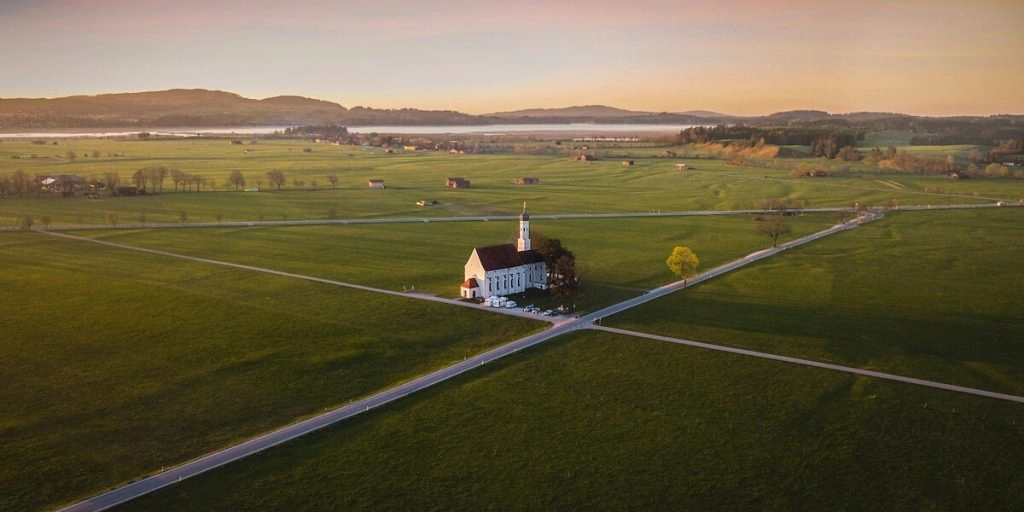
Getting to Germany
Germany is an easily accessible country from the UK and most of Europe, with an excellent network of autobahns to deliver you right where you want to be. Plan getting to Germany as part of your trip and could enjoy an epic road trip to Germany, followed by one in the country itself!
For those flying in, the well-located airports of Frankfurt, Munich, and Hamburg are ideal for car rental, or even hiring a VW campervan or motorhome from Motorhome Republic , and starting your German road trip. We recommend booking your flights through Skyscanner for live deals and the best prices.
RELATED POST: Driving from UK to Germany: Best Routes, Costs & Tips
Fly into the well-located international airports of Frankfurt , Munich , and Hamburg , ideal starting points for your German road trip. We recommend booking through Skyscanner for live deals and the best prices.
Are you planning to rent a car in Germany? As one of the largest car hire aggregator companies in the world, we recommend Rentalcars.com because they have massive purchasing power which enables them to secure the best car rental prices, which benefits you when you’re planning a roadtrip in Germany.
For a real adventure , hire a motorhome or campervan in Germany. We recommend Motorhome Republic , an aggregate booking site who pull together all the best deals from a number of rental agencies, to offer you a wide choice of options alongside an excellent English speaking expert motorhome Concierge Team.
Use the Park4Night app to find campsites and places to stay along the route, and park for the night on a mountain pass, flower filled meadow of with a glorious view of the sea.
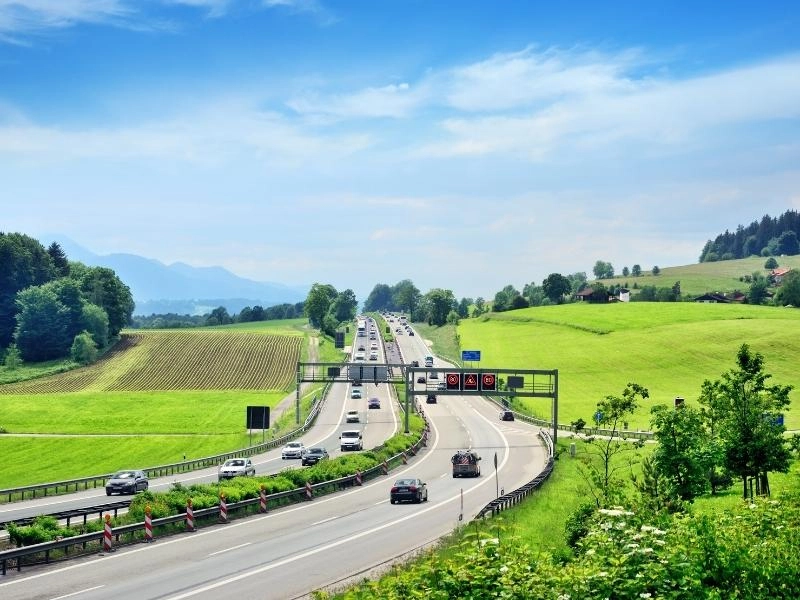
Best Time to Visit Germany
The German climate is fairly typical of central European weather.
The high season is considered to be between April to August when the weather is generally warm. If you want to increase your chances of a dry holiday without rain, roadtrip in Germany between July and September. Temperatures during this period fluctuate between 68°F/20°C to 86°F/30°C.
The colder low-season German weather starts in November and lasts until late March or early April. Snow is common across the country, with temperatures dropping well below freezing. By late March, snow turns to rain, a sure sign that spring is on the way!
That doesn’t mean that you shouldn’t choose to take a German road trip in winter. As a European winter destination , Germany packs a real punch with fantastic Christmas markets, winter activities in Bavaria, and everywhere dusted in snow.
Is this your first time visiting Germany? Get all the information you need in our Germany Travel Guide , including what to pack, the best time of year to go, getting there, and practical tips to help you have the best trip!
The Mosel Valley
Explored by James from The Travel Scribes
Koblenz – Cochem – Beilstein – Zell am Mosel – Traben Trarbach – Trier
- Distance 172km
- Duration 5-7 days
- Drive Time 2 hours
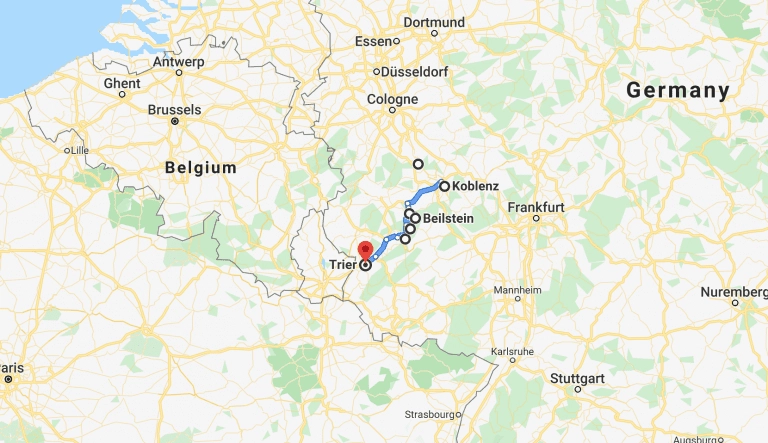
A beautiful river snaking through it, soaring medieval castles dotted across it, and almost vertical vineyards nestled on its hills. It’s the picturesque Mosel (or Moselle) Valley, and this is one of the best roads in Germany for wine lovers!
Punctuated by the small but beautiful Mosel river, the valley essentially stretches from the small city of Koblenz, a fairy-tale German town, to Trier along the water’s edge.
This breathtaking valley is best explored by taking a least a week, the pinnacle of slow travel as you hop from one riverside town to the next.
Kick off your west Germany road trip in Koblenz, where the mouth of the Mosel meets the Rhine, to walk along the ancient Roman walls or just amble through the Altstadt (old town), before heading to visit the first traditional town of Cochem .
On the way there, avid Instagrammers and history buffs should definitely make a turn at Burg Eltz, one of the most spectacular castles and hidden gems in Germany , to take the requisite snap. Once in Cochem, you’ll slow the pace.
You can marvel at the unique vineyards (a signature of the entire Mosel road trip), where the vines crawl up the hillside at 90-degree angles. If you go in harvest time, you’ll see the workers strapped into harnesses with spiked boots just to be able to pick the ripe grapes.
Cochem also boasts one of Germany’s legendary castles looming above it, plus it’s the best place to just take a walk along the promenade, stopping in at one of the riverfront cafes for a plate of zwiebelkuchen (onion cake) and a sparkling glass of federweisser , a traditional fizzy grape drink.
Your next few nights should definitely see you stay over in one of the many lovely towns sprinkled along the river: Beilstein for the Burg Metternich castle, a climb up the hill (and more traditional German food) in Zell am Mosel and our favorite stop on the entire itinerary, Traben Trarbach.
This gorgeous little town used to be two villages, Traben and Trarbach, on opposite sides of the river, which were eventually united with the construction of a short bridge.
Before you hit your final destination of Trier, stay overnight in Bernkastel-Kues, a spa town peppered with wood-timbered houses, many a hot spring, and the ruins of the Landshut Castle.
Before you know it, your German road trip is at an end, as it culminates in the beguiling town of Trier. An old Roman city with landmarks like the Porta Nigra black gate, an old-school amphitheater, the Roman baths, and a towering cathedral, just to name a few.
It’s here that you should raise a(nother) glass of perfectly poured Riesling in celebration of the Mosel valley, one of the best road trips in Germany.
Where to Stay
Cochem ⇒ Hotel Villa Vinum for its highly rated service, perfect riverside location, and quirky decor.
Traben Trarbach ⇒ The Goldene Traube for its traditional exterior and modern interior, rooftop terrace, and fabulous breakfast buffet!
Trier ⇒ Vienna House Easy for its excellent location close to the old town, modern and funky style, and private parking garage.
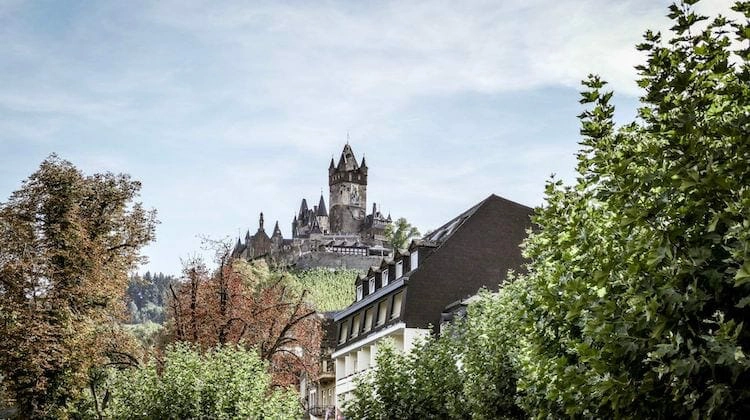
Make sure you have travel insurance you can trust when visiting Germany. We recommend True Traveller for their 5-star TrustPilot reviews, variety of cover options, best activities cover as standard, great prices, and excellent service.
The German Fairy Tale Road
Frankfurt – steinau – marburg – kassel – gottingen – hamelin – bremen.
- Distance 660km
- Duration 7 days
- Drive Time 10 hours
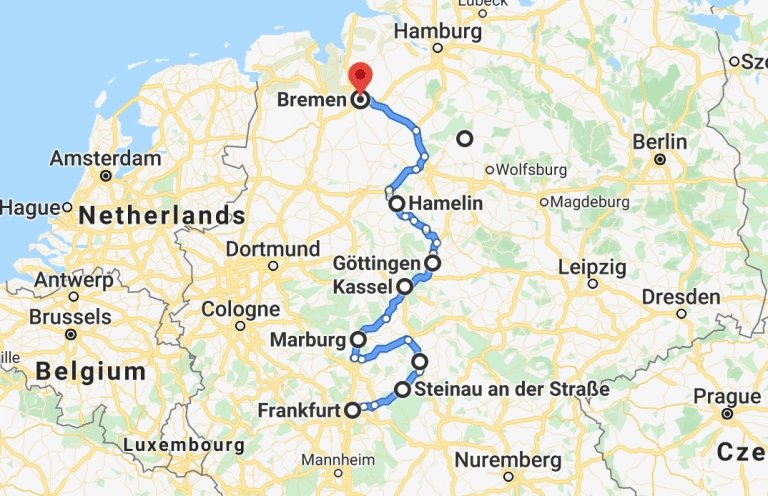
This central to north Germany road trip from Frankfurt does not technically start in the city, but Frankfurt is the perfect place to fly into and pick up a rental car. If you’re spending the night, make sure you visit the South Bank, where you’ll find an eclectic selection of restaurants, bars, and clubs.
The Fairy Tale route officially starts in the pretty town of Steinau an der Strasse where the Brothers Grimm lived until they were aged twelve.
The setting is straight out of their own fairy tales, complete with typical half-timbered houses, twisting cobbled alleys, and the turreted fairy tale castle of Schloss Steinau which overlooks the whole town. Visit the Brüder Grimm Haus and Museum Steinau, both of which showcase the works of the brothers.
Take the back roads to Marburg and enjoy the gorgeous landscapes and slower pace for a few hours. Marburg’s altstadt is full of medieval houses and the hilltop Landgrafenschloss, a dramatic castle holding exhibits on sacred art and local history.
Lively bars and restaurants line the Marktplatz and the narrow streets surrounding it, making this a great location for an overnight stop.
From Marburg, head to Kassel, where the Brothers Grimm spent their teenage years whilst working as librarians for the King of Westphalia, Jerome Bonaparte, the younger brother of the infamous Napoléon.
There is very little left of historic Kassel but there are two worthwhile attractions to visit; the Brüder Grimm Museum, and the Schloss und Bergpark Wilhelmshöhe, a tranquil green space and the largest hill park in all of Europe.
Gottingen is home to the University of Gottingen, where the Grimm Brothers once served as professors. Make for the traditional and atmospheric central market square, where the statue of Ganseliesel, the little goose girl of German lore, is one of the most kissed statues anywhere in the world. It is said that the kisser is rewarded with good luck, but maybe post-virus this practice will change!
Hameln (or Hamelin) is next up and one of the most famous fairy tale destinations in Europe. Hameln is the home of the Pied Piper, or Rattenfänger, who rid the town of rats in 1284, only to be cheated out of his payment.
The Pied Piper returned to Hameln a year later and lured away all the children. The story is re-enacted in the town center every Sunday between May and October and is a fantastic spectacle.
The Weser Renaissance architecture of the Rattenfängerhaus and the Hochzeitshaus makes a fitting historic backdrop for the streets which are thronged with locals dressed the part, stalls selling food, and live music playing.
Finally, on to the Hanseatic city of Bremen, your final stop. Good places to visit in Bremen include the traditional Marktplatz, which is located in the city’s charming altstadt, the 600-year-old Rathaus or town hall, the Roselius-Haus Museum, and the stunning St. Petri Dom, the 11th century gothic cathedral.
Another landmark can be found in the city’s central town square – a statue of the Bremen musicians and heroes of the Brothers Grimm story, “The Town Musicians of Bremen.”
If you have time, extend your trip and head to the modern and progressive port city of Hamburg. Explore the historic districts, edgy culture, and extraordinary commercial past with our one day Hamburg itinerary.
RELATED POST: Deutsche Märchenstraße: Germany’s Fairy Tale Road
Where To Stay
Frankfurt ⇒ Kempinski Hotel Frankfurt Gravenbruch for its proximity to the airport and city center, fantastic spa, and beautiful surroundings.
Marburg ⇒ The Vila Vita Rosenpark for its central location, excellent regional restaurant, and stylish bedrooms.
Bremen ⇒ Atlantic Grand Hotel for its perfect riverside location, bike rental from reception, and ultra-stylish bathrooms.
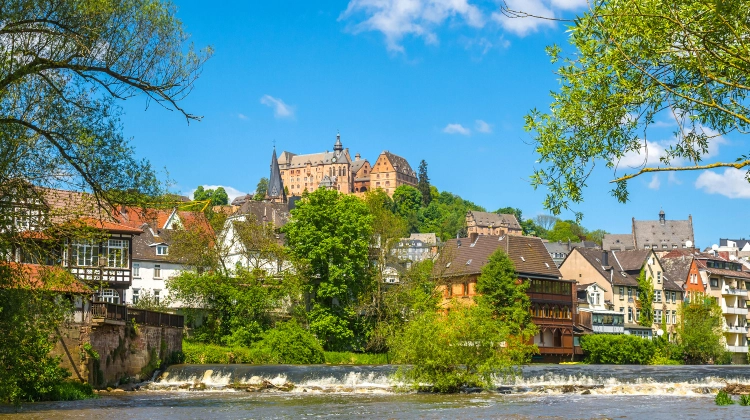
Germany Travel Ideas
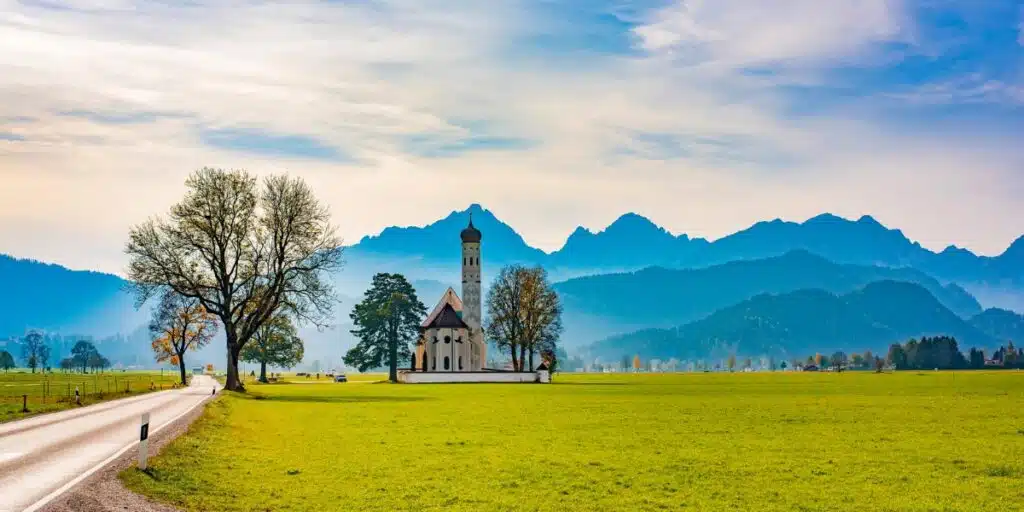
Romantic Road Germany: Itinerary, Map & Tips
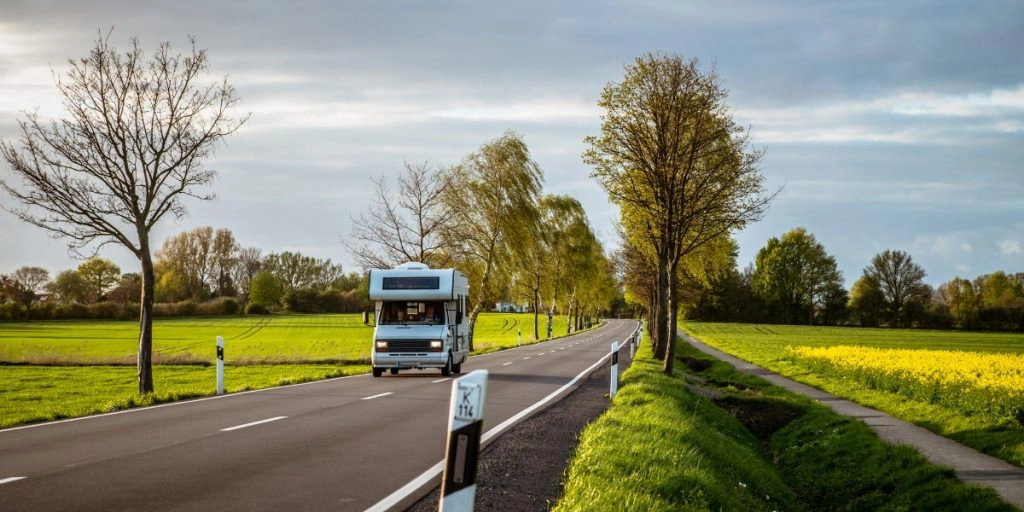
Motorhoming in Germany: Your Complete Touring Guide for 2024
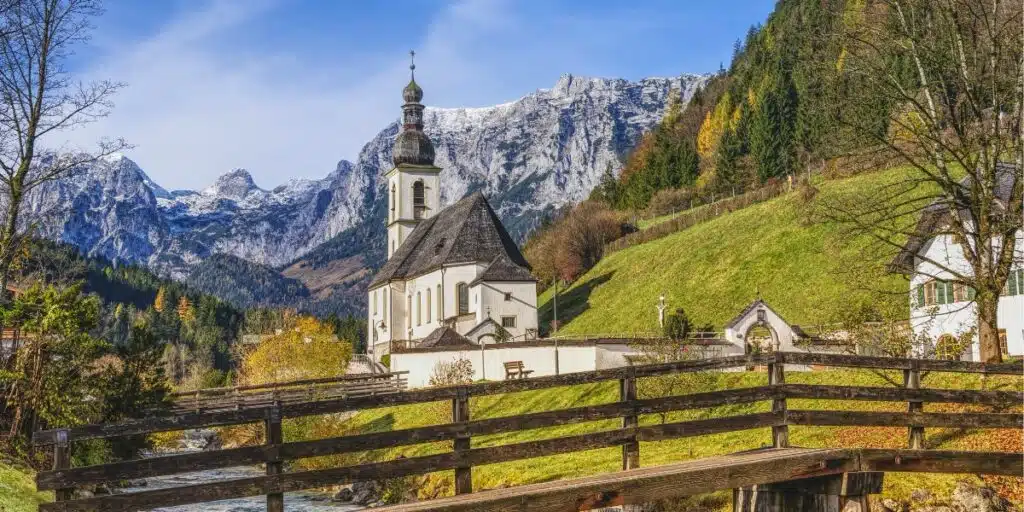
Deutsche Alpenstrasse: Route, Map & Highlights
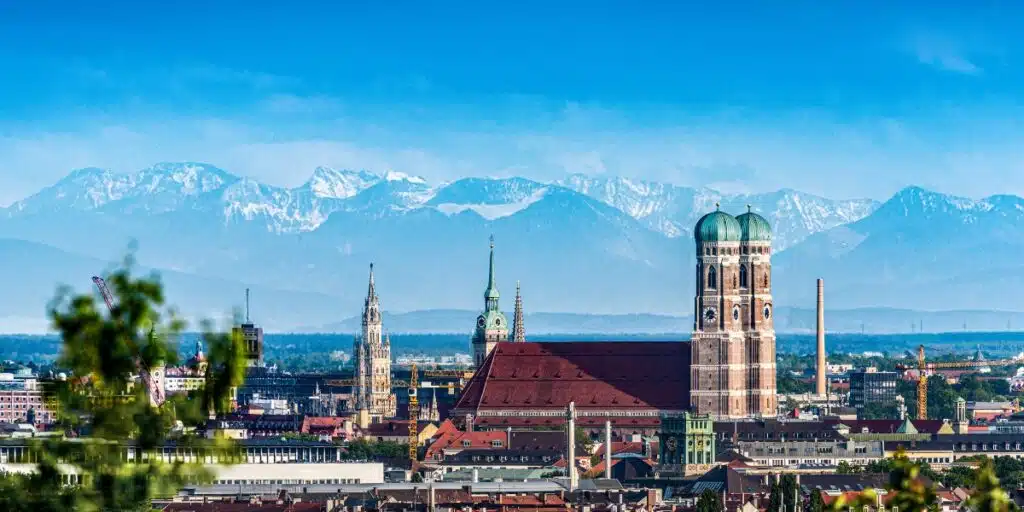
One Day Munich Itinerary + Map, Tips & Guide
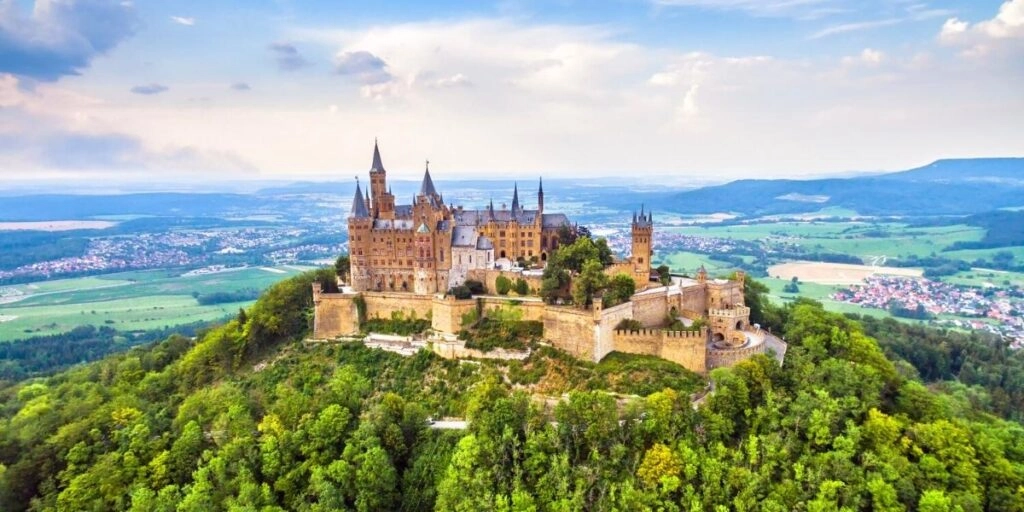
18 Magical Castles in Germany to Add to Your Bucket List
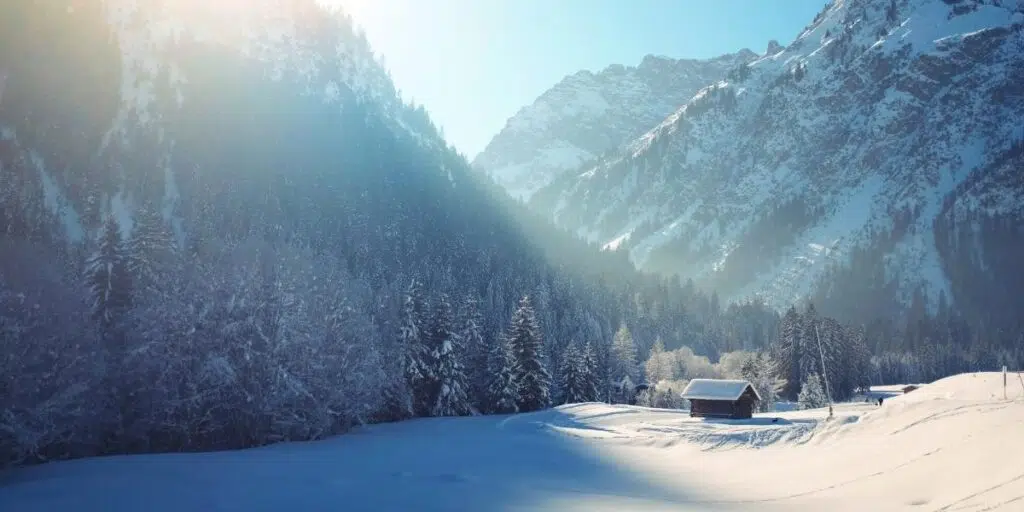
Winter Destinations Europe: 23 Amazing Wintry Places
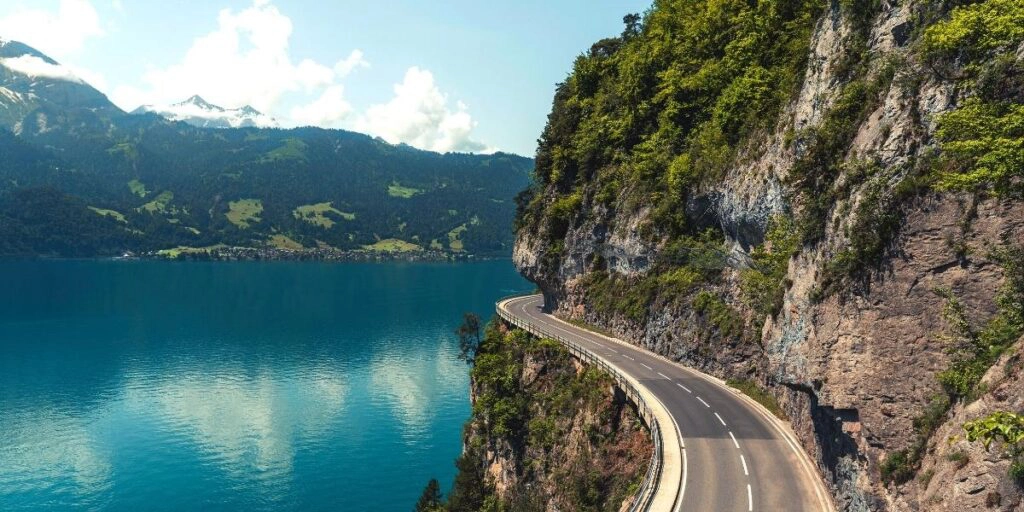
Europe Road Trip – 24 Incredible Routes
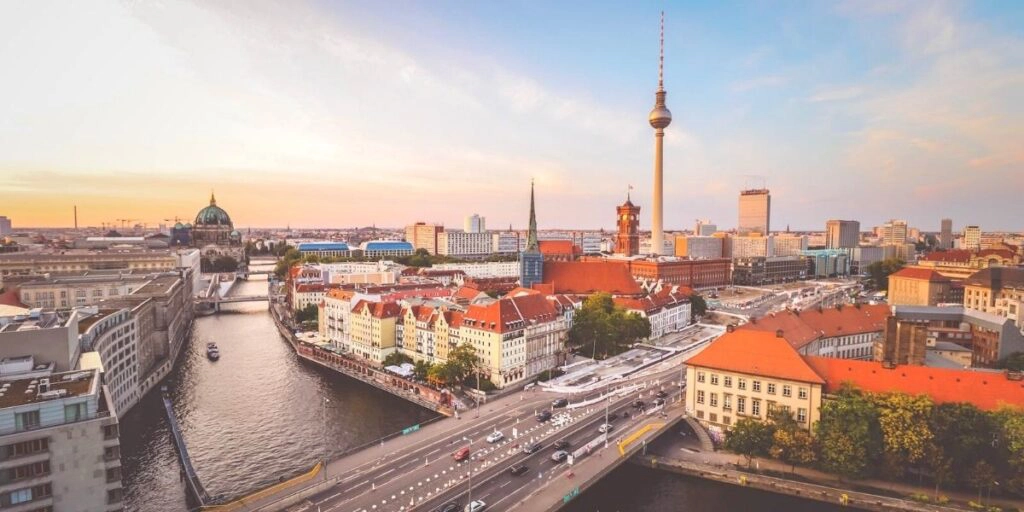
Berlin in One Day – Itinerary, Map, Tips & Guide
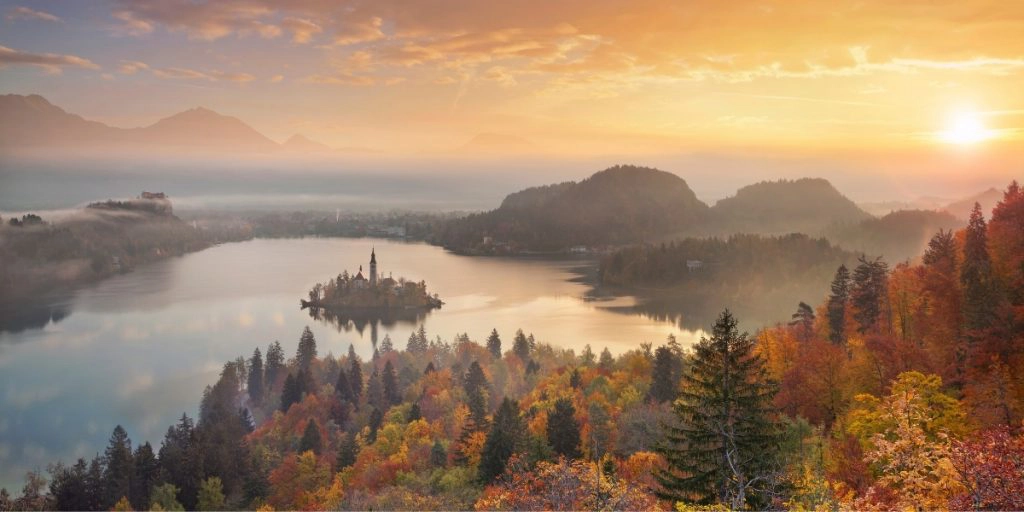
Autumn in Europe: 23 Stunning Destinations for Fall
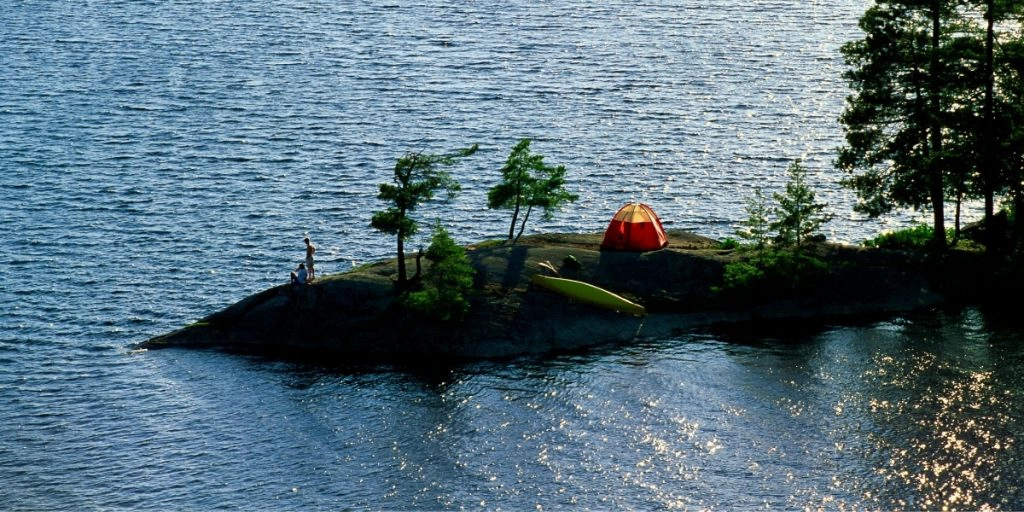
The Best Campsites in Europe – For Campers, By Campers
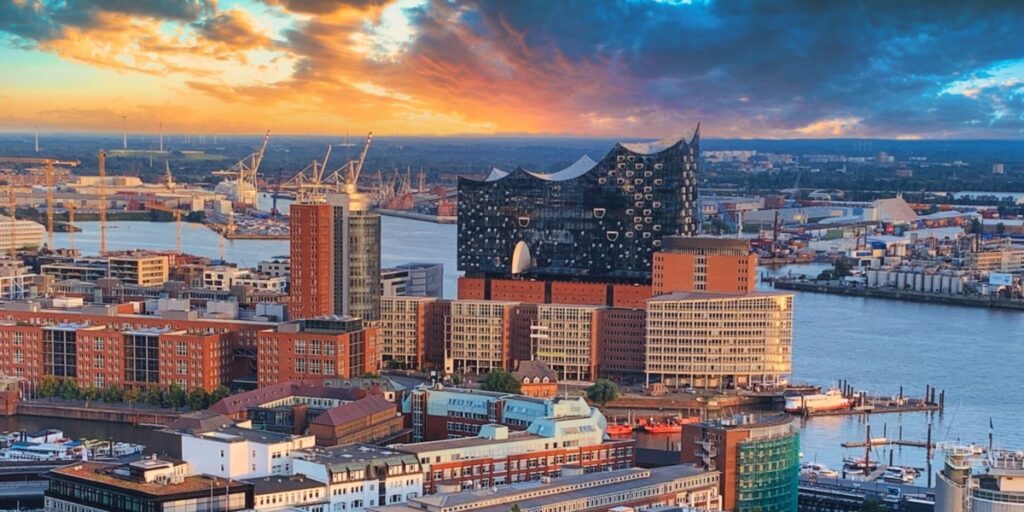
24 Hours in Hamburg – Itinerary, Map & Travel Tips
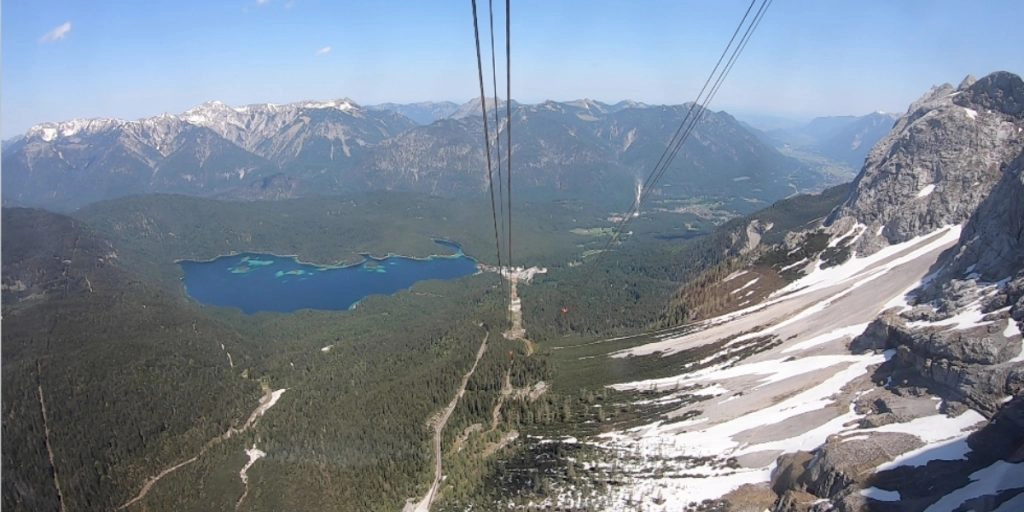
Visit Zugspitze Germany – Find Out How!
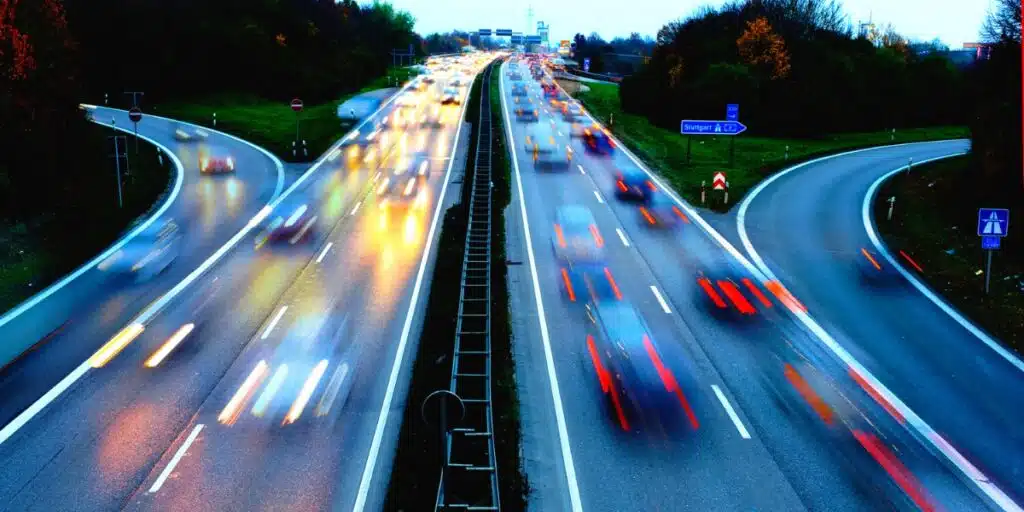
Driving from UK to Germany: Best Routes, Costs & Tips
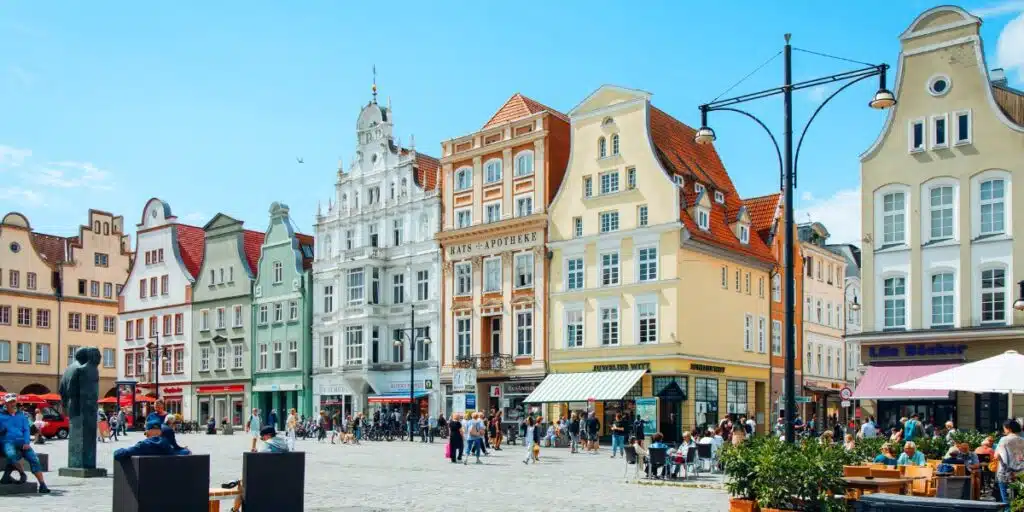
Beautiful Cities in Germany: 27 Picturesque Cities to Visit
The romantic road.
Explored by Carolyn from Holidays to Europe
Wurzburg – Weikersheim – Rothenberg – Dinkelsbühl – Augsburg – Fussen
- Distance 340km
- Drive Time 5 hours
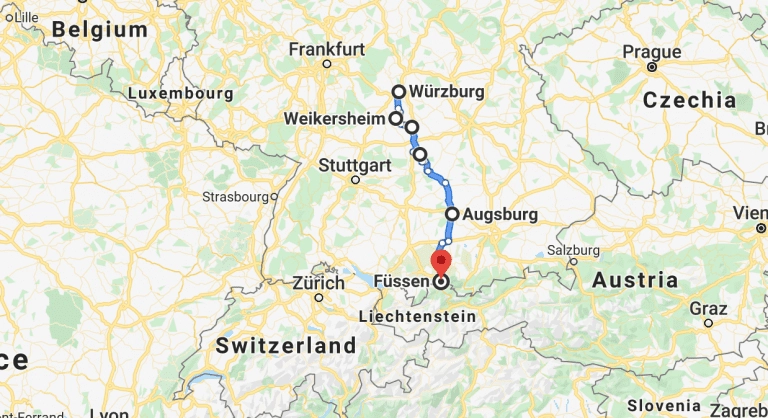
One of the best southern Germany road trips is along the scenic route known as the Romantic Road or Romantische Strasse. This Bavaria road trip stretches for 340km from Wurzburg to Fussen, the route has many highlights and passes through some of Germany’s prettiest landscapes and most fairy tale towns and villages.
Whilst you could travel this entire Bavaria itinerary in one or two days, to make the most of your Romantic Road drive , I suggest you allow at least 5 days in Bavaria, which will give you the chance to stop and explore many of the 29 towns along the route, of which the best six are listed above.
The first stop on Germany’s Romantic Road is Wurzburg, an attractive city that was almost totally destroyed in WW2. Highlights include the Marienberg Fortress, Wurzburg Cathedral, the Old Main Bridge (which crosses the River Main), and the stunning UNESCO World Heritage listed Wurzburg Residence. Wurzburg and the Franconia region are also well-known for their wines.
You’ll see vines planted in front of the Marienberg Fortress and in the surrounding countryside, so be sure to sample the local drop.
After a couple of days in Wurzburg, head south to the fairytale town of Rothenburg ob der Tauber, one of the most beautiful places in Germany.
I recommend you stop in the charming town of Weikersheim en route, there’s a beautiful castle you can visit and a small but very pretty old town. In Rothenburg, you’ll see why visitors flock here from all over the world.
The brightly painted timbered houses that line the cobbled streets and the medieval city walls with their watchtowers, ooze romanticism and entice people on day trips from all over southern Germany.
Other highlights include St. Jacob’s Cathedral, the castle gardens, the views from the tower of City Hall and the Kathe Wohlfahrt Christmas Store and the German Christmas Museum.
With numerous nearby towns and villages worth a visit, too, you could easily fill three days in Rothenburg ob der Tauber. Next, drive further south to your final stop at Fussen.
You’ll want to stop at Wies to visit the Wieskirche, a small baroque church with an impressive interior that is UNESCO listed.
In Fussen, explore the old town and head to Schwangau to visit Germany’s most famous schloss , Neuschwanstein Castle, built by mad King Ludwig. If you have a few extra days, enjoy some city life by heading to Munich, where you’ll find fantastic Bavarian culture and a lively social scene.
Base yourself here for a few days and enjoy some of the day trips from Munich on offer, to experience the best of the surrounding landscapes and attractions. We think this could well be the best road trip in Germany.
RELATED POST: Romantic Road Germany: Itinerary, Map & Tips
Wurzburg ⇒ Hotel Grüner Baum for its great location, traditional Franconian decor, and outstanding breakfast.
Rothenburg ⇒ Hotel Herrnschloesschen for its gorgeous and unique decor, fantastic restaurant, and beautiful garden.
Fussen ⇒ Hotel Das Rübezahl for a real treat. This luxury hotel has amazing views across the Alps and both Neuschwanstein and Hohenschwangau castles. There is also a fantastic spa and restaurant, making this the perfect hotel to end your German road trip.
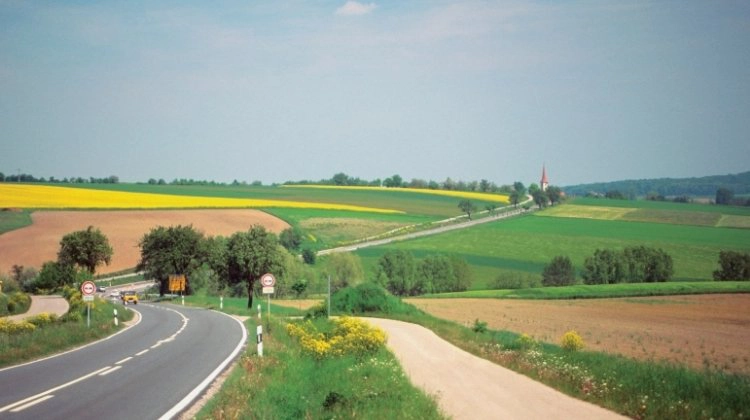
Don’t forget your road trip essentials! Our free road trip checklists help you remember everything, including road trip snacks , podcasts and road trip songs for the journey!
The Castle Circuit
Explored by Becki from Meet Me in Departures
Koln – Frankfurt – Mespellbrunn Castle – Stuttgart – Bad Wildbad – Heidelberg – Koblenz – Eltz Castle – Rheinstein Castle – Cochem Castle – Köln
- Distance 950km
- Duration 3-5 days
- Drive Time 13 hours
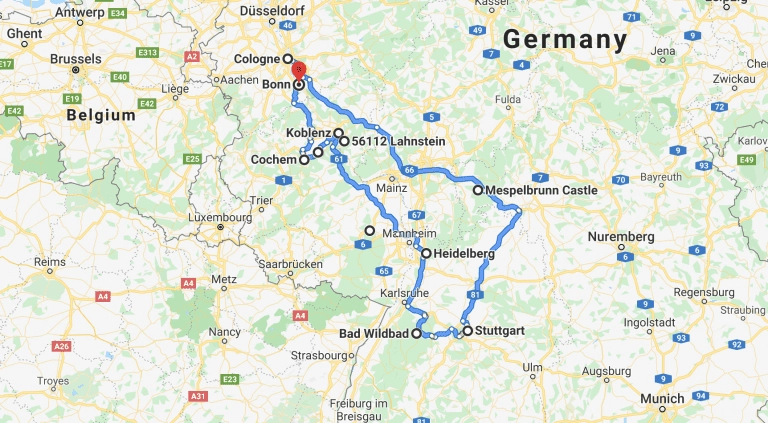
This south Germany itinerary covers a whole mix of destinations in a fabulous circuit, visiting some of Germany’s best castles on the route. Starting and finishing in the graceful city of Cologne (Koln in Germany) this road trip covers the southwest of the country.
It takes you south as far as Stuttgart, before circling back north towards the Mosel Valley. To make the most out of this road trip, I suggest three to four days, which will give you time to enjoy the castles as well as the wine in the Rhine region; perfect for a long weekend.
This part of the country is one of the best places to visit in Germany and you’ll get to see some of Germany’s prettiest castles, the stunning and verdant forests, the Rhine river, as well as a number of picturesque cobbled towns. Stay off the autobahns for the best driving, through beautiful landscapes and scenery.
Start your castle road trip in Koln, making sure to visit the simply stunning cathedral, and head southeast towards Frankfurt. Spend some time in the altstadt wandering around the pretty and atmospheric streets.
From here head towards Mespellbrunn Castle. It’s located pretty much in the middle of nowhere, however, it’s a stunning castle, which looks a lot like the Sleeping Beauty tower, located on a lake.
From Mespellbrunn Castle, keep heading southeast towards Stuttgart, a beautiful city full of green and open spaces. Be sure to spend plenty of time here exploring the town and its elegant buildings.
It’s worth stopping overnight and taking advantage of the fantastic restaurants, bars and beer gardens which line the narrow cobblestone streets of the old town.
From Stuttgart, start to head back north-west. Spend time visiting the lovely Bad Wildbad in the Black Forest and maybe indulge yourself in one of the many thermal baths there.
Head for historic Heidelberg and spend some time admiring and visiting the imposing Heidelberg Castle before crossing the wide river Neckar on the famous old bridge. This is another great town for an overnight stay.
Stop by the pretty and very German town of Koblenz, before heading to Eltz Castle. If you’re looking for a quintessential fairytale castle, then Berg Eltz is it! When you’re done swooning over Eltz, head to the small complex of Rheinstein Castle high on the banks of the Rhine (or Rhein in Germany) river.
Make for your last stop in Cochem on the gorgeous Moselle, and the impressive Cochem Castle. Stay for the night and try some of the delicious wine produced in this region or take a guided tour of a vineyard with a wine tasting.
This is a fully packed itinerary covering all the best bits of Germany. I’m sure you’ll agree, this makes a fantastic German road trip!
RELATED POST: 18 Magical Castles in Germany to Add to Your Bucket List
Koln ⇒ Hotel Lyskirchen for its ideal old town location, boutique vibe and modern rooms.
Bad Wildbad ⇒ Mokni’s Palais Hotel and Spa for some of that thermal action, as well as old-fashioned elegance and service.
Heidelberg ⇒ Ninetynine Hotel Heidelberg City for funky and modern design, super-comfortable beds and a lively, sociable bar.
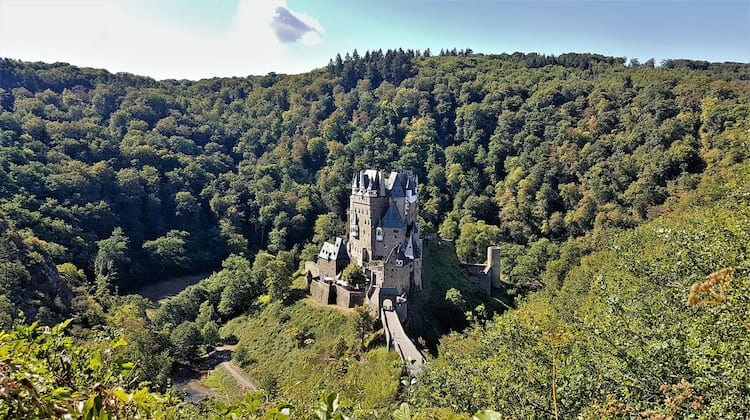
Looking for the best SIM card deals in Europe for your trip? Check out our guide to the best data SIMs in Europe and get the best deal for your trip to Germany.
The German Alpine Road
Lindau – bad hindelang – pfronten – füssen – oberammergau – garmisch-partenkirchen – bad tölz – rottach-egern – oberaudorf – aschau im chiemgau – reit im winkl – berchtesgaden.
- Distance 450km
- Duration 7-10 days
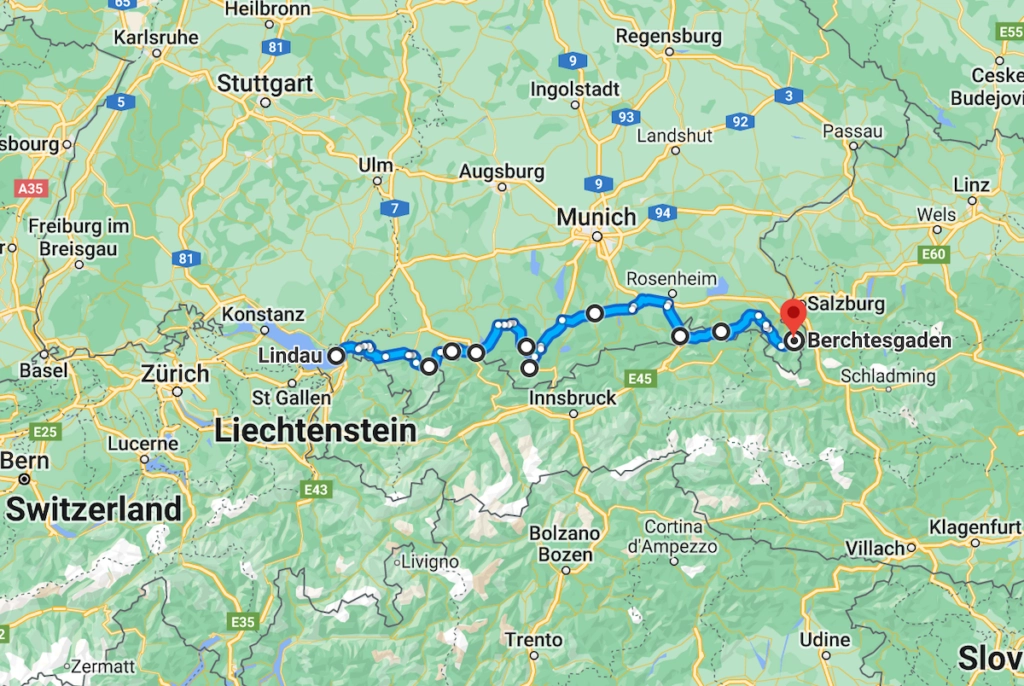
Starting at Lake Constance (Bodensee) and winding its way through the diverse and spectacular Bavarian landscape to Lake Koningssee, following the Alps from west to east, the Deutsche Alpenstrasse is simply spectacular and has to be one of the most scenic road trips in Germany.
On this south Germany road trip, the oldest tourist route in Germany, you’ll explore picture-perfect towns, alpine lakes and meadows, historic castles, and fantastic driving roads, perfect for whatever your means of transport.
Starting in the pretty harbor town of Lindau on Lake Constance, take the twisting road of the Rohrbach ascent into the Allgäu peaks, for spectacular views and the Scheidegg waterfalls in the Rohrach Gorge.
Continue through Oberstaufen, stopping for a dip in the cold and clear waters of Grosser Alpsee, to the traditional German town of Immenstadt, before crossing the Oberjoch Pass. With 106 bends, this is one of the most scenic and exciting drives of the whole route – make sure you allow enough time to stop for photos!
As you continue east, you’ll step into the fairytale world of King Ludwig II on a tour of the castles of Neuschwanstein and Hohenschwangau and the Museum of the Bavarian Kings. Three lakes on this part of the route – Weissensee, Hopfensee, and Forggensee – offer gorgeous scenery.
Upper Bavaria, the land of drama, adventure, and extreme sports is next on the route. Here you can explore the summit of the Zugspitze, Germany’s highest mountain, take in Linderhof Palace, swim in the beautiful Eibsee, and discover the many intricate Baroque churches and monasteries, like the Church of Wies. Oberammergau, home of the famous ten yearly Oberammergau Passion Play , is also in this region and well worth visiting.
Fancy a swim? The next part of the route runs through the Tölzer Land, beside Lake Walchensee, across the fabulous Kesselberg Pass, and on to Lake Kochelsee. After Benediktbeuern with its abbey, Bad Heilbrunn, Bad Tölz, and Lenggries, the route climbs to the Sylvenstein reservoir, where you’ll have fantastic views.
The next section of the route in the Tegernsee and Schliersee region sees you driving through Rottach-Egern, Tegernsee, Schliersee, and Bayrischzell, known for their restaurants and cafés that provide Bavarian hospitality and delicious local food and drink for you to sample. As you continue on, the road meanders through the mountains to Chiemsee, and panoramic views are guaranteed.
The German Alpine Route saves the best for last – crossing the 868m high Schwarzbachwacht Pass into the incredible landscape of the Berchtesgaden Alps and Konigsee, widely thought to be the most stunning lake in Germany.
RELATED POST: Deutsche Alpenstrasse: Route, Map & Highlights
Fussen ⇒ Hotel Sonne for its wonderful old town location, local cuisine, and contemporary decor.
Bad Tolz ⇒ Hotel am Wald for its wellness area, panoramic views, and cozy rooms.
Berchtesgaden ⇒ Alpenhotel Fischer for its fabulous spa, out-of-town location, and family hospitality.
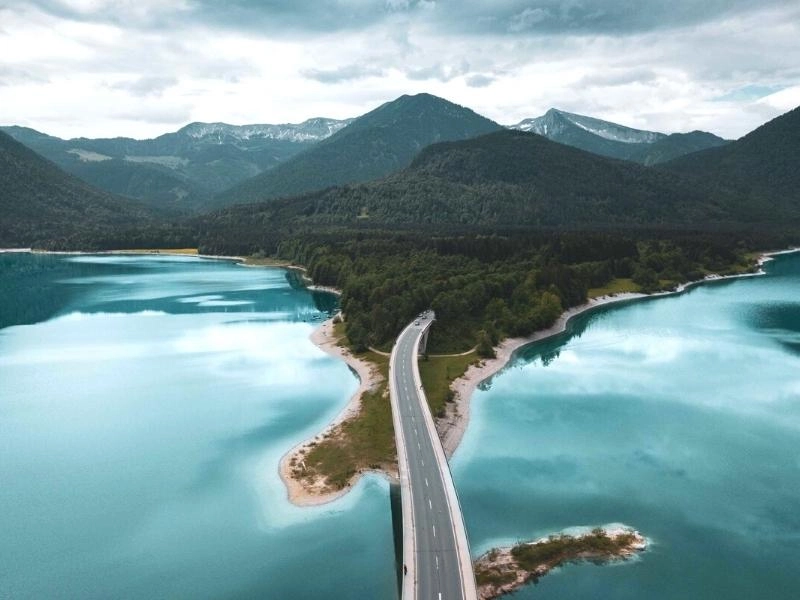
Want to plan your own road tri p? Get our step-by-step road trip planning guide to help you organize the perfect trip, or check out our favorite Europe road trips for ideas and inspiration!
Iconic German Cities
Frankfurt – munich – cologne – munster – hanover – frankfurt.
- Distance 1700km
- Duration 10-14 days
- Drive Time 24 hours
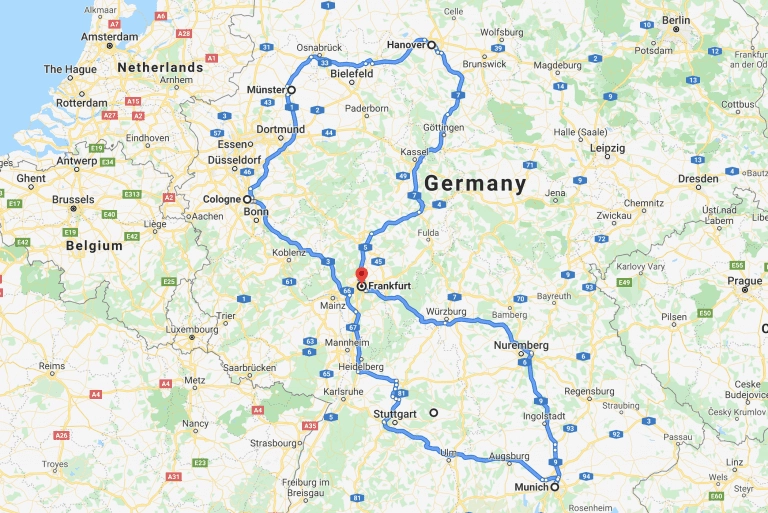
If you really can’t decide which road trip to take and you have a few weeks. then why not consider taking a driving tour of Germany, hopping between some of Germany’s most historic and beautiful cities, and taking in elements of all our road trips on the way?
This road trip route will take you past or in close proximity to some of the most beautiful places in Germany including fairy tale castles and towns, famous landmarks, stunning rivers, and wine regions.
You’ll drive on fantastic roads and if you choose not to use the autobahns, you’ll enjoy a relaxed pace and be able to enjoy the ever-changing scenery and small historic towns of this surprisingly gorgeous country.
If you’re road tripping Germany in winter, you’ll love the clear crips days, frosty landscapes and of course, the traditional Christmas markets that the country is famous for. Fairy lights, gluhwein, traditional artisan gifts, and hearty, warming local food will make your winter road in Germany really memorable.
Don’t forget Germany’s recent history either. This route will take you close to both Dachau and Bergen Belsen concentration camps, which make for harrowing visits that nevertheless should be taken, lest we forget the past, which must never be repeated.
You’ll also find the opportunity to tour the top car museums of BMW in Munich and Porche and Mercedes in Stuttgart. Why not test yourself and take a drive around the famous Nurburgring on your way past?
If you are lucky enough to have three weeks or longer, then add the eclectic and fascinating city of Berlin to the mix, or head south from Munich for the incredible Deutsche Alpenstrasse, or German Alpine Road, one of the most scenic drives in Germany.
Where to Stay – Our Top German Hotels
These are luxurious, treat-yourself hotels, known for their sumptuous decor, opulent furnishings, and outstanding service.
Frankfurt ⇒ Hotel Villa Kennedy for its incredibly gorgeous rooms, comprehensive spa, and superb, discreet service.
Munich ⇒ Hotel Vier Jahreszeiten Kempinski for its high-end location on the fashionable Maximilianstrasse, architectural grandeur, and first-class service.
Koln ⇒ Excelsior Hotel Ernst am Dom for its fabulous cathedral location, love of tradition, and impeccable service.
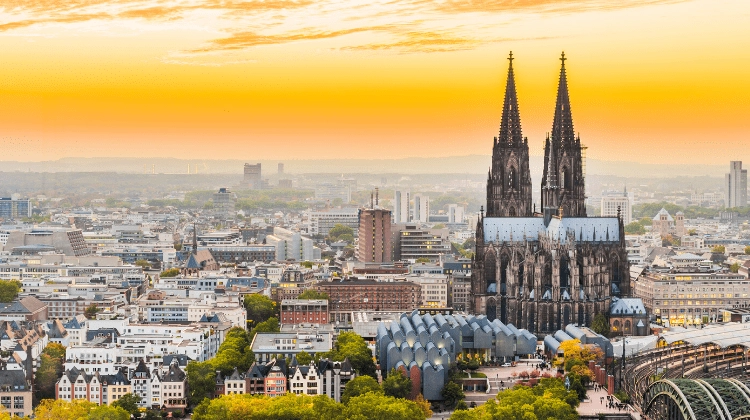
German Road Trip Resources
Here are the websites and services we personally use and recommend for traveling in Germany.
- Search for affordable flights to Germany with Skyscanner
- Search for availability and book hotels and accommodation in Germany with Booking.com
- Find and book the best campsites in Germany with Eurocampings
- Book the cheapest and most reliable hire cars in Germany with Rentalcars.com
- Find and hire your perfect motorhome or campervan with Motorhome Republic
- Get highly rated, reliable, and trustworthy travel insurance with True Traveller
- Check if you need a visa and arrange your documents with Visagov
Tips for Driving in Germany
The roads in Germany are well maintained, the autobahns are toll-free and there are excellent regional and minor roads with great services for drivers, making Germany a fantastic place to road trip.
Contrary to popular belief though, there are speed limits on the autobahn, and many sections have limits between 120km/h (75mph) and 110km/h (68mph) or lower, especially in urban areas.
Whether you’re traveling in your own vehicle or flying in and renting a car, you need to follow these rules when you drive and travel in Germany;
- You must have at least three months remaining on your passport (issued in the past ten years) at your intended date of departure from Germany.
- You must have at least 3rd party insurance for your vehicle.
- Citizens of non-EU third countries may require an IDP, you can check here .
- It is compulsory to carry a warning triangle, reflective jacket (for the driver and all passengers), spare wheel, and the tools to change a wheel or a tire repair kit.
- If you wear glasses you must carry a spare pair.
- You should carry a first aid kit, but this is only compulsory for four-wheeled vehicles registered in Germany).
- Germany introduced regulations in 2010 requiring all passenger cars and motorbikes to be fitted with winter or all-season tires in wintry conditions.
RELATED POST: Driving in Europe – Everything You Need to Know
Are you looking for more road trip inspiration? Check out these top posts…
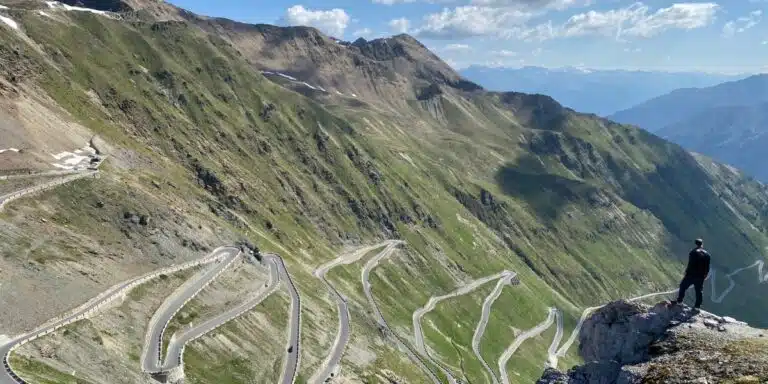
Stelvio Pass: The Best Mountain Road in Italy?
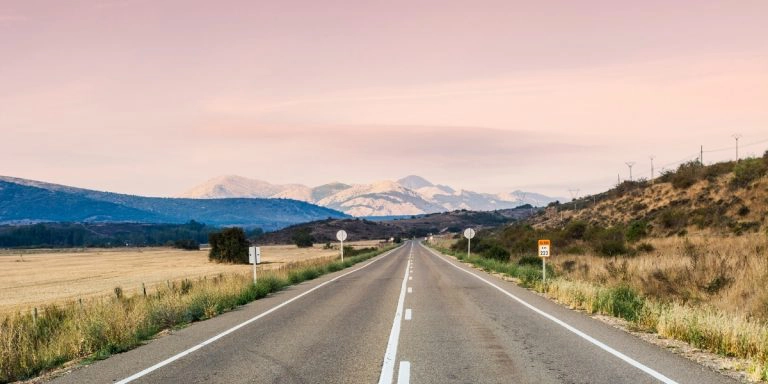
Spain Road Trip: 8 Amazing Routes for an Epic Trip
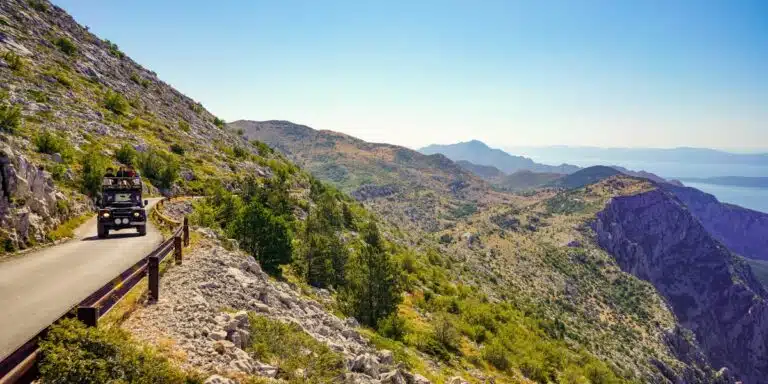
Croatia Road Trips: Five Incredible Routes
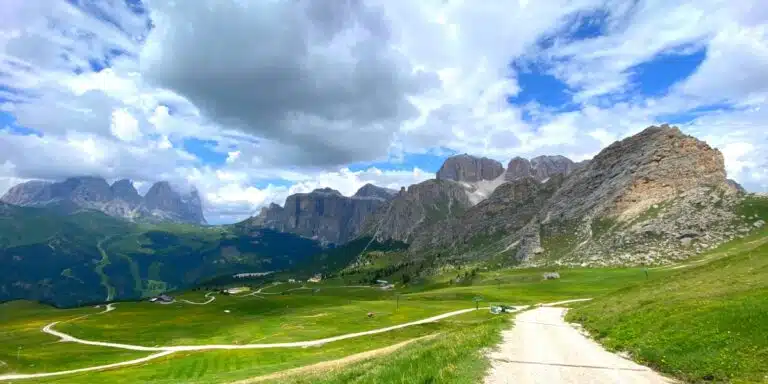
Dolomites Road Trip: Explore the Best of Northern Italy
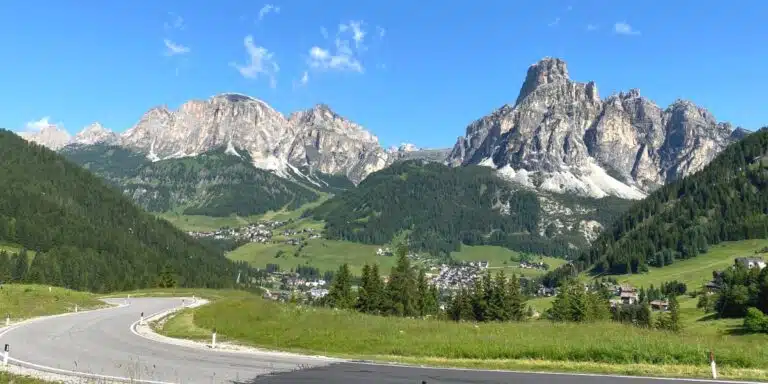
Great Dolomites Road: Absolutely Everything You Need to Know!
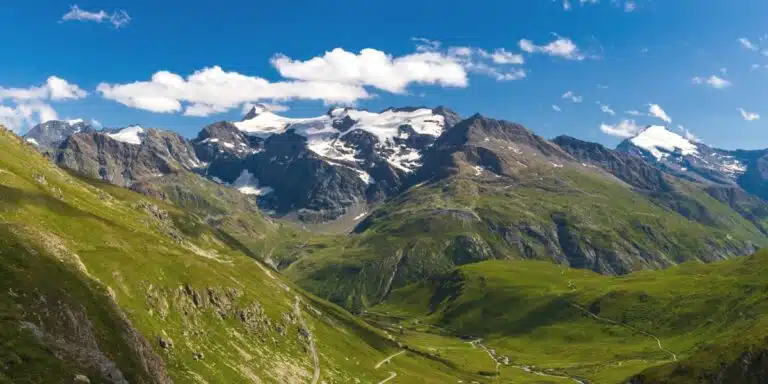
Route des Grandes Alpes: An Epic French Road Trip
Love it pin it.
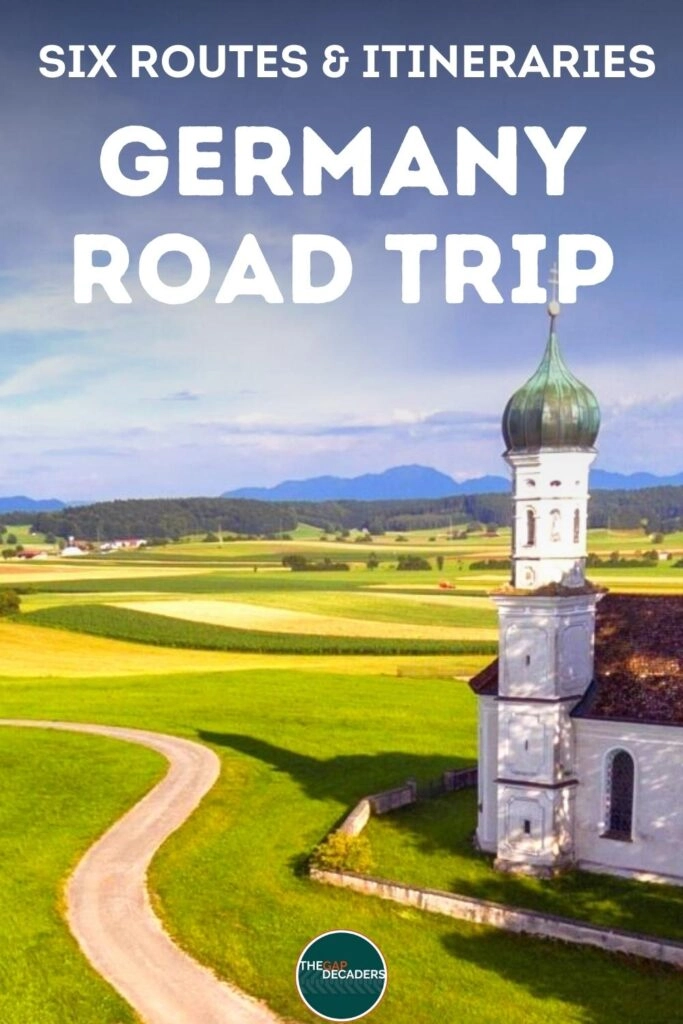
- Travel recommendations
- The taste of travel
- Tips & tricks
- Travel experiences

3 amazing Germany road trip ideas

Fancy a vacation on the road in the home country of the famous Autobahn? How about a Germany road trip? In this article, I share three exciting routes for a great road trip during a German summer or to see the best Christmas markets in December.
Even if you only have a week, there is much to do and see along the way. I am also giving you tried and tested tips to set your road trip budget and for choosing the best rental car.
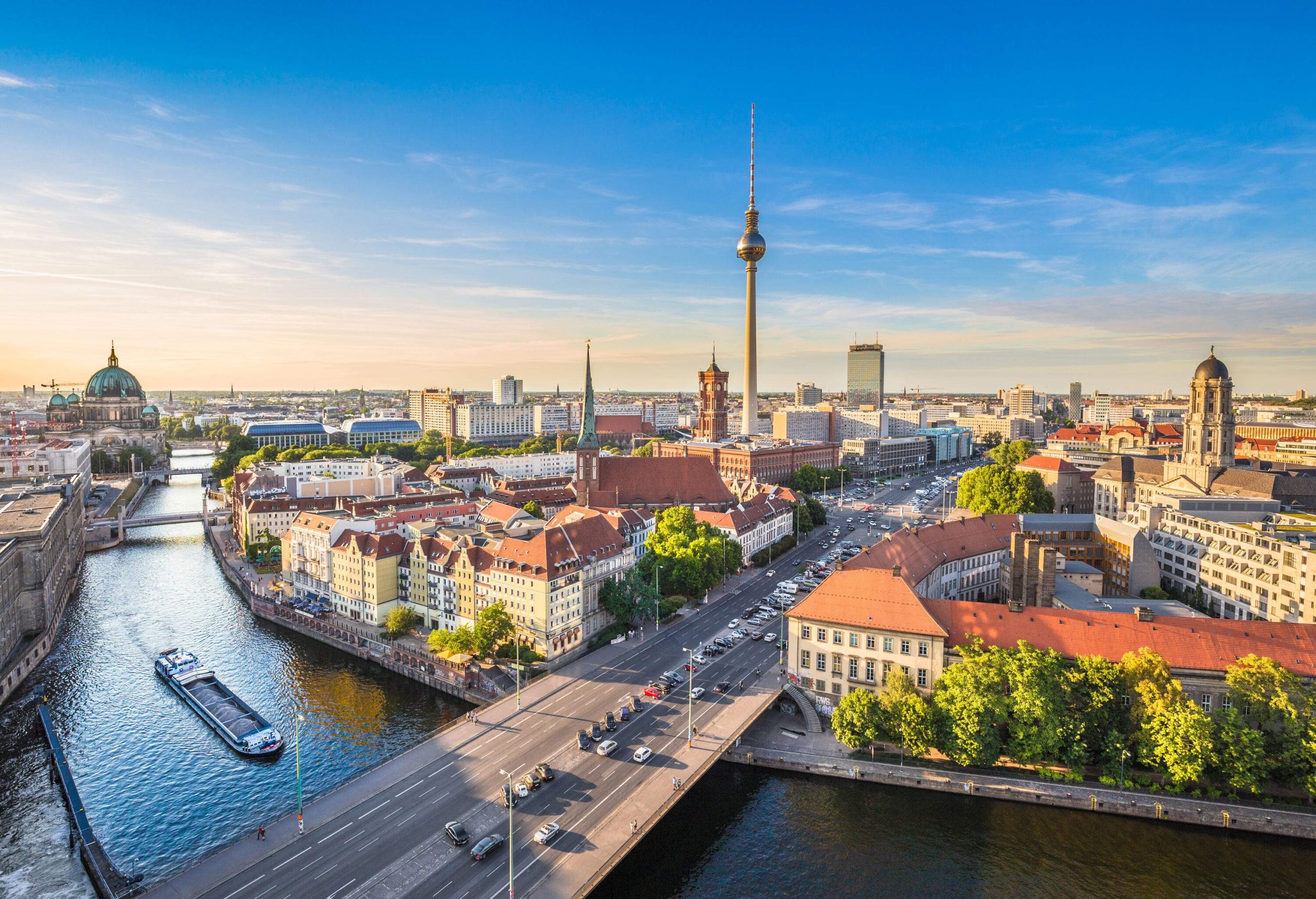
In this post
The best time for a Germany road trip
Average budget for a germany road trip, how to get to germany from the us, the best rental cars for a road trip in germany, germany road trip itinerary - from the north sea to the baltic sea, round trip germany from munich - mountains, lakes & castles, 7 days to the most beautiful christmas markets in germany, general tips for your road trip in germany.
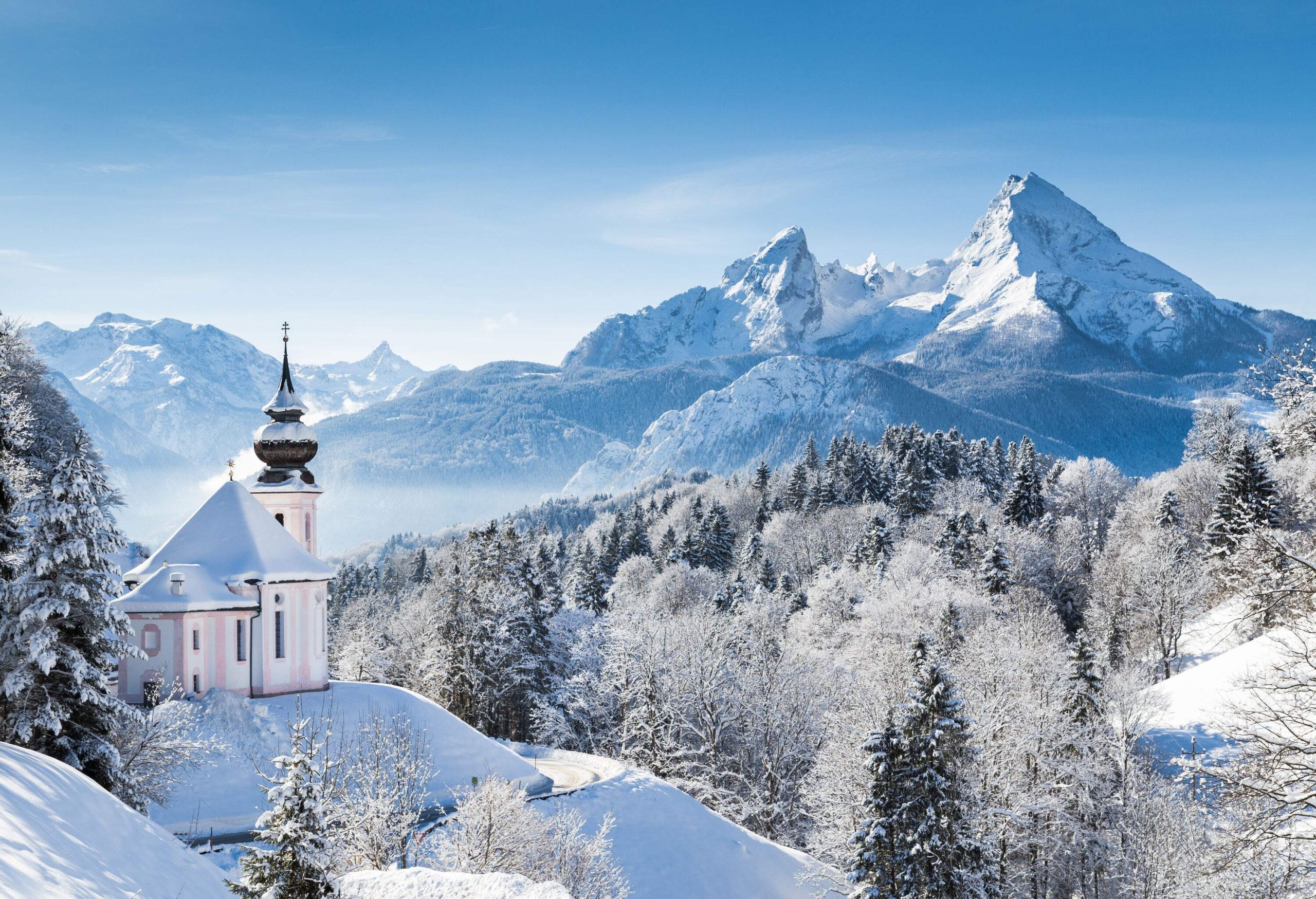
The most popular time to travel in Germany is from May to July when temperatures soar and the sun is out. However, December is also a favorite as the whole country is in a festive mood and the Christmas markets open their doors.
If you are planning a road trip through Germany, you shouldn't wait too long to book a hotel during these months. The best ones book up quickly, especially during vacation times and on weekends. You also shouldn’t wait too long to book your flight and rental car.
Speaking of vacation: Before you set off, you should take a look at when school vacation starts. German kids get six weeks in the summer and the period varies slightly in the different states. This way you can start your trip a few days earlier or later and avoid traffic jams on the highways. Keep this in mind when driving on the weekends too as roads get very crowded on Friday and Sunday afternoons.
The recommendations provided here are based on travelers’ searches on KAYAK, and on the average temperatures provided by weatherbase.com.

Before you set off, you might want to know how much a road trip in Germany will cost. We have compared hundreds of providers on your behalf and compiled average prices:
- Average price for a double room in Berlin: $152 per night
- Average price of a bed in a hostel in Berlin: $73 per night
- Average price of a rental car in Berlin: $75 per day
- Price for a gallon of gas in Berlin: $7.35*
*As of March 2024
For a seven-day road trip in Germany, during which you will cover approx. 560 miles, you should expect a total budget of approximately $900 per person based on two travelers sharing. This includes your taxes but not your flights. Also, there are no road tolls in Germany for regular cars so you don’t have to worry about these extras.
You can save on accommodation if you look for a hotel that is not directly in the city center (this is also usually better for parking).
Depending on which road trip itinerary you want to follow you may want to pick a flight that takes you to the starting point of the route. Most airports have rental car counters so you can start your Germany road trip as soon as you land.
There are plenty of flights from the US to Germany. Berlin is the capital and you can find roundtrip flights from NYC for an average of $871 and from LAX for $1066. However, you might have better chances for a direct flight to Frankfurt or Munich depending on your departure airport at home.
If you are doing the northern route that starts in Hamburg you will need to book a connecting flight with a layover. There are currently no direct flights from the US to Hamburg.
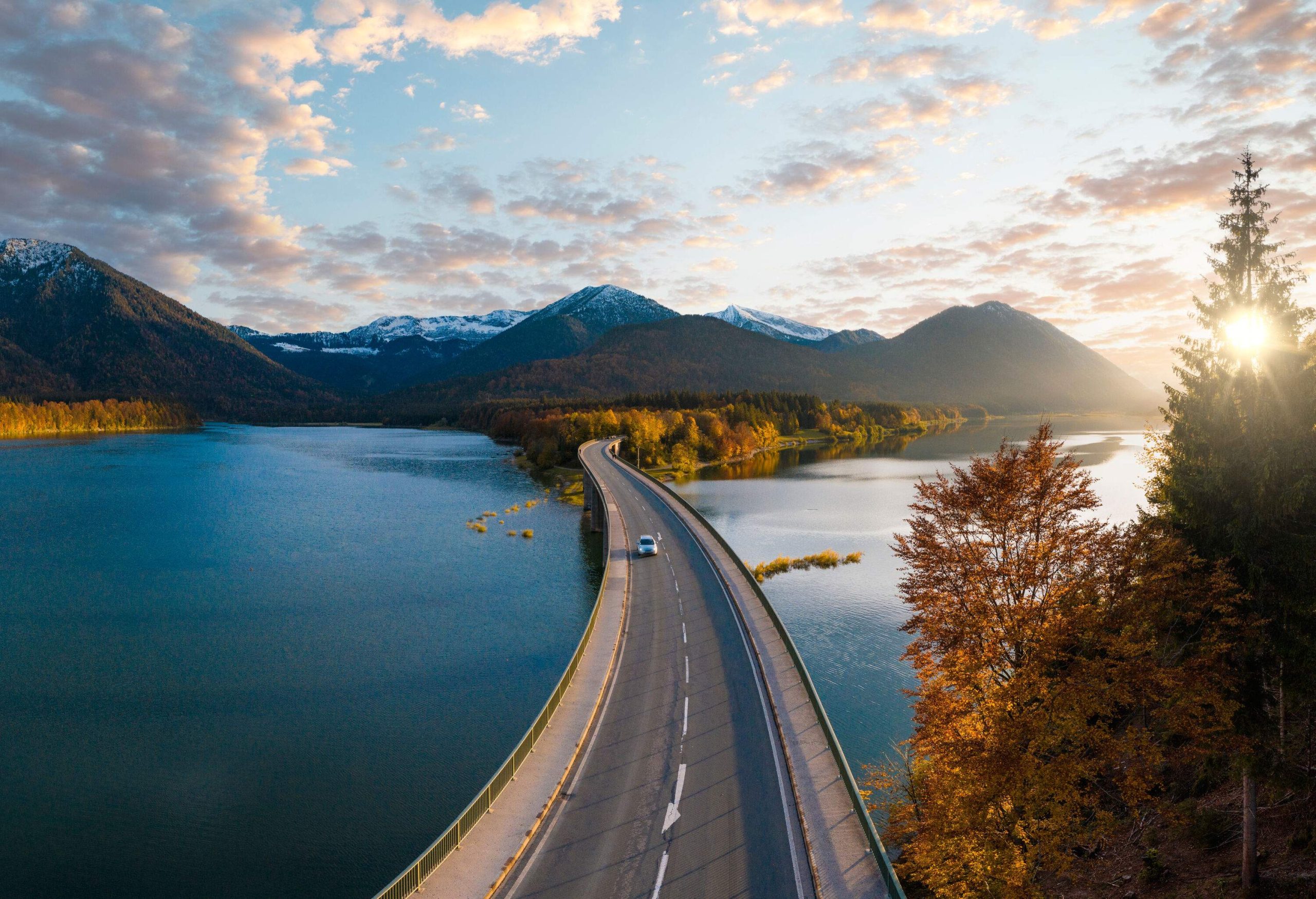
The type of rental car you choose for a road trip in Germany depends primarily on how much space you need. An economical car is particularly useful for longer trips. You should calculate beforehand whether unlimited mileage will pay off for your route.
Comprehensive insurance is always important and you may want to register a second driver so that you can take turns behind the wheel. If you are planning to visit a few cities, you may not want to take the biggest car available. Roads can be small and driving with a big SUV will make it even harder to find parking.
In Germany, your car needs winter tires if the conditions require it. If you are planning to drive from October to March when the weather can bring snow or ice, you should check with your car rental company if your vehicle is equipped with the correct tires.
Pack your bathing suit, because this route takes you to the most beautiful beaches and places by the North Sea and Baltic Sea.
Day 1: Hamburg
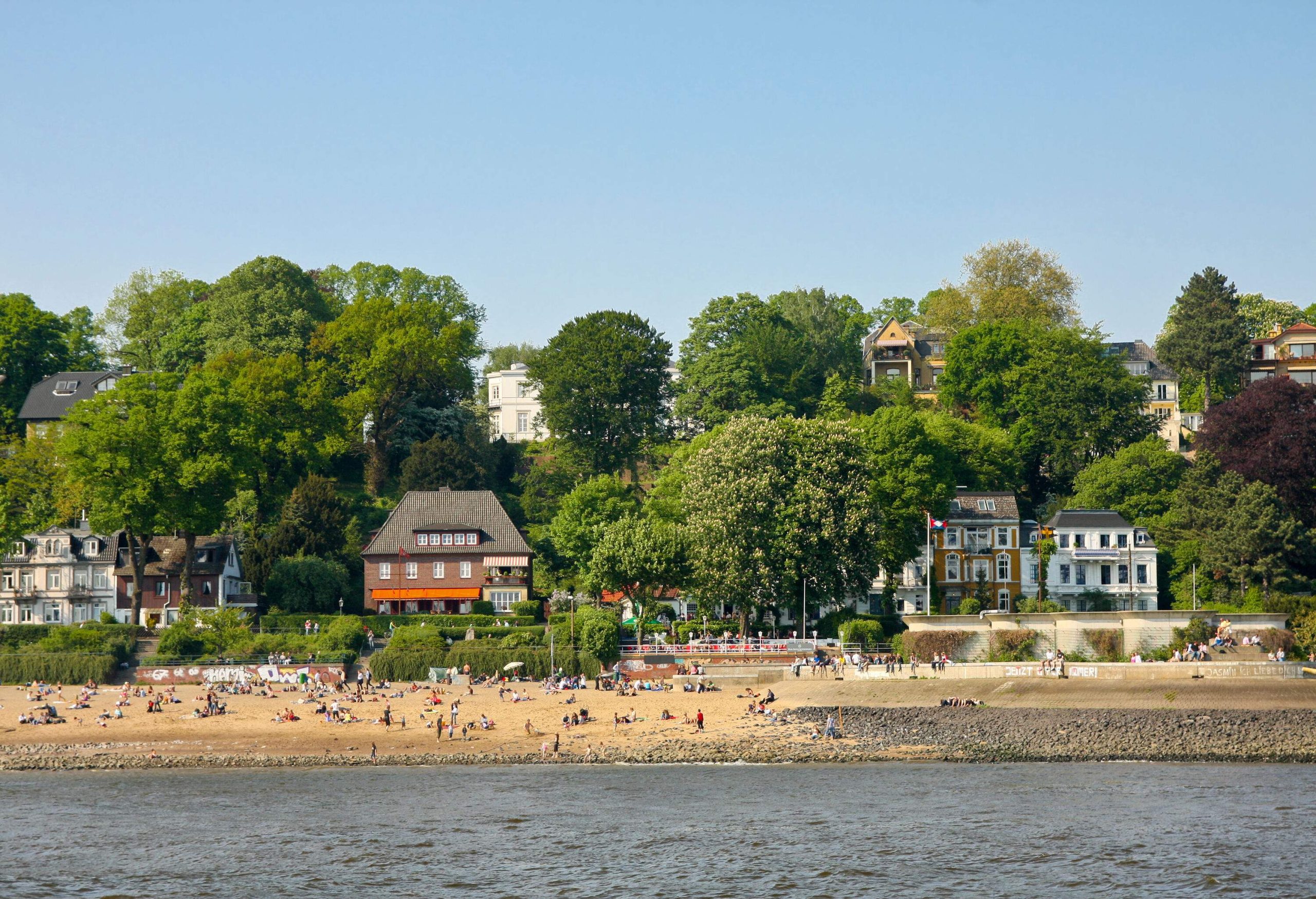
Your road trip along the coast begins with a visit to the Hanseatic City of Hamburg. If the weather is nice, you can put your feet in the sand on the beach by the river Elbe and count the containers in the harbor. Visit the Elbphilharmonie for a concert or a tour of its famous plaza.
Where to stay in Hamburg: 25hours Hotel Hafencity , a cool city hotel with Nordic flair
Day 2: Sankt Peter-Ording
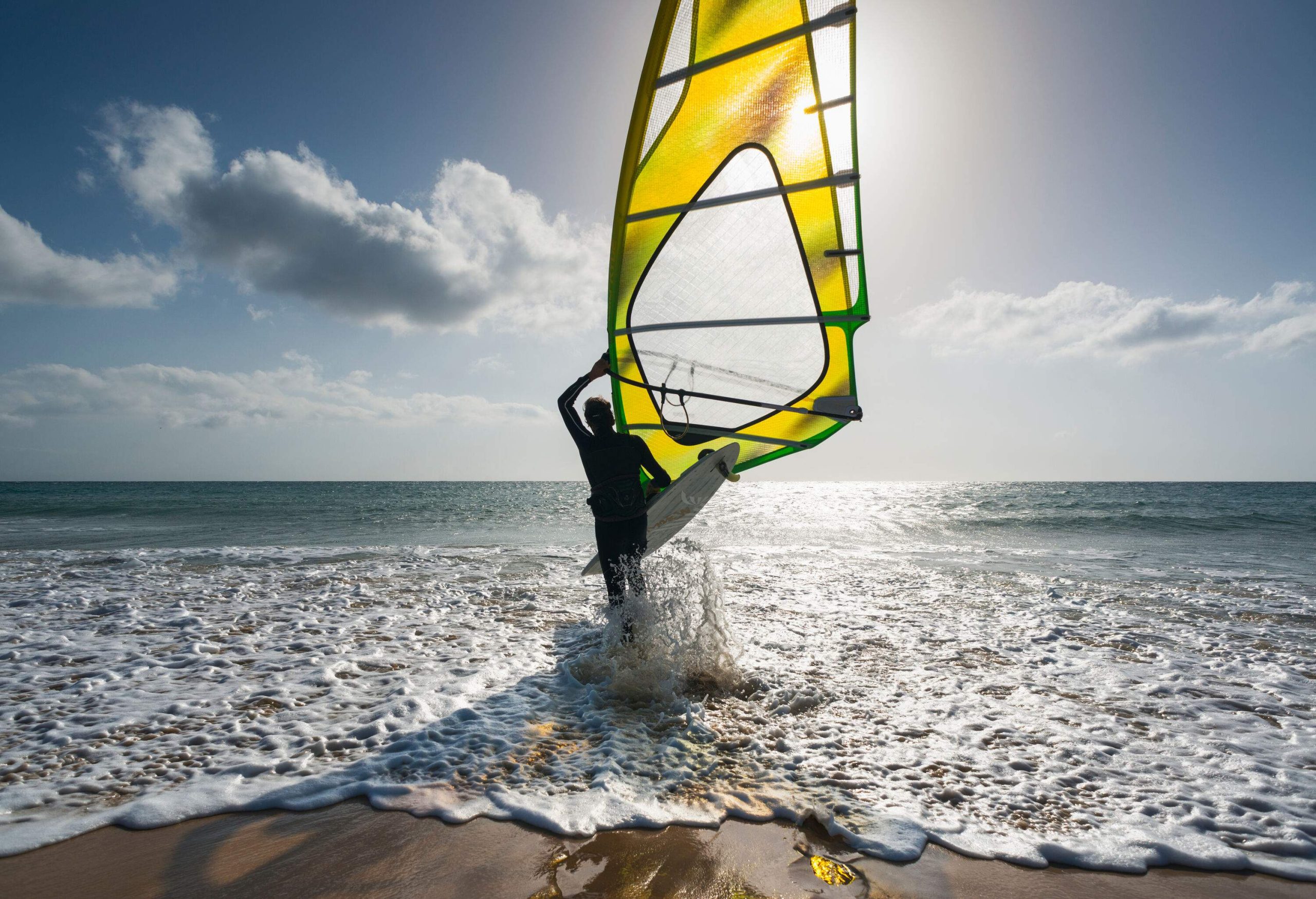
Distance from Hamburg: 87 mi - just under 2 hours
Enjoy the ocean breeze during a long walk on the beach in Sankt Peter-Ording. You can also jump on a board as windsurfing is the thing to do here. Alternatively, take a stroll along the pier and enjoy a bite to eat in one of the restaurants that are set up in iconic stilt houses.
Where to stay in Sankt Peter-Ording: Seaside 43 , a beautiful wellness hotel by the sea
Day 3: Sylt
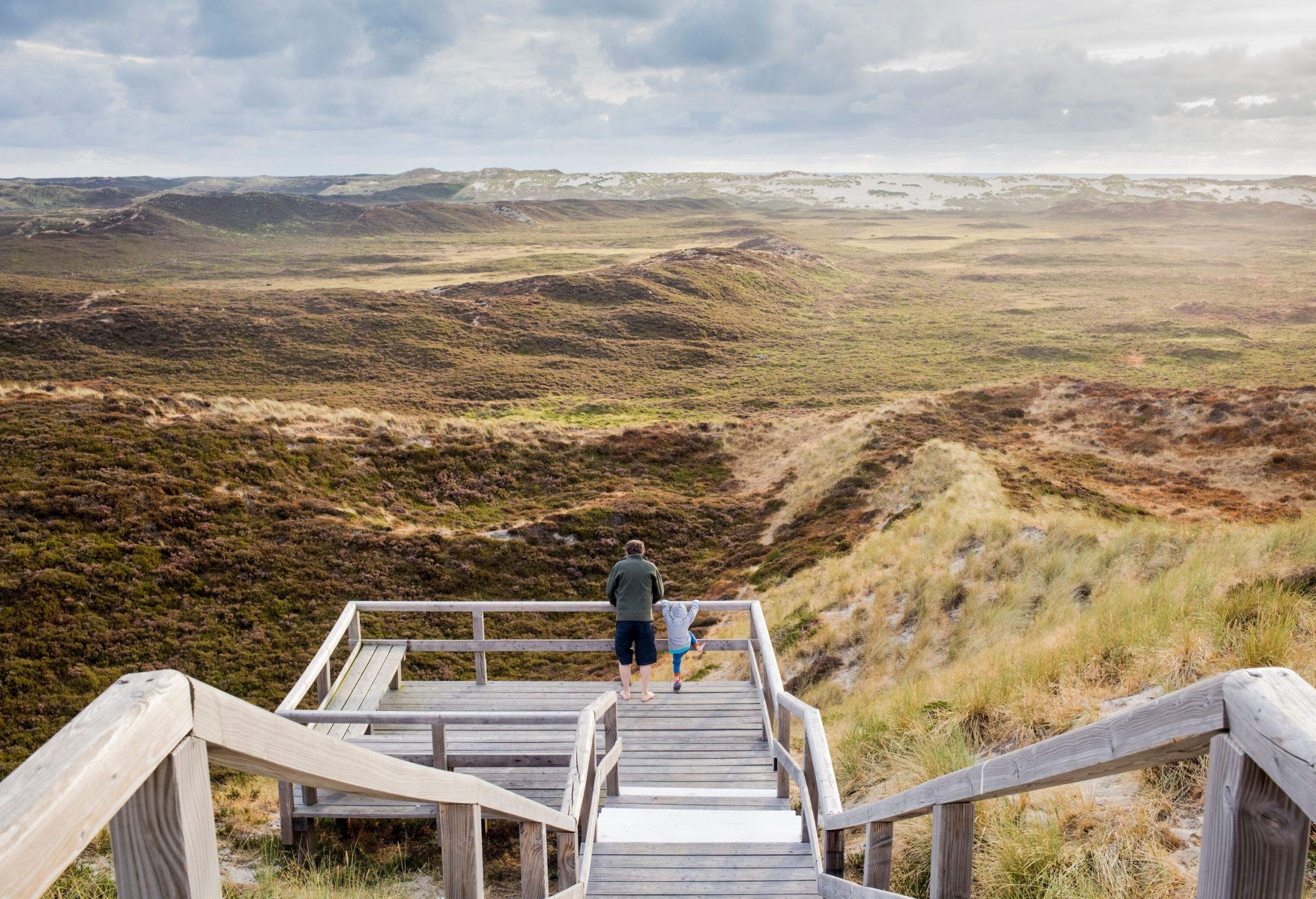
Distance from Sankt Peter-Ording: 80 mi - 2.5 hours including the journey by car train
Sylt is the destination for a seaside vacation and the Wadden Sea National Park awaits. It is best explored on a guided tour. Afterwards, you can admire the dunes and the Red Cliff, and enjoy a fish sandwich at the northernmost fish shack in Germany.
Where to stay on Sylt: Hotel Stadt Hamburg , a chic hotel in the middle of Westerland
Day 4: Fehmarn
Distance from Sylt: 155 mi - just under 4 hours including the journey by car train
Fehmarn is a great island for a family vacation. Beach volleyball, kiting, or splashing around in the waves - there is a beach for every taste on this Baltic island. Children and teenagers can get to know the area with geocaching and if it rains, you can play or relax in the indoor wave pool.
Where to stay on Fehmarn: Strandhotel Bene , beautiful accommodation with a sea view
Day 5: Lübeck
Distance from Fehmarn: 55 mi - just over 1 hour
Start by saying hello to the Holsten Gate and Lübeck's old city, a UNESCO World Heritage Site, Nibble on some famous Lübeck marzipan while you stroll around. Literature fans can visit the Buddenbrookhaus , where you can learn all about the life of Germany’s best-known author Thomas Mann.
Where to stay in Lübeck: Fisher's Loft , a cool city hotel in the center
Day 6: Fischland Darß Zingst

Distance from Lübeck: 120 mi - 2.5 hours
Which is the most beautiful beach in Germany? For many, it is without question the western beach in Darß, which resembles a Caribbean beach. There is also the Vorpommersche Boddenlandschaft National Park, which delights nature lovers thanks to its lagoons, forests, and steep cliffs.
Where to stay in Darß: Domizil am Ostseewald , a spacious vacation rental near the beach
Day 7: Rügen
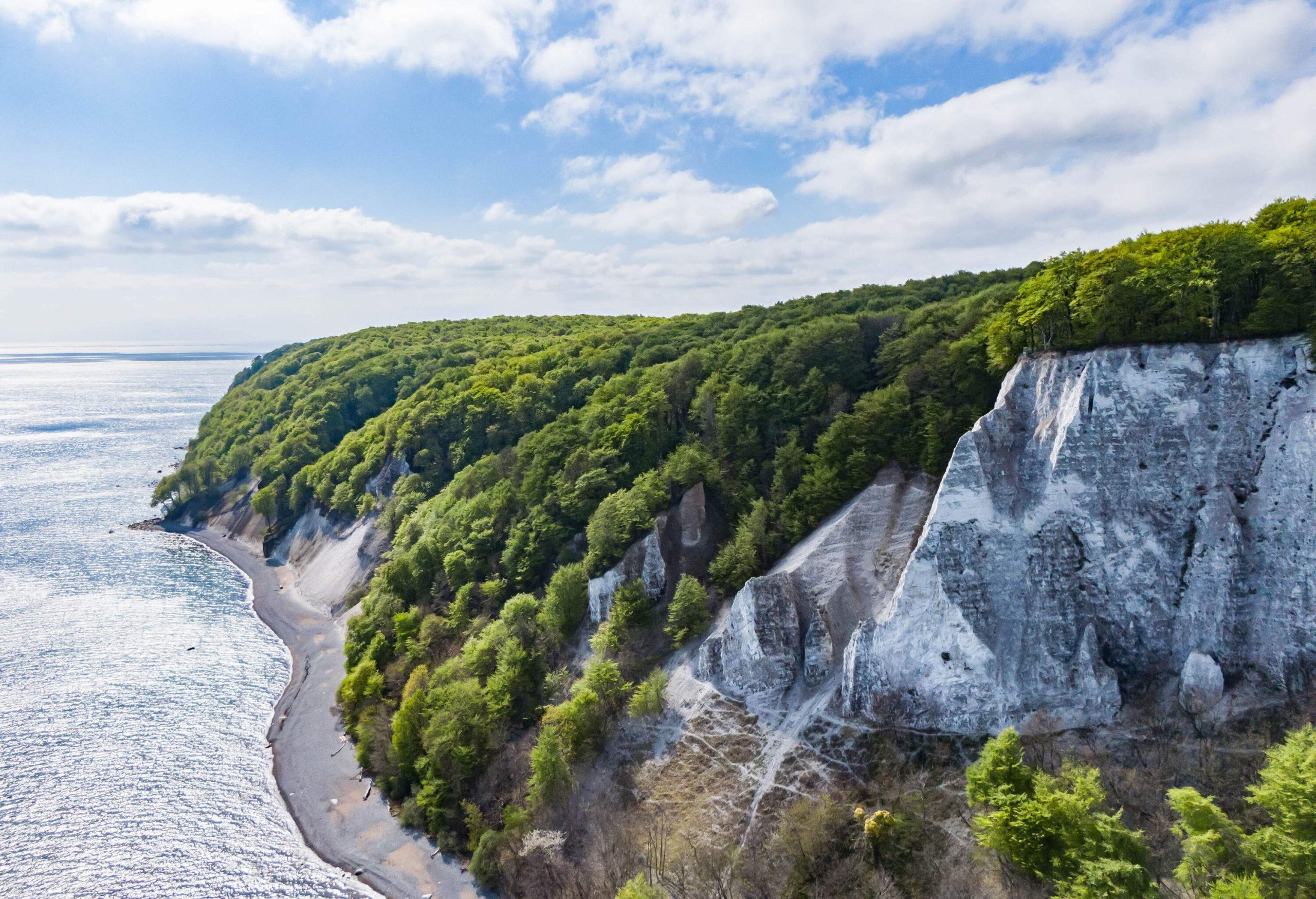
Distance from Zingst: 45 mi - just over 1 hour
In addition to beautiful beaches and one of the most famous piers in the Baltic Sea, Rügen is particularly famous for the Jasmund National Park. Hike to the Königsstuhl and admire the chalk cliffs. A special highlight is the treetop walk with a slide and a great view over the beech forest, a natural heritage site.
Where to stay on Rügen: Der Wilde Schwan , a pretty hotel with sauna
From Rügen, you will either drive back to Hamburg to catch your flight home or to Berlin if you want to add a trip to the German capital. Both cities are approximately 3 hours away by car.
Fancy feeling like a princess or even a queen? This road trip through Germany will take you to the most beautiful castles in Bavaria.
Day 1: München
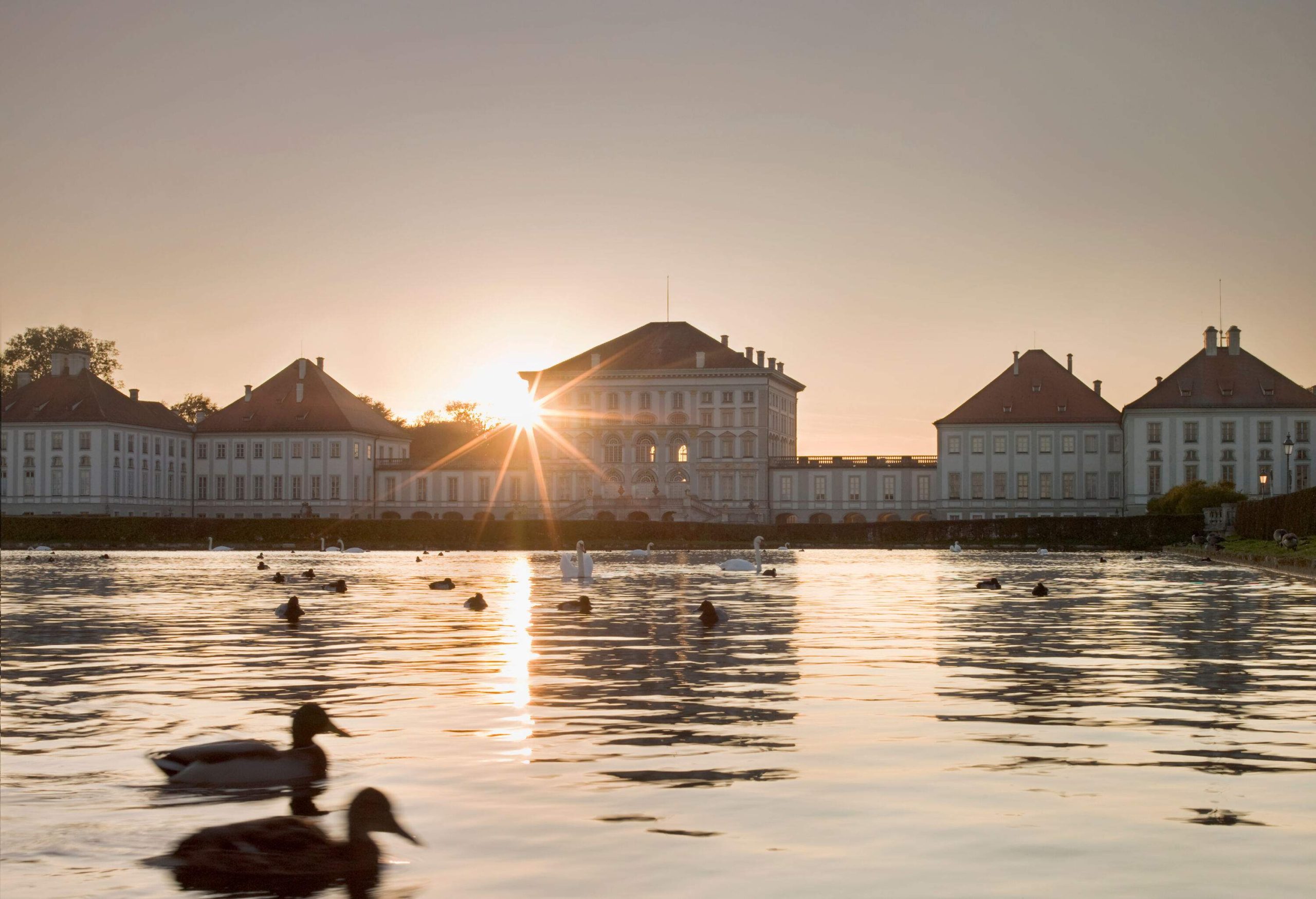
Your fairytale road trip begins in Munich, home to Nymphenburg Palace. Admire the former summer residence of the Bavarian electors and stroll through the fantastic park of the palace. They offer special themed tours for families.
Don’t forget to try a Bavarian veal sausage in a traditional beer garden - but hurry, because they are only served until midday!
Where to stay in Munich: Augustin Hotel , a modern family hotel in Schwanthalerhöhe
Day 2: Füssen
Distance from Munich: 80 mi - just under 2 hours
Germany's most famous castle is located very close to Füssen: welcome to Neuschwanstein! King Ludwig II's home is a real fairytale castle and is charming any time of the year. To visit, you must take part in a guided tour with tickets available online.
Where to stay in Schwangau: Hotel Christine , only 15 minutes away from Neuschwanstein
Day 3: Ettal
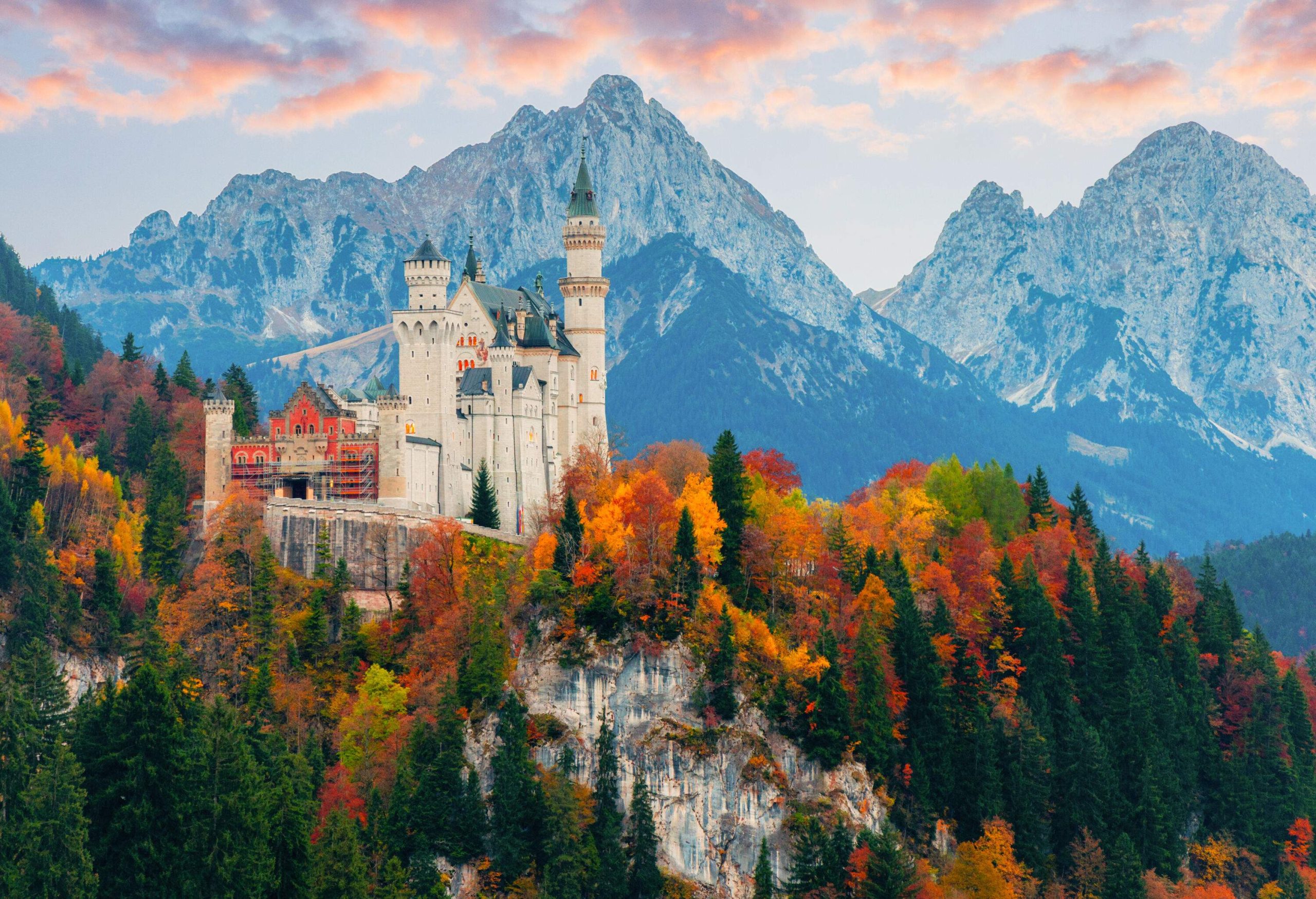
Distance from Füssen: 32 mi - just under 1 hour
The next castle is very close: Linderhof Castle, which was Ludwig II’s pleasure palace that he visited during hunting trips. You also have to book a guided tour and they offer themed tours for children and adults. The castle park is particularly beautiful with the famous Venus Grotto and other interesting building projects the king started.
Where to stay in Ettal: Mammhofer Suite , a charming guesthouse in the heart of Oberammergau
Day 4: Garmisch-Partenkirchen
Distance from Ettal: 9 mi - 20 minutes
Even without a castle, Garmisch-Partenkirchen is a great stopover on your road trip through Bavaria. From here, you can take the cog railroad up to the Zugspitze. At the top, you can enjoy a view over four countries and with a bit of luck and clear skies count a total of 400 mountain peaks.
Where to stay in Garmisch-Partenkirchen: Hotel Zugspitze , a wellness hotel in the middle of the Alps
Day 5: Prien am Chiemsee
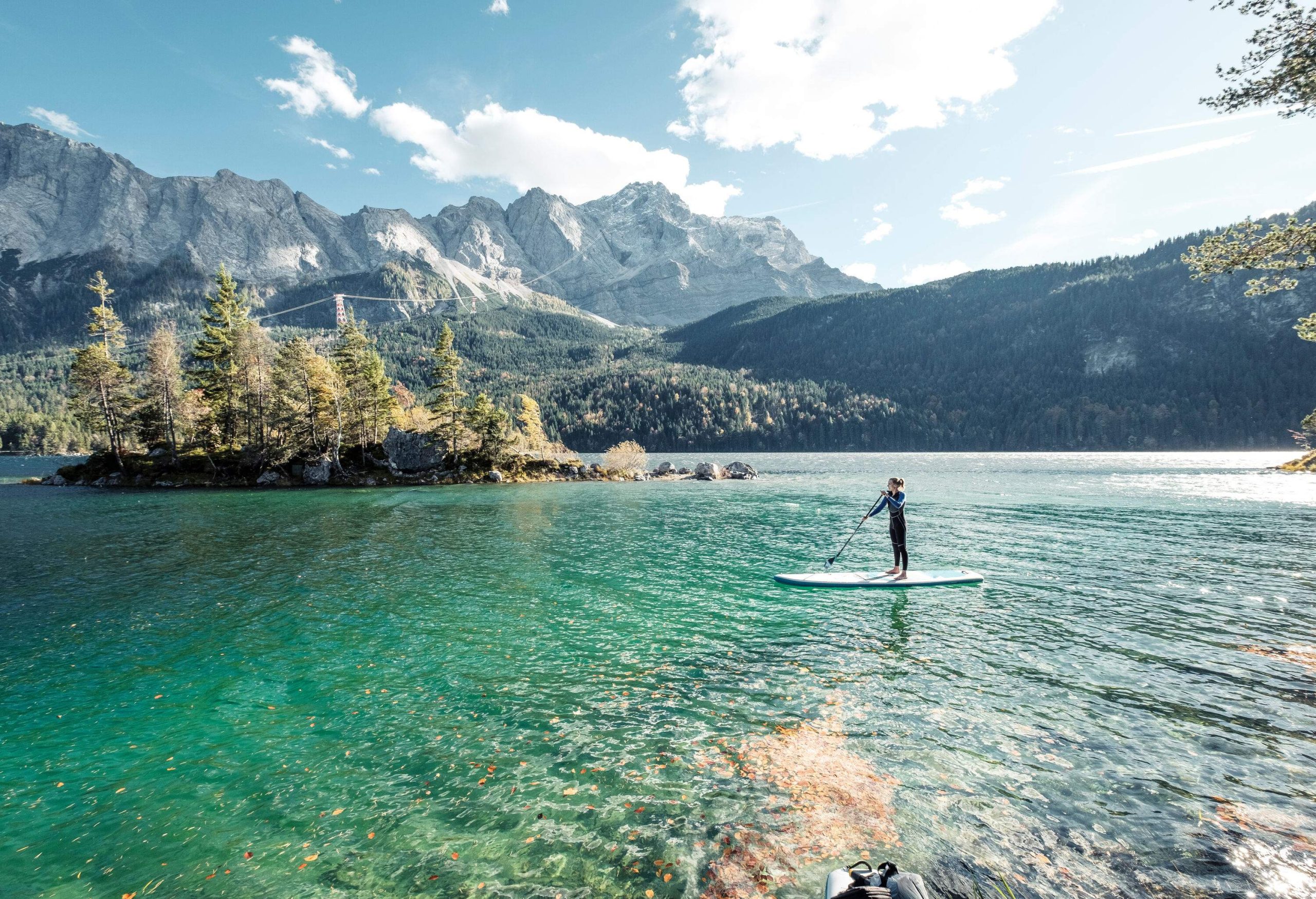
Distance from Garmisch-Partenkirchen: 80 mi - just under 2 hours
Ludwig II's third palace was built on the island of Herrenchiemsee and modeled after Versailles. Even though it was never completed, its hall of mirrors is actually longer than the original’s. You can reach the island by boat from Prien and get tickets for a guided tour at the pier.
Where to stay in Prien: Hotel Zur Sonne , not far from the lake
From Prien, it will take a good hour to get to Munich Airport for your return flight. Make sure to leave enough time to drop your rental car off.
December means Christmas market season in Germany. This one-week road trip takes you from Frankfurt to Berlin to see some of the most beautiful Christmas markets in Germany.
Day 1: Frankfurt am Main
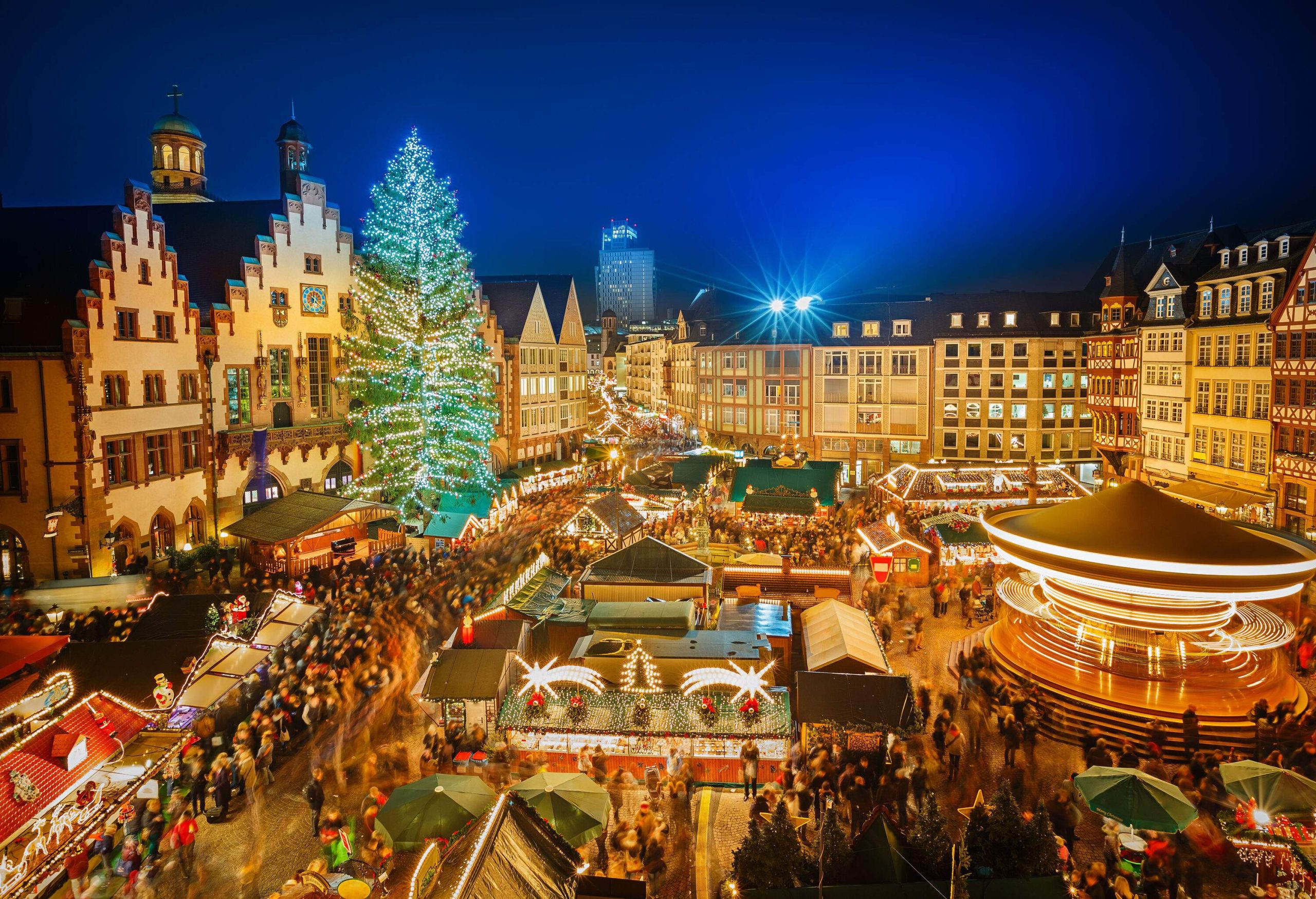
The first Christmas lights are being lit in Frankfurt by the end of November. There are Christmas markets in many parts of the city, but none are as beautiful as the market in the historic old town. My tip: In addition to traditional mulled wine, many local winemakers have stalls in the area. Perfect if you don't like warm wine but prefer Riesling instead.
Where to stay in Frankfurt: Motel One Frankfurt-Römer , a modern hotel near the old town
Day 2: Rothenburg ob der Tauber
Distance from Frankfurt: 112 mi - 2 hours
Admittedly, the Christmas market in Rothenburg ob der Tauber is not the biggest, but the town likes to call itself a Christmas fairytale. It is most beautiful when it snows, but the Christmas lights provide a charming backdrop in any weather. Yummy mulled white wine and the so-called Rothenburg snowballs will warm you up in no time.
Where to stay in Rothenburg ob der Tauber: Burghotel , a medieval hotel on the edge of the old town
Day 3: Nürnberg

Distance from Rothenburg ob der Tauber: 50 mi - just over 1 hour
The Nürnberg Christmas Market is one of the oldest and most beautiful Christmas markets in Europe. Nibble on traditional gingerbread and sausages while you shop for handicrafts. A highlight are the adventure trails, which allow you to discover completely new parts of the market.
Where to stay in Nürnberg: Hotel Drei Raben , a central accommodation not far from the market
Day 4: Erfurt
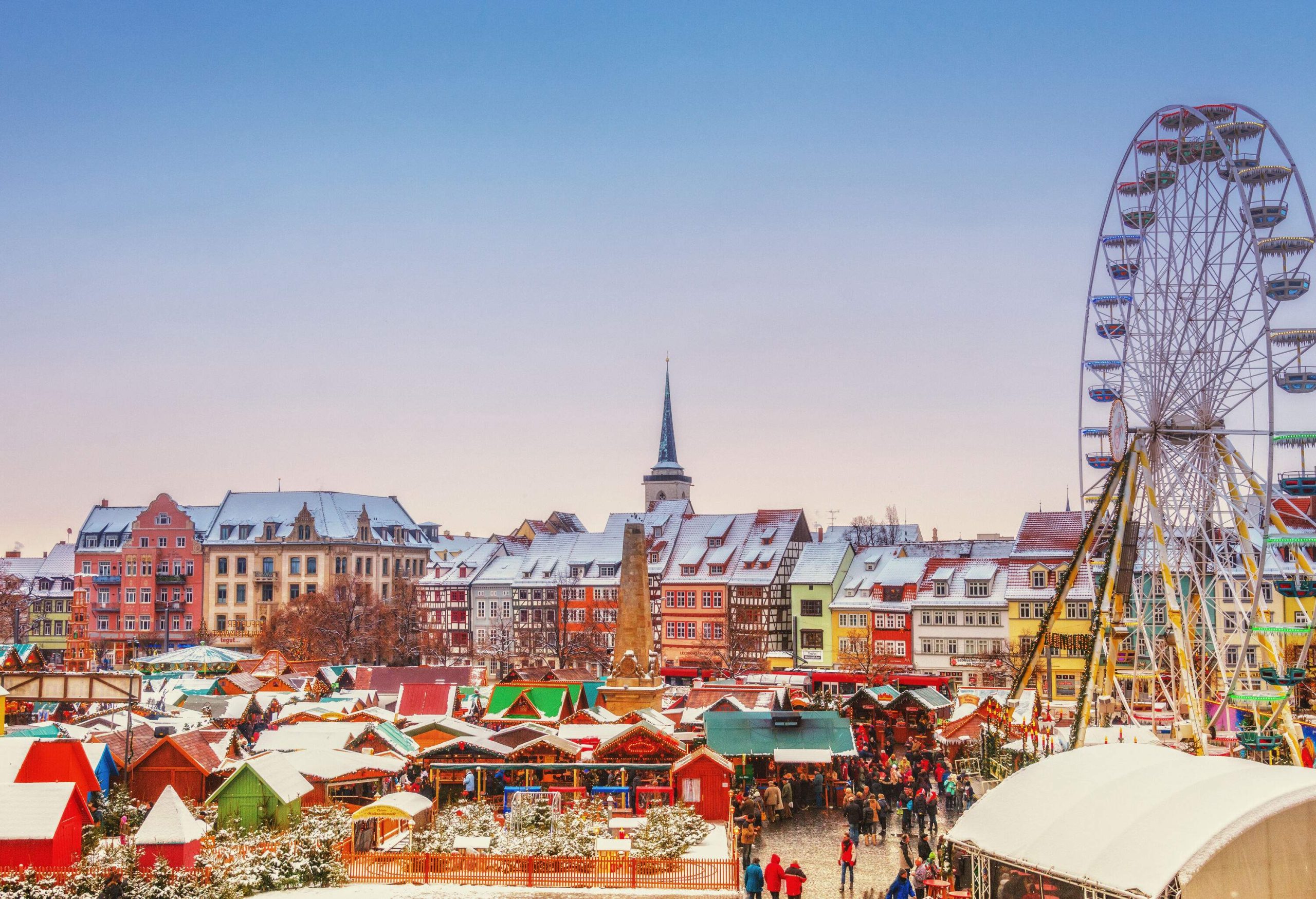
Distance from Nürnberg: 143 mi - 2.5 hours
One of the most beautiful medieval Christmas markets in Germany opens its doors every year in front of the cathedral in Erfurt. In addition to local delicacies and crafts, it is particularly famous for its life-size nativity scene. If it gets too busy you can relax in the enchanted Christmas forest at the edge of the market.
Where to stay in Erfurt: Hotel Domizil , a lovely accommodation close to the cathedral
Day 5: Leipzig
Distance from Erfurt: 93 mi - just under 2 hours
Leipzig is one of my absolute favorite cities in Germany and it shines especially bright in the weeks before Christmas. The Christmas market in front of the old town hall dates back to the 15th century. It gets particularly festive when the famous Thomanerchor opens the market with Christmas carols.
Where to stay in Leipzig: Radisson Blu Hotel , with a great view of the Augustusplatz
Day 6: Dresden
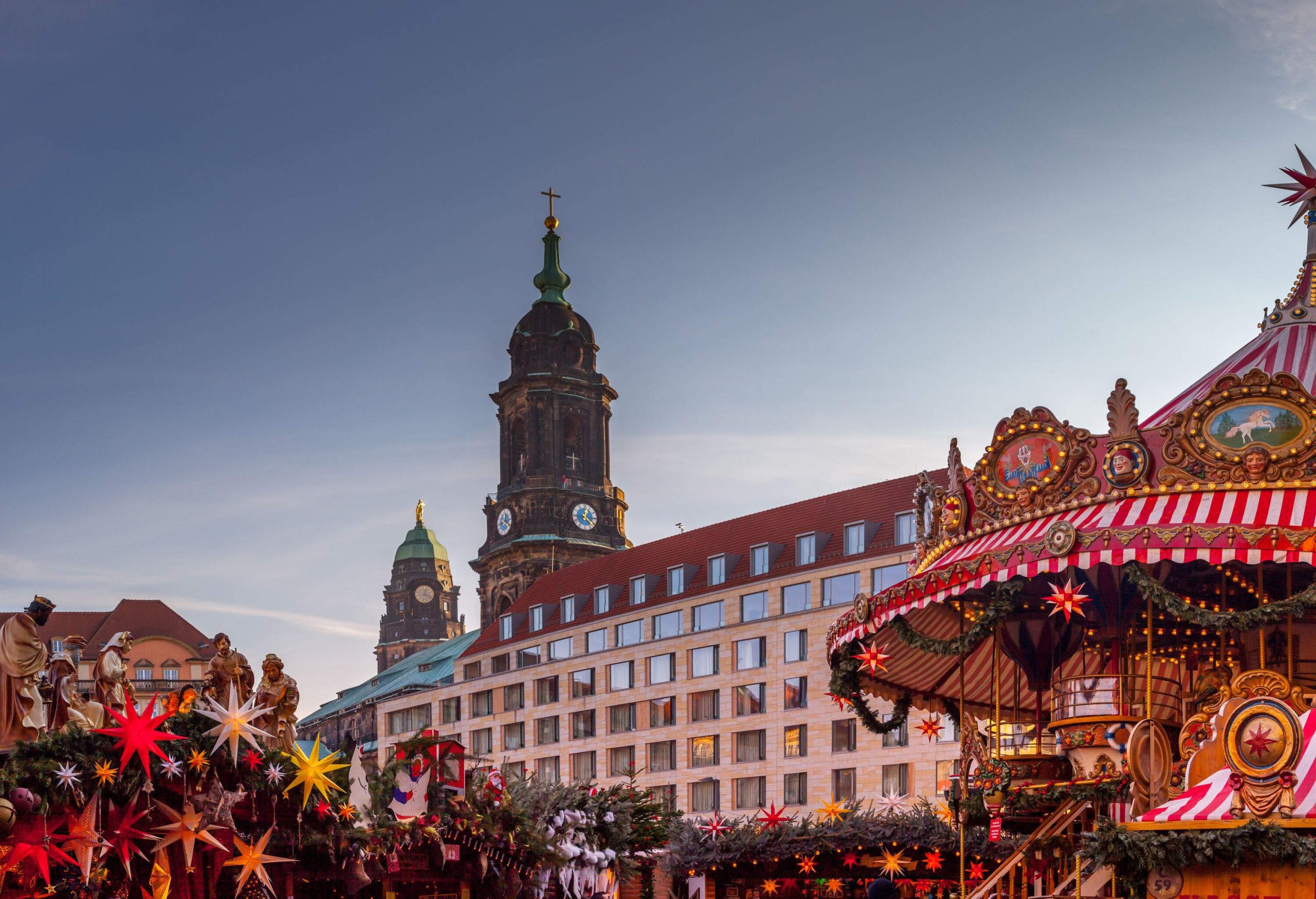
Distance from Leipzig: 137 mi - 2.5 hours
Dresden's Striezelmarkt has the official title of being the oldest recorded Christmas market. During a stroll, you can buy delicious Dresden Christmas Stollen, a famous fruit bread with its very own festival. You can also admire beautiful pyramids and candle arches all over the market. And yes, you can buy some to take home too!
Where to stay overnight in Dresden: Townhouse Dresden , a luxury hotel right next to the Frauenkirche
Day 7: Berlin

Distance from Dresden: 125 mi - just over 2 hours
Berlin is one of the coolest destinations in winter and of course, there is not just one Christmas market in our capital. From traditional to just a little bit different, Berlin's Christmas markets have it all. The historic Christmas market at RAW and the Winterworld at Potsdamer Platz, where you can go sledding too, are particularly beautiful.
Where to stay in Berlin: Wild Aparthotels, cool studios right by Checkpoint Charlie
After your Christmas Market trip, it is best if you catch a connecting flight from Berlin to Frankfurt for your international departure. Alternatively, you might be able to book a multi-city flight with arrival in Frankfurt and departure from Berlin.
If you fancy a truly epic road trip through Germany, you can also combine the three suggested routes and drive across the whole country.
US citizens can use their US driver’s license to drive in Germany for a stay of up to six months. If you plan on staying longer you will need to get a German license as well.
You need to be at least 18 years old to legally drive a car in Germany. Most car rental companies have a minimum and a maximum age requirement for the driver. Sometimes you also have to prove that you have had your license for a certain number of years.
Remember that Germans use the metric system. Distances are shown in kilometers (km) and speed in kilometers per hour (kph). Also, petrol prices are shown per liter, not per gallon.
While the German Autobahn is world-renowned for not having a speed limit, don’t get too excited - there are only very few stretches where you can drive to your heart’s content. And of course, you need to be mindful of the traffic around you as well as your driving skills.
Here are some more tips for driving in Germany.
Flight and hotel rates are averages based on data collected by KAYAK. These prices offer an estimate for organizing your trip, but they may vary according to offers, period, destination or your preferences. The price per liter of gasoline, as of April 1st, 2024, is subject to fluctuations, and comes from numbeo.com.
The hotel recommendations included in this article are based on customer ratings and the author's personal choices, so please feel free to use our hotel finder to find the accommodation best suited to your needs.
About the author
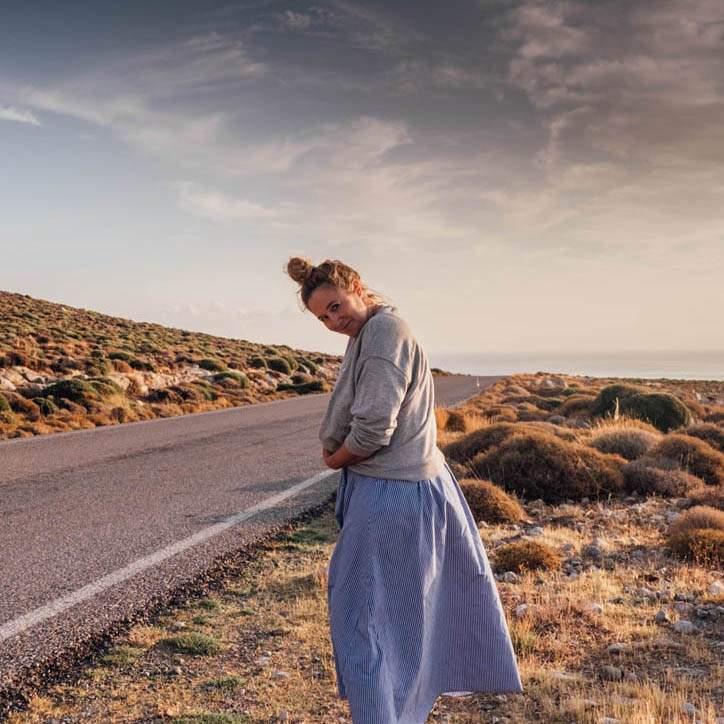
Explore more articles
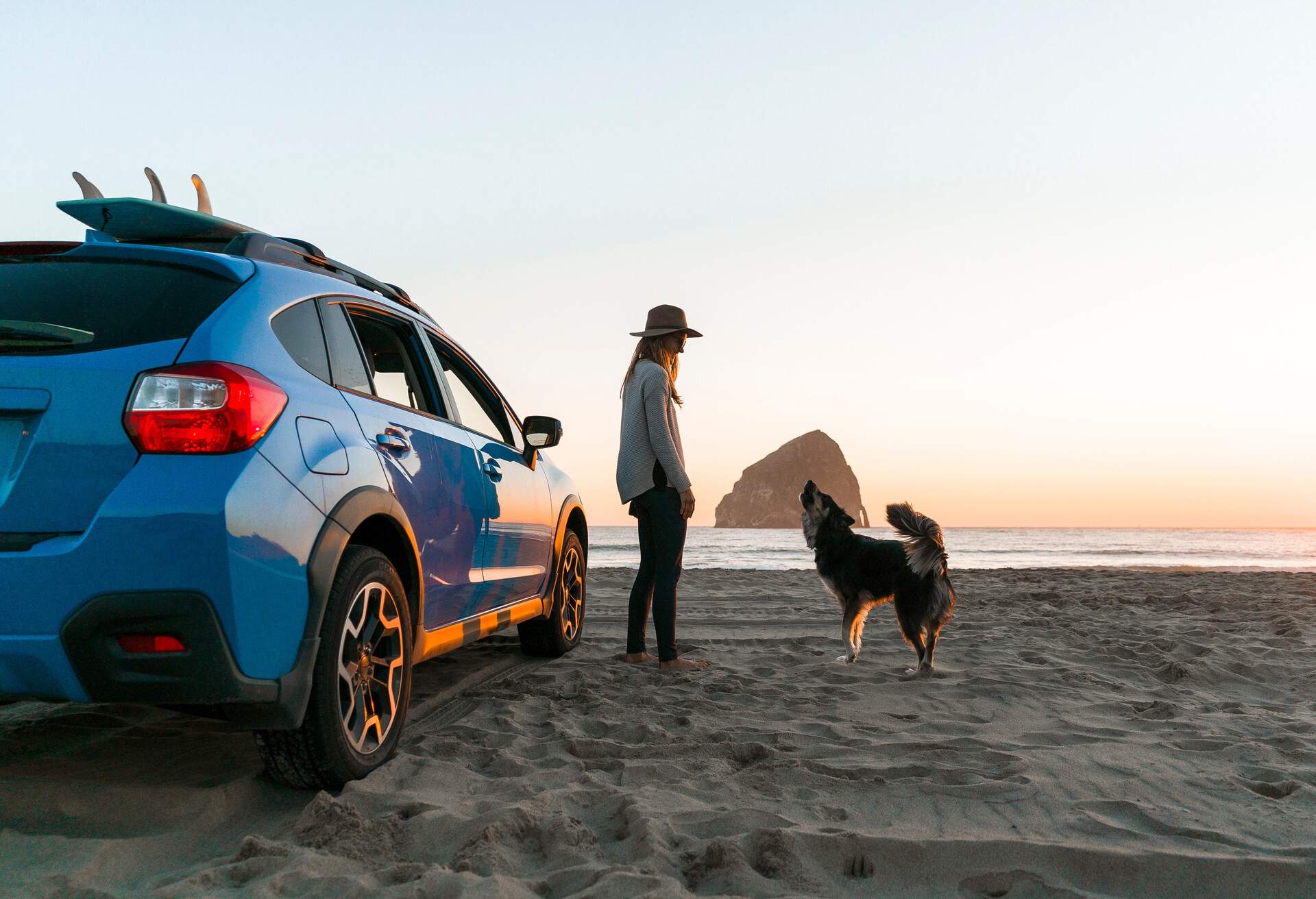
California consumers have the right to opt out of the sale * of their personal information. For more information on how we securely process personal information, please see our Privacy Policy .
Do not sell my info ON
* The definition of "sale" under the California Consumer Privacy Act is applicable only to California consumers.
Your Guide To Renting A Car In Germany
- Why should you rent a car in Germany?
When should you go to Germany?
Where should you pick up a car in germany, how easy is it to travel around germany independently.
- How safe is it to travel around Germany by car?
What languages are spoken in Germany?
- What is German culture like?
- What are the best places to rent a car in Germany?
- What about filling up in Germany?
- How expensive is gas in Germany?
- How much does a rental car cost in Germany?
- Which car rental company in Germany offers the lowest rates? What are some tricks for getting a better deal?
- Which car rental supplier is best for you? Are the rental conditions important?
- What else should you keep in mind when renting a car?
- How can I choose the right insurance for my rental car?
- What type of rental car is the cheapest in Germany?
- Which is the best car rental company in Germany?
- What is the process of picking up and dropping off a rental car like?
- Can I add extras for the rental car when booking?
- What are the traffic rules in Germany?
- What are the speed limits in Germany?
- Are there speed cameras in Germany?
- What are the drunk driving laws in Germany?
- Are there toll roads in Germany?
- Germany is home to a wealth of beautiful cities - Berlin , Hamburg , and Munich are the most famous ones, but the likes of Leipzig , Dresden , and Freiburg can be just as exciting
- Although heavily industrialized, Germany is also known for its beautiful nature as exemplified by the Bavarian Alps, the Black Forest, and islands of the Baltic Sea
- One of the best ways to save your money on the rental car is to pick it up right at the airport . There are almost 30 airports with scheduled international flights.
- Another good way to save money on the rental car is to book it in advance as early as possible
- Early spring can be a good time to visit Germany - statistically, March is one of the cheapest months to rent a vehicle
- Despite the common assumption, there are speed limits on about 50% of German autobahns .
- Familiarizing yourself with rental conditions before the trip is a good way to avoid any unexpected surprises!
Your Guide to Traveling Around Germany with a Rental Car
How safe is it to travel around germany in a rental car.
- Full-to-full You are given a car with a full tank of fuel and are expected to also return it with a full tank which means that you need to fill up the tank right before dropping off the car.
- Same-to-same You are given a car with a certain amount of fuel and are expected to return the car with the same amount.
- Full-to-empty You pay in advance for a full tank of fuel when picking up a car and are allowed to return the car with an empty tank; in these cases, you may or may not be compensated if you return a car with some fuel left in the tank.
- The minimum and maximum age of the driver
- A potential young or senior driver extra fee for drivers under or over a certain age (e.g. 25 or 65 years old)
- Driving experience (e.g., at least two years)
- A credit card in the name of the main driver
- An international driver's license (might not apply to driver's licenses that are in Latin alphabet)
- Meet & Greet . With this type of pickup location, you'll be met by an employee of the car rental company in the arrivals hall of the airport which you normally enter right after leaving the baggage claim area. The employee will usually have a printed sign with your name on it. The employee will take you to the company's office to proceed with signing the rental contract and collecting the car's keys.
- In the terminal. In this case, you will have to find your rental car company's desk yourself. The desk will be usually located in the arrivals hall. Once you've found the desk, you can present your documents and continue with the pickup procedure. Do keep in mind that you might have to wait in line.
- Shuttle bus. In certain cases, the car rental company's desk might be located outside the airport's terminal. Sometimes you can reach it on foot, but in most cases, you need to take a shuttle bus. For this, you'll need to find the shuttle bus stop inside the airport, the location of which will be given to you when making the booking. Sometimes, the shuttle bus is shared by multiple car rental companies while others have their own shuttle service just for them. Look for the name and the logo of your rental company to make sure you take the right shuttle bus.
- Delivery service . This type of pick-up is similar to Meet & Greet but takes even less time to complete as you won't need to go to the car provider's office to sign the agreement.
- Car rental center . This means that your car rental company shares its location with other companies. The car rental center is located in the arrivals hall, in another part of the terminal, or in a separate building next to the terminal.
- Outside terminal . This pick-up location means that your car rental company has an individual desk located outside the airport's terminal, but within the larger airport complex, that can usually be reached on foot
- Germany drives on the right-hand side of the road.
- Proof of insurance and the car's documentatio n need to be in it whenever you're driving.
- When driving, you need to have your passport or ID card with you at all times.
- The use of the mobile phone while driving is only permitted with a hands-free system that has a loudspeaker and a fixed microphone.
- All travelers from outside the European Union are required to show an International Driving Permit . Not having one can lead to the rental company refusing to provide you a car and the loss of any payment made.
- The nationwide emergency number , like elsewhere in the European Union, is 112.
- There are no speed limits on some autobahns of main highways, but drivers are nonetheless advised to follow common sense
- There are individual speed limits on about 50% of autobahns, and these can differ from one autobahn to the next
- Some autobahns have a minimum speed limit that applies to specific lanes, for example, a minimum speed of 110km/h (68mph) for the left and 90km/h (56mph) for the center lane.
- Unless specifically indicated otherwise, the speed limit is 50 km/h (31 mph) inside cities and other populated areas
Aleksandrs Buraks
Related posts.

The Ultimate Guide for Car Lovers in Germany
This post contains affiliate links, which means we may receive a small commission, at no additional cost to you, if you make a purchase through these links. See our full disclosure here .
If you’re into cars, then Germany is the country for you. A longtime titan of the global auto industry, it has the fourth-biggest auto manufacturing market in the world, only behind China, the United States, and Japan. They take vehicle manufacturing seriously, with a number of iconic brands hailing from within its borders, and love to showcase their craftsmanship in a number of delightful ways.
Whether you’re a serious car enthusiast or a casual fan, there are plenty of experiences available for tourists to Germany. From exquisite auto museums to unique tours, there is no other country more suited to fulfilling the whims of motorheads everywhere.
If you’re currently planning an auto-themed vacation, check out these activities that highlight the legendary German automotive industry. You may just find something you won’t want to miss.
The Porsche Museum, Stuttgart
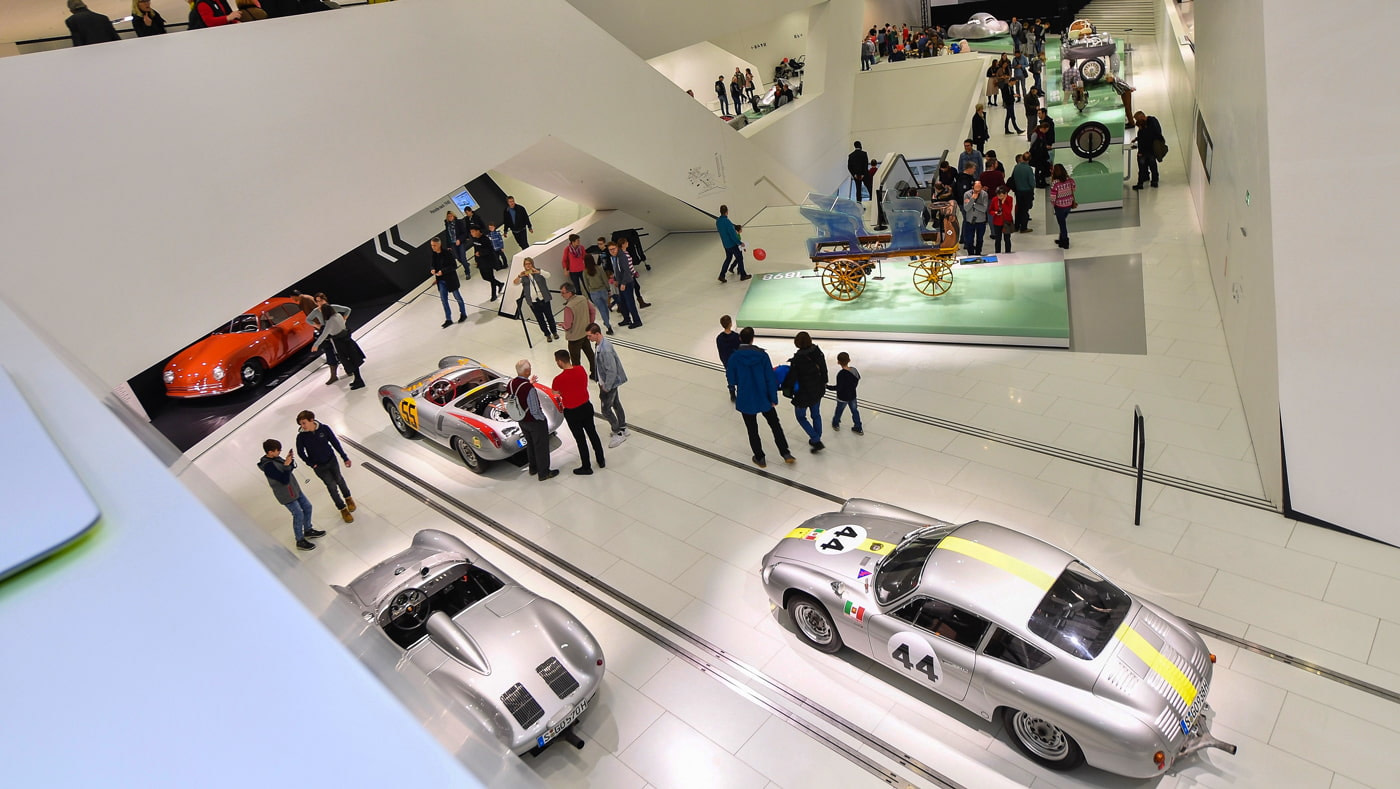
The Porsche Museum was opened in 2009 to showcase the history of the brand. It is arranged as a chronological journey through every major release, from the manufacturer’s beginning with the 356 “No. 1” Roadster, the original flagship car of the brand, to the concept cars of the future. The entire collection is composed of over 700 cars, 200 of which are race cars.
A highlight of the museum is the workshop, where Porsche mechanics repair, restore, and maintain vehicles in full view of visitors behind a glass wall. Even though Porsche is one of the most iconic luxury brands in the world, there’s a lot here to delight and surprise even the most experienced auto historian.
The Autobahn
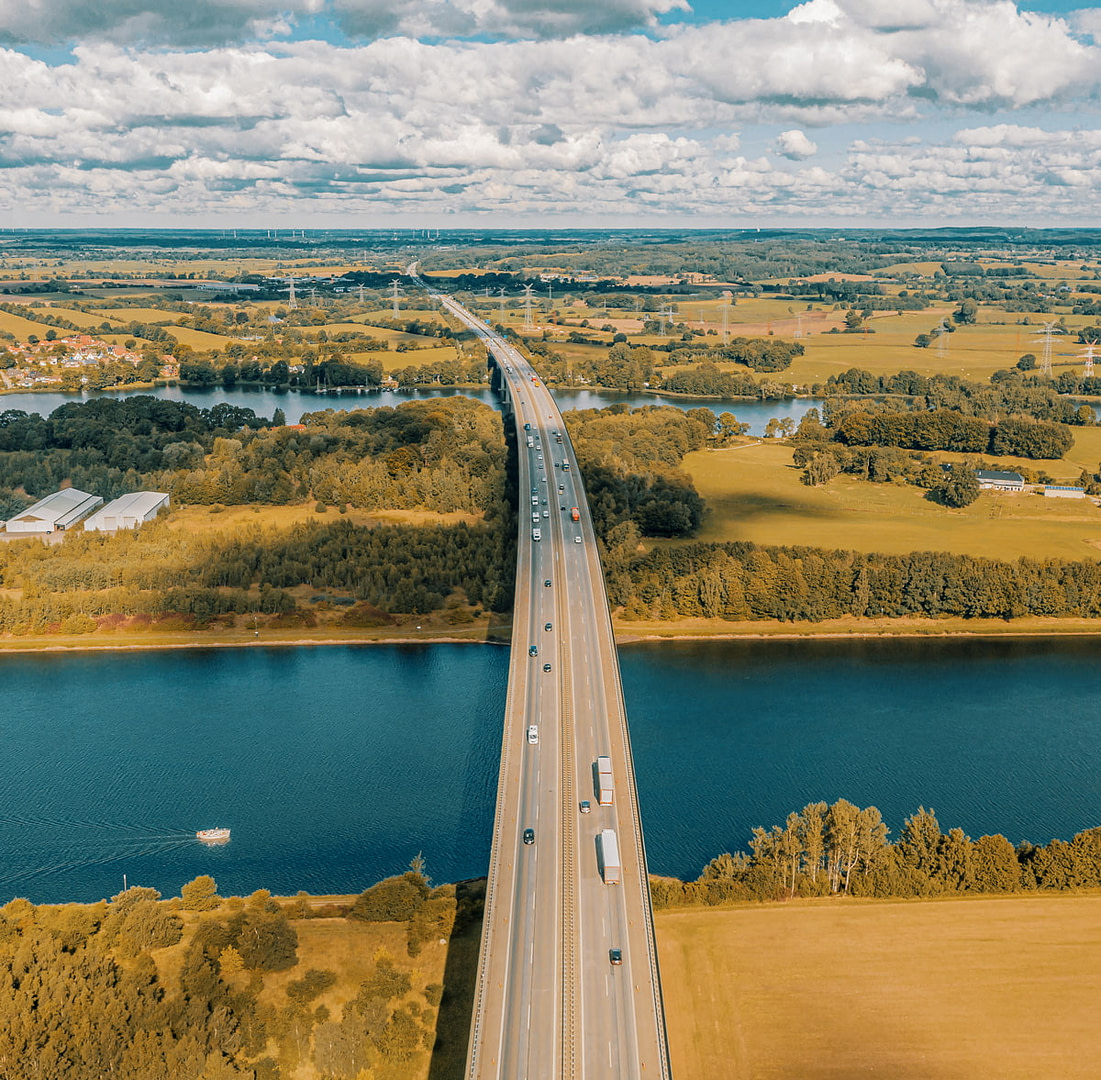
Short for Bundesautobahn which means roughly “federal motorway” in German, the autobahn isn’t a particular stretch of road or track, but rather just what you’d call a freeway in German.
What makes Germany’s autobahnen stand out is that outside of sections of it that are urban or undergoing construction, the 130 km/hr speed posted isn’t actually a legal limit, but rather a suggestion. That means that about 70% of highways crisscrossing Germany are technically available for you to drive as fast as you please. Many tourists opt to rent a sports car by the hour or the day from one of Germany’s iconic brands just to test the limits of its performance on Germany’s open roads, and you can, too.
Trabi Safari, Berlin
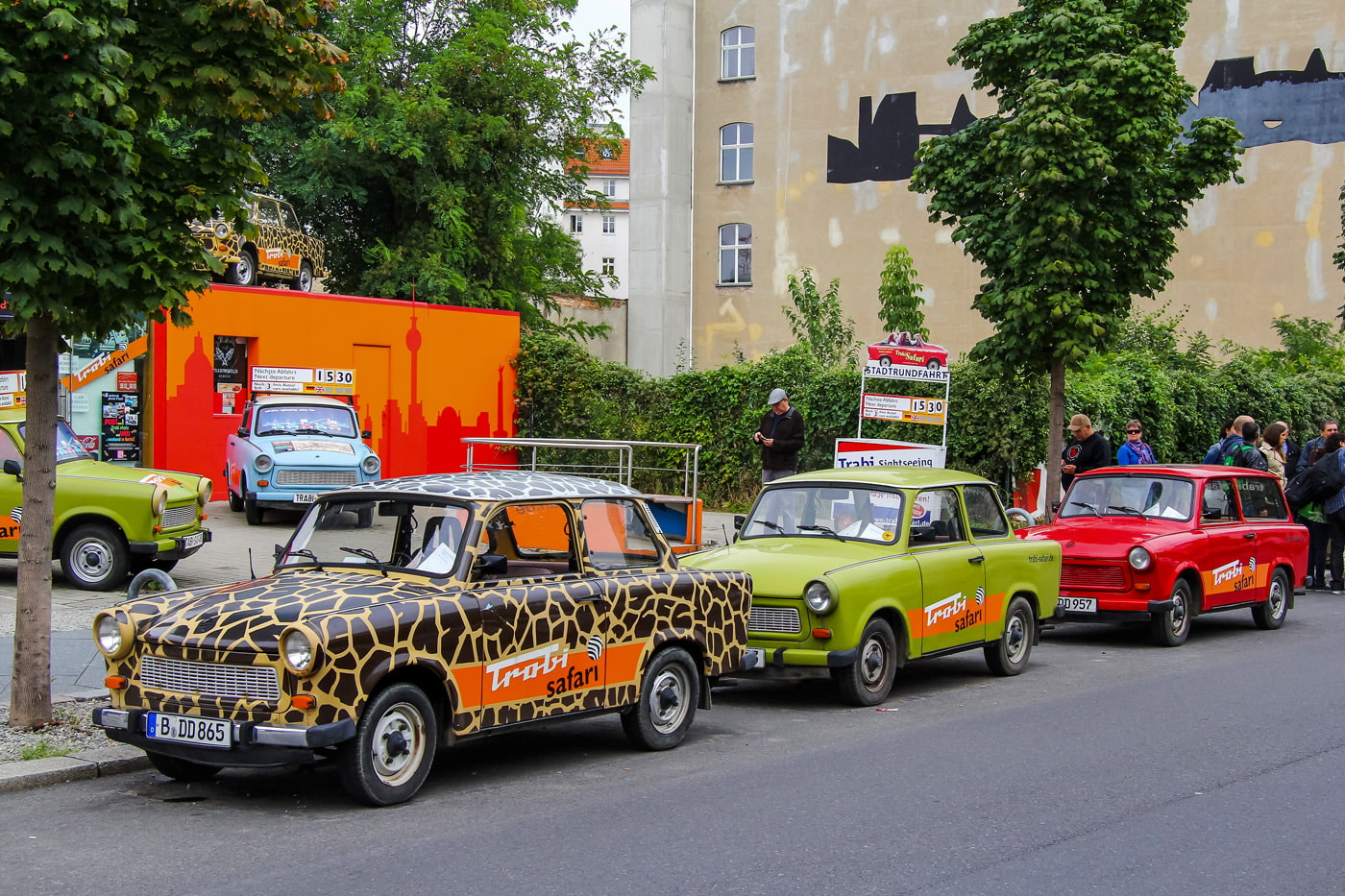
If you’re not from Germany, you may be unfamiliar with the Trabant. Colloquially called a Trabi, these cars were produced by former East German car company VEB Sachsenring from 1957 to 1990. The company folded after the fall of the Berlin Wall, but the cars remained.
The Berlin-based company Trabi World uses a restored fleet of them for a unique urban tour called Trabi Safari . On this tour, you and your party will drive your own Trabi through the streets of Berlin in a caravan of other tourists led by your guide. The guide’s anecdotes can be heard through the radio, so you’ll get the same context as you would in a traditional city tour. Along the way, you’ll get to see some of the highlights of Berlin, like Karl-Marx-Allee and the East Side Gallery.
Mercedes-Benz Museum, Stuttgart
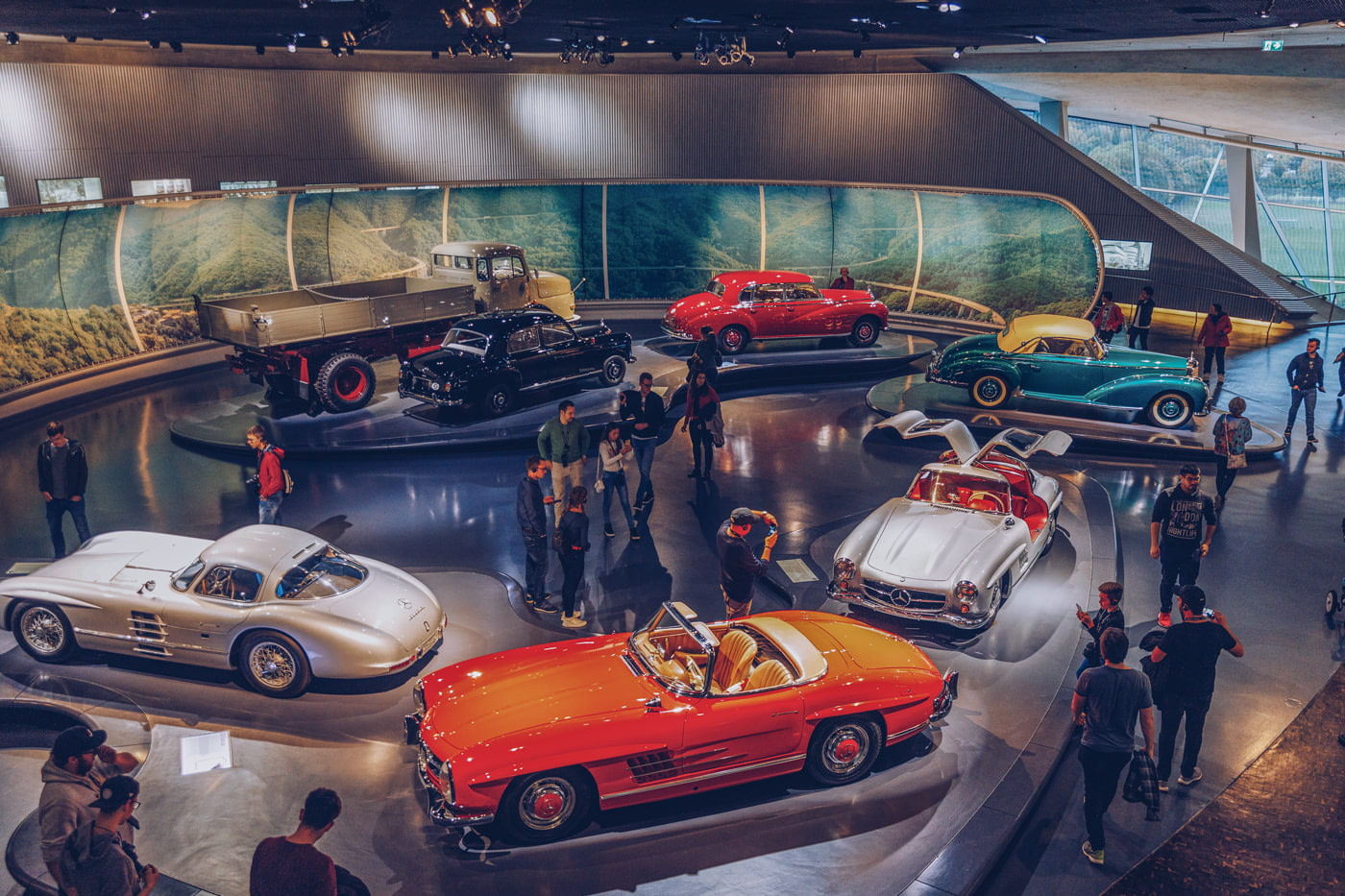
Not only does it tell the history of Mercedes-Benz as a singular car manufacturer, but via its collection of 160 vehicles and 1,500 exhibits, the Mercedes-Benz Museum tells the story of the auto industry as a whole.
With installations on nine levels covering a total space of 16,500 square meters, it’s one of the most comprehensive and expansive auto museums in the world. There are free audio guides available in eight languages to guide you through the exhibits and give you a more comprehensive insight into what is displayed.
Volkswagen Factory, Wolfsburg
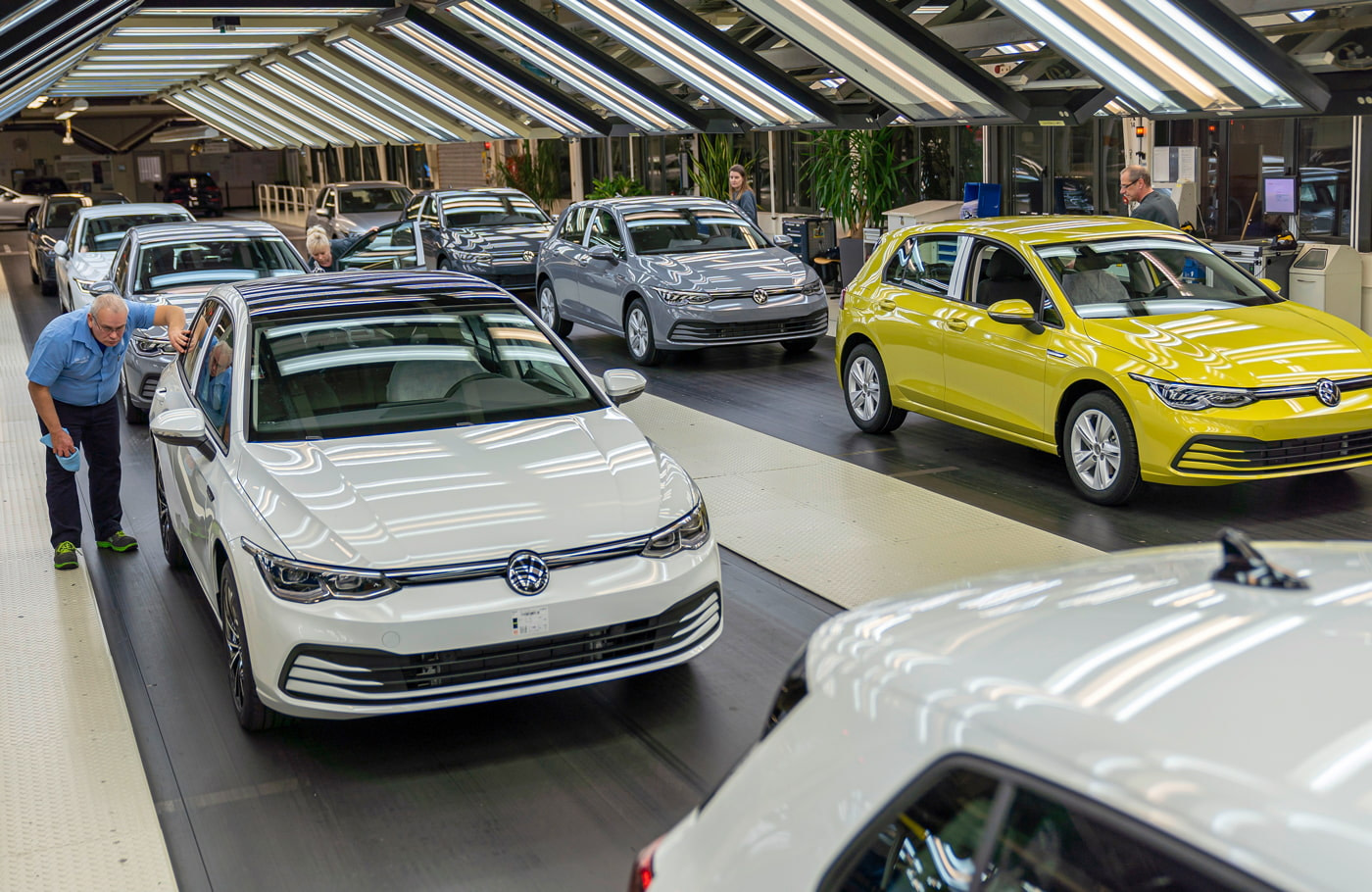
Europe’s largest car factory, the Volkswagen Factory in Wolfsburg was opened in 1938 and spans a thousand acres. It employs over 70,000 people, and nearly 100,000 cars are manufactured there every year. The factory is such an integral part of Wolfsburg that in 2003, the city was briefly ceremoniously renamed “Golfsburg” to commemorate the launch of the fifth-generation VW Golf. You can tour the facility to see how the cars are manufactured, but you’ll have to reserve your spot at least 24 hours in advance.
Autostadt, Wolfsburg
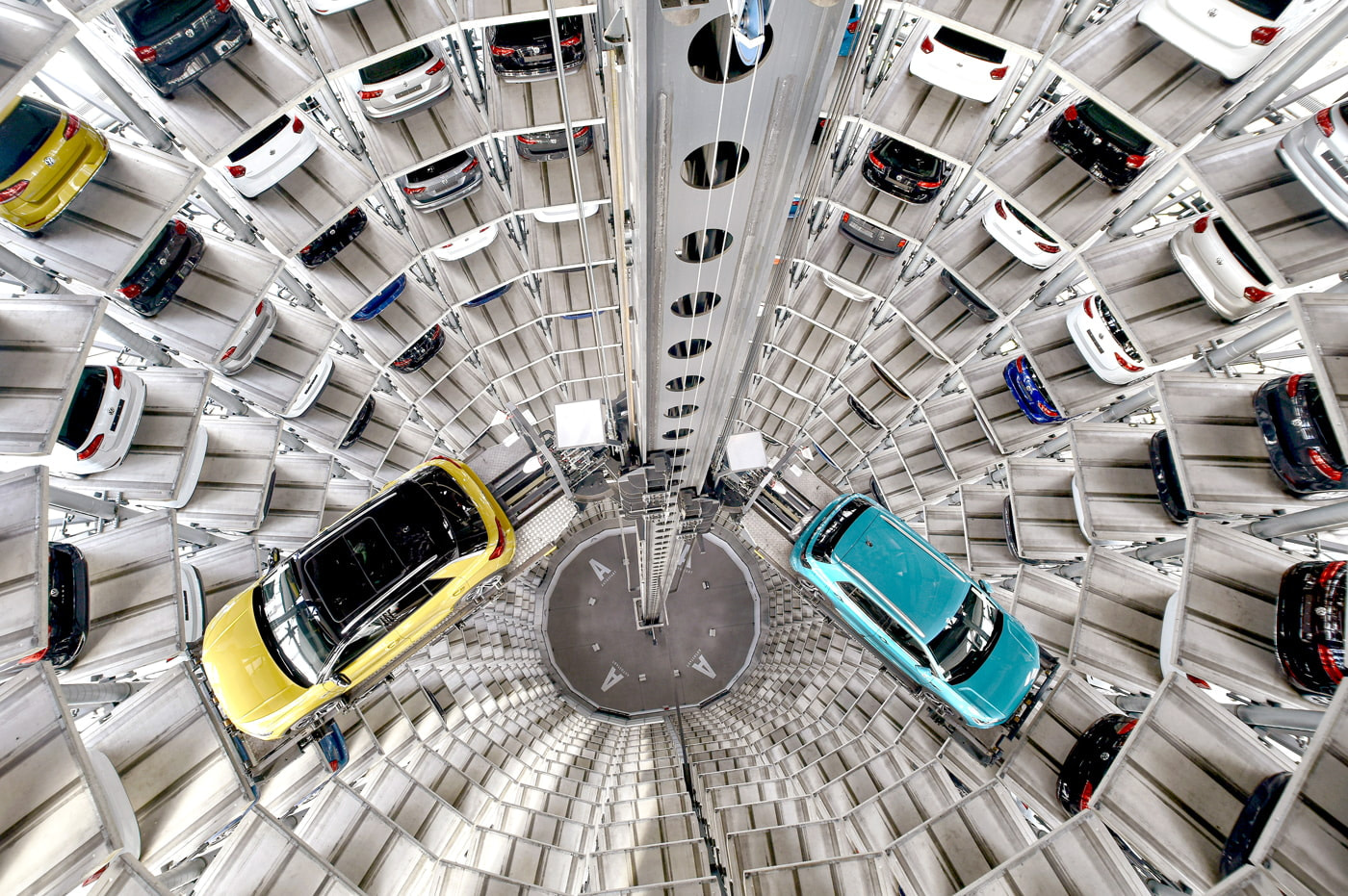
Unlike the Automuseum, which is also in Wolfsburg, the Autostadt museum showcases not only cars produced within the city, but also from the additional brands that VW owns like Audi, Lamborghini, and Bentley.
Spread across 8 pavilions, the collection is composed of over 1,000 classic cars and 300 representatives of models that are still being produced today. The highlight of the facility is probably the AutoTürme, two enormous glass towers connected to the factory by an underground tunnel. Within them are stored production cars fresh from the factory, ready to be collected by consumers, or delivered to dealerships around the world.
V8 Hotel, Stuttgart
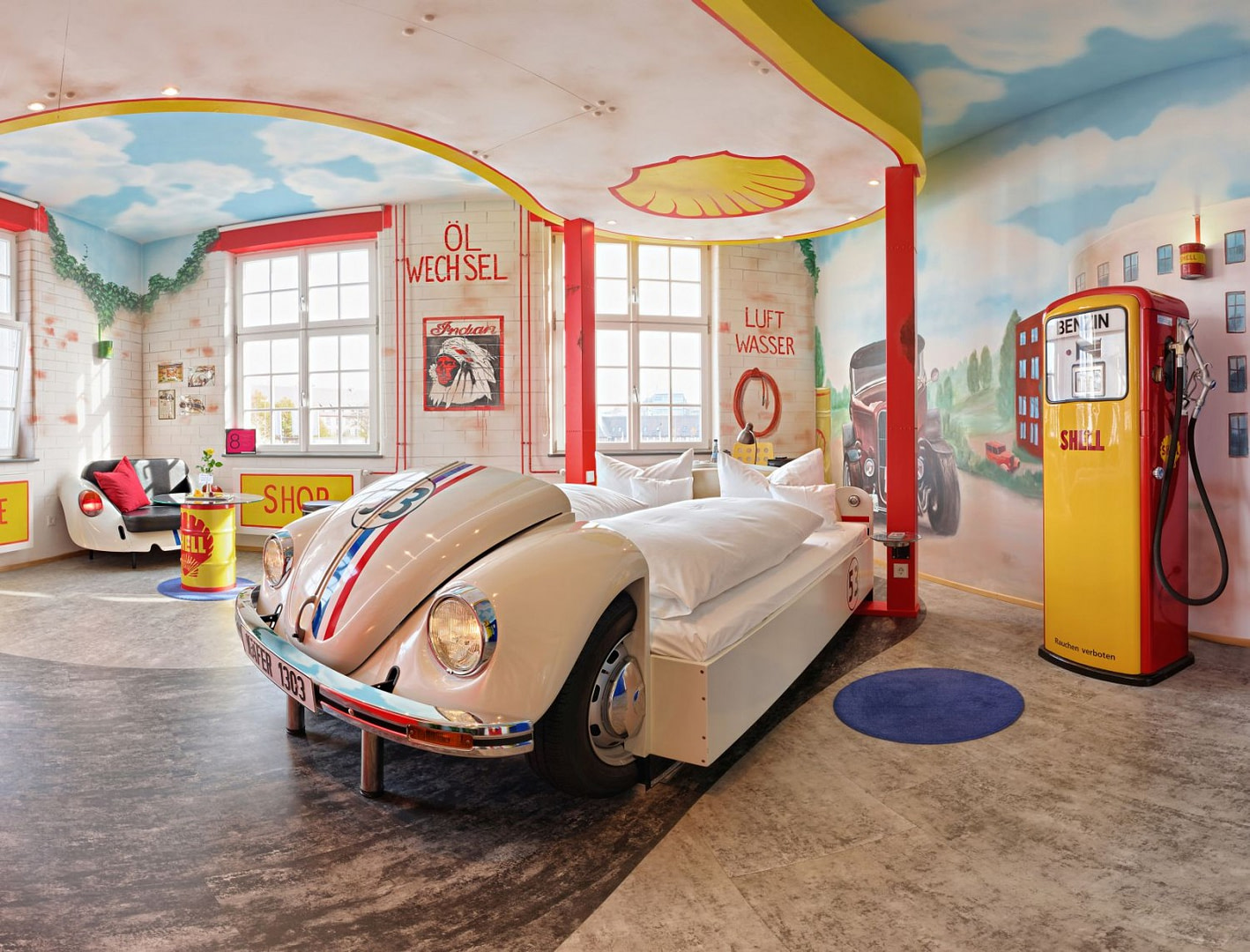
Situated in the heart of the MOTORWORLD Region Stuttgart, V8 Hotel – with its car-themed rooms, house brewery, and full-service spa – guarantees a unique, memorable stay for car lovers in Germany.
Guests can choose to sleep in a Cadillac Coupe in the Drive-In Cinema room; relax in a Herbie-shaped VW bed in the Gas Station; or luxuriate in a Mercedes-Benz in the exquisite Tower Suite, which comes with its own private sauna and furnished rooftop terrace. Other themed options include Racing, whose décor revolves around Formula 1; Route 66, with its original motorcycle accessories; and the cheerful Camping Room, complete with hammock and chic garden furniture.
You’ll find the car-themed V8 Hotel in the terminal of the former Böblingen Airport, conveniently close to bars, restaurants, and a delightful vintage auto museum.
Nürburgring Race Track, Nürburg
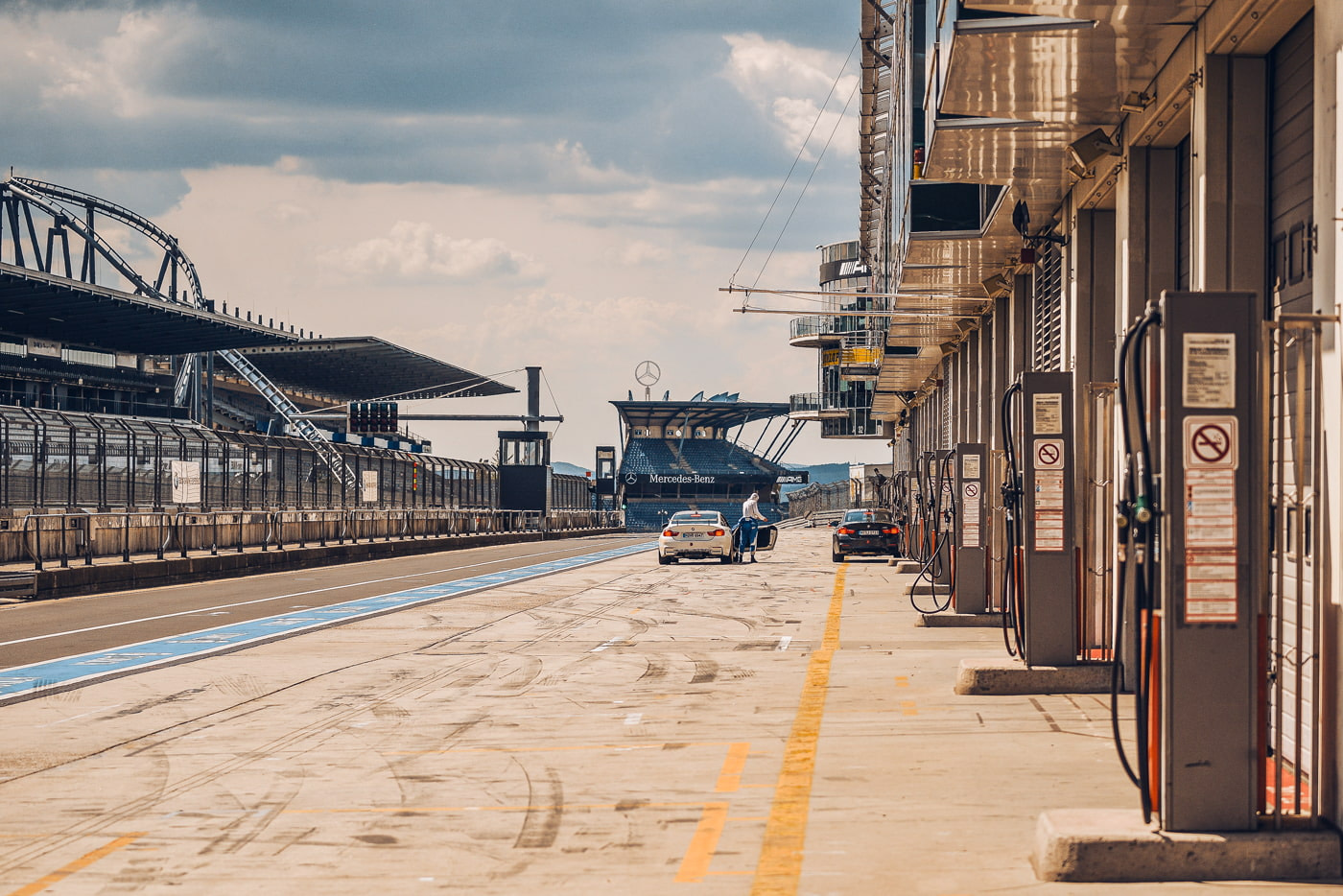
Opened in 1927, Nürburgring is both a commercial racing track and a divertissement for thrill-seeking tourists. With the exception of race days and times when the entire track has been rented privately, the facilities are open to anyone who cares to bring their road-legal car or motorcycle to open it up on the track.
The facility was initially built as a test track for auto manufacturers and is still used for this purpose. For several weeks a year, the track is rented exclusively for the Industry Pool, when car manufacturers, associations, and component suppliers convene to test their cars for speed and endurance. If you’re dying to take a lap, it’s a good idea to check in advance if the track will be available to the public while you’re planning your trip.
BMW Welt & Museum, Munich
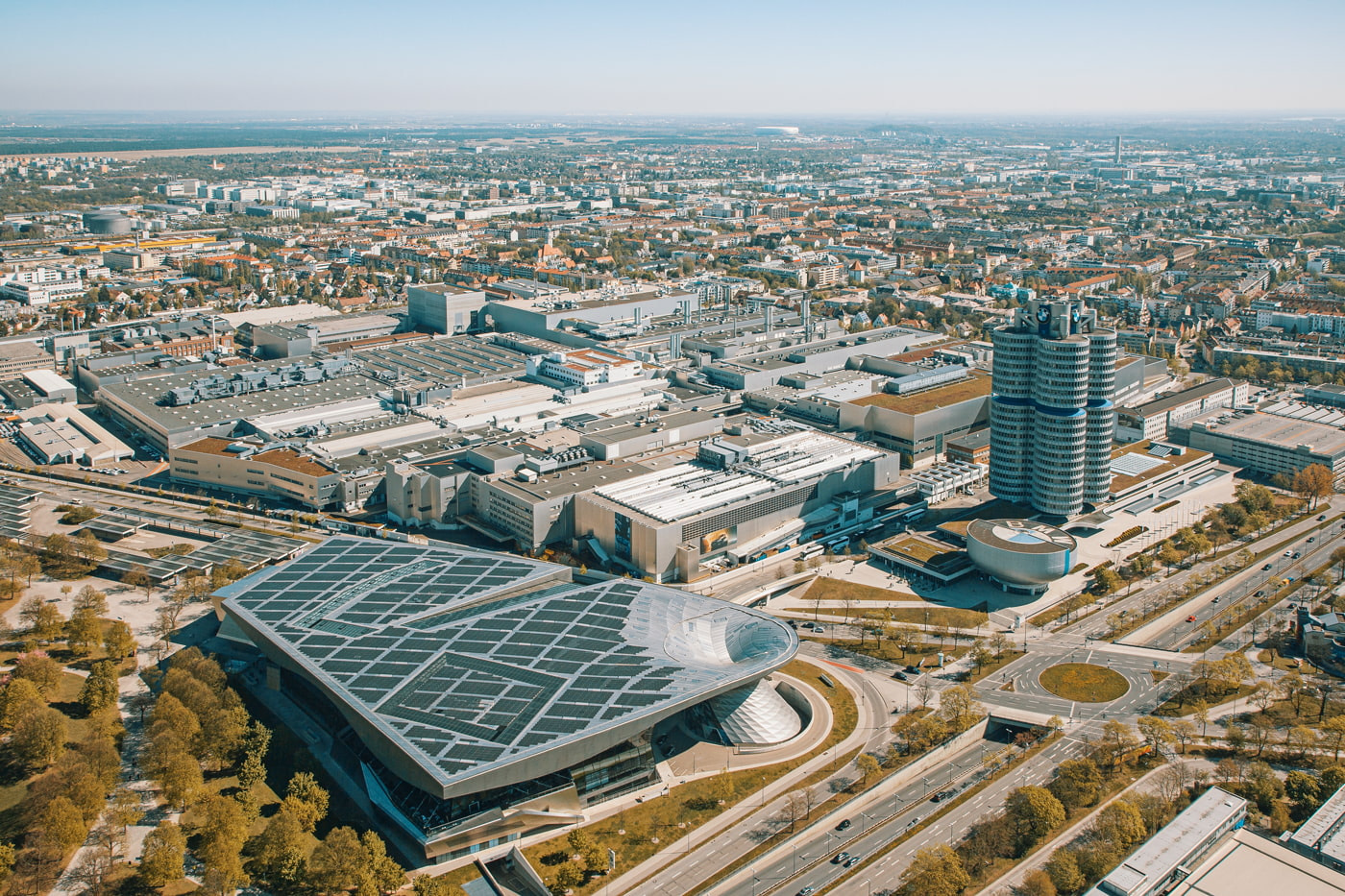
Adjacent to each other on the BMW campus in Munich, the BMW Welt and Museum serve two distinct purposes. The museum tells the history of BMW as a brand specifically, with examples of perfectly restored production cars going back to 1930s 3/15 DA-3, also known as the Dixi.
The Welt, on the other side, showcases current production cars across the spectrum of the entire BMW Group, which includes Rolls Royce and Mini, as well as pre-production and concept cars. It is essentially a giant showroom, so the cars you see are available for sale and many models can be rented by the hour. If your driving skills are a little rusty or you’d just like to further hone your technique, you can even take a lesson from a driving professional.
IAA Mobility 2021
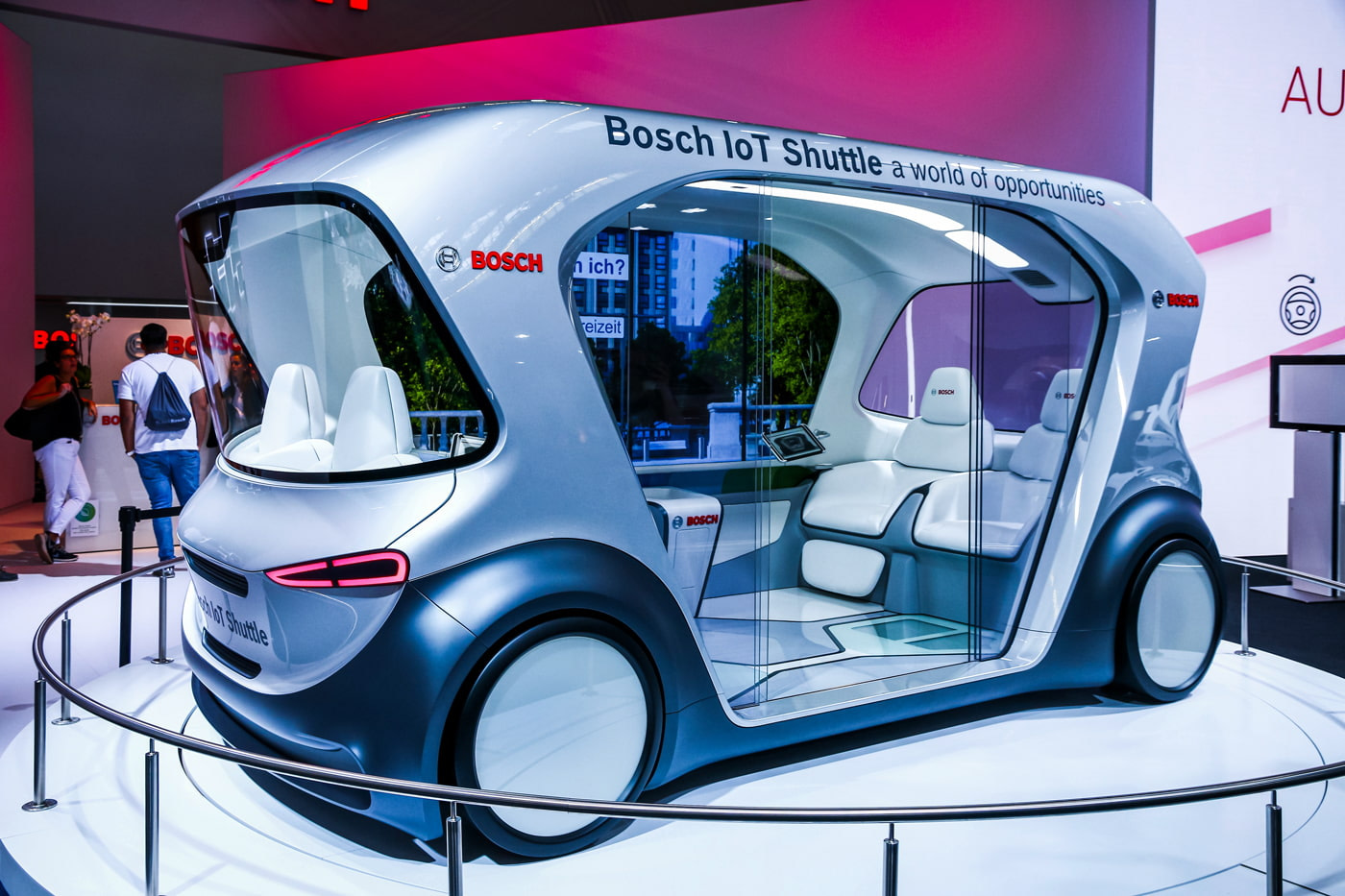
Formerly known as the Frankfurt Motor Show, the 2021 iteration has been rebranded as IAA Mobility in an attempt to include a broader range of vehicles and devices that provide or enable transportation.
Rather than just cars, they will now be showcasing many forms of vehicles including scooters, bicycles, even forms of air transport. Many of these changes were made with the goal of diversifying and democratizing the famous trade show, and with this goal in mind, special attention will be paid to ensuring that small startups and major car manufacturers have an equal opportunity to garner attention.
BaseCamp Young Hostel, Bonn
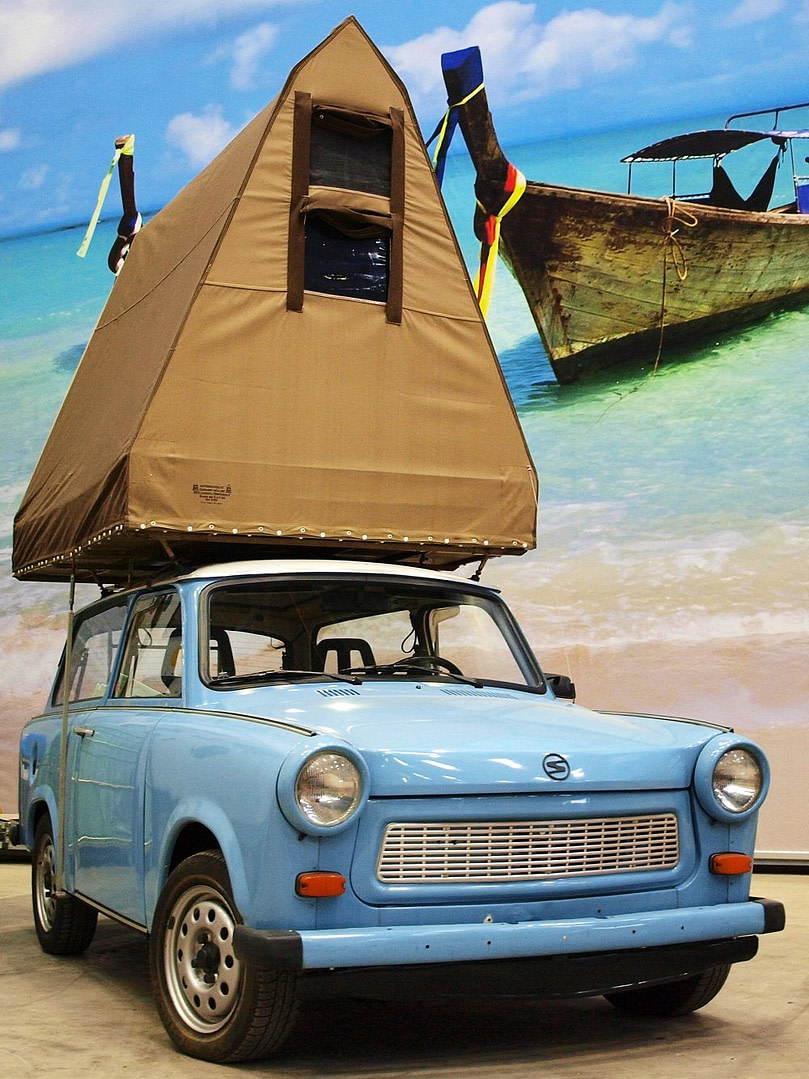
An inexpensive and original accommodation alternative for travelers to Bonn, BaseCamp invites guests to stay and play in a variety of themed vintage caravans with nicely furnished front lawns.
The ingenious youth hostel designed by movie set decorator Marion Seul resembles an indoor campground where rooms have been replaced by cool, artfully designed caravans, nostalgic train compartments, American Airstreams, and retro VW campers.
From Route 66 to Flower Power and 20.000 Leagues under the Sea, each unit has a story to tell, punctuated by inspired design and vibrant memorabilia. A food truck and a German-style beer garden round up BaseCamp’s facilities.

Never Miss A Story
I consent to receive email updates from Travel Away

How to Plan a Trip to Germany (Your Step by Step Germany Trip Planner for Traveling to Germany for the First Time!)
This post may contain affiliate links. Read my disclaimer policy.
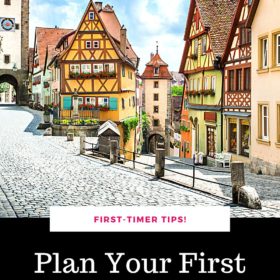
You’ve decided to visit Germany. Hooray! Whether you’re looking for bustling cities, sandy beaches, alpine hiking, intriguing history, fairytale castles, delicious food, fun festivals or friendly people, Germany is the perfect European vacation destination.
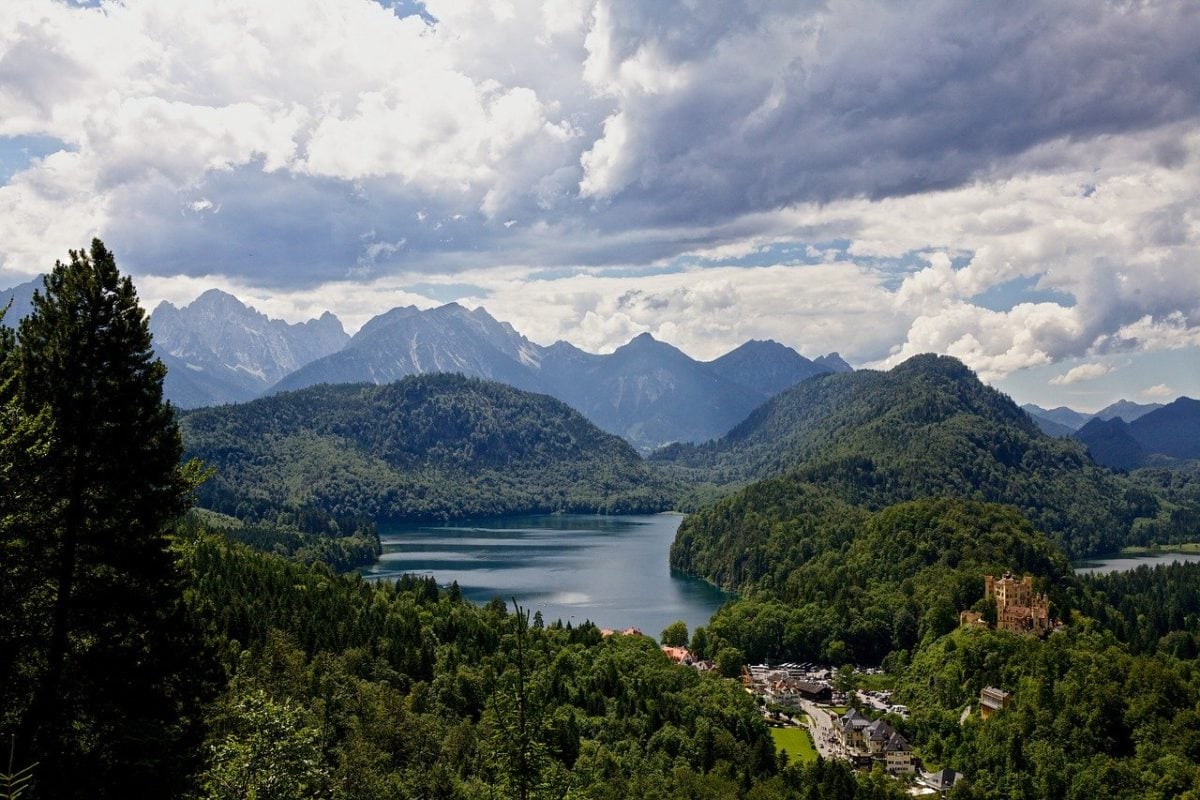
Not only is there a tremendous amount to do, see, eat, and experience in Germany, you can easily combine a visit to Germany with other European destinations. Germany is easy to get around in by train, bus, car or bike, and many people speak English.
You’re probably wondering…where do I even begin with planning my dream-come-true vacation to beautiful Deutschland?
Where should I go? Is it better to take the train or rent a car? What are the must-see cities and attractions? Which ones should I skip? Where’s the best place to stay? What should I eat and drink?
Join our FREE Germany Trip Planning Facebook Group!
Don’t worry! We’re here to help you narrow down your travel options, plan your itinerary , and book your trip with ease. It’s actually quite easy to plan a trip to Germany by yourself with the information in this article, on this site and with some help of some online booking engines.
To reduce overwhelm and help you plan your ideal vacation, we cover everything you need to know to get started planning your trip to Germany . And if you have any questions, you’re welcome to ask us in our free Germany travel Facebook community or send us an email .
Ok, let’s begin!
- 1 Meet Your Germany Travel Guides
- 2 Overview of Regions
- 3 Where to Go in Germany: Itineraries and Planning
- 4 Want more itinerary ideas? Are you a big city person? Check out…
- 5 Prefer smaller historic, picturesque cities? Check out…
- 6 What about cute little villages with “Fachwerk” (half-timber) architecture? There are so many! Here are a few ideas…
- 7 Looking forward to visiting fairytale castles?
- 8 Like islands and water? Take a look at…
- 9 What about nature, hiking, and national parks? Consider…
- 10 Passports & Visas
- 11 What’s the Best Time to Go to Germany?
- 12 Germany Booking Timeline
- 13 What’s the Weather in Germany Like?
- 14 What Time is it in Germany Right Now?
- 15 What’s the Best Way to Get to Germany?
- 16 Where to Stay in Germany
- 17 Getting Around Germany
- 18 What to Wear in Germany
- 19 My Absolute Favorite Travel Clothing Items
- 20 What to Eat in Germany
Meet Your Germany Travel Guides
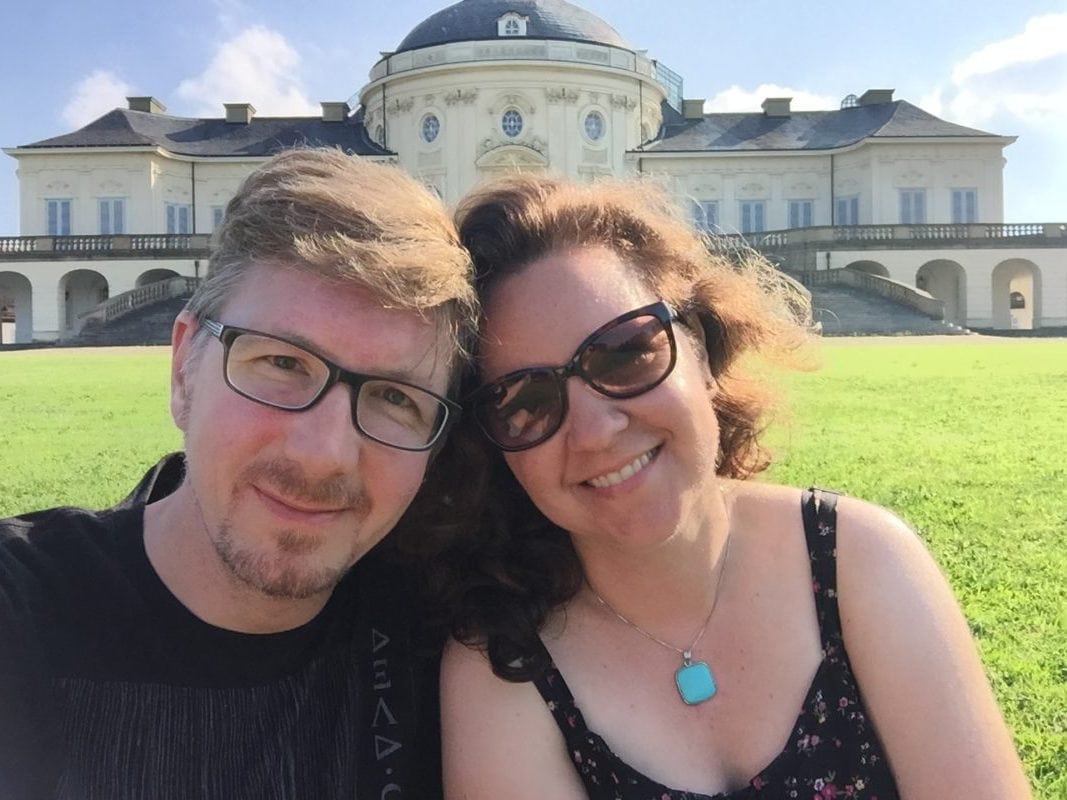
Hi, we’re Cate and Aaron, and we love helping people plan amazing trips to Germany. While Aaron has visited Germany several times (and is our chief rental car driver!), I lived there for 4+ years, have spent nearly 30 years of my life going back and forth between the US and Germany, and have traveled to all corners of the country.
I also taught German for several years and have a PhD in German Applied Linguistics, which means I’ve gotten to know Germany from several different angles. We’re so excited to help you plan your dream trip to Deutschland!
Overview of Regions
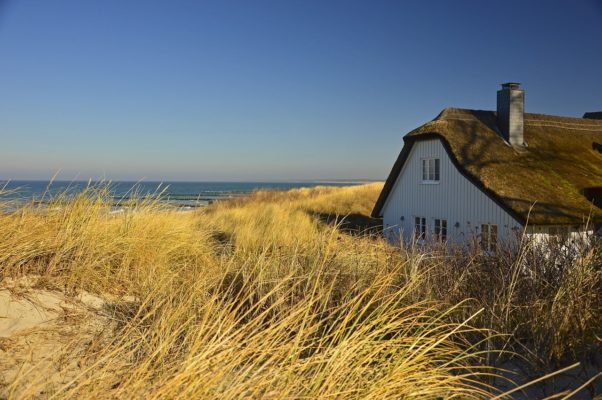
Northern Germany – Hamburg is the largest city in this region but there are other must-visit smaller cities like Lübeck , Stade, Bremen, and Lüneburg. Northern Germany also has the beautiful beaches of the North Sea and the Baltic Sea, the Wadden Sea national park, and the islands of Sylt, Flör, and Heligoland. Northern Germany is flat and great for biking. It looks so different from Bavaria! Combine a trip to Denmark with a visit to northern Germany.

Eastern Germany – Berlin is of course the feature city in this region, but Dresden, Leipzig, Magdeburg, Quedlinburg, Bautzen, Erfurt, and Weimar are smaller must-see cities. There’s also the Harz mountains, Swiss Saxony national park , Saalfeld Fairy Grottoes in Thuringia, Wernigerode castle, the Schwerin Palace, and Sansouci in Potsdam. Combine a trip to eastern Germany with a visit to Poland or the Czech Republic.
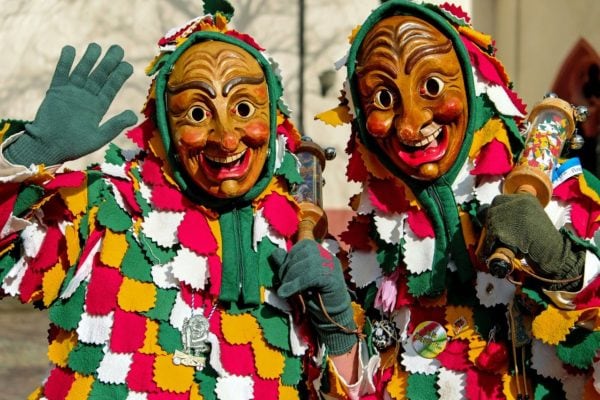
Central Germany – This region offers bustling cities like Cologne , Düsseldorf, and Frankfurt , smaller cities like Aachen, Wiesbaden, Koblenz, and plenty of cute villages. There’s also the Rhine and Mosel river areas, vineyards, the Eifel national park, castles , and beautiful rolling hills. Combine a visit to central Germany with a trip to the Netherlands, Belgium, Luxembourg, or France.
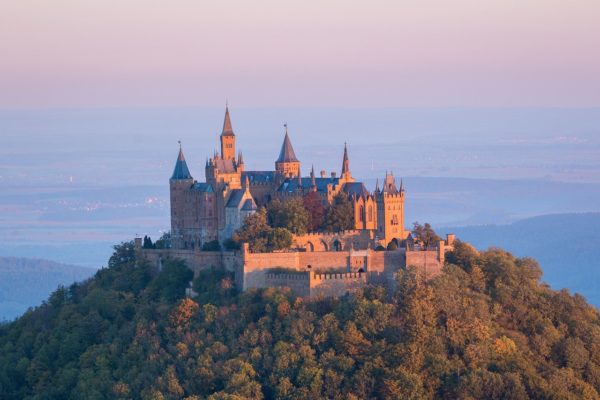
Black Forest/Baden-Württemberg – Stuttgart is the largest city in this region, and smaller cities like Baden-Baden, Heidelberg, Freiburg , Tübingen, and Ulm also warrant a visit. Vineyards and wineries, spa towns, castles (such as Hohenzollern or Lichtenstein ), waterfalls, Lake Constance, cute villages, and hiking are also features of the Black Forest /Baden-Württemberg region. Combine a trip to France or Switzerland with a visit to southwestern Germany.
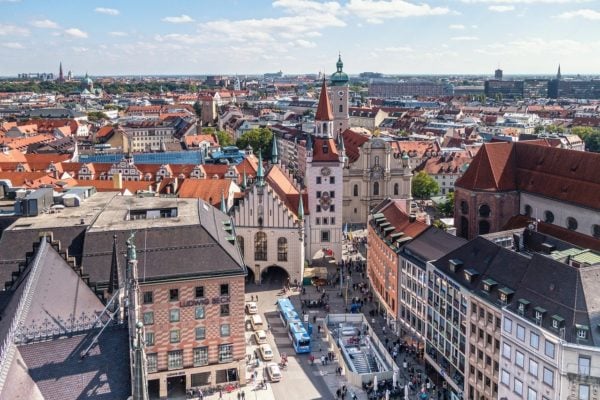
Bavaria/Alps – Munich is the feature city of Bavaria ( Oktoberfest! ), along with smaller cities like Regensburg, Nuremberg, Würtzburg, Bamberg, and Passau. There’s also the famous Zugspitze, Eagle’s Nest, Neuschwanstein castle , and Chiemsee lake, as well as lovely alpine towns like Garmisch-Partenkirchen and Berchtesgaden . Combine a trip to Bavaria with a visit to Austria, Czech Republic or Switzerland.
Click here for what to do in Munich!
Where to Go in Germany: Itineraries and Planning
There’s so much to see and do in Germany! Here’s some info to get you started on your itinerary (you can also check out this article with 10-14 day itinerary ideas ).
If you have just a few days, I recommend focusing on one city and a day trip (e.g., Hamburg with a day trip to Lübeck or Munich with a day trip to Neuschwanstein ).
If you have a week, you could visit 2 cities (plus 2 day trips) in different parts of Germany and allot one day for travel between cities (e.g., a few days in Munich with a day trip to Chiemsee, travel day to Berlin, then a few days in Berlin with a day trip to Potsdam). Or you could spend a week touring one region of Germany (e.g. the Black Forest or the Rhine and Mosel areas).
If you have two weeks, you can see a lot of Germany! You could, for example, start in Berlin, then visit Hamburg, take a day trip to Lübeck , then visit the Rhein river area, stop in the Black Forest , and end your trip in Munich. You could easily do this trip via train or car. Take a look at a couple 10-14 day itineraries we’ve outlined to give you a sense of how much you can do in that amount of time.
Grab our FREE Germany Trip Planning Checklist Now!
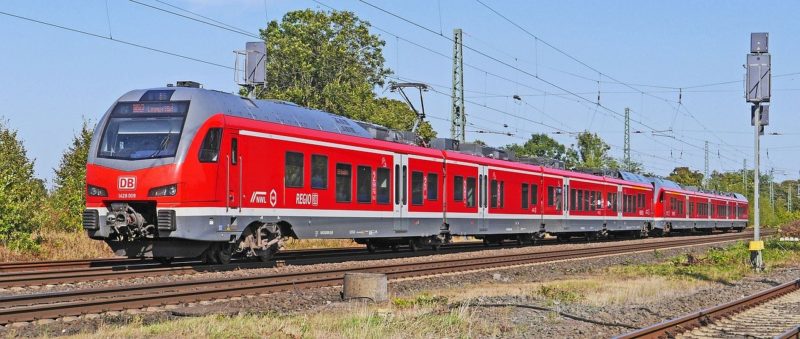
How long does it take to travel around Germany by train?
It’s quick and easy to travel around Germany by train. Here are some sample travel times to give you an idea:
- Berlin to Hamburg – 1 hour 45 minutes
- Berlin to Munich – 4 – 4 1/2 hours
- Hamburg to Lübeck – 1 hour
- Hamburg to Cologne – 4 hours
- Hamburg to Munich – 5 hours 40 minutes
- Frankfurt to Nuremberg – 2 hours
- Stuttgart to Munich – 2 1/4 hours
- Munich to Berchtesgaden – 2 hours
I use and recommend the official German rail system website to check travel times and book train tickets (point-to-point, saver tickets, and discounted regional tickets). I book all of our train tickets here!
Want more itinerary ideas? Are you a big city person? Check out…
- Cologne / Düsseldorf
Prefer smaller historic, picturesque cities? Check out…
- Lübeck
- Würtzburg
- Tübingen
What about cute little villages with “Fachwerk” (half-timber) architecture? There are so many! Here are a few ideas…
- Wernigerode
- Quedlinburg
- Dinkelsbühl
- Rothenburg Ob der Tauber
- Berchtesgaden
Looking forward to visiting fairytale castles?
- Neuschwanstein & Hohenschwangau (the “Disney castle”)
- Castles near Frankfurt
- Castles near Cologne
- 16 castles to visit in Germany
Like islands and water? Take a look at…
- Husum (North Sea)
- Timmendorferstrand (Baltic Sea)
- Lake Constance (Bodensee)
- Titisee
What about nature, hiking, and national parks? Consider…
- Schleswig-Holstein Wadden Sea National Park
- Hamburg Wadden Sea National Park
- Lower Saxon Wadden Sea National Park
- Jasmund National Park
- Western Pomerania Lagoon Area National Park
- Müritz National Park
- Lower Oder Valley National Park
- Harz National Park
- Kellerwald-Edersee National Park
- Hainich National Park
- Eifel National Park
- Hunsrück-Hochwald National Park
- Saxon Switzerland National Park
- Bavarian Forest National Park
- Berchtesgaden National Park
- Black Forest National Park
How about a road trip? Why not drive the…
- German Timber-frame Road (northern to southern Germany)
- Romantic Road (Bavaria and Baden-Württemberg, north/south)
- Castle Road (Bavaria to Baden-Württemberg, east/west)
- Wine Road (Palatinate wine region, north/south)
- Fairytale Route (from Hanau to Bremen, south/north)
- Black Forest High Road (Baden-Württemberg, north/south)
- Alpine Route (Baden-Württemberg to Bavaria, east/west)
- Volcanic Route (Rhein River and Eifel mountains, north/south)
Passports & Visas
If you’re from the US, Canada, Australia, New Zealand and many other countries, you do not need a visa to enter Germany (at the time of publishing this article). You do, however, need a valid passport with at least 3 months validity AFTER your planned departure date.
Play it safe and have MORE than 6 months validity on entrance to Germany! You also need at least 2 blank passport pages at the time of your arrival. Check your passport NOW so you have plenty of time to renew it if needed. Do not wait until the last minute to do this (been there, done that – it’s expensive and stressful)!
Germany is part of the Schengen zone, which means you can stay in Germany for up to 90 days without a visa. If you visit other countries in the Schengen zone before or after Germany, that counts towards your 90 days and reduces the amount of time you can spend in Germany. While on the automatic 90-day tourist visa you may not work but you can engage in business.
What’s the Best Time to Go to Germany?
The best time to visit Germany is whenever you can get there! No, seriously! There’s no best time of year for your Deutschland tour because there’s no bad time of year to visit. I’ve traveled all over Germany in spring, summer, fall, and winter and enjoyed every single season (Cate here, writing this article, by the way).
When should you travel to Germany? Well, it just depends on what you’re looking for…
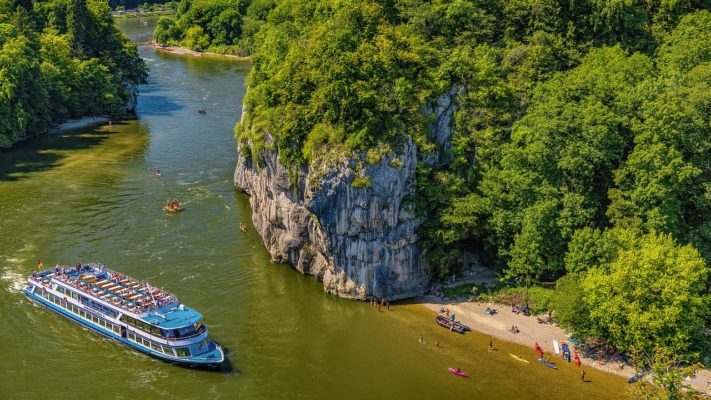
Summer is when you’re most likely to have warm (even hot) sunny weather. But it’s not guaranteed. I’ve had hot steamy summers in Germany (like last summer when we traveled during a heat wave), cold rainy summers, and everything in-between.
Fortunately, even if you encounter rain in the summer it likely won’t last more than a few hours or at most a couple days before you’ll see the sun again. The benefit of summer travel is that you’ll have nice long days for sight-seeing because the sun doesn’t fully set until about 10pm. If you’re interested in beaches or mountains, summer is a great time of year to visit.
Note, however, that not all hotels, cars, and restaurants use A/C. If you really hate hot weather, play it safe and avoid Germany in the middle of the summer. (Although, to be honest, in all of the summers I’ve spent in Germany, there have only been a few days in the summer that I’ve found truly unbearable without A/C.) If you must have A/C, be sure to confirm that your room or rental car has it.
Summer can also be a more crowded time to travel, since so many families make use of summer break. Book accommodation early for the most options and best prices!
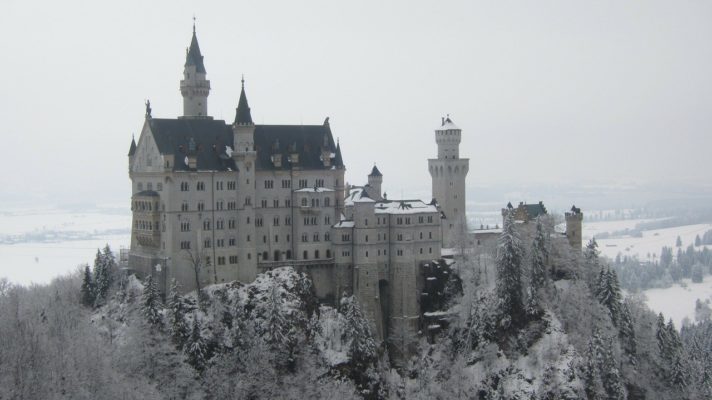
Winter travel in Germany can be cold but beautiful. One of my favorite times of year to travel in Germany is during the four weeks of advent at Christmas.
Yes, it gets dark early (by 5pm or a bit earlier) but the lights, decorations, and Christmas markets more than make up for it. Plus, you can go skiing and enjoy other winter activities.
I was just in Germany for a couple weeks in December and the weather was perfectly fine 90% of the time. There was only one day where the weather was truly miserable and even on that day there were enough breaks in the weather to enjoy my day trip exploring a new town and a new Christmas market.
Germans don’t let winter keep them from enjoying outdoor activities, hiking to strolling through a Christmas market or enjoying a coffee at an outdoor cafe. Don’t let it stop you, either! Just bundle up, grab a mug of Glühwein, and you’ll be fine!
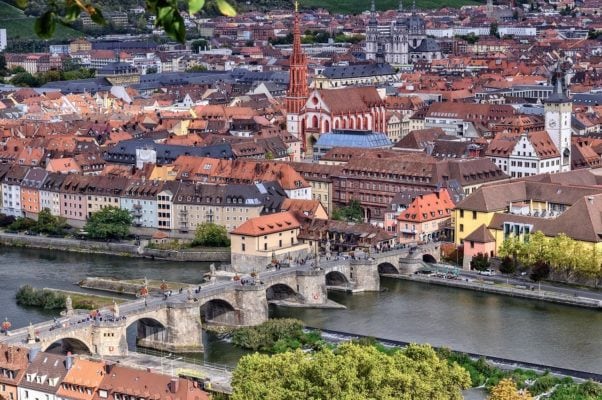
Fall and spring are also great times to visit Germany. In the fall you’ll enjoy crisp mornings and cool evenings and seeing the leaves change color.
In the spring you’ll experience the joy everyone feels when they can once again sit outside at cafes and restaurants. The weather can vary quite a bit day to day but if you travel late in the fall or early in the spring you can score great deals and will find smaller crowds.
Germany Booking Timeline
I’ve booked flights, accommodations , and tours and tickets a few weeks before my arrival, and I’ve booked them several months in advance. Book early if you:
- Are traveling during peak summer, Christmas market or ski season
- Have very specific travel dates or lodging, transportation, sight-seeing needs
- Are visiting big cities
- Are on a tight budget
- Are visiting during a special event, such as Oktoberfest
I usually start looking at my options as early as possible so I can figure out what a good deal looks like for my travel dates. I then set up flight alerts and start earmarking AirBnB’s and hotels. I begin booking whenever I find something that meets my needs and fits my budget.
Here’s a general booking timeline to get you started:
6-12 months in advance:
- Research and book your international flights
- Research travel insurance
- Plan your travel itinerary and dates
- Research and book flights within Germany or Europe
- Research travel options within Germany (rental car, train bus, etc)
- Research accommodation options (book if you find great deals or if availability is limited)
- Make sure your passport is up-to-date (you need at least 6 months left on it when you enter Germany) and apply for a new one if it isn’t
3 – 6 months in advance:
- Book accommodation
- Book trains or busses (usually 90 before your travel dates is the earliest you can book but always check if you can book earlier – the best deals go fast)
- Book rental car
- Book tours, events, and tickets
- Book travel insurance
- Review your travel wardrobe and gear and purchase the items you need
1 month in advance:
- Book any remaining attractions and tours
- Book airport transfers or plan how you will get to your lodging
- Purchase a sim card for phone or check how you can use your current phone service in Germany (e.g., I can use my Verizon phone service for a $10/ a day fee)
1 week in advance:
- Print out or ensure that you can easily access all bookings, tickets, and travel info on your phone (make sure you can access everything without data or wifi!)
1 day in advance:
What’s the Weather in Germany Like?
What will the weather be like when you visit Germany? Well, it depends on the time of year and where you are. Weather in Germany can be somewhat unpredictable no matter the time of year.
I recommend being prepared by wearing layers, packing an umbrella or rain jacket, and remembering that the weather will likely change soon. And, as I said earlier, don’t let any kind of weather stop you from enjoying Germany!
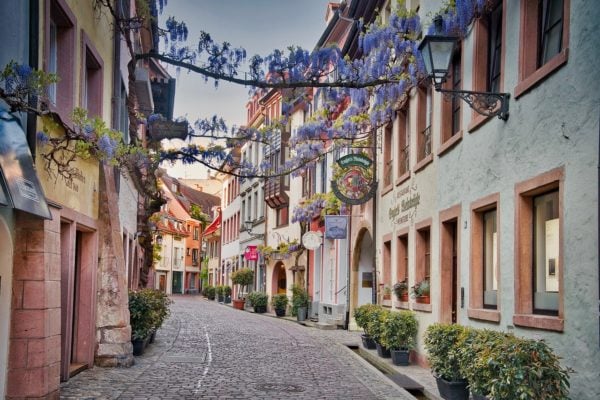
Summer. Germany comes alive in the summer with everyone and their dog (literally, there are dogs everywhere) outside enjoying the nice weather. Average high in the summer is 80F.
Be warned…it can rain in the summer but it doesn’t usually last that long. It can also be super hot in the summer…but again, scorching temperatures doesn’t usually last that long.
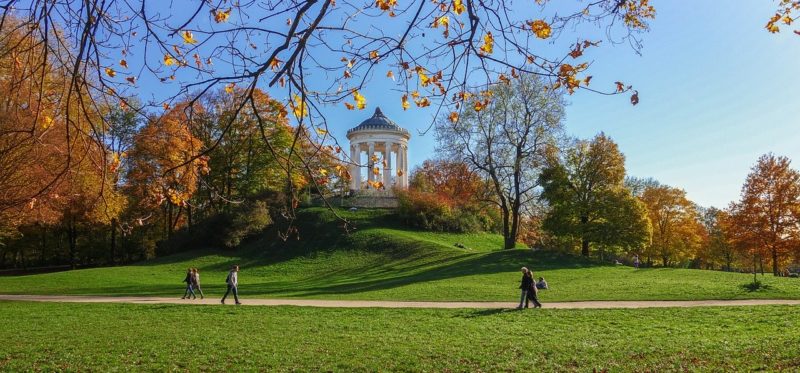
Fall. Such a beautiful time of year in Germany with the leaves changing colors and cool, crips mornings and evenings and warm days. One of my favorite times of year in Germany! In September, the average high is 67F and by November it’s around 47F.
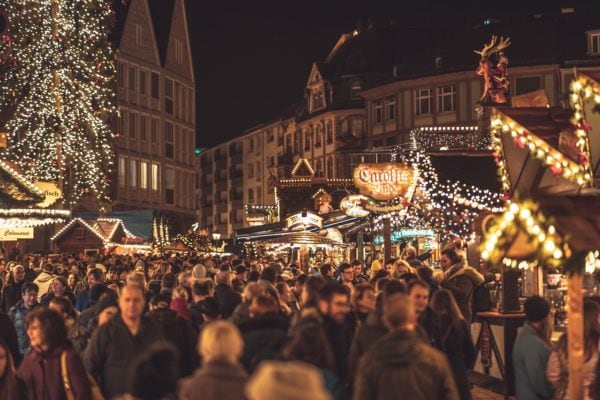
Winter. Bring your scarf, hat, and mittens because German winters can get cold! Average temps hover around freezing with warmer days in the 40s/50sF. While it can snow anywhere in Germany, you’ll find the most snow in southern Germany. Winter weather doesn’t mean everyone hides inside, though. On the contrary! Do what the Germans do – bundle up and enjoy the outdoors.
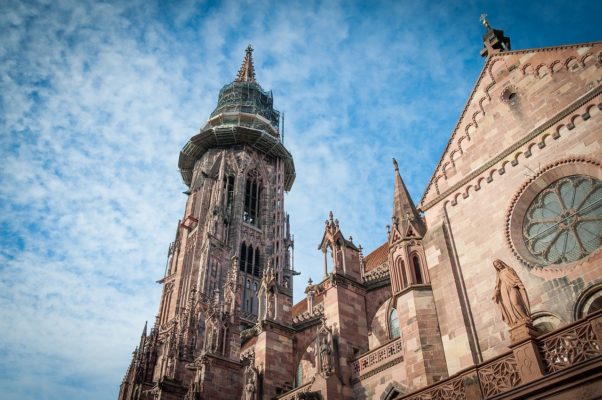
Spring. I love being in Germany on the first spring day because everyone heads outside to enjoy the sun and everyone is in such a good mood! Early spring will see a high around 47F but by late spring it’s more like 67F.
What Time is it in Germany Right Now?
Germany is in the Central European Time zone (CET) or UTC+2. It’s 6 hours ahead of the US EST, 7 hours ahead of CST, 8 hours ahead of MST, and 9 hours ahead of PST.
Daylight savings in Germany in 2020: time “falls back” on October 25 and “springs forward” on March 29. Write these dates in your calendar so you don’t accidentally miss any flights or trains (been there, done that)!

What’s the Best Way to Get to Germany?
It depends on where you’re coming from and where you’re going. When flying from outside Europe, many people fly into Frankfurt (FRA), the largest airport in Germany and one of the largest and busiest airports in Europe.
The benefit of flying into Frankfurt is that it has a ton of direct flights, and once you reach Germany you can easily take a commuter flight, train, bus or rental car to your final destination.
The downside? The airport is huge, busy, and I’ve noticed prices into Frankfurt have been higher than regional airports in Germany.
I used to always fly into Frankfurt , and then take a train, bus or rental car to my final destination. But recently? I’ve found that it’s easier (and sometimes cheaper) to bypass FRA and fly into other German cities, such as Munich , Hamburg , Berlin , Düsseldorf ( Cologne ) or Stuttgart .
You might even be able to find a direct flight from the US (I’ve flown direct Atlanta – Stuttgart and Washington DC – Munich, for example). Otherwise, you’ll change planes somewhere in Europe and take an easy 1-3 hour flight to Germany. We’ve changed planes in London, Amsterdam, Stockholm, Paris, and Vienna, for example. You could also fly into another European city and then take a train, bus or rental car into Germany.
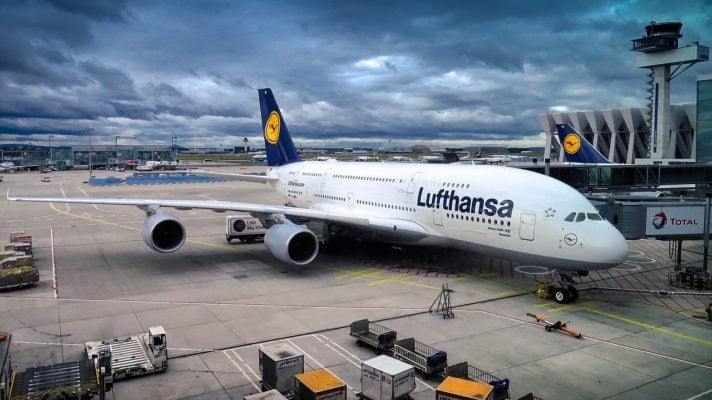
A Few Notes About Flying Into FRA (Frankfurt Airport) and Traveling Onwards
If you take a commuter flight from Frankfurt (FRA) to your final destination in Germany, you’ll go through passport control in FRA and then to your connecting gate. Super easy. Most flights from FRA to elsewhere in Germany are an hour or less in duration.
If you’re traveling onward by train from Frankfurt, you can transfer to the train right at the airport below Terminal 1. If your train leaves from the main station in Frankfurt, you can either take the S-bahn or a regional train from the airport to the Hauptbahnhof (main station) in about 10-15 minutes.
Important: you’ll find cheap “savings fare” train ticket prices if you book your ticket online well ahead of your arrival. Be sure to book your ticket for at least a few hours after your flight’s arrival time into FRA.
Be warned: getting through passport control, customs, picking up your checked luggage, and making your way to the train station can take longer than you think. And if your plane from the US (or elsewhere) is delayed…well, it’s easy to miss your train and have to buy a new, much more expensive ticket on the spot. Personally, I would book a saver fare train ticket for a train that leaves 3-5 hours after my international flight’s arrival time – at the minimum. And that’s still cutting it close if there’s any kind of delay!
Tip: If you want maximum flexibility and peace of mind, buy a “flex ticket.” You’ll pay more but these tickets aren’t tied to a specific train. So if your flight is five hours late, you can take a train later in the day without changing your ticket or losing money.
These tickets also you to stop somewhere en route to your final destination for a couple hours, and then get back on a different train (e.g., stop in Stuttgart for a couple hours on your way to Munich). So if you arrive on time, you can work in a short excursion on the way to your final destination (store your luggage at a locker in the train station). If your flight is late, just go directly to your destination. These tickets are also refundable before the first day of travel.
For ultimate flexibility and peace of mind, spend the night in or around Frankfurt and book a saver fare train for early the next morning.
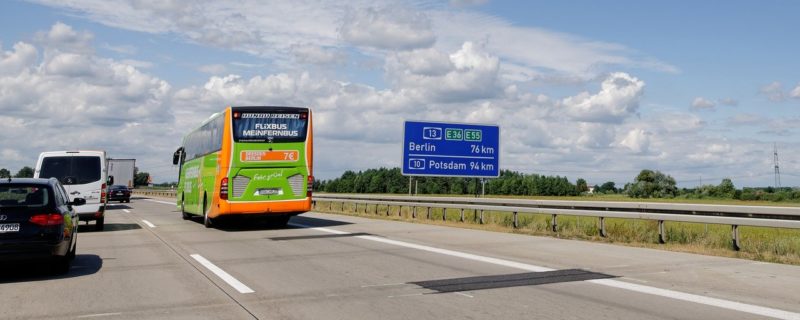
You can also easily pick up a rental car at FRA and drive to your final destination. Aaron and I have done this a few times and never had any problems.
The one problem we do have? Staying awake long enough to drive to our destination! We usually keep the driving distance to an hour or two on the day of our arrival and drink a lot of coffee. Sometimes we pull over at rest area and take a nap.
If you want to rent a car at the airport and are concerned about driving while jet lagged, consider picking up the car and then spending the night in nearby town, such as Wiesbaden (I spent an enjoyable few days there before catching my flight home a few years ago).
If you’re catching a bus from the city center to travel onwards, S-bahn 8 or 9 will zip you into town quickly and cheaply in about 10-15 minutes. Buy tickets at any of the ticket machines before you board the S-bahn.
You can also catch busses into Frankfurt and elsewhere in front of Terminal 1 (arrivals level) and Terminal 2 (level 2).
You’ll find taxis in the same general area. It takes about 20 minutes to get into downtown Frankfurt by taxi.
Flying to Germany from Elsewhere in Europe
These days it’s super easy and generally inexpensive to fly to Germany from all over Europe. Here are a couple tips:
When booking your international flight, you might be able to include a stop-over in the city where you’ll transfer to your Germany flight. I used to do stopovers in London, and a couple years ago I did an awesome stopover in Iceland. TAP also offers free stopovers in Lisbon or Porto.
I highly recommend looking into both flying and taking a train (or bus) into Germany, especially if you’re arriving from a neighboring country and not on a stopover. Of course, if you’re flying from cities like London, Barcelona, Rome or Oslo, flying is the best option. But if you’re traveling from Paris, Vienna, Copenhagen or Prague, for example, a train might be the better way to go.
Even if the actual flight is only an hour, you have to factor in the time it takes to travel to the airport, go through security, potential flight delays, and then traveling to your lodging once you land. A 5- or 6-hour train ride might actually take less time than a 1-hour flight when you total it all up!
Traveling to Germany By Train, Bus or Car
Traveling to Germany from other European countries by train, bus or car is easy. Train travel is generally simple, comfortable, and quick. Most train stations in Germany are located in the city center, so it’s easy to get to your lodging via taxi or public transportation.
If renting a car in another country, just double check that you’re authorized to take the car out of the rental country. If you are, you’ll have no problems crossing the boarder and driving around Germany.
Busses tend to cost less than trains, and you can find some amazing deals, but to be honest, I still prefer taking trains over busses. Trains are more comfortable, you can get up and walk around, and they’re almost always faster than busses. Plus, they don’t get stuck in traffic.
Tips for Booking the Best Flights with Cash or Miles:
- Start looking for flights early, especially if you’re traveling during peak season. I booked our mid-June flights in late January. While we found low mileage flights for very specific weekend travel dates, we could have found better flight times had we booked even earlier.
- Track flights through google or look at options in Hopper so you’ll know a good deal when you see one.
- Look for last-minute deals. When I decided to go to Germany in December I didn’t start looking for flights until early November (the trip was a last-minute decision). Because I was flexible on travel dates and went early in the month, I found excellent tickets using miles. This doesn’t always happen, but it never hurts to look for deals, even if your travel dates are right around the corner.
- Fly in or out of smaller regional airports (e.g., Berlin , Hamburg , Stuttgart , Munich , Düsseldorf). When I booked our flights for mid-June I couldn’t find anything into Frankfurt using miles. But I did find flights into Berlin and out of Stuttgart, and that actually worked even better for that trip ! For my recent December trip , I found that flying in and out of Stuttgart used the lowest amount of miles and had the best schedule. I’ve also flown into Hamburg and Munich airports.
Where to Stay in Germany
Germany has so many options for lodging:
- Vacation rentals (e.g., VBRO, AirBnB)
- Hip boutique hotels
- Quirky hostels
- More traditional HI hostels
- Large hotel chains
- American-styles hotels (Hilton, Marriott, etc)
- Family-run Pensionen (bed and breakfast)
- Camping (RV and tent)
When we’re in Germany we typically opt for AirBnB (I like having a kitchen to make breakfast) or a smaller family-run Pension or boutique hotel. We used to stay in hostels when we was younger (they’re pretty nice in Germany) but even then I found Pensionen to be very affordable – sometimes more affordable than hostels – especially when traveling with one or two other people. If we’re spending the night near an airport or train station and want convenience and ease we’ll stay at a larger chain hotel .
Whether you’re looking for luxury or budget accommodations, you’re sure to find what you’re looking for in Germany! To help you get started, check out our Germany hotel guides.

Breakfast is often included with lodging in Germany (but not always). Sometimes breakfast will feature fresh bread or Brötchen (delicious German rolls), cold cuts and cheese, butter and jam, and tea and coffee. Other times there will be an extensive breakfast buffet that includes things like yogurt, museli, a variety of breads, meats, cheeses, and even hard-boiled eggs. You’re unlikely to find things like omelets, bacon, pancakes, waffles, and hot oatmeal.
If you’re looking to save money on lodging, book rooms with a shared bathroom. (This is typically only an option in smaller or older hotels and not an option I come across as often anymore.) Sometimes that will mean sharing a full bathroom with other guests on your floor, and other times you’ll have a sink and/or shower in your room and will share a toilet located in the hallway. Shared bathrooms are more common in smaller Pensionen than in hotels.
These days I prefer the convenience of having a full bathroom in my room but I’m not averse to sharing a hall bathroom when needed (takes me back to my younger backpacking days – ha!). I’ve never had to wait to use a shared bathroom or had any trouble with them. Sometimes there are two or more bathrooms per floor. If you do opt for a shared bathroom, bring flip-flops!
Hostels can be a great option for families, as many offer family rooms. Hostels typically offer a simple breakfast and sometimes dinner. While accommodations are simple, some hostels can be in spectacular locations. The hostel in Bacharach, for example, is in an old castle on a hill and offers a gorgeous view of the town below and the Rhine river!
Getting Around Germany
One of the benefits of traveling in Germany is that it’s super easy to get around the entire country. You have so many transportation options.
You can rent a car and drive from place to place. Or you can stick to trains and busses. Or ride a bike – there are tons of bike paths throughout Germany.
If I’m primarily visiting big cities I prefer taking the train or a bus to get from one city to another. When I spend more time in smaller cities or want to take day trips to harder to reach places, I prefer having a car.
For our recent summer trip to Germany, we rented a car at the Berlin airport and returned it to the Stuttgart airport. We didn’t take trains or busses at all. We got a car so we could go to places that aren’t as easily (or quickly) accessible by train. We didn’t use the car every day, though. We walked and used public transportation when exploring cities.
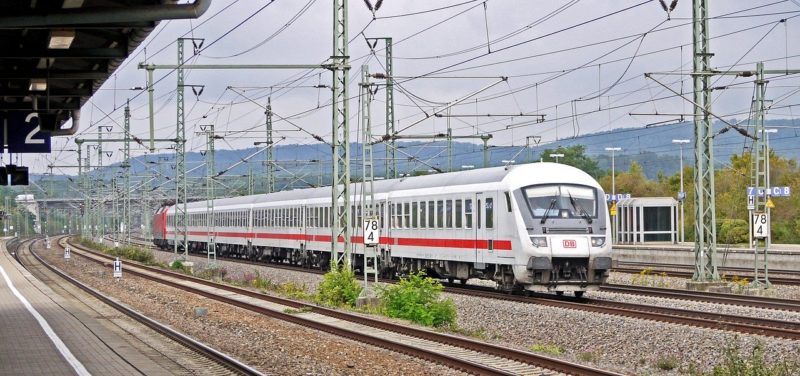
Speaking of public transportation, Germany’s is one of the best! It’s super easy to get everywhere you want to go via the S-bahn (above ground metro), U-bahn (underground metro), Strassenbahn (street car), and city bus. Taxis (and Uber/Lyft, where available) are also convenient options, though more expensive than public transport.
There are also car-share programs that you can look into. I haven’t used any of them and don’t know how convenient they are for travelers but it doesn’t hurt to check them out.
German cities are very walkable, so it’s easy to get around by foot. And, if you’d like to bike around like a local, there are lots of places to rent bikes (or scooters!) around town or maybe even at your hotel or AirBnB. If you’re more interested in just one afternoon of biking, try a city bike tour!
A few transportation tips:
- For the best train ticket prices book your ticket via the official German rail system website in well in advance. I book all of our tickets there. Note: if you pre-purchase your ticket at the lowest price you have to take the specific train you booked. If you miss that train, you have to buy another ticket.
- If you don’t mind taking slower regional trains you can get some really cheap tickets and regional day tickets. You may not want to use these tickets to go from Munich to Hamburg, but they’re great for day trips, whether traveling solo or with others.
- Busses are often less expensive than the train (though not quite as comfortable and often slower).
- There are Eurail options for Germany, and they’re a great choice if you value flexibility and ease or if you want to make stops while traveling (eg., stop in Cologne for a couple hours while traveling from Hamburg to Munich).
- If you plan to rely on public transportation in the cities you visit, buy a day pass (or perhaps a multi-day or week pass) rather than individual tickets. Also check to see if there are group day tickets or if young kids can ride free. Note: there’s often a small additional fee to bring a bike or a large amount of luggage on public transportation. There are often less expensive day passes for travel starting after 9am.
What to Wear in Germany
Check out my packing list for Germany!
Layer, layer, layer! The weather in Germany is often unpredictable so your best bet is to bring layers so you can customize your wardrobe on the fly. Since rain is a possibility any time of year, you may want to bring a light rain jacket or an umbrella.
Bring comfortable shoes. You’ll no doubt walk all day long (often on cobblestone), so bring your most comfortable, supportive shoes. Be sure to break in your shoes before you travel. There’s nothing worse than realizing a day into your trip that your shoes pinch your toes or give you huge blisters. (Bring along moleskin, just in case. I always have this kind in my day bag!) I typically bring a good pair of walking shoes appropriate for the season (e.g., boots in the winter) and a nicer pair of flats (sandals in the summer).
You can wear jeans. Some people say never travel with jeans but I’m not one of those people. I love traveling with jeans! They’re comfortable, I can wear them a few times without having to wash them, and I feel less like a tourist wearing them because everyone wears them. If you like jeans, wear jeans.
Scarf, hat, gloves. If you’re traveling in the winter or even late fall or early spring, definitely bring a warm scarf, hat, and gloves or mittens. Or buy them in Germany and take them home as a souvenir! Almost all of my winter accessories are from Germany. Even if you’re not traveling in colder weather, I recommend a travel scarf with a hidden pocket for ease and security.
You can wear shorts in the summer. Shorts are more popular in Germany than they used to be, so if you like them and are comfortable in them, wear them. That said, do also bring summer dresses or skirts and or lightweight pants to wear when shorts are too informal.
Bring a comfortable day bag or purse. When you’re out and about all day you want a comfortable bag or purse to hold your travel essentials – wallet, phone, camera, ipad/kindle/book, umbrella, journal, etc. For peace of mind, you may even want one with special security features. Click here to read my guide for buying the best travel purse.
My Absolute Favorite Travel Clothing Items
Merino wool camisole/tank – These camisoles are the BEST for travel! They’re soft, comfortable, easy to hand wash, and they never stink. This might be TMI but a few years ago, when I was traveling solo around Europe, I wore the same merino wool tank each day for 14 days in warm spring weather. It never smelled bad! Since that experiment I don’t typically go that long without washing my tanks, but I like knowing that I could! Click here to read more reviews and buy a merino wool camisole/tank.
Foldable flats – I splurged on a pair of foldable leather flats a few years ago, and after I broke them in I started really liking them. I wouldn’t recommend them for a full day of walking (especially on cobblestones) but I like to bring my foldable flats along for a change of pace or when I want the option of wearing a cute pair of shoes but don’t want them to take up much space in my suitcase.
Merino wool shoes – I bought a pair of dark grey merino wool walking/tennis shoes a couple years ago and I LOVE them! I can wear them barefoot in the summer, and not only do my feet stay relatively cool, my shoes don’t stink when I take them off at the end of the day. I can throw them in the wash if they get dirty (though mine still look great 2 years later), they pack flat and don’t take up much space in my suitcase or travel backpack, and the heel is thick and cushioned. You can also buy replacement merino wool insoles without having to buy a new pair of shoes.
What I don’t like: the pair I have doesn’t have enough arch support for me and there’s not enough padding under the ball of my foot. The first few times I wore them they were uncomfortable after walking all day and I was super disappointed! But after adding an arch support and a gel insert under the ball of my foot (I like this one ) I loved them and now wear them all the time while traveling and at home. Many people love them from the start! Click here to to read reviews and check out merino wool shoes.
What to Eat in Germany
You’ll never go hungry while traveling in Germany! While you can always find traditional items like Schnitzel, Spätzle, Rouladen, and Bratwurst, there are plenty of healthier options, including those that are vegetarian, vegan, and gluten-free.
Many restaurants now cater to special diets and accommodate allergies, as do some specialty grocery stores. Aaron has a meat allergy and frequently eats gluten-free and has never had a problem finding delicious food in Germany.
These days Germany has a wide variety of restaurants to ft all budgets featuring cuisine from all over the world (except Mexican…I’ve yet to find good tacos in Germany). So you won’t be stuck eating Schnitzel every day – unless you want to!
We usually eat breakfast at our AirBnB or hotel, enjoy a nice lunch at a restaurant we’ve stumbled upon, and then grab a Döner, salad or pizza for dinner. We also often picnic using ingredients from the bakery and grocery store or farmer’s market.
Traditional German dishes to try: Schnitzel, Spätzle, Rouladen, Bratwurst, Sauerbraten, Schweinehaxen, Maultaschen, Currywurst, Leberkäse, Flammkuchen, Sauerkruat, Kartoffelsalat (potato salad), Quark, all kinds of German breads.
Quick lunches and snacks on the go: Döner, Falafel, Bratkartoffeln (fried potatoes), Kartoffelpuffer (potato pancakes), Bratwurst, Currywurst, salads, Brötchen filled with meat and/or cheese, fresh pretzels, pastries, cakes. Click here to see the best German street food!
Desserts & sweet treats: Schwarzwälderkirchtorte (Black Forest Cake), Bienenstich (Bee Sting Cake), cheesecake, Stollen, Frankfurter Kranz, cake, Donauwellen cake, Berliner, Lebkuchen, Pflaumenkuchen (plum cake), all kinds of pastries and chocolate – just to name a few! Click here to see the 10 must-try German desserts and sweets.
Beer: every kind you could ever imagine! I usually just ask for the local beer unless there’s a specific one I know I want to try.
Christmas: This is the best time of year to be in Germany, partly because of the many delicious holiday treats like Lebkuchen, Stollen, Glühwein, and so much more. Click here to read more about what to eat in Germany during the Christmas season.
Want to try German food now? Click here to see where to buy delicious German food online!
Got a question about traveling in Germany? Join our free Germany trip planning community or send us an email!
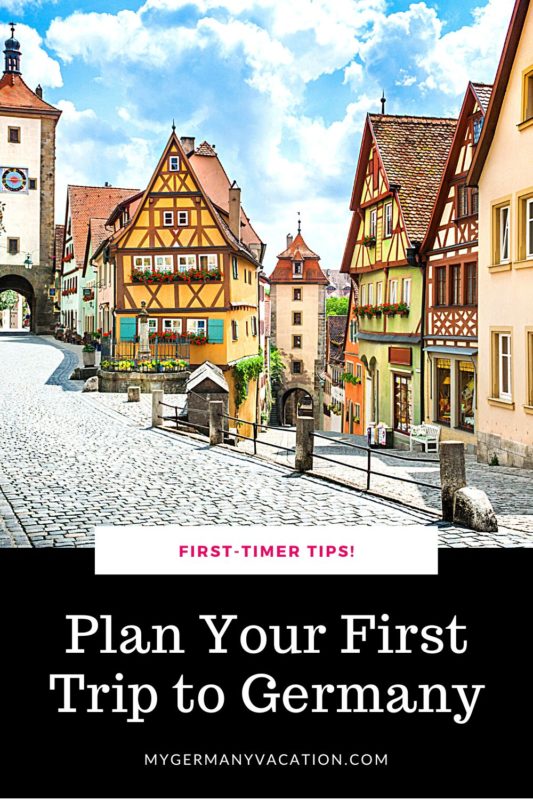
Cate has been traveling to Germany for 30+ years. She has lived in Germany, taught college German, and has a PhD in German Applied Linguistics. She loves helping travelers plan their dream trips to Germany!
Similar Posts

Best Electric Travel Tea Kettle in 2023
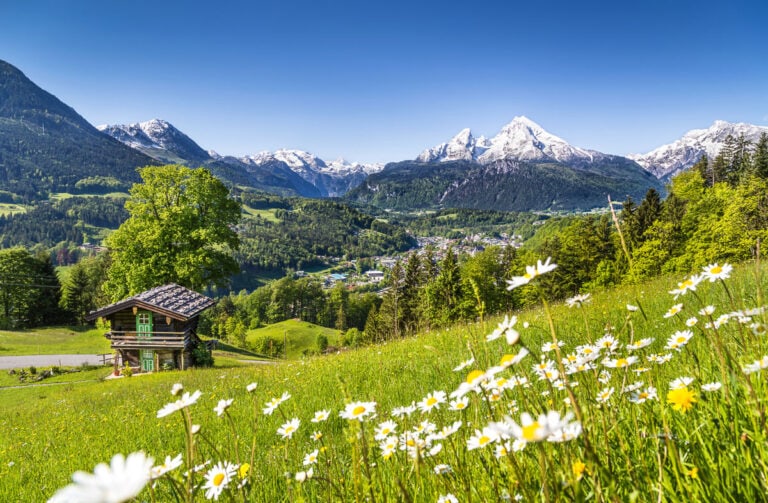
Where to Travel in Germany, Austria & Switzerland in 2 Weeks
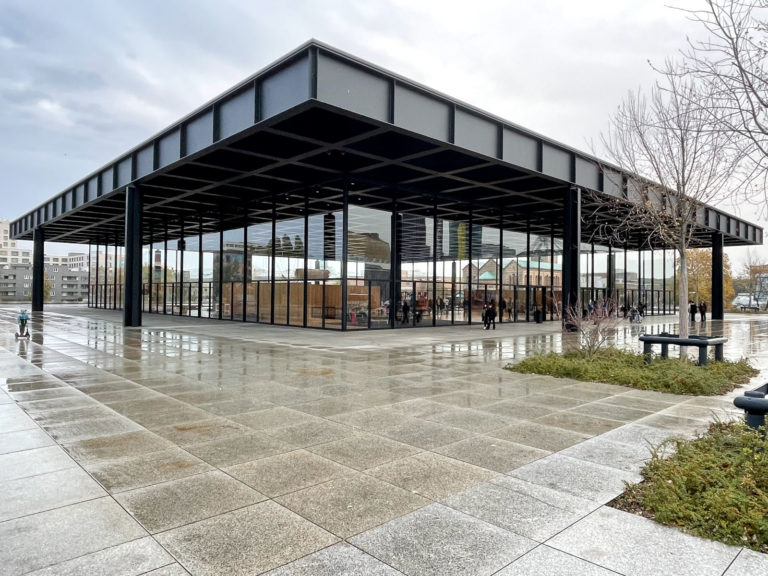
Best Museums to Visit in Berlin, Germany in 2024
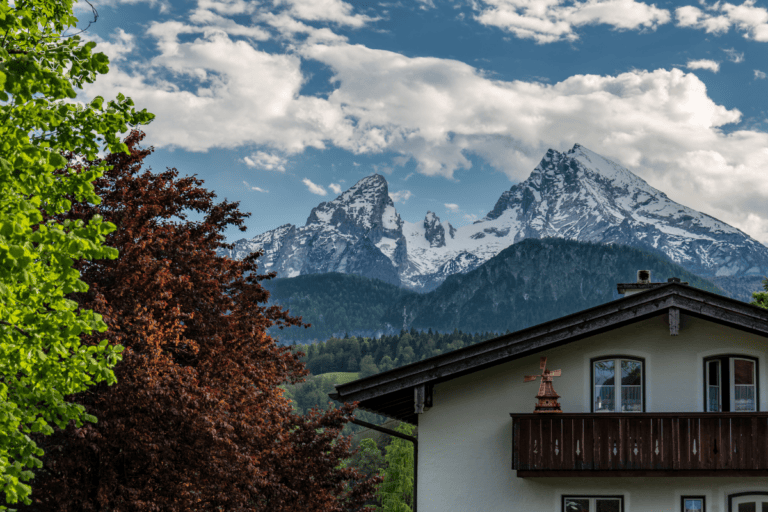
What to Do In Berchtesgaden, Germany (Including Eagle’s Nest And Surrounding Area)
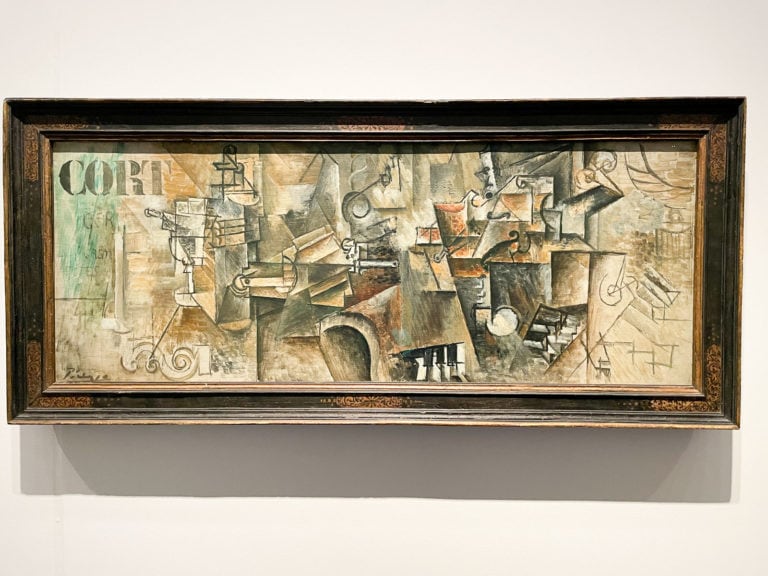
Best Art Museums in Berlin
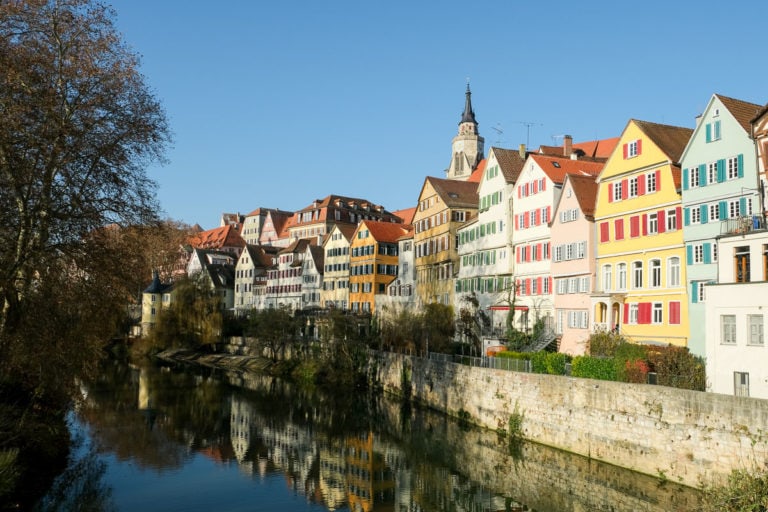
Best Things to Do and See in Tübingen, Germany
Here’s how we can help you plan your perfect trip in 2024.
GERMANY TRAVEL PLANNER: Just getting started? Have questions about Germany’s confusing train tickets or how to find the best guided tours? Not sure which parts of Germany should be in your itinerary (and what to leave out)? Our Germany Travel Planner answers those questions and more via how-to videos, our interactive Germany Planning Map, City Cheatsheets, and MUCH more. Click here to unlock the best of Germany the easy way!
GERMANY TRAVEL CONSULT: Feeling overwhelmed? Itinerary just not coming together? Wonder if a few tweaks would take your trip to the next level? Book a Mini or Full consult with Cate! She’ll help you create or tweak your itinerary, recommend train tickets/passes, hotels, things to do, guided tours, show you how to buy train tickets, orient you to specific cities, help you plan out day trips, and answer your Germany travel questions.
ACCOMMODATIONS: We recommend using Booking.com since they have widest range of accommodations available from hostels, boutique hotels, luxury chains, aparthotels, at the best prices. Check out our accommodation guides for specific recommended hotels.
WHAT TO PACK: If you’re bringing your phone, be sure to bring this plug adapter , this power bank , and this wrist strap . They’ve been lifesavers for us! You can see our other packing essentials here and here .
TICKETS & TOURS: For guided tours, day trips, private tours, and skip-the-line tickets, Get Your Guide is our go-to!
TRAINS & BUSES: To research train schedules and buy tickets or a Germany Rail Pass, we recommend the official Deutsche Bahn (German Rail System) website (and download their DB Navigator app). For buses, look at FlixBus , which offers tickets for routes within Germany and to other European countries. FlixBus is often cheaper than trains but can take longer.
69 Comments
I enjoyed reading this information. My husband and I would like to stay in Germany for 2 to 3 months in 2022. I am interested in staying in the area of Bamberg with the plan of visiting other regions in Germany via a rental car. Either at the end or beginning of our stay we would like to visit France (especially Paris). I have so many questions. But our hope is to have basically our last trip on our own and experience more of the everyday lifestyle. Up to this point we have only traveled via being guest of Viking River Cruise and tours.
Hi Donna! 2-3 months in Germany sounds awesome! Since you’ll be there so long, you might want to consider spending 1 month in 3 different regions or 1.5 months in 2 regions. Otherwise you’ll be doing a lot of overnight or multi-night trips if you want to see other regions. Are you thinking about renting an AirBnB? If you want to experience the everyday lifestyle, I highly recommend it. Feel free to email me if you have questions as you start planning. 🙂
Hi! Thank you for this awesome post. It’s very useful. I wanted to ask you a question. I’m planning to travel to Germany as soon as the pandemic starts to be less dangerous. I want to go to Germany for 2 months, how many cities do you think is possible to visit? And also how much money do you think is possible to use everyday for food if my budget is small? Thank you very much!
Hello! Two months is a good amount of time to visit Germany, and you should be able to see and do quite a lot! Just how many cities depends on how quickly you like to travel and what you want to do in each place (e.g., just see the highlights or live like a local). If you want to stick to big cities you could spend 1-3 weeks in each and take lots of day trips to see the surrounding area.
If that’s the case, you could rent an Airbnb (or similar), which would not only save you money on lodging (they’ll often give discounts for stays of 1 week or longer) but also make it easier to make some inexpensive meals at the Airbnb (and it’s easy to make German dishes “at home”!) and maybe even do laundry for free.
If you want to be on the go the whole time, moving from city to city (big, medium, and small), it will be more expensive unless you stay at hostels (or super cheap hotels). And remember to factor in the constant packing and unpacking, time getting to/from the train station (or airport)…that gets tiring when traveling for a couple months!
I recommend coming up with a budget, then looking at what kind of lodging fits that budget (hotels, hostels, longer Airbnb stays, Couchsurfing, etc). Then think about what you most want to do in Germany (live like a local, just spontaneously explore, see specific sights, have specific experiences, etc) and what you want your daily experience to be like (e.g., do you want to feel relaxed each day and get to know fewer places or be on the go, packing and unpacking, moving from place to place). Neither is better than the other, it’s just important to get clear on what kind of experience you want!
A few ways to reduce your budget: – Eat in fewer sit-down restaurants. Eat breakfast at “home”, buy snacks and drinks at the grocery store and bring them with you each day, cook some meals each week at “home”, pick up lunch from a grocery store or bakery and eat in a park, etc. Make eating dinner in a sit-down restaurant a special occasion. Doing these things will save you money and you’ll eat healthier!
– Take busses or slower trains to travel around Germany. There are regional train passes you can purchase that allow travel in a specific area very inexpensively. Travel will be slower and there are some restrictions on when you travel (often not during rush hour) but you’ll save money and often you’ll see some out of the way sights. You can also get good deals on flights but once you factor in travel to the airport (time and cost), time to check in, waiting to board, potential delays, and then getting from the airport to your final destination, it’s often just easier to take the train.
– Buy standard train tickets in advance. You can get nice discounts on faster train tickets if you book far enough in advance.
This might be more info than you wanted but I hope that helps you start planning your trip! Let me know if you have any other questions. 🙂
- Pingback: Europe Through the Seasons: The Best Time to Visit - Intentional Travelers
Great post full of detailed information on all aspects of travel in Germany. When travel reopens in Europe we’re planning on a 2 week trip in Germany with our adult son. He’s an avid soccer fan so we’ll need to plan the trip around the soccer schedule so he can see as many games as possible. We are considering Eastern Germany with a short trip into Poland or Northern Germany with a few days in Denmark. We’d really appreciate your expertise and suggestions. Although we’ve traveled extensively in many western and eastern European countries, we have not spent a great deal of time in Germany. Thanks. J.
Hello! I’m back working on this site now and am happy to help. I’ve got more articles and resources coming but let me know if you have any specific questions!
Hi Both The Ueckermann family 9-10 adults and 2 little once to experience Germany in Oct 2023. Central G and Netherlands will be awesome. We need to do all planning and funds estimates please assist. We live in South Africa and hopefully COVID 19 not a factor any more. Plan 2-3 weeks depending on the funds regards Engela
Hi Engela! Let me know if you have any specific questions about planning your trip to Germany. Happy to help!
HI, I was having trouble with your email 🙂 so sorry I am just replying here. I was hoping you could help us and I wasn’t sure if you offer buying tickets and guidance of our specific places we would like to visit. Anxiously wanting to hear back from you, Anne
Hi Anne! I just sent you an email. 🙂
Hello Cate! Such a well written article with great info! My husband and myself would like to travel to Germany in Oct. of 2022, possibly with my then 16 year old son as well. We want to go in October so we can also experience Octoberfest. I cant have beer because I have celiac’s. IS THERE OTHER ALCOHOL DURING OCTOBERFEST OTHER THAN BEER? WHAT IS THE WEATHER IN OCTOBER AND DOES OCTOBERFEST RUN THE FULL MONTH? IS THERE A CERTAIN AREA WE SHOULD STAY TO REALLY EXPERIENCE OCTOBERFEST AND ANY POTENTIAL ISSUES TO AVOID DURING OCTOBERFEST? We are overwhelmed with planning our trip because we don’t even travel within the US and I feel like there’s so much we want to experience in such a short period. We would like to go for 2 weeks. We want to go because both our families are from Germany. My family comes from Nuremburg (sp) and my husbands family Bavaria but we are unsure which part. This trip is important for us to try to learn about our family roots. DO YOU KNOW WHERE WE COULD GO IN GERMANY TO LEARN ABOUT OUR GENEOLOGY? We would like a more of a laid back approach to experiencing Germany. I dont want to necessarily feel rushed every single day but I do understand that some events and places we would want to visit would need to be scheduled and we are ok with that. I would like to do the Air bnb but know nothing about them. I would like less stress worrying about transportation such as missing busses. We are interested in castles, picturesque views, experiencing floating on the Rhine River perhaps. ANY SUGGESTIONS ON AIR BNB’S THAT PROVIDE BREAKFAST AND ANY IDEAS ON AREA’S TO VISIT BASED ON EVERYTHING I’VE PROVIDED? P.S……our last name literally translates to “the German”. We have had so many Europeans tell us that when they hear our name…LOL
CORRECTION: This is Lisa Nemec. My hubands family is Bohemian. We believe his family crossed over from Czech.
Hi Lisa! There are plenty of other drinks at Oktoberfest, both alcoholic and non-alcoholic, so you shouldn’t have any trouble finding something. The weather at that time of year can vary but in late September to early October it’ll likely be warm during the day and cooler in the evening. Oktoberfest is mostly held in late September but I believe it goes until Oct 2 in 2022. There are a lot of hotels and AirBnB’s within walking distance of Oktoberfest (also walking distance to downtown) but book early because they fill up quickly! You’ll also pay a premium at that time of year. Some people prefer not to stay near the main train station but other people don’t mind it.
As to where you could go in Germany to find out about your genealogy, I’d start by searching the genealogy sites online and get as much specific info as you can. You can then try a site like http://www.genealogienetz.de/index_en.html (I haven’t used it, just found it).
If you have 2 weeks, you could fly in and out of Munich and focus on Bavaria. While in Munich you could take a couple day trips to Salzburg, Berchtesgaden, Neuschwanstein, the Alps, etc. You could see a lot at a laid-back pace in 2 weeks!
AirBnB’s are great if you’re going to be somewhere for at least a few days, want a little extra space, a kitchen, etc. Even just being able to make breakfast, coffee/tea, and keep drinks cold for when you come home in the evening is so nice. But you don’t typically get hotel-like services like a prepared breakfast, new towels each day or linen changes. If you want to be walking distance to lots of things in Munich, a hotel near downtown could be a great option. If you’re ok with being in a neighborhood, an AirBnB could be a good choice. There are so many great neighborhoods in Munich so you really just need to look at price, amenities, and distance to the things you want to see. I’ve stayed at hotels near Marienplatz and in an AirBnB further away (maybe a 10-15 minute walk + U-bahn ride to Marienplazt) and I enjoyed both.
I hope that helps!
- Pingback: 12 Most Popular German Drinks & Beverages You Must Try In Germany | travel-boo | Portugal & Spain Travel Blog
HELP……I have been put in charge of coming up with an itinerary for my hubby and 4 of our friends for travel in July 2022. I truly have no idea what I am doing. What we are looking for are castles, beautiful scenery and history (although I have been told that they do not want to go to concentration camps). The following is the tentative itinerary I have come up with. We are looking also, for moderate priced Inns/quaint hotels and castle stays centrally located. Any changes/suggestions/comments would be GREATLY appreciated. We will be renting 2 cars. 1 night Munich drive to Nuremburg 3 nights Nuremburg – drive to Fussen 1 night Fussen – drive to Ettal 3 nights Ettal – drive to Unterwossen 1 night Unterwossen – drive to Salzburg Austria 3 nights Salzburg Austria drive to Munich 1 night Munich – fly home
Hi Linda! Your itinerary looks good for a 2-week trip. Here are few suggestions:
-If you’re flying into Munich, you could drive right to Nuremburg on the first day, since it’s only a couple hours drive from Munich airport. If you pick up your car, drive into Munich, settle into a hotel, and then drive to Nuremburg the next day, you’re using a lot of time for driving/checking in/unpacking/packing and you won’t get to see much of Munich. If you go right to Nuremburg on arrival day and stay for 3 nights, you could add a night to the end of your trip so you have 2 nights in Munich or add a day to Salzburg and keep Munich at 1 night.
-Fussen and Ettal are pretty close to each other so you could stay 3-4 nights in one and then take a day trip to the other. I like to reduce the number of one night stays as much as I can during 1 and 2 week trips for the reasons I mentioned above. You could also stay in Ettal and make day trips to both Fussen and Unterwossen and cut out 2 1-night stays.
-If you don’t want to see Munich, I’d keep that at 1 night and stay near the airport at the end of your trip. If you do want to see Munich, I’d give that 2 nights minimum.
I hope that helps! I think you’ll really enjoy your itinerary!
- Pingback: Can I Go to Germany Right Now? (Your COVID-19 Questions Answered) - My Germany Vacation
Thankyou for all the wonderful suggestions! I’m visiting Germany closer to Christmas for two weeks.
That’s my favorite time to be in Germany! Everything is so beautiful and festive. You might be interested in my Stuttgart Christmas Market article – even if you won’t be near Stuttgart, it will give you an idea of what you can do, see, and eat at any Christmas market. I also talk about 6 other nearby Christmas markets that are super fun to visit. 🙂 Enjoy your trip!!
I had all but given up on our delayed 25 yr Wedding Anniversary(07/28/2020 delayed to Sept 2021, due to covid) trip to Germany. Then I found your website! It reinvigorated our desire to NOT CANCEL our plans! We have a son in Kaiserslautern(rhein main air force base) , and want to split a 2 week trip between seeing 7-8 days traveling in Germany( Berlin, Munich, Cologne, and Stuttgart) and Paris. And then 6 to 7 day visiting our son. We had all but given up, until I read your article. Thanks! I wish that there were some way to have everything planned for us in advance! But, your post at least has assured us that we can make this happen on our own. Thank you very much!!
Definitely don’t cancel your plans, even if you have to postpone! (We had to postpone our anniversary trip, too – such a bummer!) You can definitely make your trip to Germany happen. Here are a few ideas for you…
You could fly into Paris, then travel to Kaiserslautern to see your son and do a day trip to Stuttgart (visit the Christmas market if you’re there in December or nearby Esslingen any time of year) and then either visit Munich and the area around there (fly out of Munich) or travel up to Cologne and over to Berlin (fly out of Berlin).
It’ll be a lot to try to see Paris, spend several days in Kaiserslautern, and also see Cologne, Stuttgart, Munich, and Berlin but if you can combine things – like if your son can go with you to visit Stuttgart and Munich or Cologne and Berlin, you could see a lot of the places you’re interested in. Flying into one city and out of another will help a lot, too.
You could also fly into Munich, then go to Kaiserslautern via Stuttgart, take a short trip to Paris, then go to Berlin via Cologne and fly out of Berlin. Or do the same but start in Berlin and fly out of Munich.
You’ll have a great time no matter your itinerary! 🙂
Your website is a such a great resource! I have a ton of questions about planning a trip, I’m just going to send you an email.
Thank you Komal
Got it and replied 🙂
What is a good budget for 2 adults in Germany for two weeks?
It’s nearly impossible to give a guideline because it depends on so many things – your travel style, what kind of transportation you want to use, your accommodation & restaurant preferences, etc. I know that’s not very helpful in the short-term but it would be less helpful for me to give you a specific budget not knowing any specifics about you or your trip plans. Plus, most travelers like to splurge in one area and cut back in another but that’s so different for each traveler.
What I recommend is this: start looking at flights, transportation, and accommodations well before you want to book them in order to get an idea of what each costs for your travel dates. Add everything up for 2 weeks and then decide if you’re ok with that amount so far, keeping in mind you’ll still need to add on food, souvenirs, tickets/tours, insurance, and anything you need to get before you leave (clothes, luggage, passport, etc). I like to do this research before I book flights/transport/accommodations. That way I get an idea of what will be my splurge and where I will need to reduce costs to keep within the budget that’s right for me. Everyone’s ideal budget is so different!
hi i am planning to travail to Germany in December 2021 with my family , any idea
My big tip for Germany in December: visit the Christmas markets (if they’re open this year)! You’ll find one in nearly every German city, town and even small villages. They’re outdoors so dress warmly and enjoy the food, drink, and stalls. They’re a great place to pick up souvenirs and gifts, too.
Days are short in December, and some touristy sites do shut down in winter, so keep that in mind. But you’ll still find plenty to do after dark, especially if you’re in bigger cities. As long as you take these two things into consideration, you’ll have a great visit no matter where you go!
Hi, my partner and I are wanting to visit Germany in January 2022. I have previously stayed in Wurzburg for 3 weeks and dream of taking my partner there.Seeing as I went with school a few years ago we didn’t really have a chance to look around other parts of local Germany. Where would you recommend us to go whilst in that area? We like architecture (but not too much…) we’re in our 20’s so we also want to have fun 🙂 we’ll either be driving (we live in France) or we’ll be going by train. Will the Christmas markets still be on? I doubt it but you never know… Thanks
Also, we are wanting to go with our dog. Would that be possible or too complicated?
You could easily go to Munich and spend a few days there – lots to see and lots of places to have fun. (I had a great time there in my 20s!) There are also a lot of day trip options – Berchtesgaden, Salzburg, Neuschwanstein, Passau, Regensburg, etc. You could also stop in Nuremberg on your way to Munich. All of that is easy by car or by train – and if you go by train, you could probably do those day trips using a regional train pass. Or you could do guided day trips and not have to plan anything! I’ve got some listed in my Munich guide – https://www.mygermanyvacation.com/munich-travel-guide/
It looks like the Christmas markets are on for 2021 but they could always get canceled in the coming weeks. Most have their last day on Dec. 24 so unfortunately, you won’t get to see them if you visit in January. That just means planning another trip to Germany for December 2022! 🙂
Germany is pretty dog-friendly so it’s probably do-able. But there are likely museums and other sites that might not allow dogs inside. If you mostly want to spend time outdoors, and your dog is ok with possibly very cold/wet/windy weather, or if you can leave the dog at your lodging for part of the day, it might work ok.
Hope that helps!
Hi Cate, you have put together a terrific planning guide. Thanks. Our 4 children just gave us a trip back to Germany in celebration of our 50th wedding anniversary. We lived in Erlangen from Aug 1972 – 1973. We are excited to go back but we are debating between a Rhine river cruise or going on our own. We’ll probably go sometime in May/June or Sept/Oct 2022.
How exciting!! It’s so fun to go back and revisit where you used to live in Germany. Aaron and I did that in 2019 and had such a good time seeing what had/had not changed. I’m excited for you!
I’ve heard people say great things about Rhine river cruises. If you don’t have time to or don’t want to do much trip planning, that’s a great option. The downside is that you’re more limited to what you can do and see. If you have time and interest in planning your own trip, you can definitely do it. And since travel is coming back, I’ll be focusing on this site a lot more in the coming months and helping people plan their trips, so I’ll be here to help you, too. 🙂
Hi Cate, We have wanted to visit Germany (from the US) for a few years now and have finally decided to make it happen, but had no idea where or how to start. Your article is full of valuable information. Thank you. At least we now have a starting point. Our trip isn’t for another year, but it will go quickly. So excited and thank you for all the information.
You’re welcome! I’m so excited for you already. 🙂 The next year will fly by and you’ll be on a plane bound for Germany before you know it. Now that travel is coming back, I’ll be focusing on this site a lot more so be sure to come back when you’re ready to plan your trip. I’m working on lots of guides and helpful resources! 🙂
Hello. My grandfather expressed interest in going to Germany in 2022. More specifically, he wants to go to ‘The Battle of the Bulge’ where his older brother passed away in World War II. We would also like to go to the Holocaust Memorial. I have been trying to research/plan this trip but would be open to suggestions. We are from the US and could spend about a week out there. I am grateful that I stumbled across your blog as it is very informative and interesting! 🙂
Hello! That sounds like it will be a wonderful trip for your grandfather! If you’re talking about visiting the Holocaust Memorial in Berlin (highly recommended), you could fly right into Berlin (their new airport!) and spend half of your time seeing the city, then head to Brussels and take a Battle of the Bulge day tour! I found one here that you can look at (aff link): https://www.getyourguide.com/bastogne-war-museum-l35043/bastogne-battle-of-the-bulge-tour-from-brussels-t169657/?partner_id_Y5UOFLS It looks like it also goes into Luxembourg so you could get 3 countries in one trip. 🙂 If you have enough time, you could take a day trip to Brugges or Ghent – both are 30-60 minutes from Brussels. You could then fly out of Brussels back to the US. To get from Berlin to Brussels you’d probably want to fly but it’s a short flight and you could probably get an early morning or a late afternoon flight so it wouldn’t take up your whole day. Hope that helps with your planning!
Hi, your site is wonderful and has some great information! I am traveling (solo) to Germany in late April and will be there for one month. I have been to Munich/Bavaria/Salzburg before so I’d planned on focusing my trip on the rest of Germany. I’m flying into Berlin and was planning on staying there 4-5 nights, then I’m not sure where to go. I was thinking of spending a week in an area and going on day trips; for example, the Black Forest, the middle Rhine area, maybe Harz Mountain. But I also want to see some cities like Cologne, Frankfurt, Heidelberg, Trier, and Hamburg. So maybe a bit of both cities and countryside? Do you have any thoughts? Thanks!
I definitely recommend choosing 3-4 locations where you can stay for a week or so and then take day trips. You could do longer stays in Berlin and Hamburg – there’s tons to do and see in each city, as well as lots of day trip options. You could also do Cologne or try a smaller town on the Rhein or Mosel and explore that area in more depth. For the Black Forest you could stay in the university town of Freiburg and day trip to towns/hiking in the Black Forest, as well as Basel and Colmar/Strassbourg). You could also choose 3 locations for longer stays (e.g., Berlin, Hamburg and Freiburg) and then do a couple of 2 or 3-night stays as you travel between cities, e.g., a short stay in Wernigerode or Quedlinburg (Harz mountains), Trier, Heidelberg, Stuttgart, or Tübingen on your way to Freiburg. Tip: if you want to do a lot of day trips, make sure you stay where it’s fairly quick and easy to get to the train/bus station! Since you’ll be there for a month you have lots of flexibility and plenty of time to do and see a lot of the areas you mentioned!
@Cate, Thank you so much! I’m really enjoying going through your site, too!
Looking for a good travel guide book for Germany any recommendations?
Rick Steve’s is always a good one! I’ve used his guidebooks a ton. You can get his Germany guidebook on Kindle or as a hard copy (aff link): https://amzn.to/33z7d59
@Cate, Thanks
So excited to find your site! My husband and I will travel from Texas to Bavaria for 7-10 days in September. I am in charge of all the planning. I’m thinking Munich & surrounding area and Salzburg. Do you have any suggestions? I’m also pondering some organized day tours..
Munich is a wonderful home base for seeing lots of great sites in Bavaria! You could easily spend 1-3 days in Munich (especially if you’re there during Oktoberfest) and then take day trips to places like Neuschwanstein, Garmisch-Partenkirchen, Salzburg, Linderhof, Chiemsee, Berchtesgaden, Nuremberg…just to name a few! You can easily do all of that by train and mix it up with some organized day tours here and there. I’ve been working on a Munich guide that will have ideas for day trips and tours so keep an eye out for that!
Hello Cate, Your blog is very helpful. Like to seek your help and guidance. I am from Singapore and not familiar with Germany. Both me and my wife intend to fly to Amsterdam where my daughter is attending university and spend 18 days vacation with her in Europe during her break. Am planning 7 days touring Germany. Tentatively looking tourist site at hamburg, Berlin, Stuttgart and then off to another country eg. france, switzerland or Italy for another 7 days. then travel back to Amsterdam to fly home. Any advise how we can optimize the traveling as we are not familiar with these region? Appreciate your kind assistance. regards, Perry
It will be so much fun to travel with your daughter! It might be difficult to fit Hamburg, Berlin and Stuttgart into 7 days. On the train it takes about 6 hours from Amsterdam to Hamburg, 3 hours from Hamburg to Berlin, and over 8 hours from Berlin to Stuttgart. While all three of those cities are amazing, I recommend choosing either northern or southwestern Germany, rather than trying to hit all three (or make the Germany part of your trip 10 days).
You could, for example, travel from Amsterdam to Hamburg, then to Berlin, and fly from Berlin to France or Italy. That would give you plenty of time for travel, city exploring and day trips.
Or take the train from Amsterdam to Stuttgart and explore that area. Stuttgart is close to France, so you could spend several days seeing both southwestern Germany (Stuttgart, villages in the Black Forest, Freiburg, Baden-Baden, etc) and French cities like Strassbourg, Colmar and Mullouse. You could also very easily go to Basel in Switzerland! It’s a long train ride from Amsterdam to Stuttgart so I’d look into flights. Stuttgart is a great airport to fly into!
Hi, my family and I would like to visit Germany this summer. My husband and I have two teenagers (15 and 13), and one of them is reads a lot and it is very interested in history. We would like to visit german cities but also, some concentration camps. Our plans is to spend two weeks there. Any suggestions?
You’re going to have so much fun in Germany! Everywhere you go there’s so much history, so it just depends on what kind of history you’re looking for. For a 2-week stay you could easily visit 2 (maybe 3) different parts of Germany without feeling like you’re spending your whole vacation on the train or in the car. You could, for example, fly into Munich, visit the city and Dachau concentration camp, take a few day trips to Salzburg, the Alps, Neuschwanstein, Nuremburg, etc – there are so many options!…then visit the Black Forest area, the Rhein/Mosel area, the Hamburg area or the Berlin area and fly out of that second city (Stuttgart, Cologne/Düsseldorf, Hamburg or Berlin). If you want to focus on 2 main areas, say Munich and Berlin, you could do a 1-2 night stopover in a city in-between. Hope that helps you get started on your planning! 🙂
@Cate, We are from USA planning on attending next years NfL game if possible. We are a large group 10-15people who would also like to see the culture and history. Open to staying in Berlin, munich, or anywhere else as long as accessible to get to game. We want to fly out wed night from BOS be there Th F S Su (game in Frankfurt) leave M. Anything you would recommend?
Hi! I just now saw your question. If you’re flying into FRA and have Th, F, and S to do some sight-seeing, I’d stick to the Frankfurt area and do day trips. If you go to Berlin or Munich you’ll spend most of your time in transit and checking in/out of hotels. We’ve got a Frankfurt guide on our website and also a castles guide – so you could spend a day exploring FRA, then a day visiting a castle, and then 1 day visiting a nearby city like Heidelberg, Nürnberg or Rothernburg ob der Tauber. Hope that helps! Let me know if you have any other questions. We’ve also got a Germany Trip Planner and one-on-one travel consults, too. And lots of info on this website. We’re happy to help!
I just found your great website! We have just drafted a 3 week trip plan to Germany and Austria and I would love your thoughts about it!. Is late May better than June? (I really can’t do heat without AC!)
– [ ] 2. Land in Vienna- 2 nights… – [ ] 3. Take tour or just Spend a day in the sprawling Schönbrunn Palace, – [x] 4. Rental car to Take KM 29 for about an hour to Burg Liechtenstein drive an hour to Melk Abbey Then Steyr From Melk, Steyr 1 night stay – [x] 5. Spend a little time, touring the Steyr Mannlicher! – [x] 6. Wake up early and bike 15 minutes to spend the morning exploring more of Halstatt before the day-trippers.. Sky Walk salt mine – [x] 7. After lunch, enjoy more the beauty of Salzkammergut area! on to Salzburg in time to return the rental car. we will stay in the old town (Salzburg 3 nights) – [ ] 8. See Salzburg – [ ] 9. Take guided tour to Eagles nest – [ ] 10: To Munich by 2 hour train.. taxi to hotel, Sleep Munich 2 nights … – [ ] 11. Guided tour all day— Dachau and Munich sites – [x] 12 Slow morning to rest, checkout, cab, 1.5 hour train to Oberarmagau for lunch and stroll. Rent car in Garmish and Drive another hour to Sleep in Hohenschwangau 2 nights Maybe take 30 minute Schloss Hornschwangau Castle tour before closing if time – [x] 13 Visit Neuschwanstein! (Hohenschwangau castle first if not last evening) then rent a bike and go a mile -7 minutes to Tegelberg luge ride – [x] 14 drive 2.5-4 hours but first stop for lunch and see Ulm Cathedral. Going Opposite the crowds arrive in afternoon to stay in nearby Rothenburg 3 nights. See stunning Rothenburg – [x] 15 After coffee and quiet streets, walk the medieval wall. If crowds arrive, leave and drive a short way and tour the Bad Weinsheim Frankonian Open Air Museum – [x] 16 Drive 30 min to Ansbach, park and Take 30 min train and10 min cab into Neuremburgfor day. – [x] 17. leave in early morning and drive 3-5 hours through To St Goar take B9 along the Rhine from Bingen arrive in time to tour Burg Eltz and then maybe return car in Emmelshausen this day or next. Take cab back down to nearby St Goar for 3 nights. – [ ] 18 See Burg Eltz castle if not seen yesterday and then see Marksburg castle – [ ] 19 REST maybe just board a boat for a relaxing Rhine River cruise from Sant Goar. We will disembark to visit small Bacharach and back again by train. – [ ] 20 Depart by 70minute train to Frankfurt airport Or would it be better to do the trip in reverse, starting with Germany first? Thank you!!
It’s not usually super hot in May but it can be hot in mid-late June. The last time we were there in June (2019) it was incredibly hot and there isn’t as much a/c there…but you never know, I’ve had cold and rainy June visits, too. If you want to be more sure of not-super-hot weather, I’d go in mid-late May or early to mid-June — as long as you’re ok with the possibility of some not-so-warm days. If you go in mid-late June and don’t love hot weather, book hotels with a/c, rent a car with a/c, and plan to buy a lot of cold drinks. No matter the weather, it’s always fun to travel around Germany! 🙂
You could easily do your itinerary either way so I’d just look at whether flights are better into Vienna/out of FRA or vice-versa. Check the hotels you want to stay in to make sure they have availability — I’ve actually reversed my itinerary before due to hotel availability!
You’re planning to cover a lot of ground in 3 weeks and be on the go go go, which some people find more tiring than expected…but if you know your travel style, then go for it! 🙂 3 nights in one place gives you 2 full days, which is a good amount of time for most places. 2 nights means 1 full day, which can be enough in some locations but if you do many in a row, it can feel like you’re constantly checking in/unpacking/packing/checking out, and can get super tiring if you’re doing a lot of day trips.
Be sure to plan in time for getting ready, eating breakfast, packing, checking out of the hotel, getting to the train station/car rental – it often takes up more time than you’d expect. Trains aren’t as punctual as they used to be, so keep that in mind for what you plan on arrival after a train trip.
An idea — instead of taking a train to Oberammergau, then to Garmisch to rent a car, then driving to Hohenschwangau, I’d rent a car in Munich and drive to each place. It will probably be less expensive to rent in Munich and easier than doing the train and car pick-up (especially with luggage!).
For the longer drives, plan on them taking longer than what’s estimated in google maps because there’s often traffic! If you miss the traffic and arrive early, it’ll be a nice bonus!
Your idea to add in some guided day tours is a good one – it’s a nice change from having to figure everything out yourself and can feel like a mini vacation from your vacation.
Overall, you’ve got a really fun trip planned!
Hi Cate! I love your clear way of describing and explaining. My husband and I are invited to a wedding outside of Berlin the last weekend in April. From there we would love to head to the spas in Baden-Baden .. what else would you suggest to see in the Baden-Baden area and without driving the best transportation option? We can stay up to about 10 days. Thank you!
Thank you for your nice comment! 🙂 I’d take the train from Berlin to Baden-Baden. It’s about 6 hours and you can relax and see the sights along the way. You could fly from Berlin to Stuttgart but by the time you travel to the airport in Berlin (the new one is further out than Tegel was), check in, wait to board, fly, and then take the train from Stuttgart to Baden-Baden, it’s at least as long as – if not longer – then taking the train.
When in Baden-Baden you could visit Gengenbach, the Black Forest, Triberg (cuckoo clocks & waterfalls), Tübingen, Stuttgart/Esslingen, Lichtenstein Castle, Hohenzollern Castle, Freiburg, Basel (Switzerland), Strassbourg (France), Colmar (France) — just to name a few! You should be able to reach all of these places via train/bus. The Black Forest Open Air Museum is also a lot of fun! I’m working on guides to several of these locations – and some are already on the site – so check back soon for new ones. 🙂
You should be able to get a free KONUS train pass, which enables you to travel throughout the Black Forest region for free. I don’t think it works for every place I listed but it will get you to several of them. Here’s more info about the KONUS card: https://www.schwarzwald-tourismus.info/planen-buchen/konus-gaestekarte (you can switch to English if it’s in German).
You could fly out of Stuttgart airport or travel up to Frankfurt and fly out of there. Strassbourg or Basel might work, too.
@Cate, that really does! Thanks again,
You’re very welcome!
- Pingback: Best 31 Things to Do in Stuttgart, Germany in 2022 - My Germany Vacation
- Pingback: 10 Days in Germany: Itinerary Ideas For the Perfect Trip - My Germany Vacation
- Pingback: Perfect Berlin in 2 Days Itinerary: What to Do & See - My Germany Vacation
- Pingback: Vacation In Germany - Touriago
I am planning a trip with my husband, 18 year old daughter, mother in law and myself. We will have 8 nights total flying Munich to Amsterdam or vice versa. Interested in the Christmas markets, of course, castles (would love if we could stay the night in a castle if that’s possible), and just getting an authentic German experience. My mother in law found family ancestry in Stuttgart, so she would like to stop there. The other areas that we have an interest in are Frankfurt, Cologne (wonder if there is such thing as a day cruise on the Rhine River), and maybe Hamburg (for the canals, but I’m not sure December is the best time of year for that). Although, I’m not sure we’ll be able to see all those cities in just 8 nights, as we would also like 1-2 nights in Amsterdam.
We plan to rent a car and I will be doing the driving. We live in Colorado so I’m familiar with winter driving, but wonder if I can use Google maps while traveling through Germany.
Would love your thoughts or suggestions on this.
Thank you, Lea Ann
Hi Lea Ann, you’ve got the makings of a magical winter trip! All of the places you mentioned will be beautiful in December because of the Christmas markets. Stuttgart, for example, has a huge, old Christmas market (plus there are 2 other really beautiful ones nearby) and there are 2 nearby castles you can visit. Hamburg and Cologne and also wonderful cities (Frankfurt too but I’d skip it on a short trip unless you have a specific reason to go there).Amsterdam is also a lot of fun and a great place to fly in or out of.
It’s a lot to fit into 8 nights so you’ll definitely need to hone in on just a few places, otherwise you’ll spend your entire trip packing/unpacking/driving. 🙂
You can use google maps in Germany and that’ll make getting from place to place easy. But unless you want to stop at specific sights between cities, you could easily take the train, since you’re going to big cities (you don’t need a car in any of the cities you want to visit). If you don’t mind parking the car at each hotel in the city, a car can give you more flexibility.
You can also stay in a castle in Germany! We’ve got a guide for that right here so you can see which one you like best.
It’s hard to get more specific about an itinerary here in the comments without taking to you and getting a better sense of your interests and needs but we’ve got lots of resources to help you — Christmas market guides (definitely take a look at the Stuttgart one!), city and hotel guides , and we’ve also got a Germany Travel Bundle with an interactive Germany Travel Map, City Cheatsheets, and other resources, and I do one-on-one trip planning consults .
And be sure to join our travel planning Facebook group !
@Cate, thank you for your quick response and feedback! I’ll check out the links you shared and I’ve joined your Facebook group.
You’re welcome! Glad you joined the group! 🙂
Hi Cate , I have visited Germany but only Düsseldorf for my sugery. I will like to take my wife and kids with me this time I have an appointment in December might use the opportunity to take them for Christmas holiday . I have 12’night in total . 5 night in Düsseldorf can you please advise which city we can visit for the rest days and we are not leaving Germany until 26th. So I want them To enjoy the Christmas but I don’t know which city to choose .I will you to please give me where the kids can enjoy the trip age 8 ,6 and 3 . Do we fly back from Düsseldorf or from Another city ? Thanks for your help.
If you’d like to fly out of the Düsseldorf airport, you could spend the second part of your trip in Cologne so you could visit the markets there, in Bonn, and surrounding area (e.g. a day trip to Aachen).
If you’re ok with flying out of a different airport, you could go to Stuttgart (good Christmas markets in the area and a couple castles), Munich (good markets and day trips) or Berlin (good markets and day trips) and fly out of any of those airports.
Most everything will be closed on Dec 25 and the latter half of Dec 24 so keep that in mind when doing your daily planning.
Hope that helps with your planning!
Hi, Thank you for the detail page. I and my family will be visiting to watch a NFL game in Frankfurt and had some travel ideas outside of the city that I have not found solutions for. First, are US citizens allowed to rent cars without a permit? We want to travel to Stuttgart and Munich for some museums and possibly Berlin, but I’ve yet to figure how time and distances for the trip as these do seem to be quite a distance from each other. Then, we would end the trip back in Frankfurt to travel back to the US, unless we find an airline in Berlin. Do you have suggestions? This would be a 7-14 day trip, depending on cost. Thank you
Hi Marco! Yes, you can rent a car with just your US driver’s license. While not required, an int’l driver’s license can be helpful if you get pulled over or in an accident (you can get on at AAA). You can check distance between those cities via google maps (it’ll show you both driving and trains). I always add 25% to the times they suggest because there’s a good chance you’ll encounter traffic somewhere. We use google maps for all of our road trips in Germany. You could definitely do Frankfurt – Stuttgart – Munich – Berlin – Frankfurt (stay near airport on the last night) in 14 days. If you don’t want to drive from Munich – Berlin – Frankfurt, you could return the car in Munich and then take the train to Berlin and back to Frankfurt. Hope that helps you get started on your trip planning!
Leave a Reply Cancel reply
Your email address will not be published. Required fields are marked *
Save my name, email, and website in this browser for the next time I comment.
Descargate tu Planificador de Viajes
Touristear Travel Blog
Síguenos en Instagram!
The Best Germany Road Trip Itinerary by Van in 15 Days
In this post, you will find the information to travel to Germany by camper van, car, or RV (motorhome). We tell you our 15-day itinerary in the van, the places we visited, and where we stayed at night—everything you need to know to plan your road trip.
Germany is an amazing country, with big cities, charming towns, fairytale castles, lots of green areas, and many histories.
It is ideal for taking a trip by car, camper van, motor home, or a weekend getaway by plane.
- Check out Lonely Planet’s Germany travel guide
- Printable Road Trip Planner
Itinerary to Travel to Germany

Today, we give you the best tips for traveling to Germany by car or camper van and our 15-day itinerary.
The itinerary is practically circular, starting in Cologne and its surroundings, and ending in Cochem, about 120 km from Cologne.
But you can finish it in Cologne if you come by plane or adapt your starting point depending on where you arrive (Munich, Berlin, Frankfurt, Nuremberg, etc.).
We live in France, so we came home to Luxembourg. Well… Let’s start with the itinerary to travel to Germany by van.
Summary: 15-Day Road Trip Itinerary
- Day 1: Aachen and Schloss Drachenburg Castle (night in Cologne)
- Day 2: Cologne – Hanover (292km)
- Day 3: Hannover – Potsdam (303km) night in Berlin
- Day 4, 5 & 6: Berlin
- Day 7: Berlin – Nuremberg (440km)
- Day 8: Nuremberg – night in Munich
- Day 9: Munich and night in Fussen
- Day 10: Beginning of the Romantic Route: Neuschwanstein
- Day 11: Donauwörth – Nördlingen – Dinkelsbühl and night in Rothenburg ob der Tauber
- Day 12: Rothenburg ob der Tauber – night in Würzburg
- Day 13: Würzburg, end of the Romantic Route
- Day 14: Rudesheim am Rhein – Bacharach – Burg Eltz Castle
- Day 15: Bernkastel-Kues – Cochem
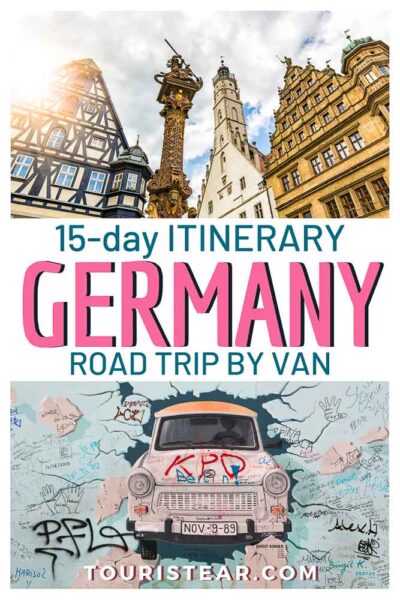
Germany Road Trip Itinerary
Day 1. Aachen and Schloss Drachenburg Castle (Night in Cologne)
Aachen, the capital of charlemagne’s empire.
When we started our road trip, we arrived in Germany from Belgium. Naturally, the first place we visited was Aachen.
Here, you have to visit the old town, the cathedral and its treasury, the Charlemagne Center, the Town Hall (Rathaus), and the Elisenbrunnen building.
Schloss Drachenburg Castle
The private villa, built in the late 19th century, is the best place to visit on your trip to Bonn or Cologne.
It has a rather fascinating history. The Schloss Drachenburg Castle is a dream of a broker and banker, Baron Stephan von Sarter, who had this palace built and did so in two years. He planned to live there but never did.
- The villa was bought by his nephew, who wanted to turn it into a tourist villa.
- The castle was passed through several hands during the twentieth century. It was once the school of Brothers of the Christian Schools, but in 1942, it turned into an elite Nazi school, and parts of the castle and gardens were destroyed. At the end of the war, it was occupied by American soldiers and used as a refugee camp.
- In the early 1960s, it was about to be demolished.
- In 1971, Paul Spinat bought the castle and refurbished it.
- In 1973, he opened the castle to the general public.
- In 1986, the castle was declared a monument, and in 1989, restoration works began.
- In 2011, the last works of the gardens were completed.
In another post, I’ll tell you the story in a little more detail.
You can leave your van or rental car in the castle parking lot. There is also a good slope that you need to pass by to get there, but it is worth it. It can also be reached via funicular .
Find different ways to get to Drachenburg Castle in this link .
Night Walk through Cologne
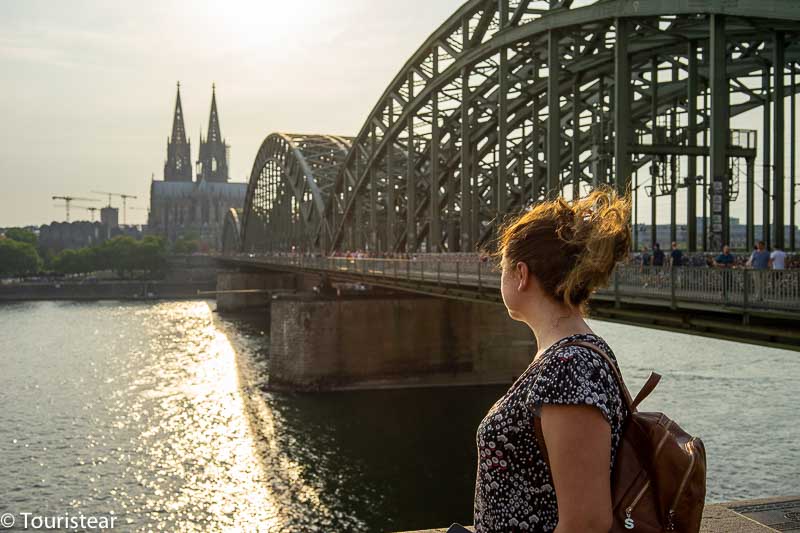
Cologne is a city in Germany with a lot of charm and with a great sunset. I recommend visiting Cologne Cathedral, crossing the bridge and taking the city’s most famous photo.
Stroll through the streets and the most commercial street in Schildergasse, where you can find the best-known shops.
Where to dine? We had dinner in Alter Markt, at Fraulein Herborths. They have great burgers, but there are many options for all tastes.
Where to Sleep in Cologne
Cologne has a variety of hotels and hostels for your trip. Based on Fer’s previous trip, our recommendation is the Art’otel Cologne . The hotel is a 15-minute walk from the Cathedral.
In a Camper Van or Motorhome
We slept in a paid area for vans and motorhomes. It is next to the River Rhine and 3 km from Cologne city center. The bike path next to the river is straightforward to reach the center by bike, walking, or electric skateboard.
If you do not need to connect to the mains before the payment area, there is a parking lot without services. There is only to discharge the black/dirty water (potty).
Day 2. Cologne – Hanover (292km)
On the second day trip of our road trip through Germany, we booked to do a free walking tour . But the tour was canceled due to a lack of people and Covid-19.
The guide was amiable and sent us the tour itinerary, and then with the help of the internet, we learned more about this interesting city.
Tip: How much money do you give to free tour guides? About 10 euros per person, if the guide is good, it is worth it! See if there are guided tours that interest you . They cost the same thing often, and those don’t usually cancel them.
Must-Visit Places in Cologne?
Visit Cologne in the morning and take the opportunity to visit the cathedral inside. It is free!
- Cologne Cathedral (there is a Golden Chest on the main altar where the relics of the Three Wise Men are).
- The Panoramic view of the city in the “Triangle of Cologne” building across Rio.
- The Chocolate Museum and the museum café place has an amazing view of the River. The coffee and desserts they offer are incredibly delicious. There is a terrace outside (which has free access as well). But don’t you dare ask for a glass of water because they charge you!!! We ordered a coffee and a glass of water (tap water), for the coffee we were charged 2.10 euros and for the glass of water € 2,40!!!
- EL-DE Haus Museum.
- Perfume Museum: Farina Haus, the world’s first cologne!
Where to eat? In one of the oldest breweries in town, we went to the Brauhaus Sion, which was an excellent choice. We ate a typical meal for a reasonable price: 3 beers, two main dishes, and an apple strudel. Everything cost only €43,70!
Hannover is a city we want to get to know better, but it was more of a bedtime stop than to visit the city. We stopped here because it’s halfway between Cologne and Berlin, so we did not drive much.
Hannover’s 5 Must-Visits
- Herrenhauser Garten
- Marienburg Castle
- Marktkirche
- New Town Hall
- Lower Saxony State Museum
Where to Sleep in Hannover
Check out Star Inn Hotel Premium Hannover, and you usually have good deals if you book in advance.
We parked the camper van in the car park next to the Courtyard Hannover Maschsee. It is next to Lake Maschsee, a great place to walk and unwind.
Day 3. Hannover – Potsdam (303KM) Night in Berlin
On this day, our goal was to get to Potsdam as soon as possible. Visit the city and get to Berlin before sunset so we can park the van conveniently.
I love Potsdam. It is a city in Germany full of palaces and gardens, where significant historical moments happened . It is located about 40km from Berlin.
In this post , I share more details of everything to visit in Potsdam, but here you have a small summary of places worth visiting.
Must-Visit Places in Potsdam
- Sanssouci Palace and Park
- The New Palace
- The Orangerie Palace
- Cecilienhof Palace (where the Potsdam Conference was held)
- The Bridge of Spies
- The Dutch Quarter
- Brandenburg Gate
- Alexandowka Colony
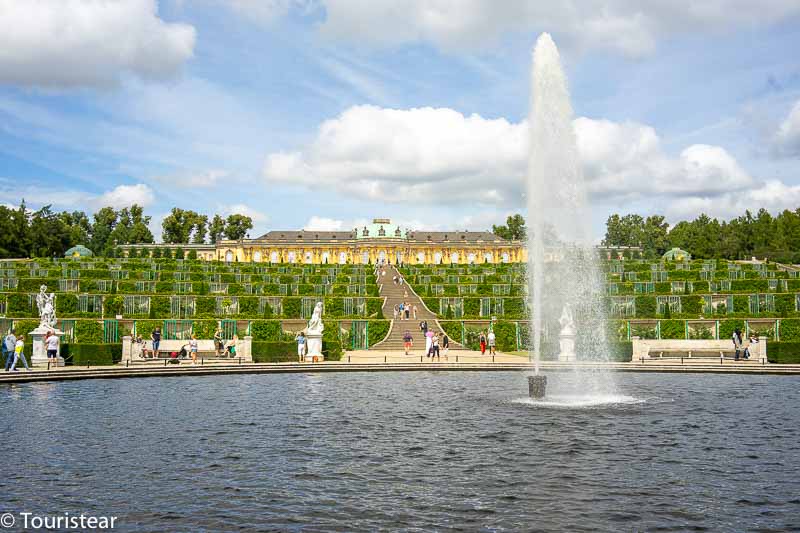
*Note: We made the whole tour by bike. I recommend you rent a bike to get around Potsdam at your own pace and enjoy the city gardens. If you want to see everything, the distances are long enough to do it by walking. Whether riding a bike or on a walking tour, get these shoes perfect for on-the-go travelers!
- You can also book a bus tour from Berlin with an English or German-speaking guide and an audio guide in Spanish, French, Italian, etc.
- You can take a few tours with an English or German guide . It could be amusing!
After the visit, we arrived in Berlin before sunset. We parked the van at a paid parking but in the city center.
Where to Park a Camper Van in Berlin?
Camper van or small RV : You can park in the car park next to the Berlin Mall. The first night costs 15 euros and up to € 20, but you are 300 meters from the Brandenburg Gate and 100 m. from the Potsdamer Platz.
It is not the most beautiful place in the world, but it is a good start to getting to know the city.
However, go with the full water tank and an empty potty (portable toilet) if you plan to spend a few days in Berlin.
Motorhome: The motorhome can be parked in Wohnmobiloase, but you have to book a working week in advance or try your luck on the same day.
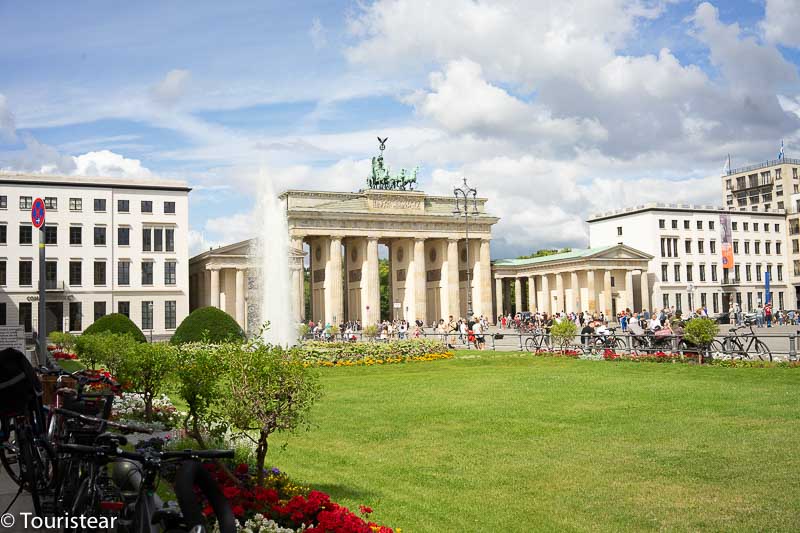
Day 4, 5, and 6 Berlin
Berlin is a city with a lot of history and many places to visit. So what we did on the first day was do a free tour to get to know a little more about the city for the first stop.
The free tour is great. You know the highlights, and you learn a little about this city in Germany and its history. The tour starts at the Brandenburg Gate.
- Check out: The Best 3 days in Berlin + 1 day in Potsdam.
- Check out: Lonely Planet’s Berlin Travel Guide if you feel like doing it all on your own.
Must-Visit Places in Berlin
- Free walking Tour
- Berlin Wall Free Tour
- Berlin East Side Gallery
- Reichstag Building (Parliament)
- Jewish Quarter
- Alexanderplatz
- Museums (Highlight: Pergamon Museum)
- Holocaust Memorial
- Turkish Quarter
- Checkpoint Charlie
Best Hotels in Berlin (for all budgets!)
Day 7. Berlin – Nuremberg (440km)
We continue our road trip itinerary through Germany. We left Berlin in the morning and went to our next destination: Nuremberg.
If you’re on time, stop in Bamberg. It’s a very picturesque town, and I’m sure you’ll love it.
Must-Visit Places in Nuremberg?
Before entering the walled city of Nuremberg, we visited the Zeppelin field , one of the most emblematic buildings during the Nazi era.
It was easy to park the van there, and it had a very nice lake area. On the way back, you can find the Nazi Party Documentation Center, a place converted into a museum.
It is a must to visit the permanent exhibition “Fascination and Violence,” on about 1,300 m2 of land. The exhibition shows the causes, relationships, and consequences of National Socialist tyranny.
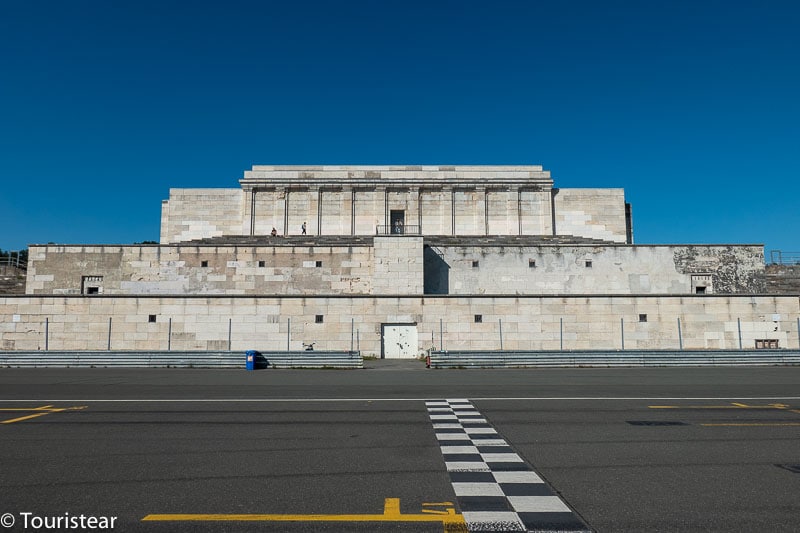
Suppose you like the whole World War II thing. Then, Nuremberg is a city you have to visit.
Then we toured the city center on foot. We arrived at the church of San Lorenzo, had a beer in the tower in front of it, and dined at Urfa kebab, which was on the way via van, near the wall, and it was delicious.
Where to Sleep in Nuremberg
In a Hotel:
The Ibis Hotel Nurnberg Altstadt is well-located and reasonably priced (€60). You can walk everywhere from there.
We spent the night in a car park that is very close to the city. But, honestly, I do not recommend it because of the noise. We ignored the train tracks a few meters away… we seemed like newbies…
Leaving the van all day is okay because there is plenty of noise at night.
Day 8. Nuremberg – Night in Munich
On this day, we visited Nuremberg in the morning with a free walking tour . We hired it through Civitatis, and we had a good guide who loves the city.
We also learned the history and other interesting things, making the tour very enjoyable.
In another post, I’ll tell you every detail of what to see in Nuremberg, Germany. But if you are interested in guided tours, I leave you this link so that you can take a look at them.
Must-Visit Places Nuremberg
- Zeppelin Field
- Kaiserburg Castle
- National Museum
- St. Sebaldus Church
- St. Lawrence Church
- Schoner Brunnen
- House of Albrecht Dürer
- Nuremberg Sausages (Bratwurst)
- Tour the Old Town
- The Hospital of the Holy Spirit
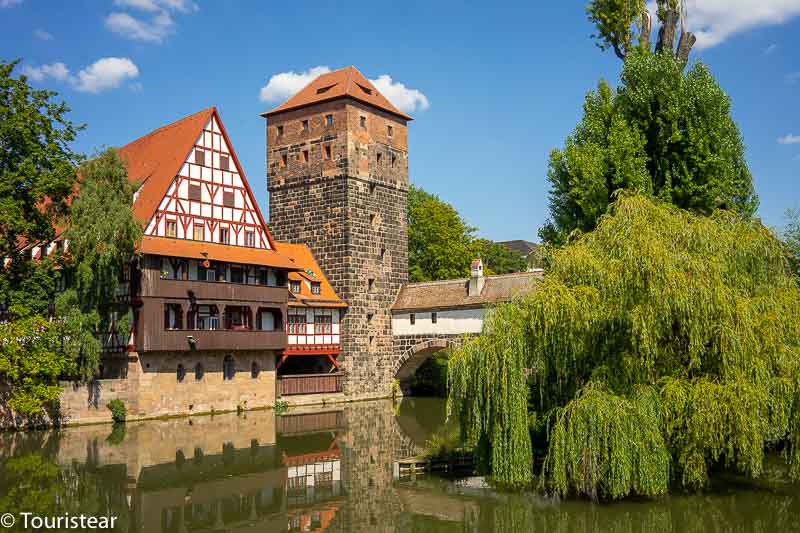
We ate in Nuremberg in a typical brewery. We ordered sausages but they also have some that are typical with special recipes. So as always, we tried the regular food of the place.
We follow our camper road trip through Germany in Munich, and it is about two hours in the van. By car, you can go much faster. 😉
Where to Sleep in Munich
Munich is one of Germany’s most expensive cities, so you will have to make a reservation in advance to find well-priced hotels. Take a look at Mercure Hotel Munchen Altstadt. It is centrally located, and the price is usually below 100 euros per night.
By a Van or Motorhome
In Munich, Germany, you can spend the day and night in the Allianz Arena area, the stadium of Bayern Munich.
We paid €18 and had access to water, electricity, and a potty place. The experience was modern, and the toilet does everything from emptying to cleaning itself with a blue cleaning liquid.
This place is pretty good, and quiet, and you can get to the city center by public transport. *But matchdays are not enabled.
Day 9. Munich and Night in Fussen
In Munich, we continue with the same dynamics as the previous cities on our road trip through Germany. We start the day by doing a free walking tour and getting to know the city on our own.
As we spent the night at the Allianz Arena, we moved the campervan to Maria Theresia street, next to Maximiliansanlagen Park, which is free. Then, we went for a walk to the meeting point of the free tour.
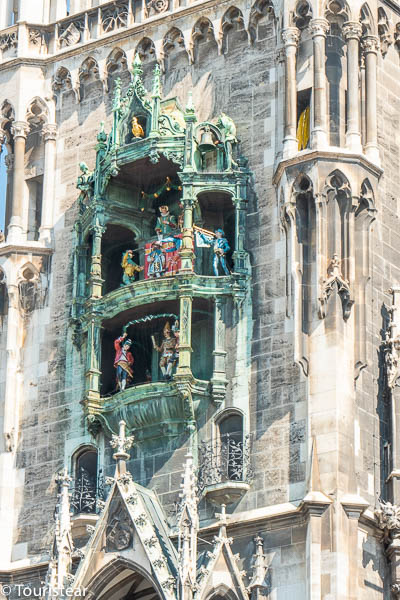
We toured the Maximilianstrasse, the city street with mega luxury shops.
- Read this post if you are looking for a 3-day Munich itinerary
Must-Visit Places in Munich
- Nymphenburg Palace
- Marienplatz
- Rathaus-Glockenspiel on Marienplatz
- Augustiner Keller BrauHaus and beer garden
- Hofbrauhaus, the most famous brewery
- Churches (Our Lady, St. Peter, and Asamkirche)
- Oktoberfest
- Munich Residenz
- Tour of the Third Reich
- Dachau Concentration Camp Tour
From Munich, we continue the road trip to the Castle of the Mad King, Neuschwanstein. We arrived at sunset, but we made some stops on the way.

From Munich to Fussen (where Neuschwanstein Castle is located), it is 120km away.
We stopped in Wies (Steingaden, Pfaffenwinkel) to visit the Wies Pilgrimage Church, a UNESCO World Heritage Site.
The setting is fabulous, the outside of the church is solemn, and the interior is amazing.
Wies to Fussen is 30km away, but first, we stop to take some pictures of Neuschwanstein Castle. It looks awesome with the sunset light.
Where to Sleep in Fussen or Neuschwanstein
Here you have two options, either you stay at the foot of the castle or stay in the village of Fussen. As you can imagine, the accommodations located at the foot of the castle are limited, and the prices are higher than in Fussen.
I’ll leave you two recommendations for less than €100 a night.
- Haus Bullachberg is located at the foot of Neuschwanstein Castle. It is a one-bedroom apartment, and the price goes from € 99 to €139 per night.
- In the center of the village , the double room with breakfast costs € 106.
There are paid areas for vans and motorhomes, but you have to book in advance because they book fast. We went without reservation, and the two areas we saw were complete.
But there is a car park in Schwangau, where you can spend the night. Actually, it’s not allowed, but they leave you if you leave early in the morning or pay for parking.
The best thing about this place is the overlooking view of the castle. You have the Neuschwanstein castle in your backyard 🙂
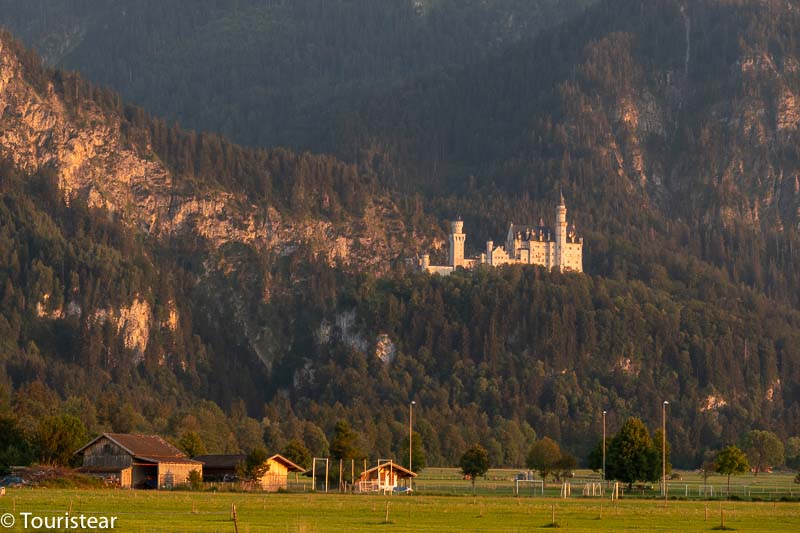
Day 10. Beginning of the Romantic Route: Neuschwanstein
- Neuschwanstein
- Landsberg am Lech
Neuschwanstein Castle, the Mad King’s Castle
We begin the German Romantic Route with a visit to Neuschwanstein Castle, better known as the Mad King’s Castle. It is the castle that inspired Disney to create its princess castles.
To get to the castle, you can ride by bus or travel on foot. My recommendation is that you do it walking.
You have to go in good mountain shoes , and there are different paths: you can do the path following the signs, make the path Google Maps proposes, or go up on the street. (we did Google maps path)
It’s about half an hour walking up the hill. But it’s definitely worth the effort.
After the castle’s visit, we started our road trip in a campervan on Germany’s Romantic Route.
It is a 350-kilometer route that joins the town of Fussen with Wurzburg. You pass through a lot of charming villages, cities with lots of history, and beautiful landscapes. Here’s the itinerary.
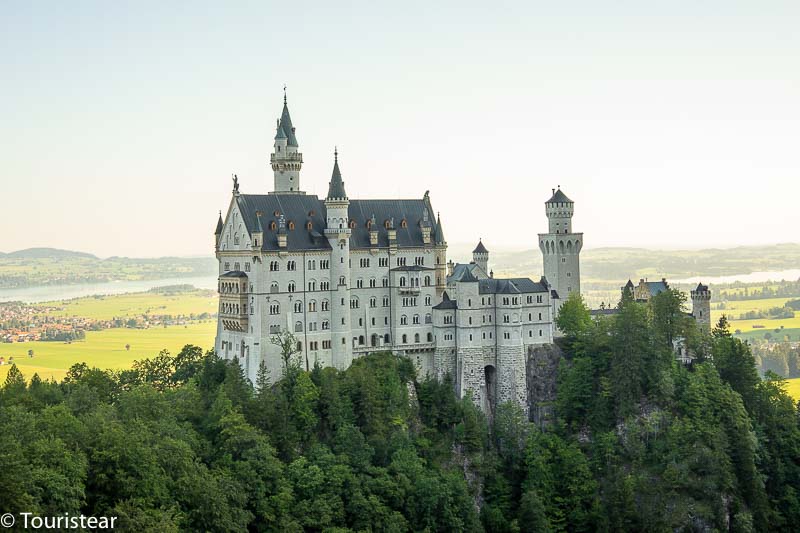
What Do We Visit on the First Day of the Romantic Route?
- Neuschwanstein Castle
- Landsberg Am Lech
As you can see, we were too busy. It was a mad day! We finished this day exhausted, and we re-do the itinerary, which included Luxembourg and some cities in France… Totally unrealistic. For more romantic plans in Germany, read my recommendations here!
Day 11. Donauwörth – Nördlingen – Dinkelsbühl and Night in Rothenburg Ob Der Tauber
We changed the itinerary of the road trip by campervan through Germany and decided that we would only visit two or three maximum villages a day. This gave us time to enjoy the trip; otherwise, it seemed like a competition, something meaningless.
In the morning, we visited Donauwörth, one of the towns/cities of Germany’s Romantic route. It was once a fishing town located at the intersection of the Danube River and the Wörnitz.
You have to walk along Reichsstrasse. It’s one of the most beautiful locations in southern Germany.

*If you’re on time, the next stop is Harburg, and you can visit its castle. We just saw it on the outside.
This village is built in the crater left by a meteorite! It is a medieval German village with a wall that stretches around the whole village. You can walk around the wall too!
Stroll through the historic center and visit st. George’s Church, an icon of the city. You can visit the bell tower, called Daniel, and climb the stairs to enjoy the village’s panoramic views and the surrounding area.
It’s a small town you can visit in a couple of hours. You can park your car or van outside the walls or inside during disc hours, a maximum of half an hour.
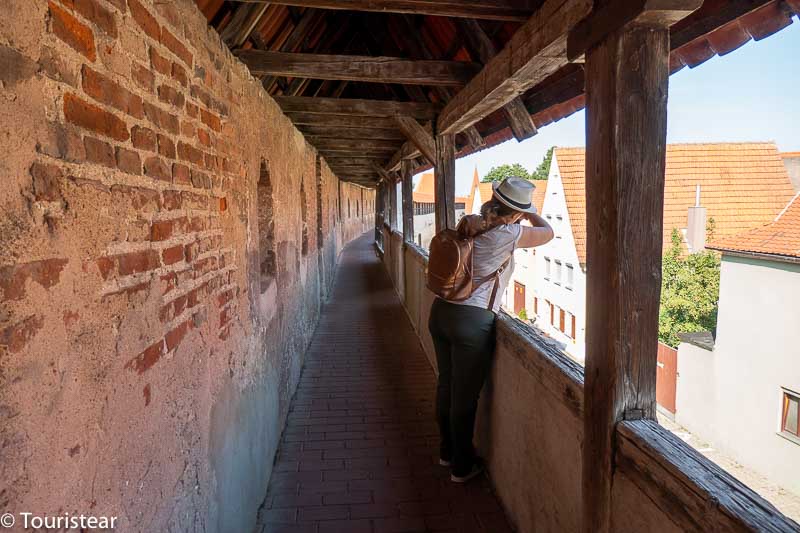
Dinkelsbühl
Dinkelsbühl is one of Germany’s Romantic Route villages that preserve its old town as it was 400 years ago.
According to historians, it is one of the best-preserved towns in Germany! Without a doubt, an essential stop. You have to visit the Gothic Cathedral of St. George, walk through the village, and enjoy its charm.

NOTE: Between Dinkelsbühl and Rothenburg ob der Tauber, there are two other prominent villages to visit: Feuchtwangen and Schillingsfürst. We had to choose between visiting each other.
But if you’re on time, you can visit them and tell us in the comments your thoughts and if you recommend them for other travelers.
Where to Sleep in Rothenburg ob der Tauber
I recommend that if you are short of time, keep going to Rothenburg ob der Tauber and stay at one of its hotels.
Take a look at Pension das Lädle , and it has a fairly reasonable price for what is in the village.
We spend the night in Rothenburg ob der Tauber in one of the caravan car parks before entering the village. It’s very quiet, and you are steps away from walking from one of the most famous villages on this route.
Day 12. Rothenburg ob der Tauber – Night in Würzburg
Rothenburg ob der Tauber is the most beautiful and famous imperial city on this route. It is located at the top of the Tauber Valley, where the Romantic Route and the Castle Route intersect.
Plönlein Square and Sieber Tower, which you’ll see in thousands of photographs, are the most iconic places due to the painter. But Rothenburg ob der Tauber is much more than a photo.
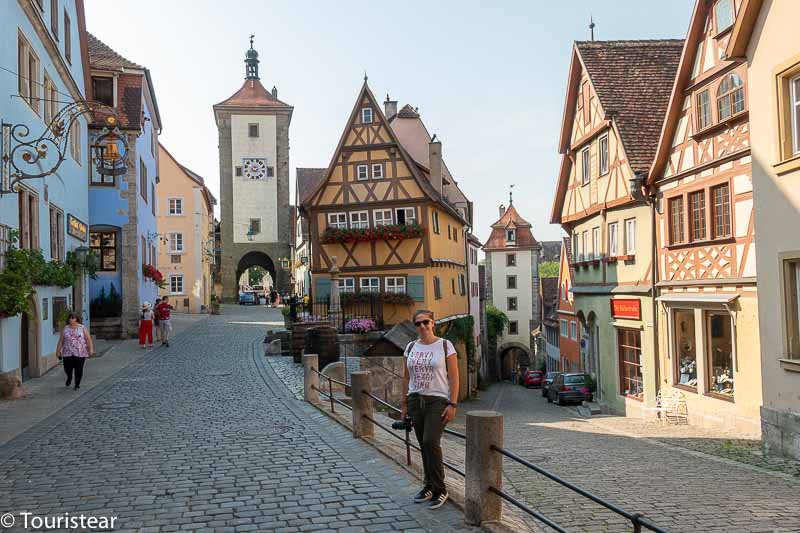
As soon as you enter the village you are already surprised by its wall (which you can visit), the hospital, and the bastion.
Once inside, you will marvel at the combination of the Gothic and Renaissance architecture of the Town Hall (Rathaus).
I’m going to write a post about this town/city alone to tell you everything we’ve learned, so you can give it the time it deserves.
We spent all day here, and then went to Würzburg to spend the night before we did the laundry for the things from the road trips…
NOTE: Between Rothenburg ob der Tauber and Würzburg, there are about 65 km and a few charming villages such as:
- Creglingen,
- Weikersheim,
- Bad Mergentheim,
- Lauda-Köningshofen,
- Tauberbischofsheim
- and Wertheim Village. Visit them if you have time!
Where to sleep in Würzburg
Hotels aren’t especially cheap in Würzburg, so here’s the link for the city’s hotels, so you can choose the one that suits your budget and travel style.
In a Camper Van
We slept in the van in a motorhome park area that is located next to the River Main. From there you can easily reach the city center by walking, cycling, or public transport.
Day 13. Würzburg, End of the Romantic Route
The road trip itinerary through Germany continues in Mainz, and we spent the night in Rudesheim am Rhein.
It is a university town on the banks of the River Main. It is located in the heart of the Franconian wine region. From almost every point, you can see the Marienberg Fortress and the UNESCO-listed Palace.
Within the city, there are several interesting places to visit. Highlights include the cathedral, the new cathedral, the Market Square, and the Old Statue Bridge.
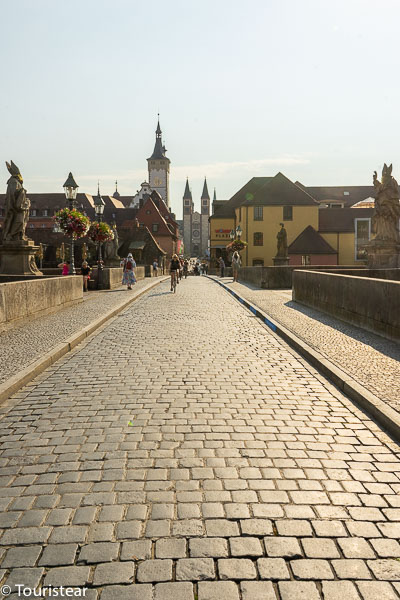
If you like wine, you can take guided tours of the local vineyards and taste their wines.
* If you arrive in Würzburg from Frankfurt but do not want to rent a car , from April to October, there is a bus departing from Würzburg and touring all the villages of the Romantic Route, Germany’s first-holiday route after World War II.
We went all the way from Würzburg to Mainz, the city of Gütenberg, and here we visited the museum of Gütenberg, the father of the printing press.
Here you can see the evolution of the printing presses and two original bibles by Gutenberg.
We took a short walk and continued on our way to the town of Rudesheim am Rhein.
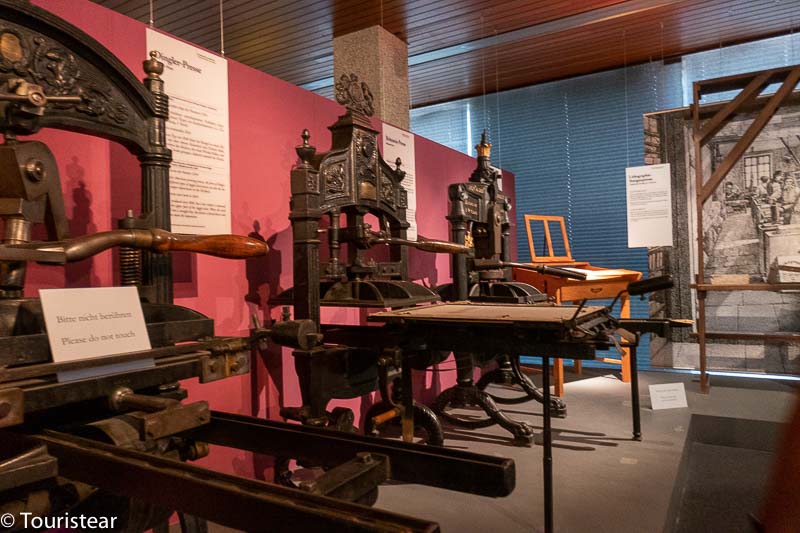
Rudesheim am Rhein
We arrived in the afternoon, and it is less than 40 km from Mainz and 65km from Frankfurt. Therefore, I recommend you visit this town on your road trip through Germany or your Frankurt getaway.
*In this area, I would dedicate another week at least, but we have only been able to dedicate two and a half days. So, if you like nature, charming towns, and wine, you can stay longer too. We have an excuse to come back.
Rudesheim am Rhein is a village with an area that we love. It is more than two thousand years old as a wine area, and it has world heritage sites and wonderful restaurants. The village is very picturesque and charming when it rains.
In the afternoon, it was raining very hard. So we parked the van and went to dinner at the most picturesque street in town: Drosselgasse.
We had a superbdinner at the restaurant, Rüdesheim Schloss. We enjoyed the local food and wine. In another post, I’ll tell you more because this post is very long, lol.
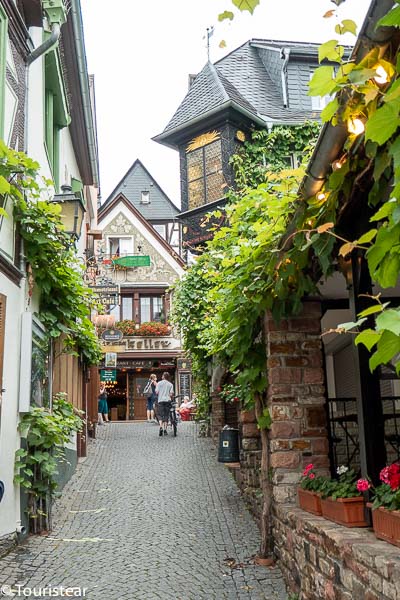
Where to Sleep in Rudesheim am Rhein
There are a variety of hotels in Rudesheim am Rhein . Check out the ones you like the most.
There is a campsite where you can stay, but it costs 30 euros per camper or motorhome per night. If you’re going to spend the day or go with the kids, I think it’s a good option. But not for spending the night.
So we slept for free in a car park, near the bus parking. Nothing from the other world, but we prefer to spend the camping money on having dinner in a good restaurant. We had our priorities on food, hehe.
Day 14. Rudesheim am Rhein – Bacharach – Burg Eltz Castle
On this day, we discovered that this region is a wonder. The morning is the best time to visit the village of Rudesheim am Rhein and the Nierderwald forest and its most representative monuments.
This place is super nice, and you can get there by your own vehicle or by funicular from the village.
The bad thing for us is the price of parking : € 10.50 (regardless of whether you stay an hour or all day).
*Tip : Cross to Bacharach on the ferry. The price depends on the length of the vehicle. They depart every 20 minutes.
Another picturesque village on the banks of the Rhine is dedicated to wine. Bacharach has Celtic origins, and its original name was Baccarus. Some say that the mention of the city’s name was in 923 while others insist on 1019.
In 1356, Emperor Charles IV granted it the title of city. Its economy was always linked to viticulture and the wine trade.
As a curiosity, Pope Pius II ordered, among other things, to send a vat of 1000 liters of Bacharach wine to Rome every year!!! Emperor Wenzel agreed that Nuremberg’s city should pay a fine with 4 vats of Bacharach wine (4000 liters).
That tells us something, doesn’t it? The wine here is good! Lol
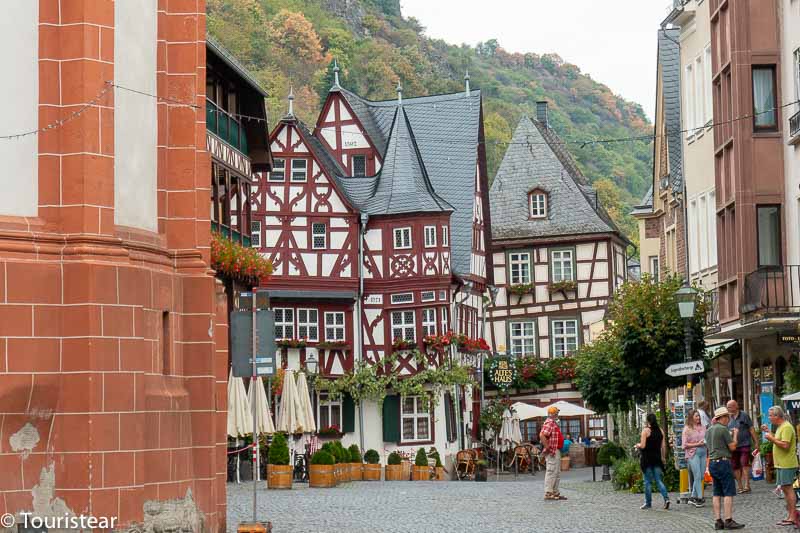
Bacharach is a fortified city, very well preserved. The covered wall surrounds the entire old town and is walkable. Stroll along the wall and through the center of the village; it is small and very easily toured in an hour.
Burg Eltz Castle
It is a spectacular medieval castle, a world heritage site, located in the hills near the Moselle River (it does quite a competition to the Mad King castle). It belongs to the same family (or branch of it) for 33 generations since the twelfth century.
Some parts are open to the public, and others are not since the family owns the castle.
The castle looks like something out of a tale, is surrounded by green everywhere, and you can hear the river’s sound from there.
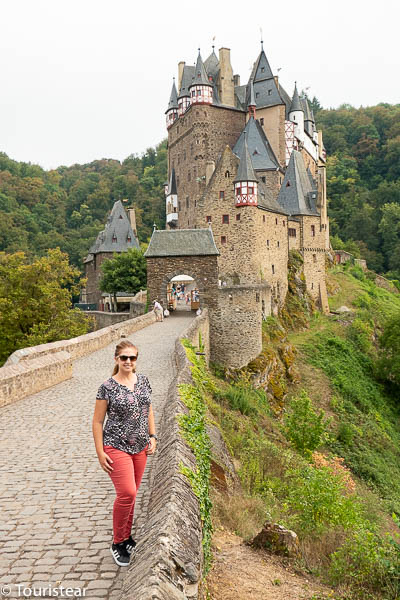
To get to the castle, you have to leave your vehicle in the car park and continue your way on foot or by bus (€ 3 way.)
The way to the castle is downhill and the return uphill, but it is a little steep, compared to Neuschwanstein Castle, and it becomes quite easy. That said, go with proper shoes; because of the humidity there, it can slip a little.
From here, we went to the suspension bridge: Geierlay Suspension Bridge (about 30 km from the castle).
Geierlay Suspension Bridge
Geierlay Suspension Bridge is 360 meters long and 100 meters high. The surroundings are spectacular and the bridge has only been open since 2015.
With the Covid theme to visit, it is a little more annoying than before. Now, in even hours you cross the bridge to go, everyone in one direction, and at odd hours you can return. Keep this in mind to calculate the times of your trip.
The good thing is that it is open late for German times and is free.
It used to be open 24 hours a day!
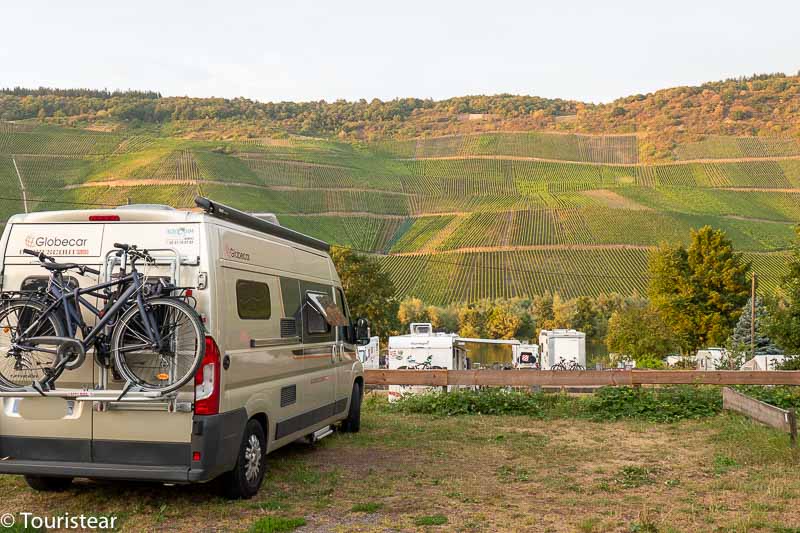
Day 15. Bernkastel-Kues – Cochem
There is a full route to the Mosel area from Koblenz to Trier or Nittel on the Luxembourg border.
It is an area that has been dedicated to winemaking for more than two thousand years, full of charming places, festivals, art, and we will definitely return.
Bernkastel-Kues
A half-timbered village by the Moselle River, where you’ll find traces of a Roman past and medieval architecture. Definitely, a place you’re going to fall in love with.
Here you have to visit the medieval market square, the Renaissance Town Hall, next to half-timbered houses, and the pointed house (probably the most photographed).
Of course, you have to stroll through the historic center, see the birthplace of Nicholas de Cusa, the hospital of St. Nicholas, and the castle of Landshut.
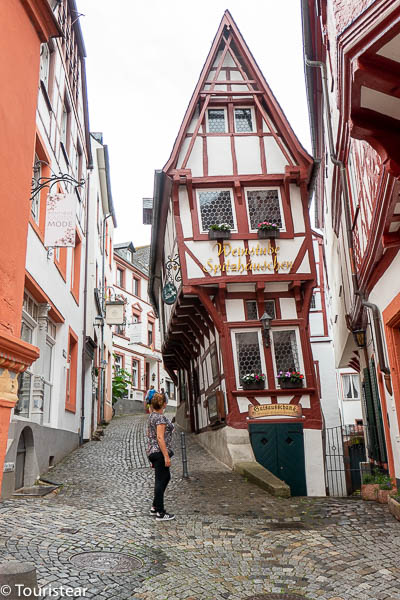
Cochem is a city in the Moselle River Valley. It is a very touristic place where people from all over the country arrive. It is to the west of Germany and crowned by a spectacular castle: the Reichsburg Cochem.
Besides, you can enjoy its Riesling wines, its streets, and its history.
The first thing we will see as we approach Cochem is its medieval castle, remodeled in the nineteenth century with this fairytale castle appearance.
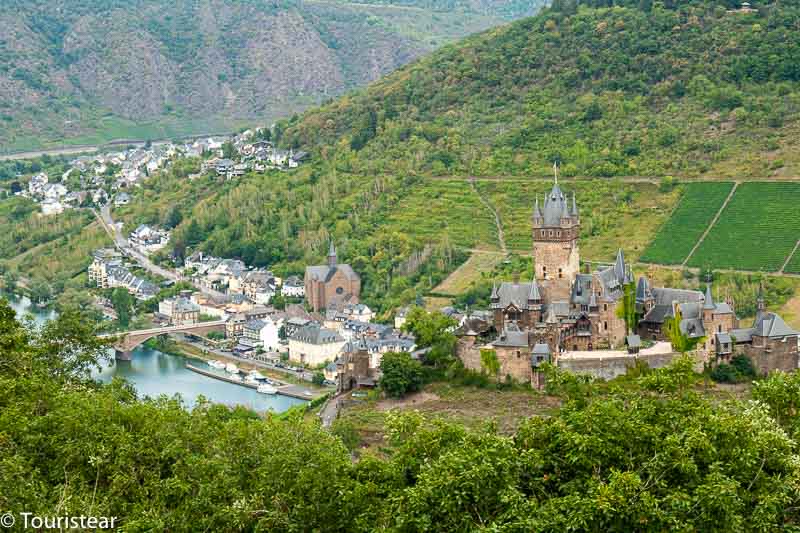
Once in the village, let yourself be carried away by its streets with half-timbered houses; many seem to defy gravity.
You have to cross the Enderttor, one of the three medieval gates dating from 1332. And it was the village prison for a long time.
To get a good view of the village, cross the bridge and take a photo from there and as you cross.
If you like boat trips, take the opportunity to get to know the “skyline” of the Moselle villages from the river itself. Then, click here to hire the boat ride.
Don’t forget to try their wines. We brought a few bottles home. Also, take a boat ride along the river or take a bike ride along the riverbank.
If you have more time for the Mosel area visit:
- Make a wine route
- Take a bike route
- Be part of its hiking trail.
And so far, our itinerary plus tips for traveling to Germany by car or camper van. I know this post is a little long. I have tried to be as concise as possible…
In the next few days, I will expand the information in other articles, so you can plan your trip through Germany on your own and enjoy it. As you can see, there are many things to do, many places to discover and enjoy.
Do you know Germany? Tell us about your experience in this country!
Travel Insurance
Before you go on a fantastic road trip to Germany in 15 days, get travel insurance that you can use for emergencies.
Visit Heymondo to get travel insurance according to your needs and budget. This link gives you a 5% discount on your travel insurance purchase .
Book Your Trip Here!

Find a Hotel
On Booking.com

Book Your Tours
Get Your Guide

Find Flights
Via Skyscanner.

Get Travel Insurance
On HeyMondo
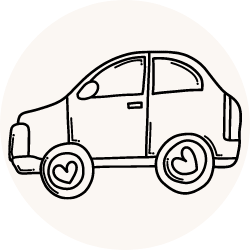
Via Discovercars
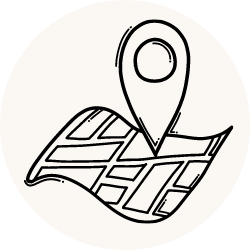
Stay Online
Plan your trip to germany.
- Visit the Black Forest
- Accommodations in the Black Forest area
- What to see in Cologne
- Best Things to do in Berlin
- Romantic Plans in Berlin
Save this image on your Pinterest
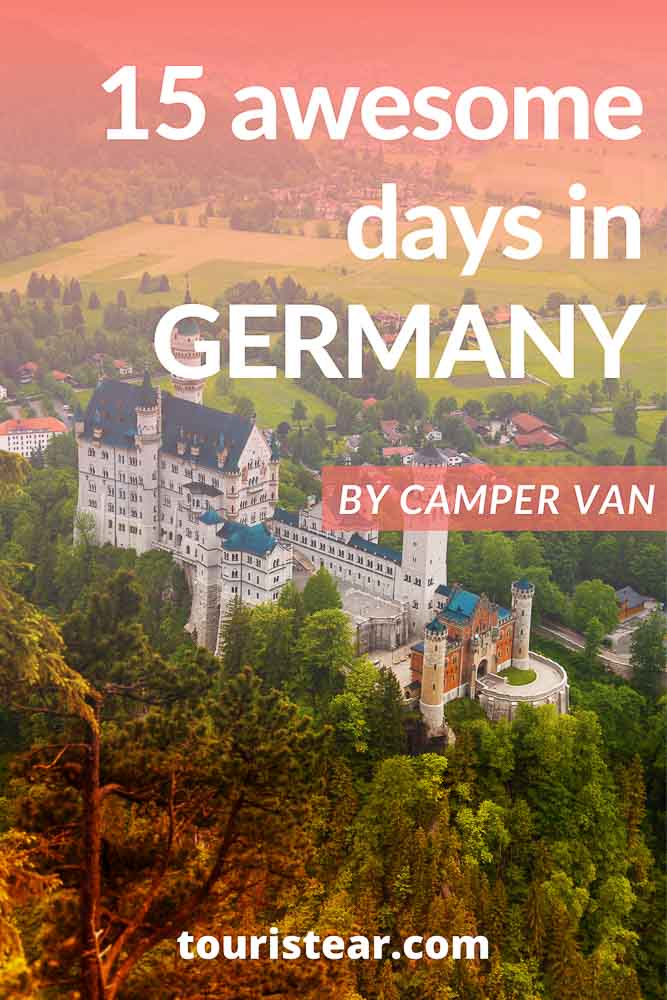
Last Updated on 19 October, 2023 by Veronica
Disclosure: Some of the links on this post are affiliate links, meaning at no additional cost to you, I may earn a small commission if you click through and make a purchase.
Author: Veronica
Vero, a seasoned traveler, has explored 25 countries and lived in five, gaining a rich perspective and fostering an infectious passion for travel. With a heart full of wanderlust, Vero uncovers the world’s hidden gems and shares insights, tips, and planning advice to inspire and assist fellow adventurers. Join Vero and let the shared passion for travel create unforgettable memories.

Soy Verónica, una apasionada de los viajes, me gusta compartir mis experiencias viajeras en mi blog. He estudiado Empresas y actividades turísticas y ando metida en el mundo del Marketing Digital. Me gusta aprender algo nuevo cada día, conocer nuevos lugares y culturas diferentes.
Similar Posts

11 days in Japan Complete Itinerary
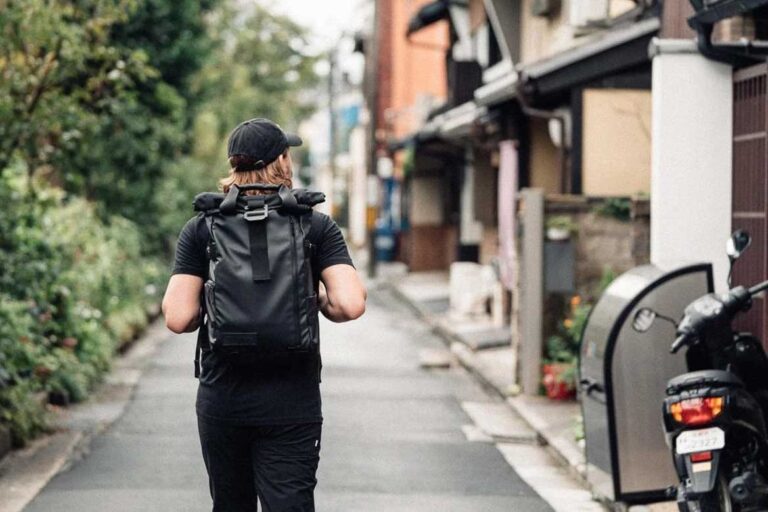
WANDRD PRVKE Review: Best Photography Backpack?
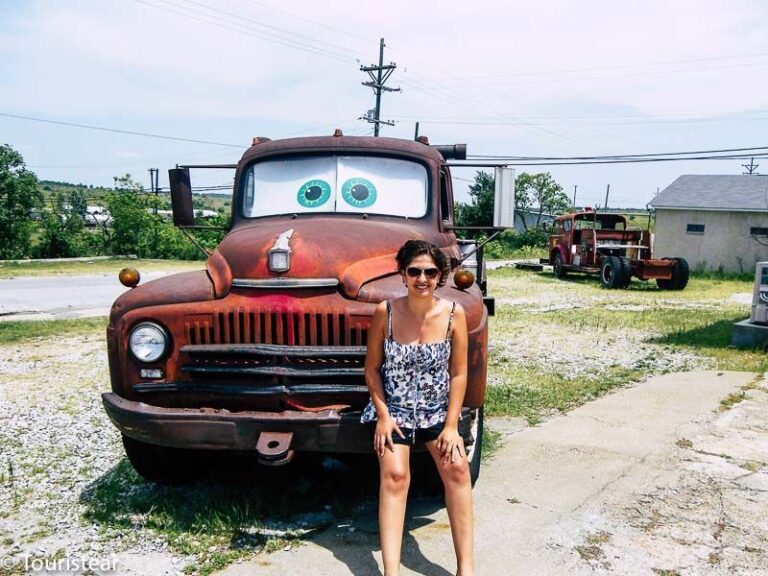
Route 66 from Bristow to Springfield
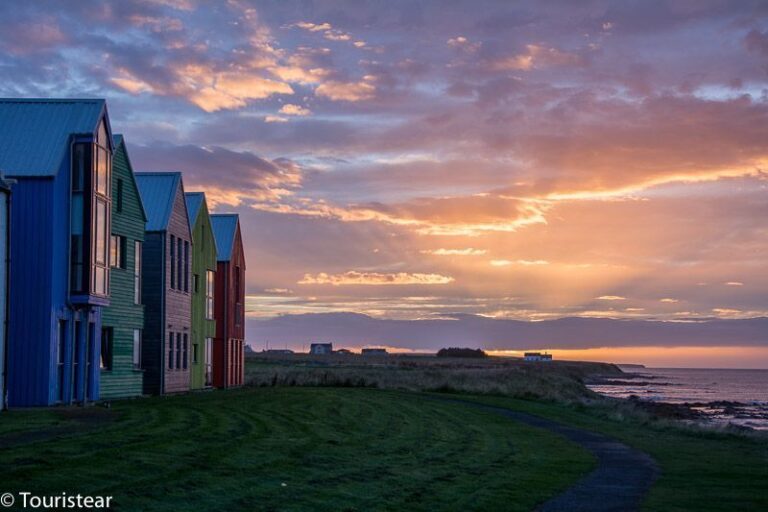
Road Trip Itinerary North Coast 500 + MAP

Best Things To Do in The Black Forest, Germany
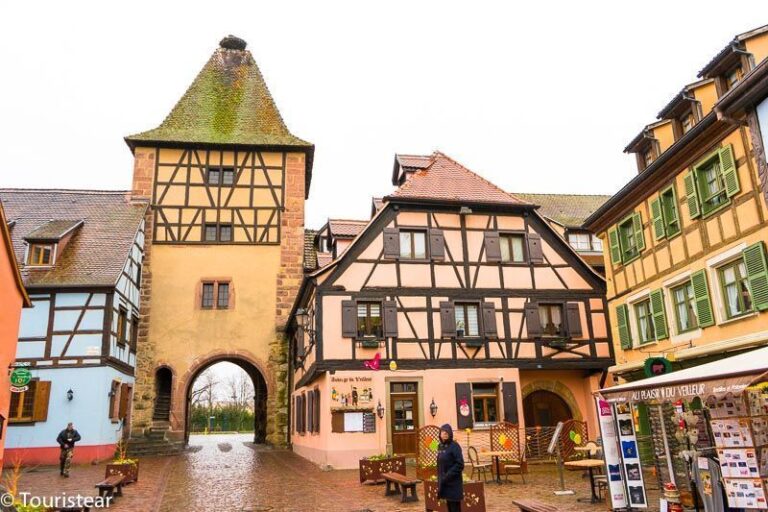
Ultimate 4-Day Alsace Road Trip Itinerary + MAP
Leave a reply cancel reply.
Your email address will not be published. Required fields are marked *
Save my name, email, and website in this browser for the next time I comment.
This site uses Akismet to reduce spam. Learn how your comment data is processed .
Driving in Germany
Top Attractions
Germany With Kids
Best Festivals
Scenic Road Trips
Where to Go Hiking
Best Beaches
Ski Resorts
Christmas Markets
Food to Try
Beer Regions
Best Time to Visit
Weather & Climate
Top Cities to Visit
Germany's Islands
How to Get Around
Getting Around Germany
:max_bytes(150000):strip_icc():format(webp)/ebephoto-5b7352c3c9e77c005080d5ad.jpg)
wastesoul / Getty Images
There are many ways to explore Germany , depending on your itinerary, personal taste, and budget. Find out how you can best travel around the country from renting a car and flying down the Autobahn , to hopping on a plane, to enjoying a relaxing train ride. These are the people that invented the term wanderlust and travel in Germany is proof that it's not always about the destination, sometimes it is the journey.
How to Get From City to City
Robert Harding / Getty Images
What’s the fastest way to get from Berlin to Frankfurt ? Is it cheaper to take the train or opt for a plane if you want to travel from Munich to Hamburg ? Or is it better to rent a car and drive down the Autobahn?
Our series on how to get from one German city to the next offers all of this info, including which transportation options are fastest and most cost-efficient.
Train Travel
huettenhoelscher / Getty Images
One of the best ways to discover Germany (and Europe at large) is by train. Deutsche Bahn or "DB", the German railway system, is very well developed and reliable. You can reach almost every city in Germany by train; not to mention that watching the German landscape stream by your window is a very relaxing and comfortable way to travel.
Driving a Car
GettyImages / Norbert Breuer
Do you want to rent a car and travel on the world-famous German Autobahn? Of course, you do. And driving can help you get around with a family or travel at your own speed.
Driving in Germany is straight-forward, but you need to follow the rules of the road to travel at those high speeds and dispel myths (like there is no speed limit on the Autobahn).
Best Scenic Drives
Of course, sometimes the trip is an attraction in itself. Hop in the car and make the journey your reward.
Germany offers many scenic drives that will lead you past quaint villages , medieval castles , and unspoiled countryside. From the Romantic Road to the Castle Road , from the Fairy Tale Road to the German Wine Route , are some of the roads best traveled in Germany.
Sean Gallup / Getty Images
Not everyone has the budget for a train or car rental, and buses can be an inexpensive way to see the country.
Bus networks are extensive, extending well beyond Germany's borders. They commonly offer vast discounts with little loss in luxury. Brands like Berlin Linien Bus and Flixbus offer comfortable, environmentally friendly, and wifi-connected coaches.
Sometimes the journey is slightly longer than driving or by train, but the difference is usually slight. Also note that buses are commonly subject to traffic delays on busy travel times like before and after holidays, or heading into the weekend.
Kenneth C. Zirkel / Getty Images
While many international visitors arrive through Frankfurt's International Airport (or less frequently by Munich and Berlin 's airports), traveling by plane is actually one of the worst ways to travel through Germany. You miss the wonderful German landscape and it is often far more expensive than the other options. Many flights also stopover in other countries, making flying inconvenient and longer than necessary.
That said, finding cheap flights is possible. Watch for deals between hubs like Frankfurt, Munich, and Berlin. There can also be an element of surprise with deals like EuroWings blind booking.
German for Travelers
Bene-Images / Getty Images
Another key element for your travels is speaking a bit of Deutsch . It's true that most Germans speak English, but a little German can go a long way. Speaking German with the sales agent at the ticket counter or your fellow travelers on the train or at a restaurant can make travel easier and more enjoyable.
Germany Guide: Planning Your Trip
How to Travel From Berlin to Munich by Train, Bus, Plane, and Car
Lübeck: Planning Your Trip
How to Travel From Berlin to Hamburg by Train, Bus, and Car
Traveling by Train in Europe: Where, Why, and How
Car Lover's Guide to Germany
How to Travel from Frankfurt to Paris by Train, Bus, Car, and Plane
How to Travel From Florence to Paris by Train, Bus, Plane, and Car
How to Travel From Frankfurt to Berlin by Train, Bus, Car, and Plane
How to Travel From Berlin to Paris by Train, Bus, Plane, and Car
How to Travel from Berlin to Dresden by Train, Bus, Car, and Plane
How to Travel From Frankfurt to Munich by Plane, Train, Bus, or Car
How to Travel from Frankfurt to Cologne by Train, Bus, and Car
How to Travel from Berlin to Prague by Train, Bus, Car, and Plane
Train Travel in Germany
10 Best Cities to Visit in Germany
Privacy settings
Here you will find an overview of the types of cookies used on the website. You can set your consent for each category individually. Further information can be found in the privacy policy .
- Essential Cookies For the use of the website with all functions (e.g. user settings, watch lists, etc.)
- Statistics Statistics Cookies collect information anonymously. This information helps us to understand how our visitors use our website.
- Marketing In order to provide you with the best possible offer in cooperation with our partners, we use marketing tools. For example, in order to use our chatbot, you must activate this setting.
- External contents Required for viewing external media and third-party content. The provider may set cookies for its part. The respective data protection regulations of the provider apply.
Inspiring Germany
- Cities & Culture
- Nature & Outdoor Activities
- Royal Palaces & Castles
- Experience & Enjoy
- Current highlights
- Sustainable travel
- Barrier-free travel
- Easy language
- Federal states
Slow travel by electric car!
Shorter distances mean more relaxation. Go on a relaxing road trip through Germany by electric car, with charging breaks and stopovers, and turn the journey into an enjoyable sightseeing tour.
Lots of good news for your electric car journey through Germany: with around 47,000 e-charging points , Germany is among the top five countries for e-mobility. With good preparation and a fully-charged smartphone or tablet, you can begin your tour by electric car with confidence. Charging on the go is convenient in many places, and it allows you to combine the necessary with the beautiful. Anyway, the best thing about e-mobility, besides sustainability, is the slowing down of the journey. The required stops to recharge your car's battery allow you to take breaks for a little sightseeing or a nice coffee and cake.
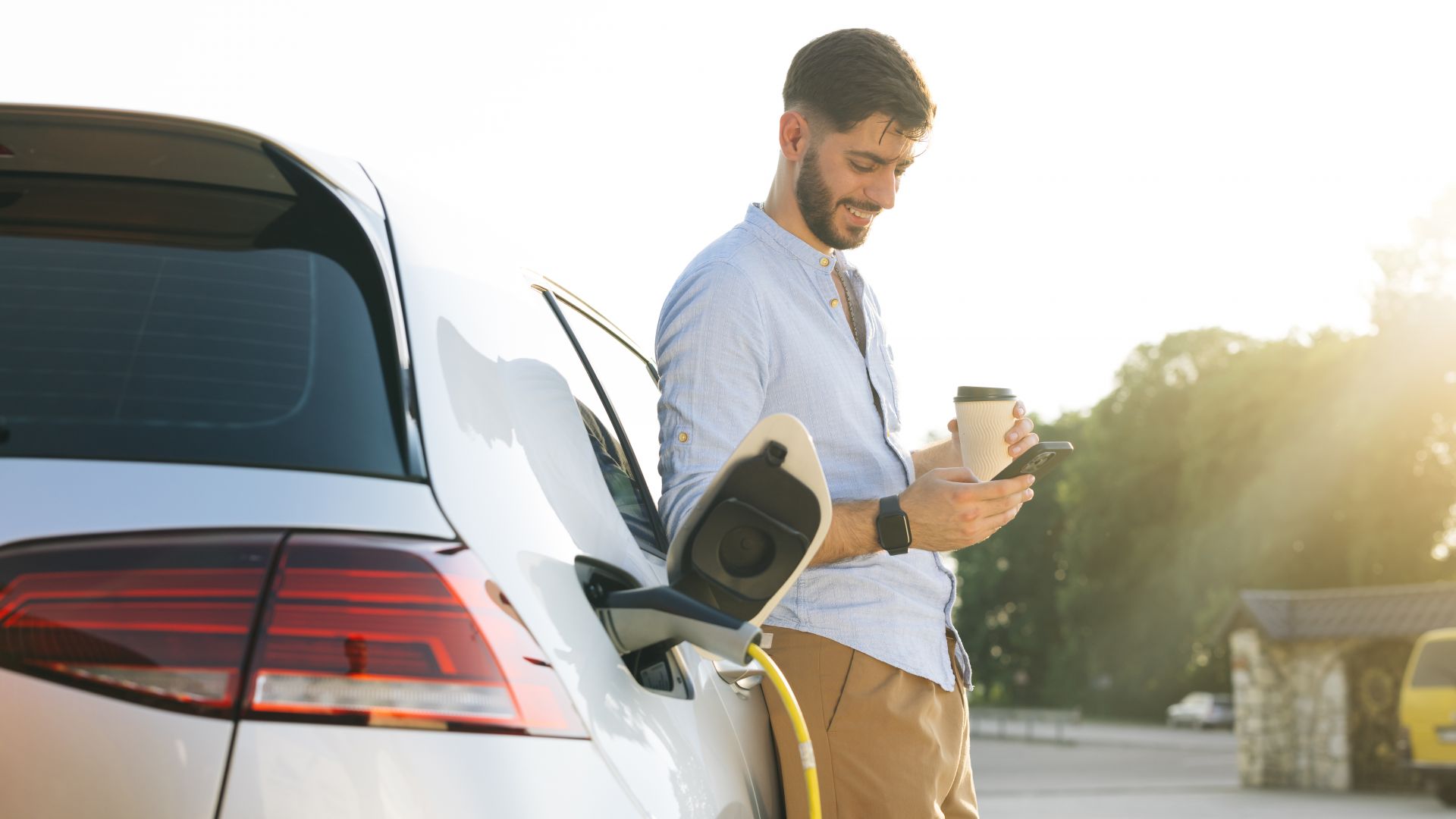
From Frankfurt to Hohenschwangau
There are a total of 91 charging stations along this 430-kilometre route. Once you leave the Main metropolis with its breathtaking skyline, you'll head steadily south – past Würzburg and Rothenburg ob der Tauber, Ulm and Kempten, and finally to Hohenschwangau in the lake district in front of the Ammer Mountains. The south of Bavaria has a lot of beautiful things to offer – scenic, culinary and cultural. The Hohenschwangau Castle is just one example. There are plenty of day trips worth taking around this region: by electric car or on foot!
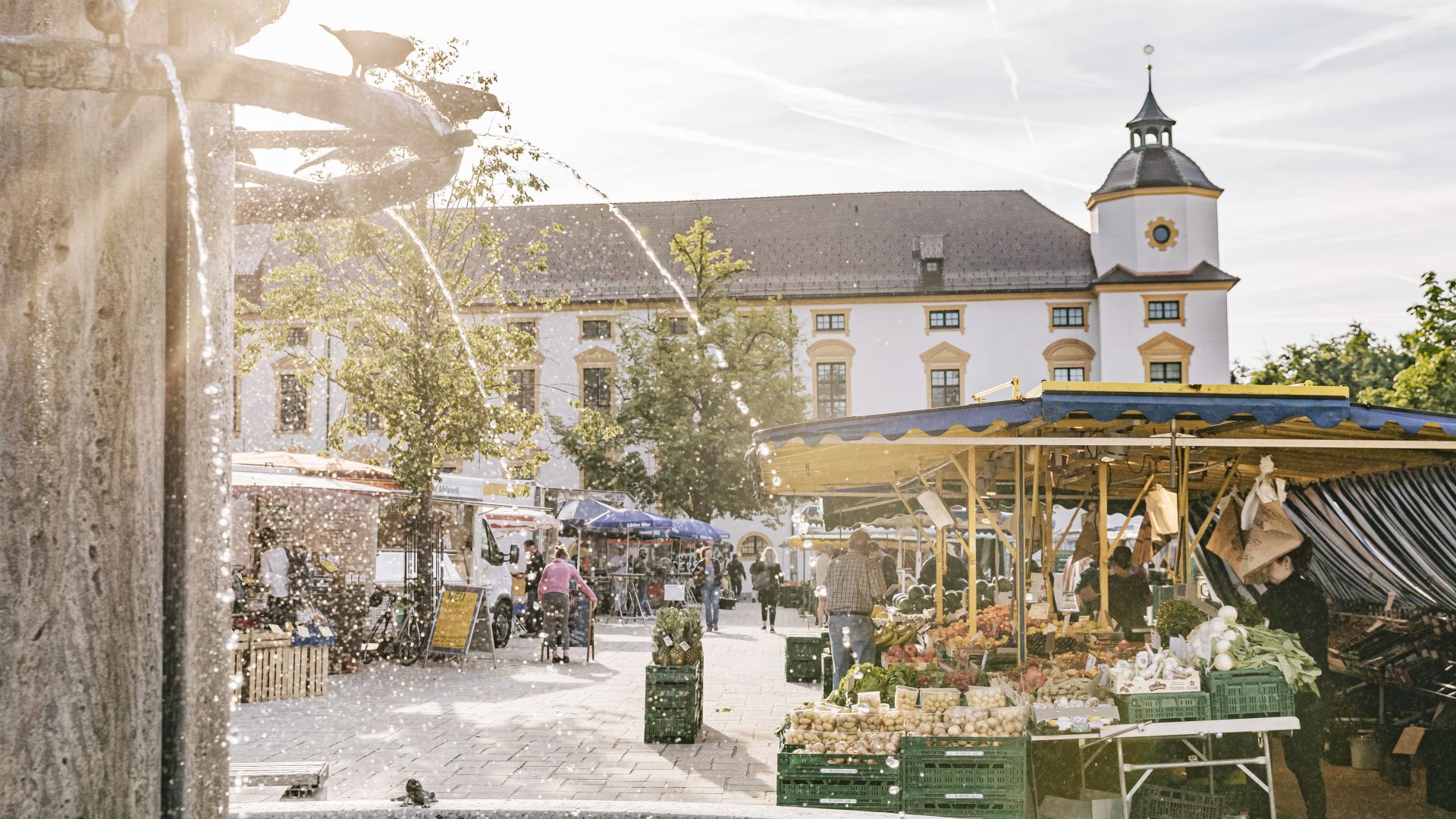
Travel through a fairy tale!
From the birthplace of the Brothers Grimm to the Town Musicians: on this route from Hanau to Bremen, you will travel over 600 kilometres through a fairy tale land, and there are some 90 charging stations available in Hanau, Kassel and Bremen, among other places. Experience medieval towns, enchanted castles, impressive natural beauty and UNESCO-recognised cultural sites – such as the Kellerwald-Edersee Nature Park . And then there is the Sababurg, from the 14th century – the home of Sleeping Beauty. Surrounded by all this magic, don't forget to recharge!
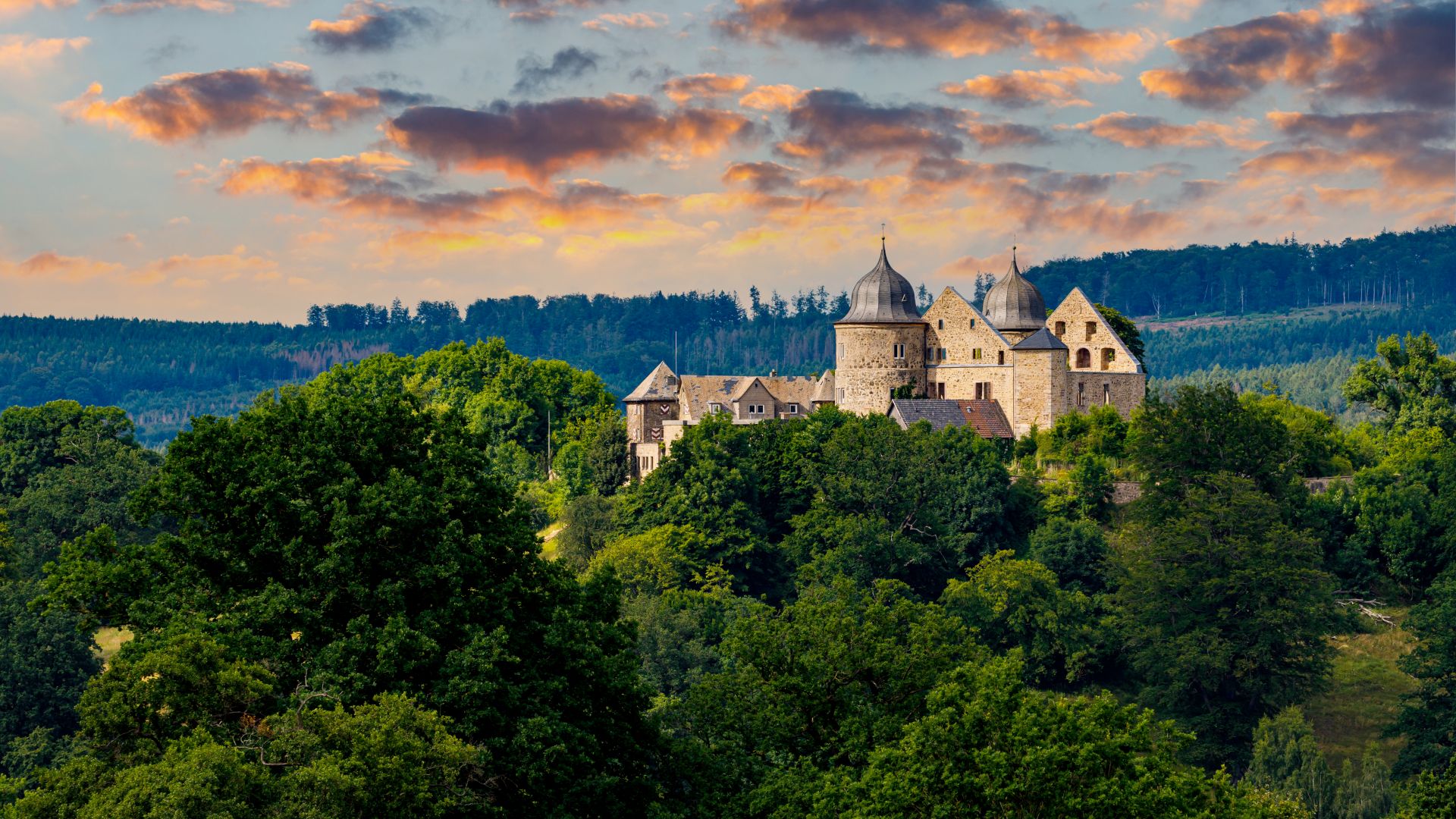
Sustainable travel on Borkum
They say that in East Frisia, time moves a little differently. In terms of sustainability and protecting the planet, however, the East Frisians are doing very well. Borkum is one of the few East Frisian islands where driving is permitted. Due to its modest size, the island is particularly well suited for a day trip by electric car. The island is the southernmost of the seven East Frisian islands.
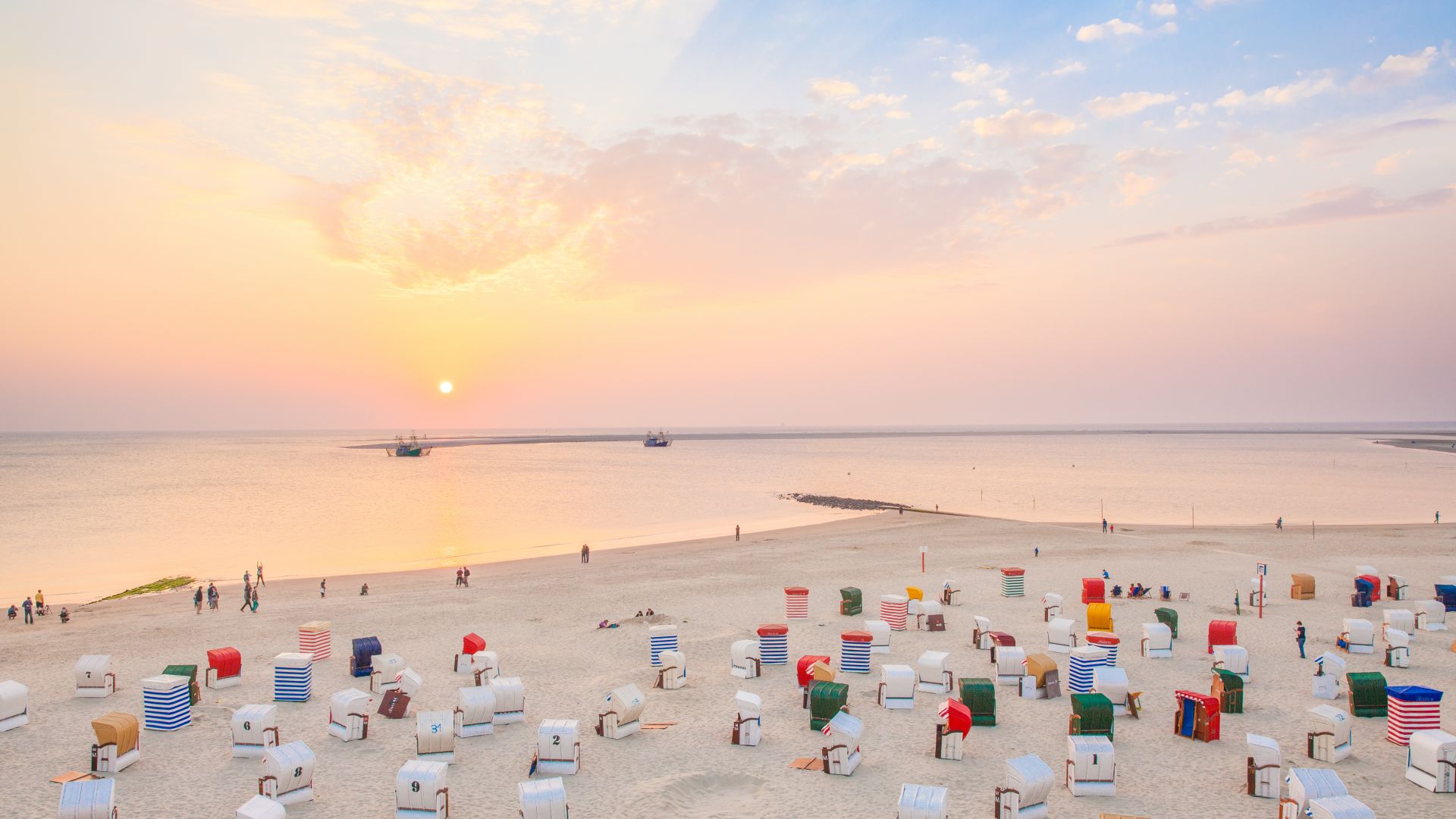
A round trip through the Harz Mountains
How about a round trip from Halberstadt ("The Gateway to the Harz Mountains") via Quedlinburg to Friedrichsbrunn, continuing via Sangerhausen and the South Harz Nature Park and then back north towards Quedlinburg – with the option to take a look round Wernigerode? The "Tour de Natur", completely free from carbon emissions and full of beautiful views. The Harz Mountains are always worth the journey.
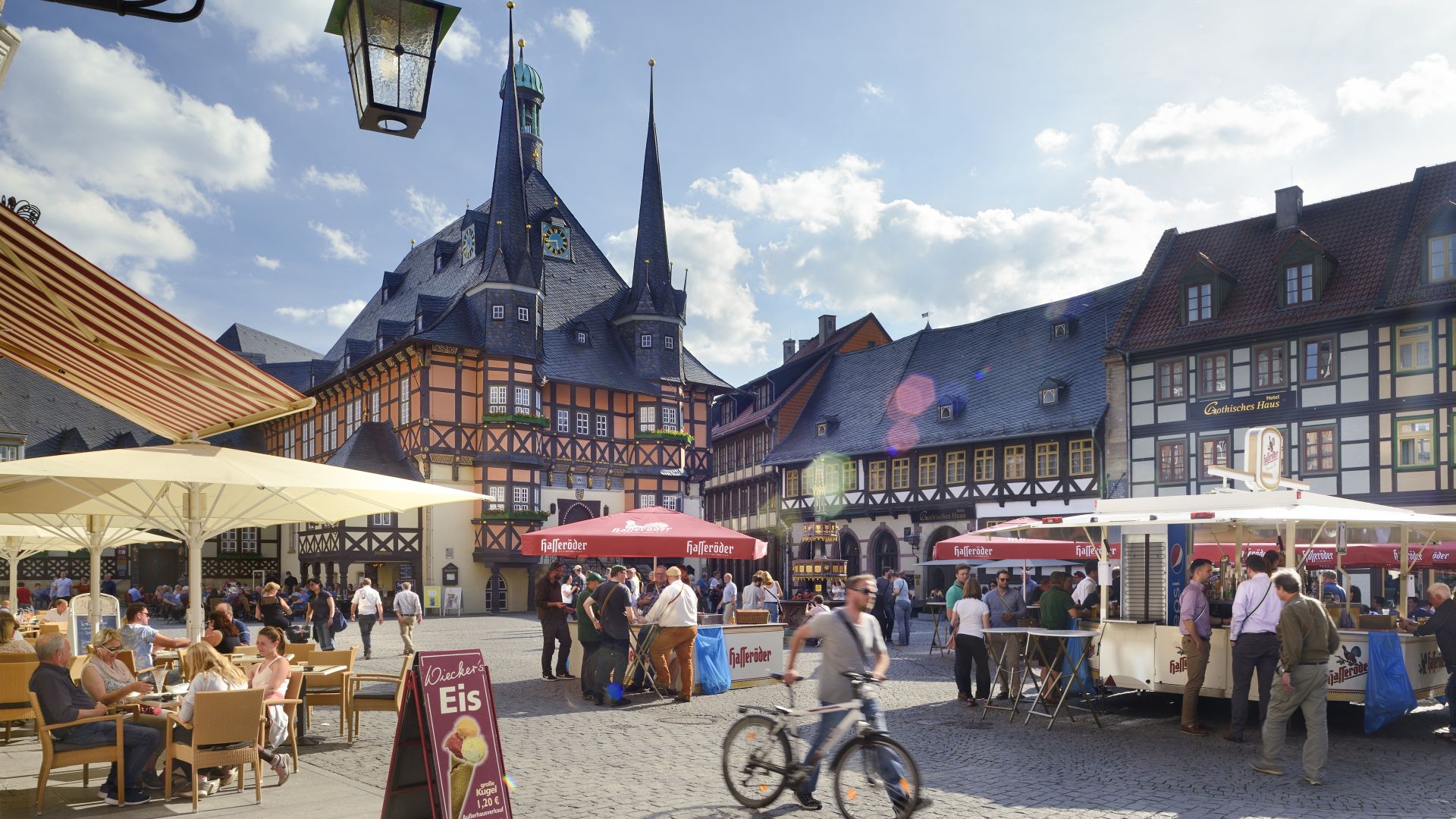
North Sea or Baltic Sea? Both!
Start your road trip by electric car in Husum at the North Sea , where there's a rapid-charging station. When you're fully charged, travel further north and plan the next charging stop in Flensburg: a town well worth an overnight stay. Continuing via Falshöft on the Baltic Sea , you can resume your journey southwards towards Kiel – another gem waiting to be discovered. This route combines the North Sea and the Baltic Sea, and provides sufficient charging stations along the way.
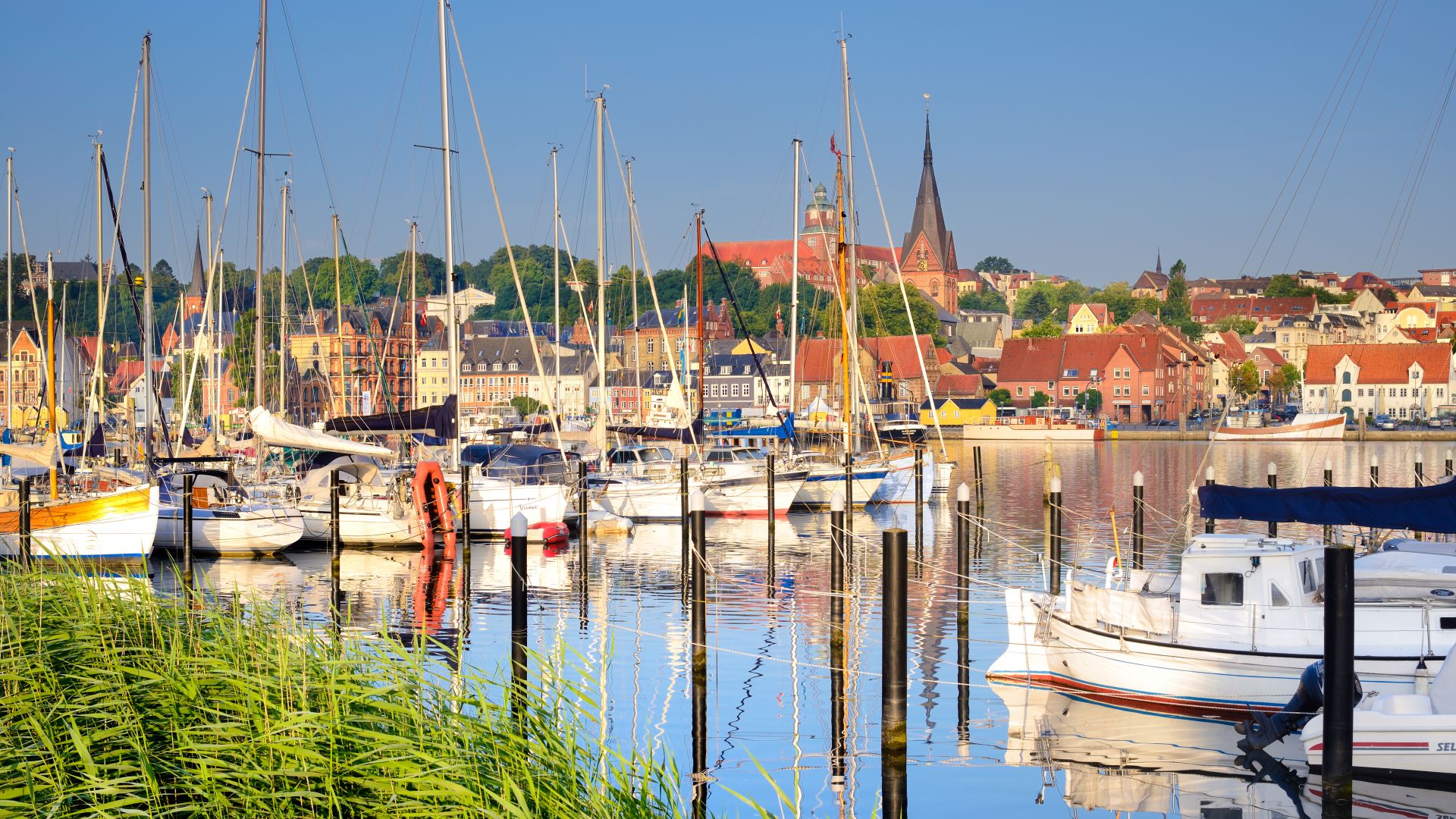
Oh, how beautiful the Rhine...
When you're ready to leave lively Cologne, drive off fully charged towards Mainz – staying right on the Rhine via Bonn and Koblenz, and past lots of beautiful little villages. You'll find plenty of charging stations along this route, and definitely good reasons to take a break "just because": you're travelling through an important wine-growing region in Germany and it is certainly worth pausing to do some wine tasting here or there, and forgetting about the electric car altogether for a night.
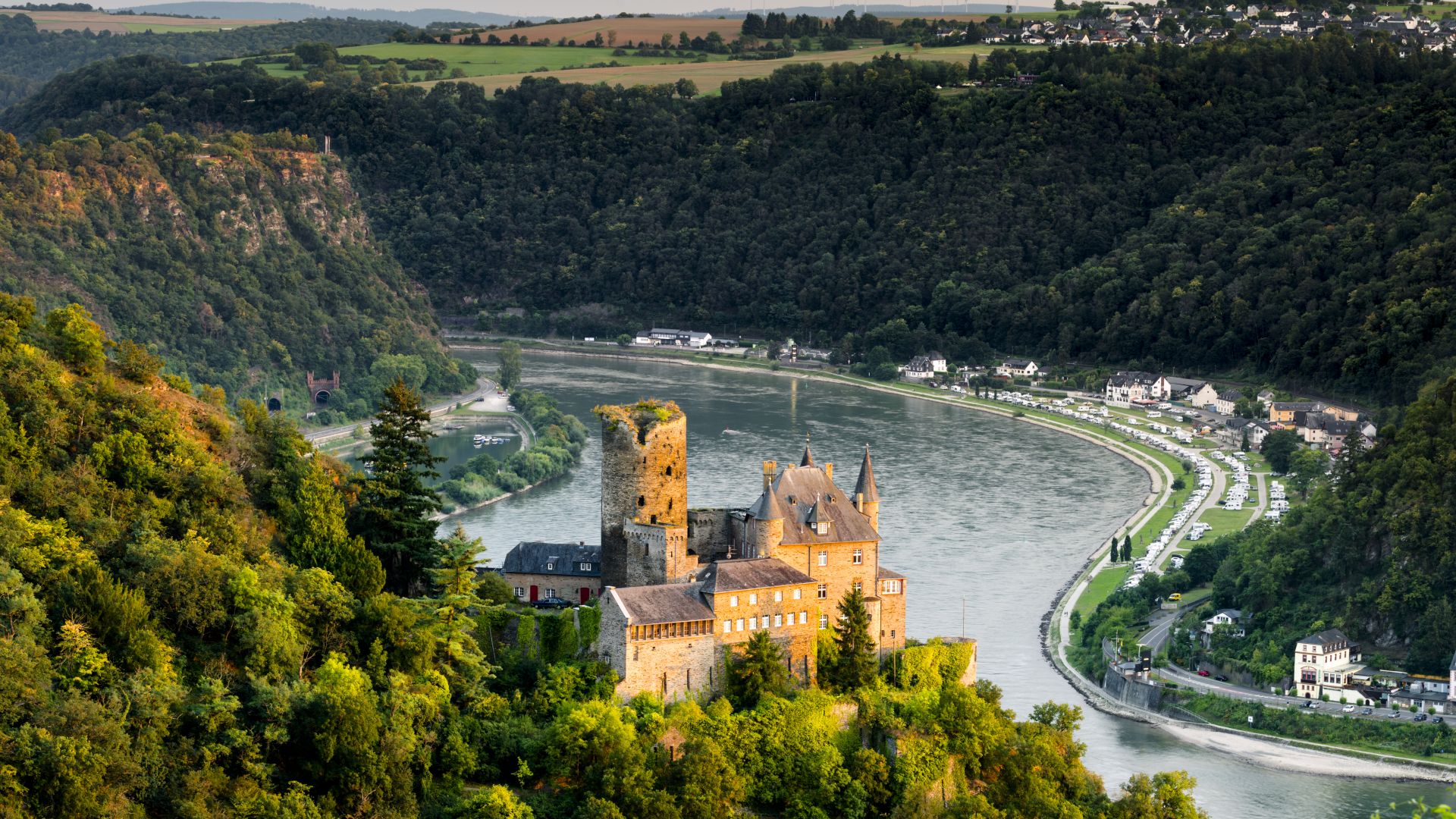
Discover more
In the footsteps of german poets, a round-the-world trip without leaving germany, creative and refreshing: the 'workation' travel trend, memorials to the national socialist and gdr eras: lest we forget, children are welcome: where the little ones take the main stage, old towns with unesco world heritage status.

Home » Destinations » Europe » Germany » 5-14 Day Germany Itinerary: A Guide For Planning Your Perfect Germany Trip
5-14 Day Germany Itinerary: A Guide For Planning Your Perfect Germany Trip
Links in this article may earn us a little money if you book/ order stuff. More here .
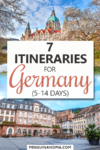
Plan Your Perfect Germany Itinerary with These Detailed Templates!
If you’re looking to plan the perfect trip around Germany, you are in luck! We’re passionate about exploring Germany because it’s a great country – and because Lisa is German!
Jokes aside, we’ve been lucky enough (and have made it a point) to see lots of different parts of the country – from the sea in the north to the mountains in the south. That said, Germany can be a tough country to plan a route or road trip through because there is just so much to see and do!
So, whether you’re looking for the best week in Germany or a Germany itinerary that covers 5 days or 14 days – here’s our master guide with 7 detailed Germany itineraries by train and/or by car! We’ve got cities, attractions, hotels and accommodations, directions, and distances to help you plan the best Germany travel route for you!
We’ve got other great posts to help you plan a visit to Germany:
- Must-Knows + Tips for Travelling to Germany for the First Time
- Helpful German Phrases to Get You By
- Discover 30 Beautiful Places in Germany
- Our Top Hostels in Germany (Stayed at all of them)
Table of Contents
Things to Consider When Travelling in Germany
Before you plan your trip to Germany, there are some things that you should know and keep in mind to make planning easier and to have a successful trip. While you probably know that the currency used in Germany is the Euro, here are some other topics that you should consider as well.
Best Time of Year to Visit Germany
Germany is actually a destination that you can visit year round – but it is important to plan accordingly and go in with the right expectations. If you’re planning a trip during the spring – let’s say from March to May – you could absolutely have beautiful weather… but it may also just rain a lot.
Unfortunately, the weather can be quite difficult to predict. However, as long as you prepare for different possibilities, you can have a great time no matter the weather! Generally you can say that Germany has a moderate climate with cool and rainy winters (more snowy the farther south you get) and warm – but not overly hot – summers.
July and August are usually the warmest months with an average temperature around 20°C. However, there can be days where you have 30°C. Of course, this can vary depending on the exact location you’re travelling to. Often, it is colder by the north coast than it is farther south.
We would honestly recommend that you avoid visiting the country in July if you dislike crowds since this is when the majority of kids are on their summer break from school. As a result, some cities can get quite busy.
Typically, we would recommend travelling in May or June and then from the end of August until the end of September (or even the middle of October). However, there is also a great reason to plan a Germany trip during the winter because of the many beautiful Christmas markets that you could visit at that time of year!
Public Transportation in Germany
Public transportation in Germany is quite good, especially when compared to North America. Yes, sometimes us Germans like to complain about the “Deutsche Bahn” – the German train company – but at the same time we are also super glad that it exists and works well.
If you’re wondering: Yes, all the itineraries mentioned below can absolutely be done if you want to take the train (minus the odd day trip to a castle here and there). If you want to check a train connection and/or buy tickets in advance you can do so on the DB Website . Alternatively, you can also download the DB app to your phone. We both have it and use it regularly.
As an alternative to the train, you can sometimes also use the bus to get from one city/town to another. Since 2013 (before this date it wasn’t allowed), long distance buses have established their presence in more and more cities and are now a popular way to get around for people who are more conscious of their money.
Unfortunately long distance train tickets can sometimes get quite expensive if you don’t book in advance – so the bus can be a good alternative in some cases.
The most popular long distance bus company in Germany is probably Flixbus. We have also used them multiple times to get between cities. If you want to look at the schedule and/or book a ticket, you can do so on their website .
In addition to the trains and long distance buses, the public transport within the cities is also usually pretty good – especially in bigger centres. Many of the cities – or transport associations – have their own transport apps. So, if you know where you are going and plan on using the local buses, trams, metros, etc. then downloading the local transport app would be a great idea!
Car Rental in Germany
If you want to rent a car and plan a Germany road trip, then that is certainly an option as well. Driving in Germany is generally pretty safe and people are not usually as reckless as in some countries in the south of Europe. However, it can get a little crazy in bigger cities like Berlin or Munich – especially if you are not used to driving in bigger centres.
In Germany, you drive on the right side as it is done in the United States, Canada, and many other countries as well. You have probably heard of the “Autobahn” – that’s simply the German name for our highway system. If you follow any of these itineraries, you’ll drive on many different highways.
While it is true that there is no speed limit in some parts of the Autobahn, there are lots of sections where there are actually speed limits in place. You can usually find limits imposed at/around construction zones along the way – so don’t think you can just speed all the time.
And PLEASE don’t drive on the Autobahn like you would on a highway in the United States or Canada – pass on the left and then get back over . If you’re going slower than other cars, there’s no need for you to be in the left (or even in the middle) lane. You can probably tell that this is something that Lisa complains about in Canada frequently, haha.
Since Germany is such a popular destination, there are lots of different rental car agencies to choose from. You can compare prices from different agencies for the duration of your trip with this handy rental car comparison tool . Please make sure to read the fine print so you know whether you need extra insurance, etc.
Also please be aware that many people in Germany drive cars with a stick shift. Rental cars with automatic transmissions exist, but the numbers available are usually lower and these cars might be slightly more expensive.
We’d also recommend that you reserve an automatic car well in advance if you need one – just so you can make sure that one is available for you. It probably wouldn’t be fun learning how to drive a stick shift while on a road trip in a foreign country.
Travel Insurance for Germany
If you’re planning a trip to Germany and you’re not from another EU country, then you should make sure to get travel insurance for the duration of your trip!
While you’ll probably be fine, accidents do happen and it could get really expensive if you’re not covered. That’s why we always travel with insurance.
If you live in another EU country and have health insurance there, you can get the blue health insurance card with which you are covered in other EU countries in emergency cases, as well.
If you don’t have that option – or are from outside of Europe – we recommend that you get private travel insurance.
Germany Itinerary 5 Days
If you only have a few days to travel through Germany, then have a look below at the two 5-day itineraries we have created. For these itineraries, we have assumed that you are not already in the country so they all start and end in bigger cities.
This should help make it easier for you to fly in/out of an airport with good connections if you are coming from overseas.
Depending on your preferences, you can choose between a trip through the northern part of Germany or a trip through the south of the country (mainly Bavaria). If you are interested in bigger cities and/or harbours, then we’d recommend the northern route.
In case you prefer half-timbered houses and beautiful old towns, then you should have a look at the southern route instead. Of course, you can always modify any itinerary to better suit your interests!
Germany Itinerary 5 Days – North
This 5-day Germany itinerary through the northern part of the country can certainly be considered a “sampler-type” of itinerary since you get to see the two biggest cities in the country – but not much more than that.
That’s completely fine though – you can only see so much in five days anyway. If you are interested in bigger cities and don’t have more than a few days, then this itinerary would be great for you!
The total driving time for this itinerary would be about 5 hours 30 minutes with a total distance of approx. 520 km. Of course, this can change depending on the route you are taking and the time of day you are travelling. Commuter traffic could add quite a bit of travel time to your journey.
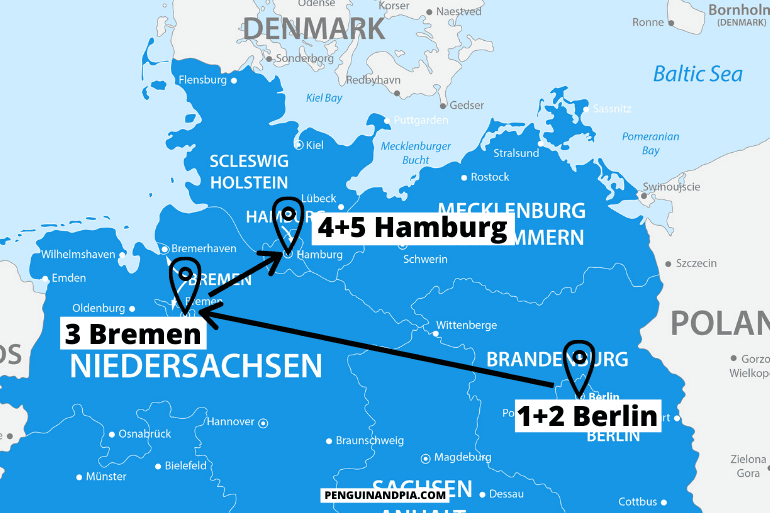
Day 1+2: Berlin Day 3: Bremen Day 4+5: Hamburg
Day 1+2: Berlin
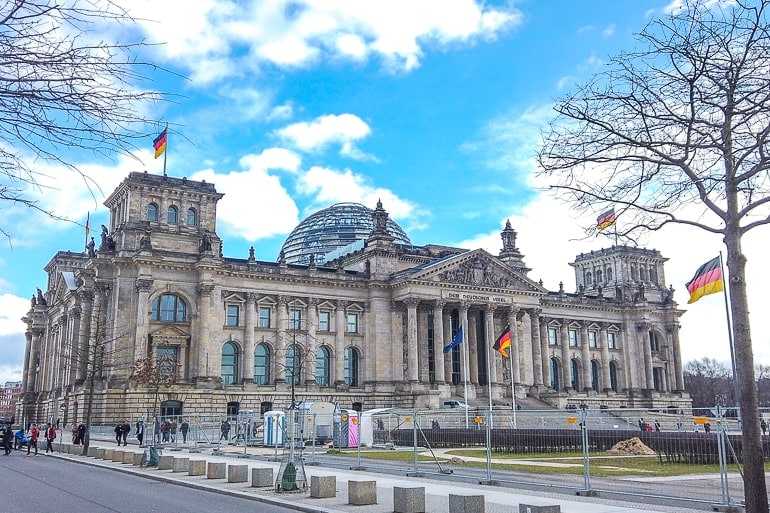
Berlin is a great place to start your adventure since it is the German capital, has multiple airports close by, and has really good train connections.
Since Berlin is such a popular tourist and business city, the car rental industry is well established and there are many different rental agencies to choose from.
— Compare prices from rental car companies in Berlin here
However, since you are only visiting bigger cities on this relatively short itinerary, we believe that a rental car is probably not necessary. Instead, for this trip, it might make more sense to take the train.
Since Berlin is such a big city with lots of things to do, it is worth it to spend (at least) two days in the city. So, remember to book your accommodation in Berlin for two nights .
Accommodation in Berlin : Berlin is a massive sprawling city with loads of different areas to stay and different accommodation options. You can check here for accommodations and hotels in Berlin .
If you are travelling to Berlin with a car, you’ll need a place to park. Check out Park Plaza Wallstreet Berlin Mitte for a stay right in the middle of the city close to Museum Island and other top attractions. It also has a tasty breakfast. Park Plaza has free parking on the street near the hotel (if available) or else it’s for a fee (but a reasonable price considering you’re in the middle).
If you are arriving into Berlin by train, you can check out NH Collection Berlin Mitte am Checkpoint Charlie . Located in the city centre right near the top sight “Checkpoint Charlie”, this popular hotel is in the heart of the action/attractions and is easy to get to via modes of public transit (metro – called the “U” for U-bahn).
If you are searching for a hostel/hotel, check out PLUS Berlin . Located over near the East Side Gallery (the piece of the Berlin wall with the artwork on it), Eric stayed here and really liked it! It’s also very easy to get to using public transit and is close to other areas to go out, etc.
Must-see Attractions in Berlin:
- Brandenburg Gate
- East Side Gallery (Berlin Wall)
We have also written a whole article about classic tourist attractions in Berlin in case you’d like some more inspiration. If you’re looking for some tips on how you could spend a day in Berlin, have a look at our One Day in Berlin Guide .
Day 3: Bremen
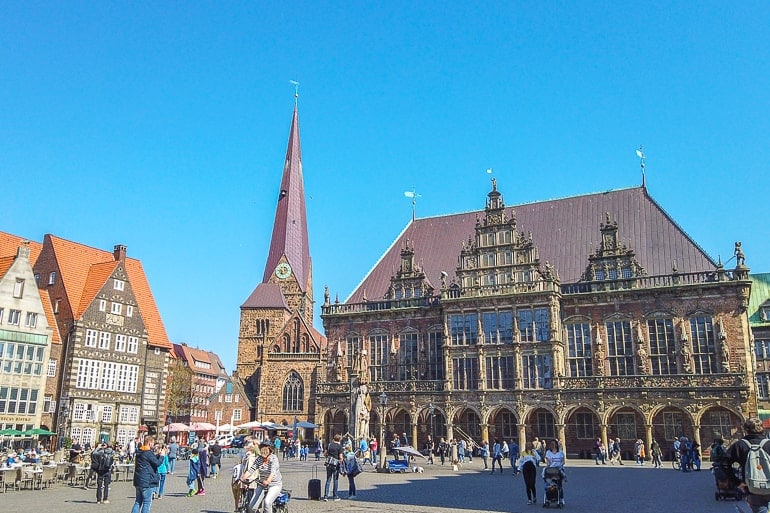
On the third day of your 5 days in Germany, you’ll head for Bremen. We’d recommend that you do the drive/train ride in the morning so you have enough time to explore the city once you get there.
Bremen is a hanseatic city with a nice old town – the market square with the town hall and the cathedral is especially popular. In German-speaking countries, the city is also known for a tale called the “Town Musicians of Bremen” by the Brothers Grimm. You’ll come across the animals of the tale (donkey, dog, cat, and rooster) many times as you stroll through the city.
The drive from Berlin to Bremen will take you approximately 4 hrs 10 min by car , but only around 3 hrs by train . If you take the train, try to book in advance if you can as this will usually save you some money.
Accommodation in Bremen: Bremen is a popular city to explore and it’s also on the larger side so you’ll find plenty of accommodations to suit your needs. There are hotels in the city centre/old town which put you within walking distance of the river and top attractions. You can check here for accommodations and hotels in Bremen .
For a popular choice in the historic middle, you should check out the very popular Radisson Blu Hotel Bremen . Funny story – we know there’s underground parking because we parked there when we visited Bremen by car.
If you want to stay closer to the train station just outside the historic centre (but still very central), check out the Dorint City-Hotel Bremen . This lovely and also very popular hotel is close to the pretty Windmill and flower gardens and has water views just outside the old city walls.
Must-see Attractions in Bremen:
- Marktplatz with Town Hall and Cathedral
- Böttcherstraße
- Schnoorviertel
If you want some more tips for Bremen, have a look at our detailed Things to do in Bremen Guide .
Day 4+5: Hamburg
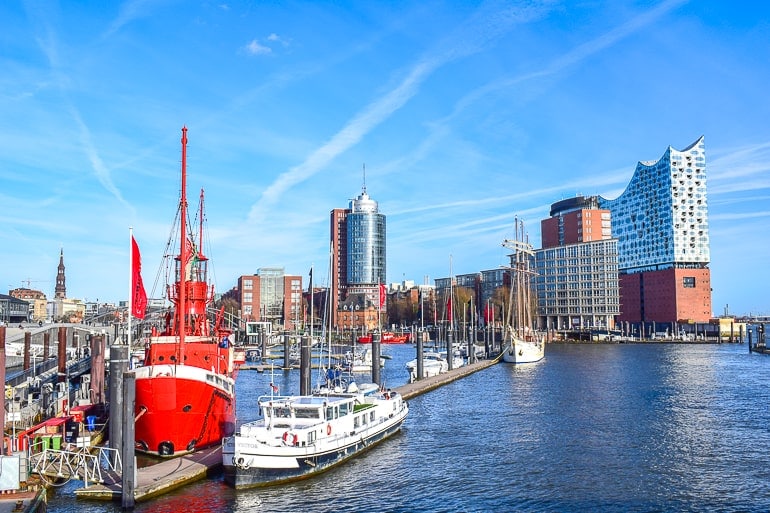
Hamburg is the second-biggest German city and the last stop on this short itinerary. We have been to Hamburg numerous times now and it is actually one of our favourite bigger German cities. You’ll find that the atmosphere of the city is very different than in Berlin. Not necessarily better or worse – just different.
Interesting (and slightly irrelevant) fact: The cities you visit on this itinerary are the three city states that exist in Germany in addition to the 13 area states such as Bavaria, Nordrhine-Westphalia etc.
The drive from Bremen to Hamburg is actually pretty simple and should only take around 1 hour 30 minutes by car and just around 1 hour if you take an ICE (fast train) . The train connection between these two cities is great with trains running pretty frequently. That should make it quite easy to find a train connection that works for your schedule.
Accommodation in Hamburg : Hamburg is popular city with loads of different accommodations and areas to stay in. You can check here for accommodations and hotels in Hamburg .
If you are travelling to Hamburg with a car, you might want to check out the Mövenpick Hotel Hamburg . Located in an old water tower, this unique hotel has a number of cool features with stunning views and parking onsite. It’s very popular – and also close to public transit for getting around!
If you are travelling to Hamburg by train, ARCOTEL Rubin Hamburg is a great hotel option for you to check out. Located in the cool area of St. Georg, you can easily walk to the hotel from the train station. It’s also walkable to other parts of the city centre and other attractions.
If you are looking for a hostel in Hamburg, you might want to check out Generator Hamburg as a reliable and popular hostel stay close to central station and the heart of the city.
If you want more details about accommodations in the city, we have a more detailed guide on where to stay in Hamburg .
Must-see Attractions in Hamburg:
- Speicherstadt
- Elbphilharmonie
- St. Pauli Piers
As one of our first ever articles on Penguin and Pia, we actually wrote a short Hamburg Guide . Have a look if you want some more Hamburg inspiration. Unfortunately it’s not nearly as detailed as our newer article – looks like it’s time for an update!
Germany Itinerary 5 Days – South
If you would like to explore the southern part of Germany instead of the north, then we would recommend the following 5 days Southern Germany itinerary. Compared to the northern itinerary, this trip includes stops in some smaller towns and cities. So, if you are interested in seeing some places of various sizes, beautiful old towns, and maybe a castle, then this might be a good itinerary for you.
The driving distance of this trip is just around 680 kilometres with a total driving time of approx. 7 hours . Depending on your mode of transportation, this can – of course – vary slightly.
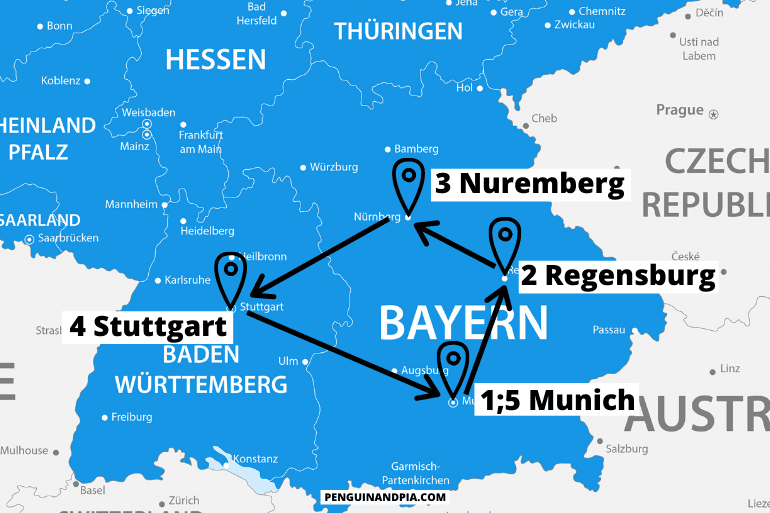
Day 1: Munich Day 2: Regensburg Day 3: Nuremberg Day 4: Stuttgart Day 5: Munich
Day 1: Munich

We are starting (and ending) this itinerary in Munich since it is an easy airport to fly in and out of from other parts of the world. If you are coming from another part of Europe by train, the connections to Munich are also usually pretty good.
Munich is the third-biggest German city and a very popular tourist destination. International travellers often mainly know the city because of the Oktoberfest which happens every year from the middle of September until October.
However, there is so much more to do and see in Munich than just the “Wiesn” (as the Oktoberfest is sometimes called as well). We are always happy to return to Munich because there is just so much to explore.
If you are thinking about renting a car for this itinerary, then you’ll be happy to know that it is quite easy to get a rental car in Munich. You can either pick it up directly at the airport after you land (if you arrive by plane) or in the city centre before you head to the next stop on this journey.
— Compare prices from rental car companies in Munich here
Accommodation in Munich: Munich is very large and popular city so finding a place to stay is no problem. The issue becomes that there are too many places to choose from! That said, you can check here for accommodations and hotels in Munich .
Specifically, we stayed at the very popular H2 Hotel München Olympiapark and we would highly recommend it for the value for money. The hotel has nice, cozy rooms, a super great breakfast buffet, and has a metro station steps from the front entrance to take you to the city centre.
There’s also onsite parking which makes this hotel perfect if you are travelling to Munich by car. The famous Olympic Park and BMW Museum are close by, too!
If you want to stay a little more in the city centre, then check out the Platzl Hotel Superior . This trendy hotel is in the heart of the Old Town just steps from top attractions like Marienplatz and the famous Hofbräuhaus. It’s also easy to get to the central train station either walking or on the metro.
If you are looking for more details on accommodations in this massive city, we wrote a detailed guide on where to stay in Munich .
Must-see Attractions in Munich:
- Marienplatz with New Town Hall
- Olympic Park
- Victuals Market
- English Garden
We also have a great little guide on how to spend one day in Munich if you want more details.
Day 2: Regensburg
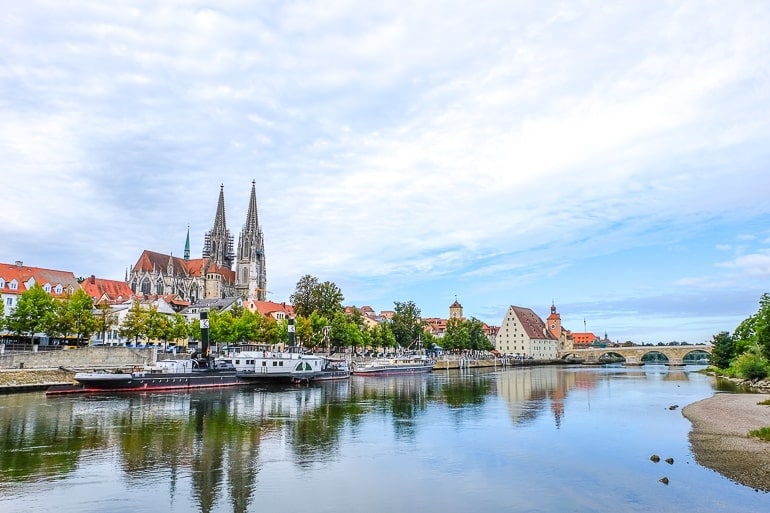
On day two of your trip you’ll be on your way to Regensburg, a small city in Bavaria on the Danube river. Due to its location by the river, Regensburg is a popular stop for people on a river cruise. So don’t be surprised if you see many different tour groups in the Old Town.
We recently spent a couple of days in Regensburg to get to know the city better and enjoyed our time there. One of the highlights is the Old Stone Bridge in the city centre which was built in the 12th century. We actually filmed a small YouTube video in Regensburg – which you can watch here if you are curious about what the city looks like.
The journey from Munich to Regensburg takes approximately 1 hr 20 minutes by car and around 1 hr 30 minutes by train . If you decide to travel by train – and especially if you are travelling with other people – we would recommend that travel with a “Bayernticket” (Bavaria Ticket). This ticket for train travel within the state of Bavaria usually allows you to save some money compared to regular prices.
Accommodation in Regensburg: If you are staying a night in Regensburg, you’ll have a number of great accommodations to choose from. To get started, you can check here for accommodations and hotels in Regensburg .
When we visited the city, we stayed at the Holiday Inn Express – Regensburg and really liked it. It’s a newer hotel and it really shows. The breakfast was excellent and there is even an onsite parking garage if you are travelling with a car. It’s not in the Old Town or near the river – but we did walk there one day and it only took about 15 minutes.
If you are travelling by train and you are on-foot, then check out the Altstadthotel Am Pach . This simple hotel is located right in the heart of the old town so you’re close to everything there is to see and do in Regensburg – including the beautiful Danube River. They also have breakfast included.
Must-see Attractions in Regensburg:
- Old Stone Bridge
- St Peter Cathedral
We are currently still working on our Regensburg Guide – but we’ll link it here once it is published.
Day 3: Nuremberg
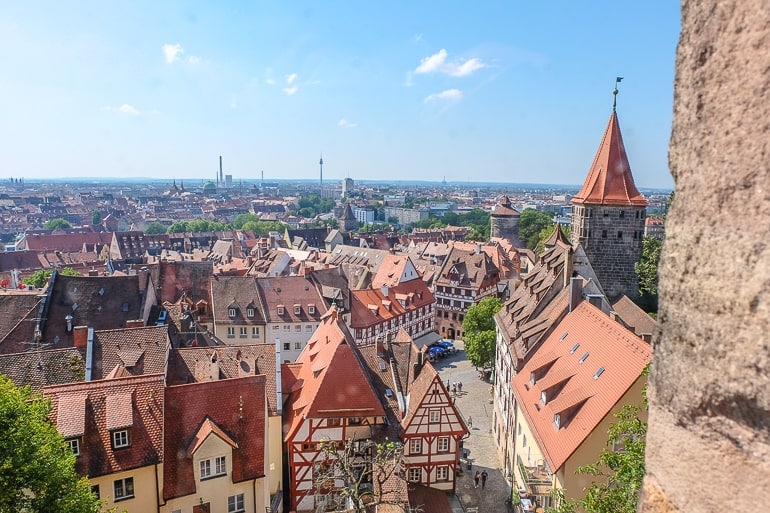
On the third day of this 5 day Southern Germany itinerary you’ll drive – or take the train – from Regensburg to Nuremberg. Nuremberg is a medium sized city in a part of Bavaria called Franconia. If you pay attention, you might notice that the dialect spoken here is quite different from that spoken in Munich and other places farther south.
Lisa actually grew up in this part of Germany so she has been to Nuremberg many, many times. Last year we also went to explore the city together and had a great time. Travellers from abroad mainly know the city for the Nuremberg Trials which took place there after World War II. You can certainly learn alot of history in this German city!
Since Nuremberg is quite close to Regensburg the drive won’t be long – giving you slightly more time to explore the city.
The journey takes approximately 1 hour 10 minutes by car and between 1-2 hours by train depending on which train you take (some stop more often than others). Once again, a regional ticket – such as the Bavaria Ticket – will probably save you some money if you travel with more people.
Accommodation in Nuremberg : Since Nuremberg is a very popular city to visit in Germany, there are many, many places to stay scattered throughout the city centre and around it. You can check here for accommodations and hotels in Nuremberg .
When we visited, we stayed at Five Reasons Hotel and Hostel and we really liked it. Located just inside the medieval city walls, we were really close to the train station and yet also steps from top attractions like the Germanisches Nationalmuseum. The place was bright and great value for the price which we liked a lot.
Close to Five Reasons, we had friends stay at the Sheraton Carlton Nuremberg and they loved it. We actually saw it with our own eyes – it had a pool with views of the city among other perks. There’s also a parking lot right across from the hotel if you’re coming to Nuremberg by car. It’s walking distance to the old centre and the central train station so best of all worlds!
Must-see Attractions in Nuremberg:
- Imperial Castle of Nuremberg (Kaiserburg)
- Documentation Center + Nazi Party Rally Grounds
- Albrecht Dürer’s House
As is the case with Regensburg, we are also still working on our article for Nuremberg. Once it’s live, we’ll link it here.
Day 4: Stuttgart
Stuttgart is the capital of the German state called Baden-Württemberg and the only place on this itinerary that is not located in Bavaria. The city is mainly known for being a “car hub” since both Mercedes-Benz and Porsche have their headquarters there. There are also museums dedicated to both car brands.
Stuttgart is a bit smaller than Munich but there is still a lot to see. In fact, one day won’t be enough to see the whole city – but it’ll allow you to get a good first impression. Next to the car museums, you could visit some of the many green spaces and/or old buildings that the city has to offer.
Driving from Nuremberg to Stuttgart by car will take you approximately 2 hours 15 minutes. If you have the time, you could even take a small detour and stop in Rothenburg ob der Tauber, known for its picturesque Old Town.
By train , the journey from Nuremberg to Stuttgart will take between 2 hrs 10 minutes and 2 hrs 30 minutes – depending on the type of train you are taking. Try to book your ticket in advance if possible as this can save you some money.
Accommodation in Stuttgart: There are many places to stay in Stuttgart – especially in the city centre. You can check here for accommodations and hotels in Stuttgart .
If you’re travelling to Stuttgart with a car, check out the Abalon Hotel ideal . Located very much in the city centre, this popular hotel has an underground parking garage and offers a good breakfast selection.
If you’re travelling to Stuttgart by train, you can check out the Pension am Heusteig . This guesthouse-style accommodation doesn’t have parking but offers a great breakfast and is a doable walk or metro ride from the train station. Funny enough, these two accommodations are very close to one another!
Must-see Attractions in Stuttgart:
- Schlossplatz
- Mercedes-Benz Museum
- Staatsgalerie Stuttgart
Day 5: Munich
On the last day of your trip you’ll make your way back to Munich since it is usually easier to leave Germany through the Munich airport than smaller airports in the surrounding area.
However, if you don’t have to get to an airport – and/or are taking the train home – you could also stay an extra night in Stuttgart if you wanted. Both cities are worth spending an extra few hours in – so you really just have to see what works best for you.
If you decide to get back to Munich, then the journey from Stuttgart to Munich will take approximately 2 hours 20 minutes by car and just slightly less (2 hrs 15 minutes) by train .
Accommodation in Munich : We already went over accommodations in Munich in Day 1 of this itinerary. So, you can head back up for the full details – but we would highly, highly recommend the H2 Hotel München Olympiapark as great value for money with great breakfast, parking, and a metro stop outside the front door.
Don’t forget we also have our detailed guide on where to stay in Munich if you want to have a deeper look at accommodations in the city.
We also have a post on spending one day in Munich if you want more details about the city!
Germany Itinerary 7 Days
If you have slightly more time to explore Germany, we have also created two 7 day Germany itineraries for you. Similar to the 5 day itineraries, we made two different itineraries since it’s pretty much impossible to see the whole country in just a week.
Instead of a northern and southern itinerary, this time we have focused on the western and eastern parts of the country. But please don’t read too much into that description – we use the terms quite loosely. As always, you’re welcome to modify any part of the itinerary to make it better fit your schedule/interests.
Germany Travel Itinerary 7 Days – West
For this itinerary, the total driving time would be around 14 – 15 hours and the distance would be slightly over 1100 km . For these calculations, we included the day trip to Monschau (and back to Cologne) as well as the day trip to Freiburg im Breisgau (and back to Stuttgart), which would be a longer day trip anyway.
So, depending on which day trips you decide to add on to (or remove from) this itinerary, your driving time and distance could be noticeably different than the estimates given above!
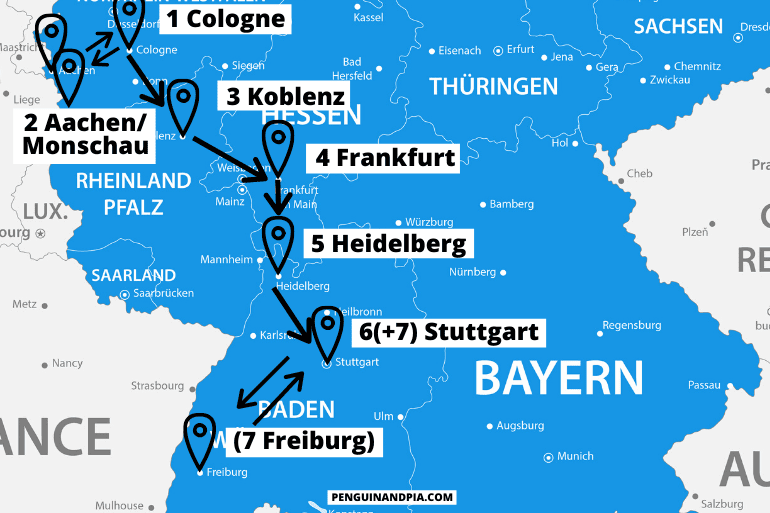
Day 1: Cologne Day 2: Day Trip to Monschau/Aachen Day 3: Koblenz Day 4: Frankfurt Day 5: Heidelberg Day 6: Stuttgart Day 7: Stuttgart / Day Trip to Freiburg im Breisgau
Day 1: Cologne
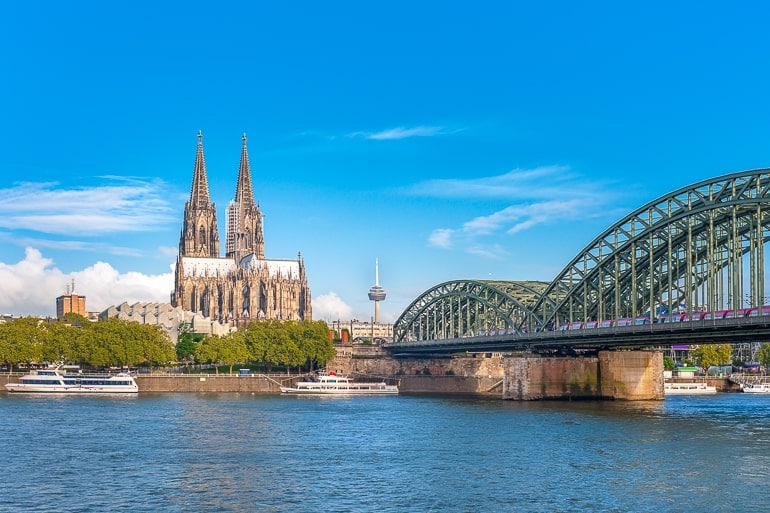
As we have already explained above, we like to start these itineraries in bigger cities to make it easier for people from overseas to get to Germany and start their adventure without hassle. Cologne is Germany’s fourth-biggest city (by population) and has two pretty good airports (Airport “Köln Bonn” and Airport “Düsseldorf”) close by for those coming from far away.
If you want to rent a car for this itinerary, it should be pretty easy to get one in Cologne since it’s quite an international city with lots of visitors.
— Compare prices from rental car companies in Cologne here
Cologne is a pretty spread-out city so you won’t be able to see the whole city in a day or two. However, the highlight of the city is certainly the Cologne Cathedral which is located right next to the central station and the Rhine River.
Make sure to plan some time to visit this impressive building – we always spend much longer in there than we originally plan. It’s free to enter so it can get very crowded depending on the day and time you’re visiting.
Accommodation in Cologne : Cologne is a very big city with multiple areas to stay in. As such, there are lots of accommodation options across the city. Wherever you book, remember to book your accommodation for two nights since you will go on a day trip and then return to Cologne on the second day. You can check here for accommodations and hotels in Cologne .
We have stayed in the Lindner Hotel City Plaza and loved it. The floors all have themes (we got Cologne Zoo with animals), the breakfast buffet is absolutely fantastic, and it’s a short walk to the Cathedral along one main street. There’s also parking available at/near the hotel for those with a car.
If you want to stay more in the heart of the city centre, check out something like the CityClass Hotel Residence am Dom . It’s popular, centrally located with shops and restaurants around, and only a short walk to the train station.
If you are looking for a hostel in Cologne, Eric once stayed at Cologne Downtown Hostel and it was honestly excellent. There’s a grocery store right below it and it’s located in the city centre. It also has a large balcony to enjoy the sunshine from!
Must-see Attractions in Cologne:
- Cologne Cathedral
- Cologne Chocolate Museum
Day 2: Day Trip to Monschau/Aachen
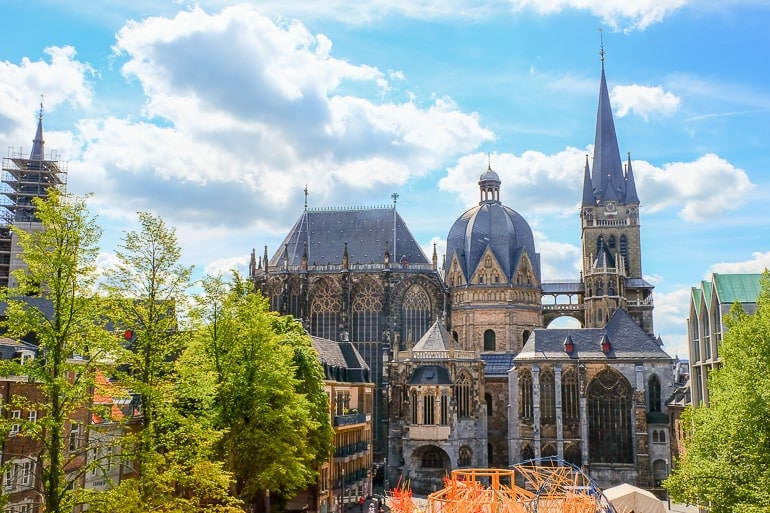
On the second day of this Germany itinerary, you have a few different option: you can either spend another day in Cologne if you feel like you haven’t seen enough of the city yet or take a day trip to Monschau or Aachen. Both of these are two places not too far from Cologne.
Monschau is a popular day trip in the area mainly because of its picturesque buildings in the old town. In fact, you probably have already seen photos of it on social media. To get to Monschau from Cologne, you can either drive or take a combination of trains and buses.
Getting to Monschau takes around 1 hr 40 minutes by car and approx. 2 hours by public transport . To visit Monschau by public transport, you can take the regional train from Cologne to Aachen-Rothe Erde and then take Bus #66 from there to Monschau.
Must-see Attractions in Monschau:
- Monschau Castle
If you want to go on a day trip but don’t want to venture that far, then Aachen would be another great option. This city is actually Germany’s most western city very close to the borders of The Netherlands and Belgium.
We’ve lived close to Aachen for a while and have written a whole guide full of things to do in Aachen that you should read if you want more information. In our opinion, one day is the perfect amount of time to explore the city since it doesn’t have that many attractions and the old town in the city centre is quite compact (but still very pretty).
Getting from Cologne to Aachen is also very easy. It takes approx. 1 hr 20 minutes by car and just around 50 minutes by regional train . You should look into getting a “Schönes Tag Ticket NRW” for the day if you’re travelling with more people as this can save you some money.
Must-see Attractions in Aachen:
- Aachen Cathedral
- Elisenbrunnen
Day 3: Koblenz
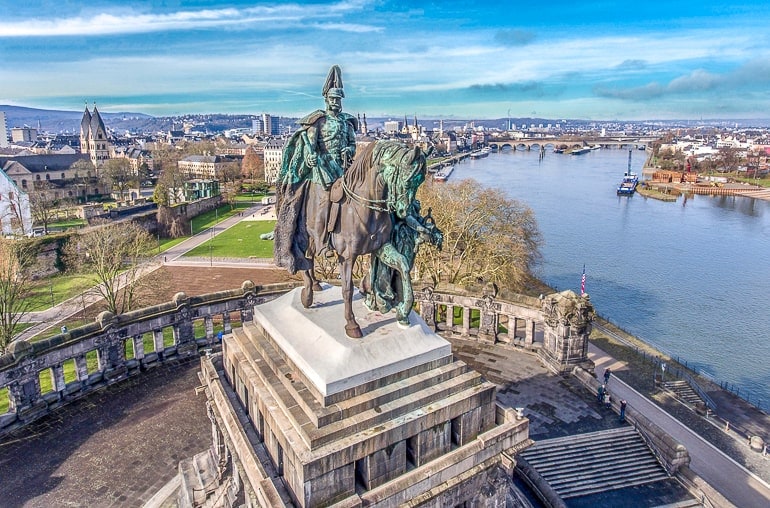
From Cologne, your journey continues to Koblenz – another city on the Rhine River. Koblenz is a smaller German city with a population of slightly over 110,000 inhabitants.
There are quite a few castles and nice hikes in the area which are easy to reach from Koblenz – just in case you decide that you don’t want to spend the day in the city. Depending on the time of year, you could also look into booking a boat tour on the Rhine river. This way, you get a unique perspective of the beautiful region.
Getting from Cologne to Koblenz is pretty easy and will take approximately 1 hour 30 minutes by car and between 50 minutes and 1 hr 10 minutes by train . We really like this train journey since the tracks follow the river for a majority of the trip. As a result, you get some really nice views – and might even spot some of the beautiful castles in the area!
Accommodation in Koblenz: Koblenz is certainly not a huge city – but you’ll still find a good number of places to stay for a night or two. You can check here for accommodations and hotels in Koblenz .
For a hotel right in the city centre, check out the Sander Hotel . This lovely hotel is super popular and close to shops and the rivers. If you are arriving to Koblenz by car, there is onsite parking at the hotel. However, since the city is smaller you can also easily reach the hotel by walking from the central train station.
Must-see Attractions in Koblenz:
- Deutsches Eck
- Ehrenbreitstein Fortress
- Koblenz Cable Car
Day 4: Frankfurt
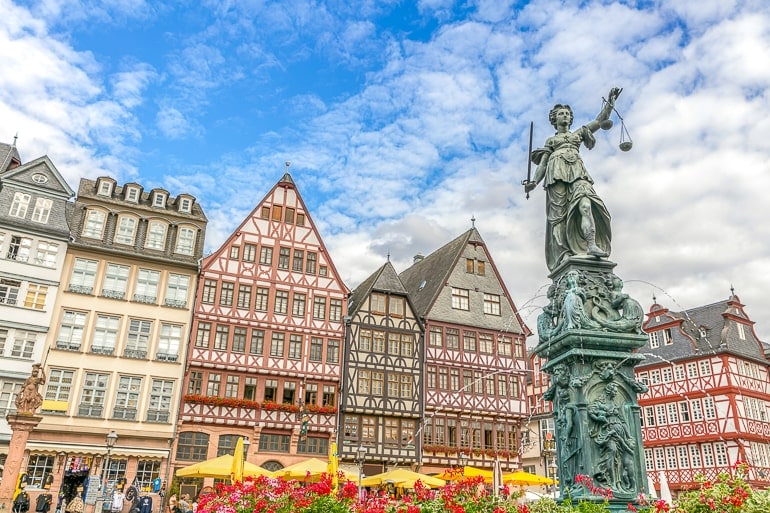
The next stop on your itinerary is Frankfurt, arguably one of the country’s most popular transport hubs due to the busy Frankfurt airport. Frankfurt is an interesting city that divided people: some people really enjoy it while other people don’t like it at all. To be fair, we haven’t spent enough time in the city to really solidify our opinion.
Either way, we do believe that Frankfurt is a stop that you shouldn’t miss if you are trying to get to know different areas of Germany. Known as the financial hub of Germany, this city with its many skyscrapers can feel quite a bit more modern than other German cities. However, the city also has a beautiful, historical market square that you should visit.
The journey from Koblenz to Frankfurt is another easy one – and if you are taking the train (we would recommend that!), you’ll once again follow the Rhine River for big parts of the journey and be rewarded with some great views.
The train ride will probably be between 1 hr 25 minutes and 2 hrs 12 minutes long – depending on the connection you choose. By car , the trip will take around 1 hr 30 minutes . Of course, this can vary depending on traffic.
Accommodation in Frankfurt : There are loads of places to stay in Frankfurt given its popularity and size. You can check here for accommodations and hotels in Frankfurt .
A great option in Frankfurt is the Motel One Frankfurt-Römer . Located very much in the heart of the city centre close to the old town and river, this cool hotel has underground parking if you are arriving to Frankfurt by/with a car. It also serves up a great breakfast!
If you are arriving by train to Frankfurt, you should check out Fleming’s Express Hotel Frankfurt . Located literally right beside the central station (which is in the city centre), this upscale hotel is very popular because it’s very affordable and also has a great breakfast.
Must-see Attractions in Frankfurt:
- Palmengarten
Day 5: Heidelberg
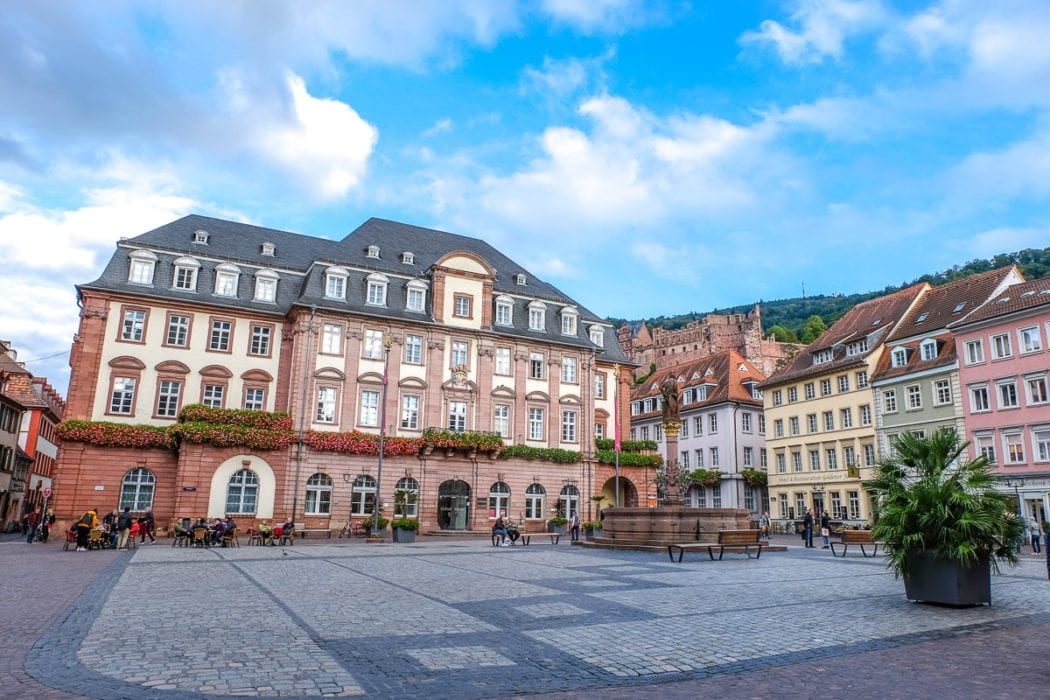
After your day in Frankfurt, you’re heading to Heidelberg which is actually one of our favourite German cities. The highlight of the city is certainly the castle on top of the hill which is visible from many different parts of the city.
Heidelberg is smaller than Frankfurt so you can see quite a bit in just 24 hours. The Old Town is beautiful and lots of attractions are located there. Our highlight was probably the tower climb of the Church of the Holy Spirit. From up there, you get a beautiful view of the Old Town. A very close second was the cable car ride up to the Königstuhl which was lots of fun – even in the rain.
Getting from Frankfurt to Heidelberg won’t take too long. The journey will be approximately one hour by car and between 45 minutes and 1 hr 30 minutes by train – depending on which type of train you are taking.
Accommodation in Heidelberg: If you’re heading for Heidelberg (good choice), there are lots of great places to stay. You can check here for hotels and accommodations in Heidelberg .
We stayed a little outside the old town – but close to the train station – at NinetyNine Heidelberg City . This hotel was really, really great. The beds were comfy and the decor has animals everywhere – you have to see it to understand!
There’s onsite parking (paid) and street parking (free, but not guaranteed) if you are travelling with a car. There’s also a tram stop right outside the hotel to get directly into the city centre in minutes.
If you are looking to stay in the historic old town, then check out colourful hotels like Hotel Holländer Hof which overlooks the river or Hotel Zum Ritter St.Georg which is literally overlooking the main Marktplatz.
Must-see Attractions in Heidelberg:
- Heidelberg Palace
- Church of the Holy Spirit (mainly tower climb)
If you want to learn some more about Heidelberg and what there is to do, you can read our detailed Heidelberg Guide here .
Day 6: Stuttgart
The next day you will drive to Stuttgart, a city that we’ve already mentioned in one of our Germany itineraries for 5 days. As we have already mentioned, you’ll probably really enjoy Stuttgart if you are interested in cars.
Even if you aren’t, there is still lots for you to explore. Did you know that wine also plays a huge role in Stuttgart and the surrounding region? If this is something that interests you and you’re there in the summer (specifically around the end of August), then you should stop by the “Stuttgarter Weindorf” (“wine village”) – but obviously, please don’t drink and drive.
As for getting from Heidelberg to Stuttgart, the journey will take you approximately 1 hr 20 minutes by car and between 40 minutes and 1 hr 30 minutes by train . As mentioned before, the time differs depending on the type of train you are choosing.
Accommodation in Stuttgart: Stuttgart has many places to stay so you can check here for accommodations and hotels in Stuttgart .
Be sure to see the Abalon Hotel ideal if you have a car. This hotel has underground parking available and a tasty breakfast. It’s also in the city centre which makes sightseeing easy.
Those coming to Stuttgart by train should look at the Pension am Heusteig . It’s a guesthouse that is located not too far from the first hotel here and it’s a doable walk or metro ride from the central station.
Day 7: Stuttgart / Day Trip to Freiburg im Breisgau
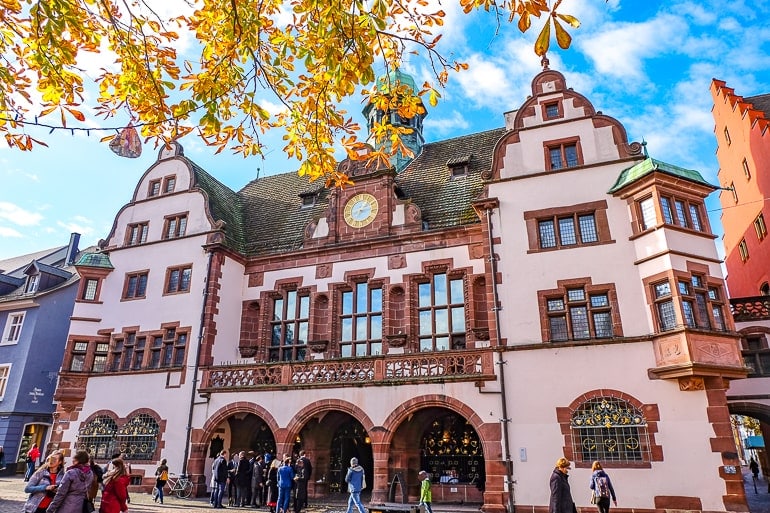
For this itinerary, you can decide how you would like to spend your last day. You could either spend another day to explore more of Stuttgart (and maybe relax for a bit) or you could head farther south and spend a day in Freiburg im Breisgau. We really enjoyed spending time in this small city in the south of Germany during our visit.
We are currently still in the process of writing our Freiburg guide, but we’ll link it here once it’s done. However, a good way to start your exploration of the city is by wandering the old town.
In Freiburg, you’ll find that many of the cobblestoney streets have small water-filled runnels – called Bächle – running alongside it. Sometimes they even have small yellow ducks in them!
The journey from Stuttgart to Freiburg im Breisgau is slightly longer than most other parts of this itinerary. It takes approximately 2 hrs 30 minutes by car and around 2 hours by train . Since this train journey will probably include at least one ICE (the fast train), we’d recommend that you book your train tickets early if you can to save some money.
Must-see Attractions in Freiburg:
- Freiburger Münster (Cathedral)
- Schlossberg + Tower
- New + Old Town Hall
Germany Travel Itinerary 7 Days – East
If the other week-long Germany itinerary doesn’t interest you and/or you really want to visit the German capital Berlin, then you might prefer this eastern route instead.
The driving time would be just slightly over 10 hours and would be approximately 900 km driving distance – including the day trip to Potsdam (which would honestly be easier with public transport, though)!
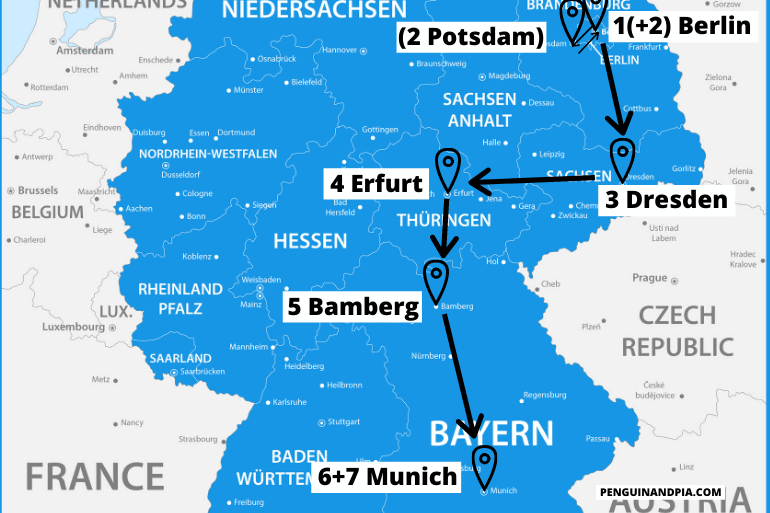
Day 1: Berlin Day 2: Berlin / Day Trip to Potsdam Day 3: Dresden Day 4: Erfurt Day 5: Bamberg Day 6+7: Munich
Day 1: Berlin
Once again, this itinerary begins in Berlin since it is one of the big cities that is easier to get to for people coming from overseas. Similar to the five day itinerary that started in Berlin, you’ll stay two nights in the German capital. There is just too much to see to spend only one day – and even in two days you wouldn’t be able to explore everything.
In case you’ve already been to Berlin on a different trip and/or aren’t a huge fan of big cities, we also give you the option of a day trip to Potsdam (a city close by) on the second day. More on that below.
Accommodation in Berlin : Finding a place to stay in Berlin can be tough because there are just so many options. You can check here for accommodations and hotels in Berlin .
If you have a car, check out Park Plaza Wallstreet Berlin Mitte . Located right in the middle of the city close to Museum Island, this hotel has a great breakfast and free parking on the street behind the hotel. Otherwise, parking is paid but for a decent price for the city centre.
Those without a car travelling by train should see the NH Collection Berlin Mitte am Checkpoint Charlie . If you want a hotel close to a top attraction that is easy to get to with public transport, this is definitely one of them!
Across the city, PLUS Berlin is a really good hostel/hotel that Eric stayed at a few years ago. It’s a big place but it was a great stay over by the East Side Gallery (part of the Berlin Wall with the graffiti on it).
As already mentioned above, if you want to read some more about Berlin, check out our articles on Things to do in Berlin and How to spend one day in Berlin .
Day 2: Berlin / Day Trip to Potsdam
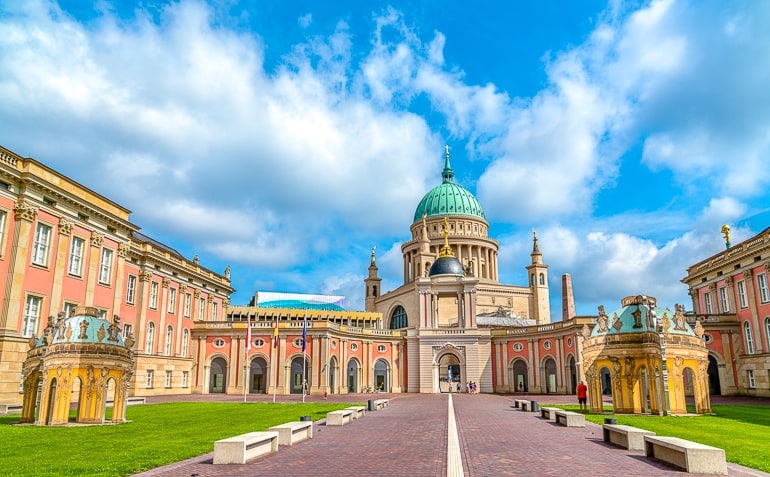
On your second day, you can choose between spending another day in Berlin to see more of the German capital or going on a day trip to Potsdam – which is a smaller city not far from Berlin.
Potsdam is actually the capital city of the German state called Brandenburg. It’s most popular attraction is probably Sanssouci Palace with the beautiful Sanssouci Park surrounding it.
During our visit, we also enjoyed walking through the Dutch Quarter with its small shops and cafes. Since the city isn’t too big, one day gives you a chance to get a good impression and check out some of the more popular sights.
It is also very easy to get to Potsdam from Berlin. If you decide to drive , it’ll take you approx. 40 minutes , but it could be longer – traffic depending. We would honestly recommend that you do this day trip by taking public transport. This way, you don’t have to worry about traffic and/or finding a parking spot.
For trains, you can take the S-Train #7 (S7) from Berlin Central Station (as well as other train stations) straight to Potsdam Central Station. The journey will take around 35 minutes with trains running very frequently throughout the day.
Must-see Attractions in Potsdam:
- Sanssouci Palace
- Dutch Quarter
- Cecilienhof
Day 3: Dresden
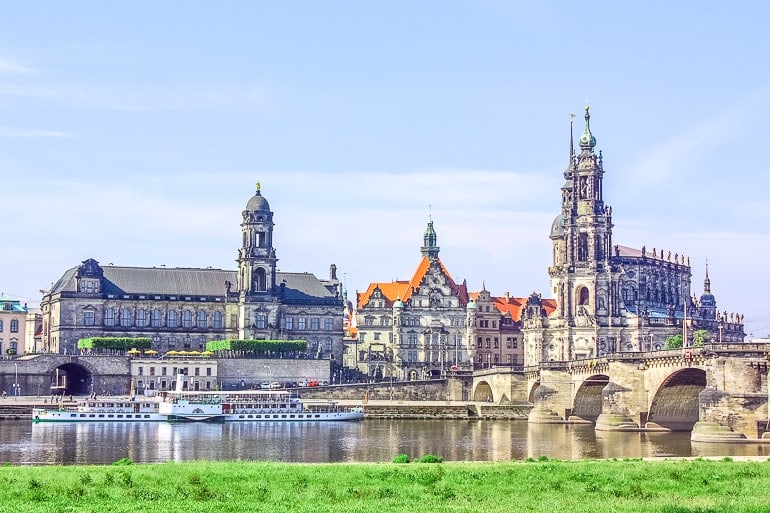
The third day of this Germany itinerary will take you from Berlin to Dresden which is a German city close to the Czech border. To be honest, we haven’t spend that much time in Dresden yet – and it’s certainly on our list of places to visit this year.
One of the city’s main attractions – the Zwinger – is known across the country and a sight that you shouldn’t miss during your visit. It’s a beautiful palace built in a baroque style.
Fun fact: When Lisa was a kid, she didn’t actually know that the “Zwinger” was a palace. Since that word can also mean “dog kennel” in German, she was always confused as to why people would want to visit it during their time in Dresden!
As for getting from Berlin to Dresden, the drive will take you around 2 hrs 10 minutes by car and around 2 – 3 hours by train. Once again, this depends on which connection you choose.
Accommodation in Dresden: There are a number of accommodations in the compact “Innere Altstadt” close to the River Elbe for you to choose from. You can check here for accommodations and hotels in Dresden .
For a great hotel option right in the old town, look no further than the Star Inn Hotel Premium Dresden im Haus Altmarkt . You’re a short walk to the train station, the river, and all the best old sights in Dresden if you stay here and arrive by train. If you come to Dresden by car, the hotel has discounted underground parking available.
Another option right in the old town (and even closer to the river) is Aparthotel am Schloss . Since this is an apartment-style hotel, it’s a great option if you are looking for more of a base to relax in a “home away from home”. It’s a very popular choice, too – and also has onsite parking.
Must-see Attractions in Dresden:
- Frauenkirche
Day 4: Erfurt
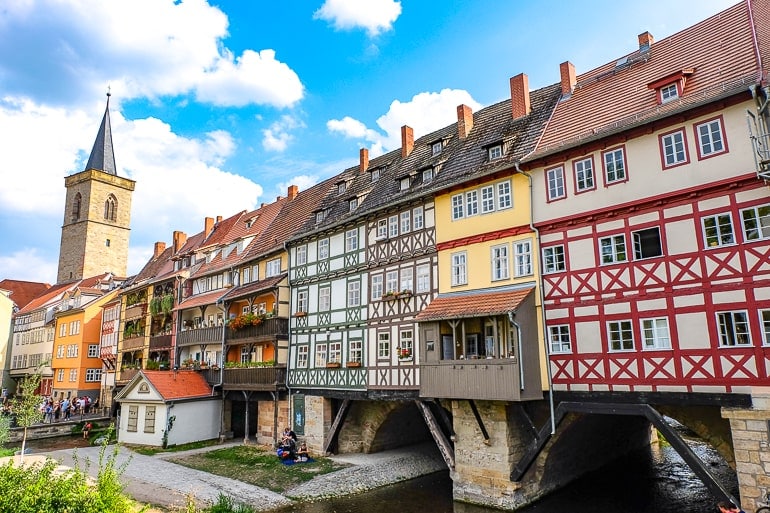
Erfurt is a popular city to visit in the middle of Germany – and it’s also the capital city of the German state Thuringia. We’ve spent some time in Erfurt a few months ago and instantly fell in love with the city. Its size is perfect (in our opinion) – giving you enough things to do without feeling overwhelming.
Maybe you’ve seen photos of one of the city’s most popular attractions, the Krämerbrücke. This bridge is not only pretty to look at and photograph, it’s also unique in the sense that there are buildings on the bridge and when you’re walking on it, you can’t actually see the water running below.
Visiting the bridge and climbing the tower of the Ägidienkirche, a church at one end of the bridge, is something we’d certainly recommend during your time in the city. We actually filmed a short video of our time exploring Erfurt. If you are interested in seeing what parts of the city look like, then you can find our video here .
Getting to Erfurt from Dresden won’t take you too long. It will take approx. 2 hours 20 minutes by car and between 2 and slightly over 3 hours by train .
Accommodation in Erfurt: Since Erfurt isn’t a huge city, there aren’t a ton of accommodations – but certainly more than enough to find one that works for your style and budget. You can check here for hotels and accommodations in Erfurt .
We stayed at Gästehaus in der Gotthardtstraße and really liked our stay. It’s located in a quiet neighbourhood just north of the city centre – a short walk to the Krämerbrücke. The host was lovely, the room was cozy, and there was secure onsite parking for those driving to Erfurt.
If you want to stay RIGHT in the city centre then you should check out Hotel Krämerbrücke Erfurt which is right beside the famous bridge. This might be a good place to stay if you are travelling to Erfurt by train and you’re on-foot.
Must-see Attractions in Erfurt:
- Krämerbrücke
- Erfurt Cathedral
- Citadel Petersberg
For more details, have a look at our Things to do in Erfurt article .
Day 5: Bamberg

Bamberg is a small city – or larger town – in the German state called Bavaria. It’s actually located in a region called Franconia, which is noticeably different from the Bavaria that you might know in the area surrounding Munich, etc.
We’ve been to Bamberg multiple times over the years (it’s also close to the part of Germany where Lisa grew up) and are always happy to come back. Bamberg is known for its cute, historic old town which is actually a declared UNESCO World Heritage Site.
One of the most popular buildings the city has to offer is the Old Town Hall (shown above) which is built on an artificial island. The story behind it is quite interesting.
The drive from Erfurt to Bamberg is doable and will take approx. 2 hrs by car and around 3 hrs by train . On the way, you’ll drive through quite a few tunnels since you’ll drive through an area known as “Thuringian Forest”.
Accommodation in Bamberg: Bamberg is a small place to visit so there aren’t a ton of options but still enough to find what you’re looking for. You can check here for accommodations and hotels in Bamberg .
Anywhere you stay is basically in or close to the old town/city centre. For a place to stay with parking (for those arriving by car), check out Welcome Hotel Residenzschloss Bamberg . It’s located right on the river.
You might also want to see Palais Schrottenberg to stay right in the middle of the Old Town! For reference, the train station is a short walk to the north of the river – not far from these places in the centre.
Must-see Attractions in Bamberg:
- Bamberg Cathedral
- Old Town Hall
- Alte Hofhaltung
If you want some more information about Bamberg, please read our detailed Bamberg, Germany Guide .
Day 6+7: Munich
From Bamberg, your journey will continue to Munich which will be the last stop on this 7 day eastern itinerary. Not only is this the third biggest city of the country, it is also one of the most internationally known destinations in Germany.
Whenever we come back to Munich, we always enjoy our time there. For some reason, the atmosphere always feels more laid back than in other big German cities and the people are usually quite friendly. We might also be a little bit biased, though, since Lisa grew up in this part of the country and is more used to the mentality, dialect etc. than in other parts of Germany.
For this itinerary, you’ll spend two days in Munich since there is quite a lot to see. Next to the obvious attractions like the Marienplatz with the New Town Hall and the Frauenkirche close by, there are also lots of museums and other things that you can explore.
If you’ve already been to Munich before and/or decide that one day in the city is enough for you, you could also opt for a day trip on one of these days. We’ve just recently written a whole Day Trips from Munich Guide , which you can browse through to get some inspiration!
Driving from Bamberg to Munich will take about 2 hrs 20 minutes by car and between 2 and 3 hrs by train . If you decide to only take regional trains instead of the ICE (fast train), you should look into getting the Bayernticket. This can save you some money, especially when you’re travelling with more people.
Accommodation in Munich: Since Munich is so large and popular to visit, there is definitely no shortage of places to stay! You can check here for accommodations and hotels in Munich .
That said, we loved our stay at H2 Hotel München Olympiapark . Located up by the famous Olympic Park, we’d highly recommend it since it was amazing value for money. The breakfast was huge and delicious and there’s a metro station outside the lobby door that takes you into the heart of the old town in minutes. There’s also parking if you are arriving by car.
For a hotel that is a little more central, you should see the Platzl Hotel Superior this hotel is really popular – and for good reason. It’s located around the corner from attractions like Marienplatz and the famous beer hall, Hofbräuhaus.
For more help looking into accommodations and neighbourhoods in Munich, check out our where to stay in Munich guide .
(Check out our guide to one day in Munich if you want more details on things to do and see.)
Germany Itinerary 10 Days
Although we have tried to create short itineraries that allow you to see more than just the standard cities, it is no doubt easier to see more of Germany if you are able to travel for longer than one week. To give you a couple different options that you could look at (and then potentially modify), we have created two 10-day Germany itineraries.
Once again, we believe that ten days would not be enough time to see the whole country – and even if you managed to do that it would be too stressful (in our opinion). Both of the following itineraries give you a good mix of bigger and smaller cities as well as a few interesting day trips. So, have a look and see which one you like better!
Germany Itinerary 10 Days – North
If you’re interested in seeing more of the northern part of Germany and experiencing the mentality and way of life of people in the flatter part of the country, closer to the sea, then have a look at the following 10-day itinerary!
The total driving time would be slightly less than 17 hours with a distance of approx. 1470 kilometres. For these calculations, we have included the day trips to Schloss Drachenburg, Lübeck, and Flensburg. So, if you decide to skip any of these, your driving time and distance would obviously be slightly lower.
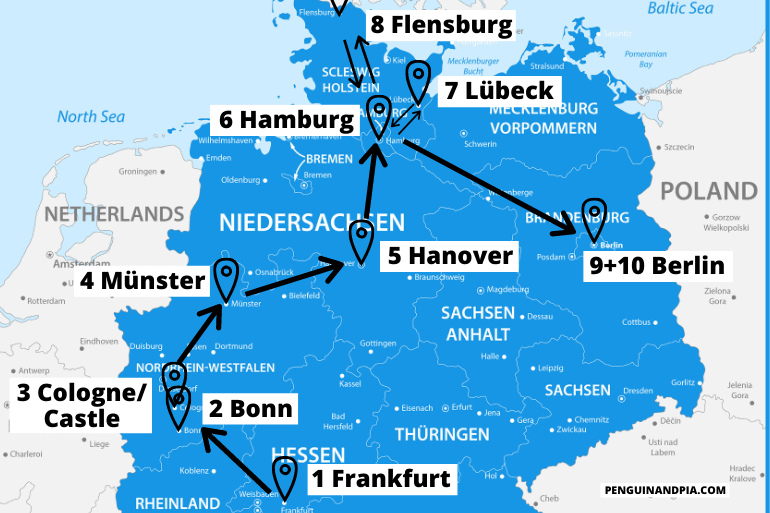
Day 1: Frankfurt Day 2: Bonn Day 3: Day Trip to Schloss Drachenburg / Cologne Day 4: Münster Day 5: Hanover Day 6: Hamburg Day 7: Day Trip to Lübeck Day 8: Day Trip to Flensburg Day 9+10: Berlin
Day 1: Frankfurt
Similar to some of the other itineraries mentioned in this article, we start this 10-day itinerary in Frankfurt. By now you should probably already know why – Frankfurt has the biggest airport of the country which should make it easier for people coming from overseas to get to Germany and start their adventure.
Furthermore, Frankfurt is quite centrally located so it is easy to get to many different cities from here. So even if you decide against following our itineraries step-by-step, Frankfurt would be a good starting point!
— Compare prices from rental car companies in Frankfurt here
Accommodation in Frankfurt : You’ll find plenty of places to stay in Frankfurt. You can check here for accommodations and hotels in Frankfurt .
One really popular hotel in Frankfurt is the Motel One Frankfurt-Römer . This Motel One is near the river and walking distance to lots of things in the city centre. If you are coming to Frankfurt with a car, Motel One has underground parking which can make life easy! They also have a nice breakfast.
A hotel option closer to the train station is Fleming’s Express Hotel Frankfurt . This hotel is just to the north of the main station which makes it a great option if you are arriving by train and have no car. It’s popular because it has a great breakfast and is good value for money.
Day 2: Bonn
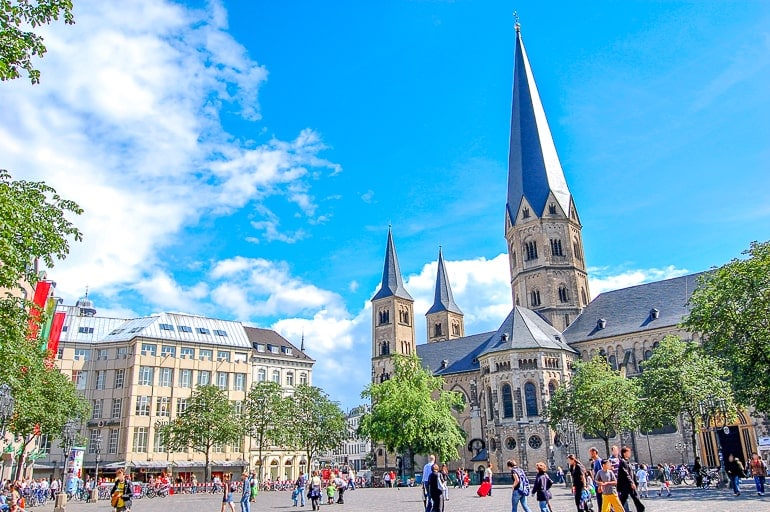
On the second day, you’ll head from Frankfurt to Bonn. As you might know, Bonn used to be the capital of the Federal Republic of Germany during the time that Germany was split into two countries. Later, the capital was relocated from Bonn to Berlin.
If you are interested in learning more about the history of Germany during your time in the country, then Bonn would be a good city to do that in. For example, you could visit the so-called “Haus der Geschichte” which is a museum about the history of the Federal Republic of Germany.
It won’t be difficult to get from Frankfurt to Bonn since the two cities are not too far apart. The journey will take approximately 1 hr 50 minutes by car and between 1 hr 20 minutes and 2 hrs if you take the train . Once again, we’d recommend that you book your train ticket in advance if possible.
Accommodation in Bonn: There are a number of accommodation options in Bonn which you can choose from – many are right in the city centre/old town. You can check here for accommodations and hotels in Bonn .
Keep in mind to book your accommodation for two nights for this itinerary. (You could also spend the following night in Cologne if you day tripped to there, though).
For a great hotel in the heart of the old town, check out BrauHotel Bonn . You can easily walk here from the central train station but they also have a and parking garage close by if you arrive by car. There’s also a craft beer bar on the ground floor!
Another option is the Hilton Bonn . This hotel offers you amazing views of the Rhine River. It’s a bit north of the city centre but still very much close to it. There is parking but it can be expensive so keep that in mind when you book.
Must-see Attractions in Bonn:
- Bonn Minster
- House of the History of the Federal Republic of Germany (Haus der Geschichte)
Day 3: Day Trip to Schloss Drachenburg / Cologne
On day three of this itinerary, you can choose to stay in Bonn, or go on one of two day trips: to Schloss Drachenburg (a castle not far from Bonn) or to Cologne which is also close by.
Schloss Drachenburg is actually a private villa/mansion that was built to look like a castle in the 19th century. Today, it is a popular attraction in the area.
From Bonn, you can either drive to Königswinter by car (and then leave your car at the car park) or take public transport to the Königswinter/Clemens-August-Straße station. You can find more information about that and opening hours etc. on the offical website .
If you are not a huge fan of castles, then you might opt for a day trip to Cologne instead. In this case, you might even decide to change your base and spend the night in Cologne instead of returning to Bonn at the end of the day. That is definitely an option that you can choose since there are lots of accommodation options in Cologne as well.
Getting to Cologne from Bonn will take you around 40 minutes by car (this can obviously depend on traffic) and only approx. 25 minutes by train . Just a quick warning: Trains can get very full if you are travelling during rush hour traffic – so try to avoid that if you don’t like being surrounded by lots of people in a small space.
Day 4: Münster
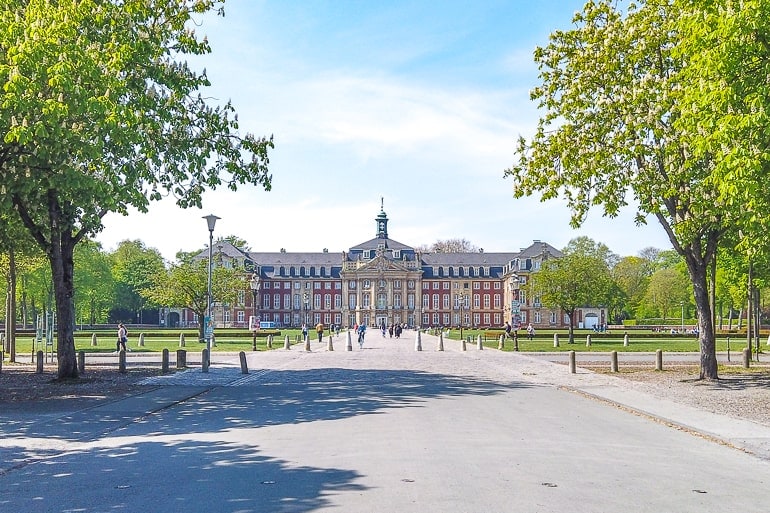
The next day you’ll head from Bonn – or Cologne – to Münster. Since Bonn and Cologne are so close, the journey wouldn’t really differ much from either city.
Münster is a smaller German city that we really enjoy. To be honest, it sometimes reminds Lisa of Copenhagen – mainly because of the many bikes that you can see all around the city. The University of Münster plays a big role in the city and the vibe – depending on which part of the city you are in – is noticeably younger.
One of the highlights of the city – for locals and visitors alike – is the lake Aasee which is located quite centrally. When the weather is nice, there are always people sitting on the grass enjoying the sun and maybe even out on the water (depending on the time of year). You can rent a small paddle boat to explore the lake from a unique perspective.
The journey from Bonn to Münster should take you slightly less than 2 hrs by car and between 2 hrs and slightly more than 3 hrs by train . If you want to save some money and are travelling with other people, then you should look into getting an “NRW Schönes Tag Ticket”. With this ticket, you wouldn’t be allowed to travel on ICE’s (the fast train), but the connections using only regional trains wouldn’t be much longer.
Accommodation in Münster: Münster might feel small but it’s actually pretty spread out and offers accommodations for all styles and budgets. You can check here for accommodations and hotels in Münster .
If you want a popular hotel option right in the centre, the H4 Hotel Münster is a short walk to the heart of the historic centre. It also has onsite parking for those travelling to Münster by car – but you can easily walk there from the train station in the south of the city centre.
Must-see Attractions in Münster:
- Münster Prinzipalmarkt
- Historic Town Hall
- Münster Cathedral
For a more detailed guide, have a look at our Things to do in Münster, Germany article .
Day 5: Hanover
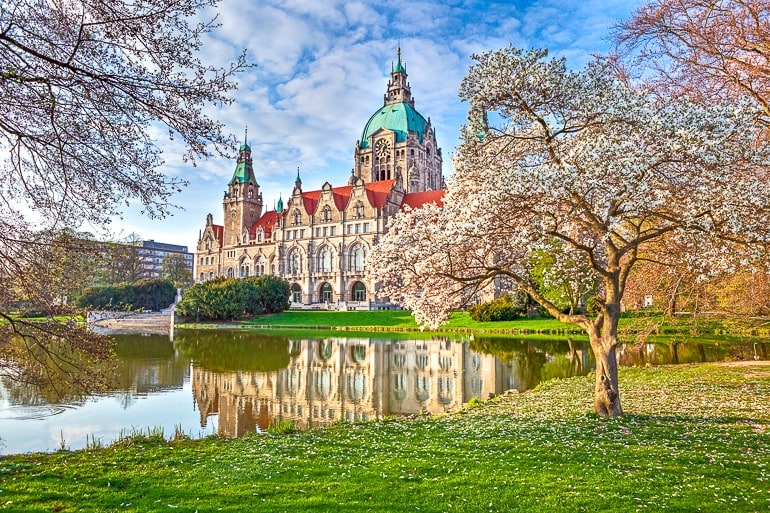
The following day you are travelling from Münster to Hanover. In German “Hannover” is actually written with two “n”, so don’t be surprised if you see it being written slightly differently.
Hanover is the biggest city and the capital of the German state called Lower Saxony. Compared to some other cities on this itinerary it is a less popular tourist destination. To be fair, even we haven’t spent that much time in Hanover yet. Hopefully we’ll be able to change that soon. However, that’s not to say that Hanover is not worth a visit.
Not only can you explore some beautiful gardens and interesting museums in the city, but it is also located pretty much halfway between Münster and Hamburg. That makes it a great stop to break up the journey and spent another day in a city that allows you to explore without too many other (international) tourists around.
By car , the journey from Münster to Hanover will take you around 2 hrs . If you choose to travel by train instead, it will take you approximately the same amount of time .
Accommodation in Hanover: Hanover is a larger city but the accommodation are still relatively packed together in and around the historic city centre. You can check here for accommodations and hotels in Hanover .
For a stay right in the city centre, check out the Hotel Loccumer Hof . This popular hotel is a very short walk from the central station which is perfect if you are arriving to Hanover by train. That said, they also have parking onsite so this hotel works well if you arrive by car!
For another hotel option, check out the Arthotel ANA Prestige am neuen Rathaus . This boutique hotel is directly across from the beautiful New Town Hall in the south end of the city centre by the greenspace and water! They also have a really nice breakfast and parking available.
Must-see Attractions in Hanover:
- New Town Hall
- Marktkirche
- Herrenhausen Gardens
Day 6: Hamburg
On day six of this 10-day itinerary you’re on your way to Hamburg. If you’ve read the details of any of the shorter itineraries in this article, you’ll know that we really like Hamburg.
The city offers modern areas, such as “HafenCity”, mixed with historic (e.g. “Speicherstadt”) and alternative areas (“Sternschanze”) . This makes exploring the city all the more interesting – there is truly something for everyone. During your time in the city, we’d also recommend that you climb the tower of the St. Michael’s Church. From up there, you get a beautiful view of most parts of the city.
The journey from Hanover to Hamburg won’t be long. Depending on the route you are taking (Highway A7 or A1), it’ll take between 1 hr 30 minutes and 2 hrs by car . If you opt for the train , you can expect the journey to take between 1 hr 15 minutes and 1 hr 30 minutes . This depends on the connection you choose.
Accommodation in Hamburg : Hamburg has many, many places to stay. You can check here for accommodations and hotels in Hamburg .
The Mövenpick Hotel Hamburg might be a good option if you have a car while you travel around Germany. This cool hotel is inside an old water tower which gives guests stunning views of the city around. There’s also parking onsite and it’s close to a transit stop for getting around the city.
Located not too far from the central train station, ARCOTEL Rubin Hamburg makes for a good hotel option if you don’t have a car. It’s located in St. Georg which is a lively area within walking distance of the city centre.
Those that need hostel for their stay in Hamburg might be happy with Generator Hamburg . It’s a popular hostel in the city and is close to the train station for easy getting around. If you’re unsure about where to stay, you can always check out our detailed guide on where to stay in Hamburg .
Once again, if you’d like to read our (very) short Hamburg guide, you can find our Things to do in Hamburg article here .
Day 7: Day Trip to Lübeck
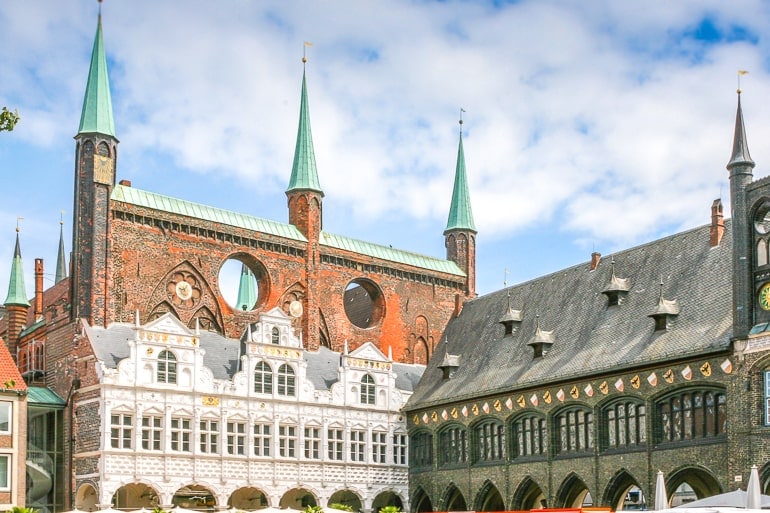
For the next couple of days, we decided to include some day trips from Hamburg. This allows you to stay in one accommodation for longer than just one night and gives you the option to see some more of Hamburg as well. If you don’t want to visit any other cities and want to spend more time in Hamburg instead, then feel free to skip one or both of the day trips mentioned.
Lübeck is the closer one of the two day trips mentioned from Hamburg. Within Germany the city is mainly known for its delicious “Lübecker Marzipan” (Lübeck Marzipan) – but of course there is much more to the city than just that. One of the highlights is the Holsentor, a red-brick city gate dating back to the 15th century.
The journey from Hamburg to Lübeck will take you slightly over 1 hr by car and just around 45 minutes by train . In our opinion, that’s great for a day trip since it gives you lots of time to actually see the city instead of spending a lot of time in the car/on the train.
Must-see Attractions in Lübeck:
- Marienkirche
- Heilig-Geist-Hospital
Day 8: Day Trip to Flensburg
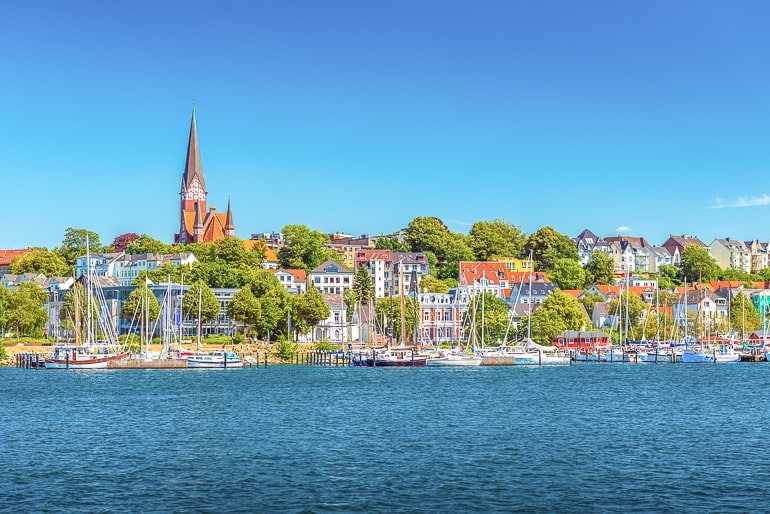
For the following day, we have another day trip option for you. The journey to Flensburg is slightly longer than to Lübeck – but it would be worth it. Flensburg is a smaller German city in the north of Germany, very close to the Danish border.
Since it is located close to the water, shipping plays an important role in the city to this day. If you’re interested in learning more about that, then the Maritime Museum would be a good place for you to visit.
Another thing we would recommend is a walk along the Rote Straße. Here you’ll find different “Hinterhöfe” (similar to backyards) with cute cafes and small shops.
Getting to Flensburg from Hamburg should take slightly less than 2 hrs by car and the same amount of time by train . As already mentioned, it would be a longer journey than to Lübeck, but if you want to experience a smaller, maritime city, the trip would be worth it!
Must-see Attractions in Flensburg:
- Historischer Hafen (Historic Harbour)
- Flensburger Schifffahrtmuseum (Maritime museum)
- Museumsberg Flensburg
Day 9+10: Berlin
On the second to last day of this itinerary, you’ll head from Hamburg to Berlin where your journey ends. This allows you to spend two days in the German capital. Since there is so much to do in Berlin, we’d recommend that you do some research beforehand to narrow down which attractions you’d like to visit.
If you’ve never been to Berlin before classics like the Brandeburg Gate and the Reichstag would be a good place to start. We’ve written a few different articles about Berlin – one about classic attractions (link below). Maybe these will be a good starting point to gather some more information!
The drive from Hamburg to Berlin will be one of the longest mentioned as part of this itinerary – so you should keep that in mind. It’ll take approximately 3 hrs 20 minutes by car (with traffic it could be longer), but just 1 hr 50 minutes by train .
It’s a popular train route since it connects the two biggest German cities so trains run frequently throughout the day. Once again, we’d recommend to book your train ticket in advance to get one of the discount tickets and save some money.
Accommodation in Berlin : As the capital city, there are lots of accommodation options for Berlin. You can check here for accommodations and hotels in Berlin .
Those travelling to Berlin with a car should look into the Park Plaza Wallstreet Berlin Mitte for a hotel in the city centre with free street parking available. There’s always paid parking for a reasonable fee if those are full and you’ll be close to top attractions.
The NH Collection Berlin Mitte am Checkpoint Charlie is a popular hotel option for those coming to Berlin by train since it’s close to attractions in the city centre and you can get there very easily with the metro.
Finally, if you need a hostel/hotel, check out PLUS Berlin . This is where Eric stayed a few years back and really enjoyed it. You’ll be close to the East Side Gallery – the part of the Berlin wall with the artwork on it. It’s also easy to get in and out of the city centre from here.
Also feel free to have a look at our guide on Berlin Attractions and tips for a day in Berlin .
Germany Itinerary 10 Days – South
This 10 day Germany itinerary begins and ends in Frankfurt – so it’s pretty much a small loop through the southern part of the country. If you want to be closer to the mountains (for part of the trip at least) instead of the sea, then this itinerary might be better suited for you than the other 10 day version.
For this itinerary, the total driving time would be slightly over 17 hours with a total distance of approx. 1330 kilometres. This includes the day trips to Neuschwanstein Castle, Garmisch-Partenkirchen, and Tübingen. So depending on if/how you modify the itinerary, these estimates could differ.
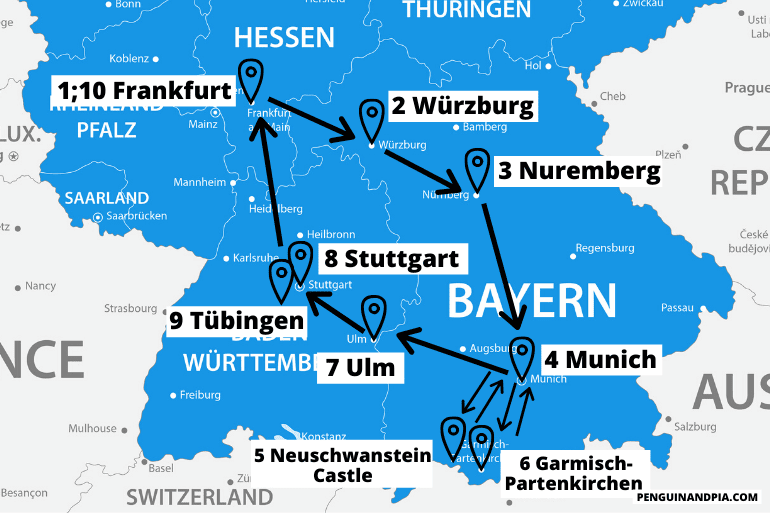
Day 1: Frankfurt Day 2: Würzburg Day 3: Nuremberg Day 4: Munich Day 5: Day Trip to Neuschwanstein Castle Day 6: Day Trip to Garmisch-Partenkirchen Day 7: Ulm Day 8: Stuttgart Day 9: Day Trip to Tübingen Day 10: Frankfurt
Similar to the northern version of this itinerary for 10 days, you begin your adventure in Frankfurt. During your day in the city, you shouldn’t forget to visit the Römerberg with the beautiful half-timbered houses. If you want to get a nice few of the city from above, then you should look into visiting the Main Tower as well.
Frankfurt is also a great place to pick up your rental car – if you decide to complete this itinerary by car instead of using public transport. You can either pick up a car at the airport or at different spots in the city centre. This obviously also depends on the rental company you choose.
Accommodation in Frankfurt: Frankfurt is full of accommodation options – from the city centre to the airport. You can check here for accommodations and hotels in Frankfurt .
For a hotel in the heart of the city, check out the Motel One Frankfurt-Römer . Complete with underground parking, good breakfast, and a top location in the centre and close to the river, this hotel is a decent option if you are travelling around with a car.
For those not travelling with a car (and taking the trains around Germany), check out Fleming’s Express Hotel Frankfurt . This nice looking hotel is really popular for its breakfast, price, and the fact that it’s steps from the central train station.
Day 2: Würzburg
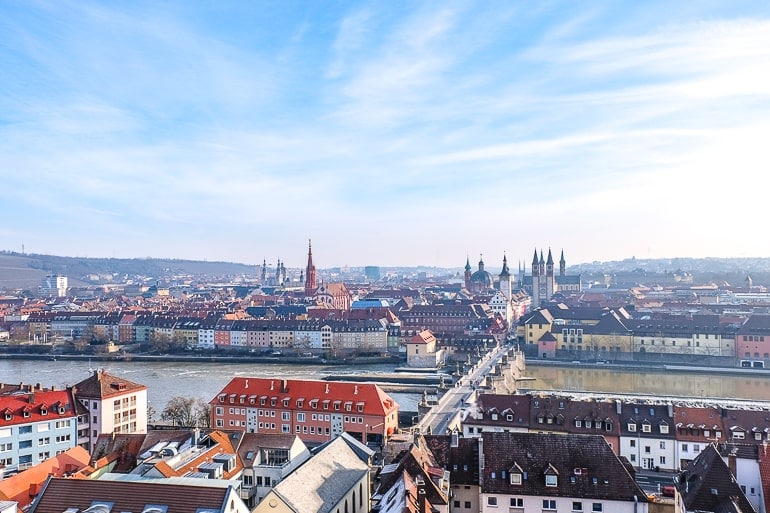
On day two of this itinerary, you’ll be on your way to Würzburg, a small German city that we’re always happy to return to. Similar to Stuttgart, Würzburg is located in a region that is known for its wine.
As such, it comes as no surprise that a highlight in Würzburg is to drink a glass of (white) wine on the Old Bridge across the Main river. We’ve done that multiple times and would especially recommend it during the evening when it gets dark.
Another thing you shouldn’t miss in Würzburg is the short walk up the hill to Marienberg Fortress. Up there you can not only explore the old fortress, but you also get a beautiful view of the old town and other parts of the city.
We actually wrote a whole guide about Würzburg (link below) where we not only talk about things to do but also mention some great cafes and restaurants!
The drive from Frankfurt to Würzburg will be a short one. It should only take you around 1 h 20 minutes by car and between 1 h 07 minutes and 1 hr 50 minutes by train depending on the type of train you’re taking (ICE vs. regional train).
Accommodation in Würzburg: Würzburg isn’t a huge city so you’ll find a number of places to stay packed together in the city centre and a number of other hotels and guesthouses around. You can check here for accommodations and hotels in Würzburg .
On a recent trip, we stayed at the Best Western Hotel Würzburg-Süd . It’s a little south of the city centre but the tram stop is right outside the hotel so you’re into the historic city centre in minutes. There is also an onsite parking lot if you’re arriving to Würzburg by car. We booked this one last minute but we would stay again.
If you want to stay a little more central, then you can check out Hotel Strauss . With a location close to the river, the train station, and the city centre – it’s a great option fo those arriving by train.
We also once stayed at Hostel Babelfish for a budget accommodation and it was honestly not too bad, either. It’s right across from the train station for easy access in and out of the city.
Must-see Attractions in Würzburg:
- Marienberg Fortress
- Würzburg Residence
If you want more tips for visiting Würzburg, have a look at our detailed Things to do in Würzburg Guide (+ insider tips) .
The next day you’ll be on your way to Nuremberg, which is another city in Bavaria that we really like. In German, Nuremberg is actually written/called “Nürnberg” – just an FYI, so you’re not confused when you see this written somewhere.
As we have already mentioned in the description of one of the shorter itineraries, there is a lot of history to be found in the city. Not only can you explore an old castle in the middle of the city, you can also learn a lot about Germany’s dark history if you’re interested.
Getting from Würzburg to Nuremberg will take approx. 1 hr 20 minutes by car and between 53 minutes (ICE) and 1 hr 13 minutes (regional) by train . If you’re travelling with more people and decide to just take a regional train, look into getting a “Bayernticket” as that could save you some money.
Accommodation in Nuremberg : Nuremberg is a larger and well-travelled city in Germany so you will have no problem finding a place to stay! You can check here for accommodations and hotels in Nuremberg .
We ended up staying in the very popular Five Reasons Hotel and Hostel and we enjoyed our stay. The room was bright with new furnishings. It’s also located just inside the old city walls so we were close to the metro, a short walk to central train station, and also close to the heart of the old town!
Very nearby was the Sheraton Carlton Nuremberg – we had friends stay there. They really liked this hotel which had a swimming pool with city views and other great perks. If you are arriving to Nuremberg by car, there’s a parking lot across the street from the hotel as well as street parking around. The train station is very close as well so it’s a great location overall.
- Documentation Center Nazi Party Rally Grounds
Day 4: Munich
On day four of this Germany trip, you’ll be on your way to Munich. As you might know Munich is the capital of the German state called Bavaria and there are lots of things to do in this city.
That’s why you’ll spend three nights in Munich. This way you can explore the city in more detail if you want or go on a couple of day trips from Munich to see other popular attractions as well. It’s really up to you.
The journey from Nuremberg to Munich won’t be overly long and it’s a route Lisa has driven many times. It’ll take you around 2 hrs by car (of course traffic depending) and between 1-3 hrs by train.
Since this is a popular train route, there are lots of different connections of varying length – some are quick and others are slower trains with more stops. Since that’s the case, we’d recommend that you plan in advance and try to catch a better connection to avoid an unnecessarily long train ride!
Accommodation in Munich: Since Munich is such a popular and large city, there are plenty of accommodation options for you to choose from. You can check here for accommodations and hotels in Munich . Just remember to book your accommodation for three nights if you are following this itinerary!
We stayed at the H2 Hotel München Olympiapark which is a very popular hotel because of the price and the value. It was a prefect stay. The breakfast was amazing, they had parking, and the location was great – only a quick metro to the heart of the city centre. You also have the Olympic Park and BMW Museum as top attractions nearby!
If you’re itching to stay right in the heart of the action in Munich, check out the Platzl Hotel Superior . This is a hotel around the corner from Marienplatz in the old town with the famous beer hall Hofbräuhaus just steps away. The central train station is also walkable from here.
Of course, you can learn all about the best areas to stay in more detail with our Munich accommodation and neighbourhood guide .
Learn more about Munich with our one day in Munich post!
Day 5: Day Trip to Neuschwanstein Castle
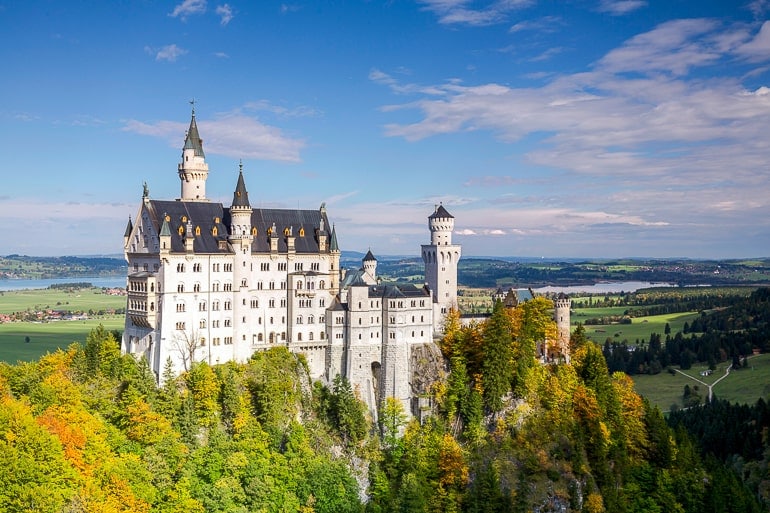
Neuschwanstein Castle probably doesn’t need a lot of introduction – it is arguably one of the most popular day trips from Munich. If you want to see this fairy-tale castle with your own eyes, then this day trip might be for you.
However, it is such a popular attraction that depending on the time of year it can get incredibly crowded. So if you are planning this itinerary for the middle of summer, we’d honestly recommend that you think twice about whether you really want to do this day trip. A second day in Munich wouldn’t be so bad either, would it?
If you are set on visiting Neuschwanstein Castle, then have a look at our Day Trips from Munich Guide . In that article – under the Neuschwanstein Castle section – we talk about all the different ways you can get to the castle.
In case you don’t want to stress too much about logistics and are not travelling with a rental car, you could always look into a day tour that brings you to Neuschwanstein Castle and then back to Munich. Here are some examples:
- Neuschwanstein and Linderhof Palace – A very popular tour to check out two castles in one day!
- Just Neuschwanstein Castle – Grab your live guide and check out the classic castle you came to see!
- Neuschwanstein Castle and Füssen – Explore the surrounding area on this day trip + see that great castle!
Day 6: Day Trip to Garmisch-Partenkirchen
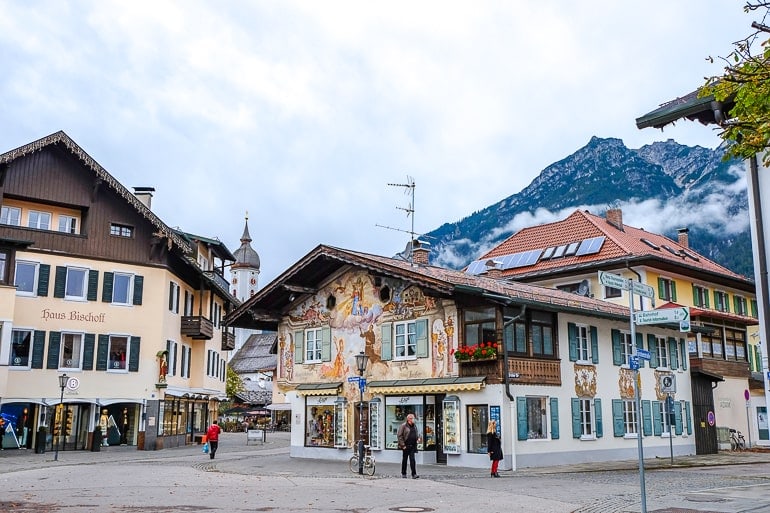
Another popular day trip from Munich – and the one we would recommend for Day 6 of this itinerary – is a trip to Garmisch-Partenkirchen in the south of Bavaria, close to the Austrian border.
We have been to Garmisch-Partenkirchen recently and really enjoyed our day there. However, that was during the shoulder season, so we can’t really say much about how busy it gets in the summer or during the ski-season.
There are a few good reasons for visiting Garmisch-Partenkirchen. The obvious one is that the town is super close to the mountains and it is very easy to reach the “Zugspitze” (Germany’s highest mountain) from here.
Of course, you don’t have to go that high up – there are also lots of other mountains and great hiking trails in the area if you’re looking for a day in nature.
Other reasons why people come to Garmisch-Partenkirchen is to visit the Partnach Gorge which is quite beautiful and/or the old town where you can admire the decorative paintings found on many houses.
It’s actually quite easy to get from Munich to Garmisch-Partenkirchen. By car , it should take you around 1 hr 10 minutes and by train the journey would be approx. 1 hr 22 minutes . It’s actually a nice drive/train ride since you’ll get some great views of the mountains as you get closer to your destination.
Must-see Attractions in/close to Garmisch-Partenkirchen:
- Partnach Gorge
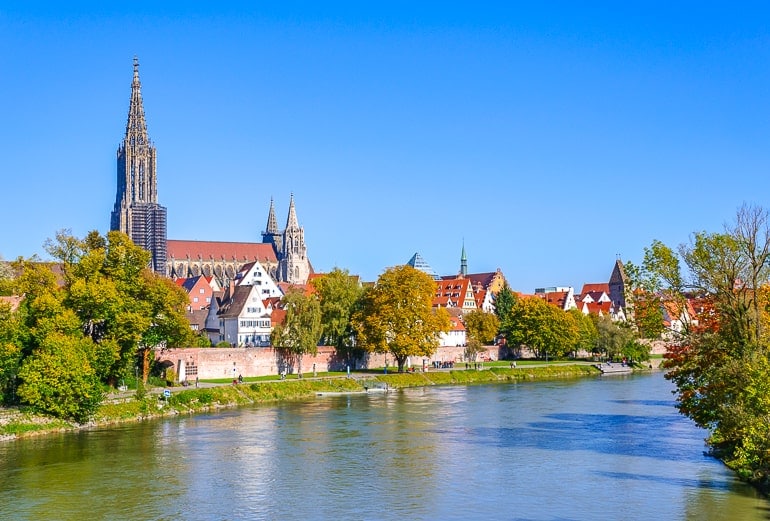
The following day you’ll travel from Munich to Ulm, a small city in the German state of Baden-Württemberg. It is actually located right by the border with Bavaria – “Neu Ulm” in fact is a city on the Bavarian side. When you’re there, it sometimes feels like it is just one bigger city. For you as a visitor, this doesn’t really matter – just an interesting side note.
Ulm is mainly known for having the church with the tallest steeple in the world – so that is something you shouldn’t miss during your visit. Other than that, we’d also recommend that you check out the Fishermen’s Quarter where you can find some beautiful, half-timbered houses.
Getting from Munich to Ulm won’t take you long. The journey will take approx. 1 hr 40 minutes by car and between 1 hr 19 minutes and 2 hrs by train. Once again, this depends on which type of train connection you choose (ICE vs. regional trains).
Accommodation in Ulm: It’s best to stay in the centre of Ulm since it’s not huge and the attractions can mostly be found there. You can check here for accommodations and hotels in Ulm .
For a boutique hotel option right in the city centre, check out Boutique 005 Ulm City . This hotel is super walkable to the train station if you are arriving by train but also offers an option for parking. It’s location makes it really close to all the top attractions in the city.
For a stay closer to the river, you can check out the Hotel am Rathaus – Hotel Reblaus . With onsite parking available and a really good breakfast, this more “authentic” hotel is an experience not to be missed in Ulm.
Must-see Attractions in Ulm:
- Ulmer Münster
- Fishermen’s Quarter
Day 8: Stuttgart
From Ulm, you’ll head to Stuttgart on the next day. Stuttgart is a city that we have mentioned a few times in this article already. If you’ve read some of the other itineraries, you’ll know that Stuttgart is known for both cars and wine.
Of course, there’s more to see in the city than that. If you’re interested in architecture, you might enjoy visiting the New Palace at the “Schlossplatz” and if you’re into art, the Staatsgalerie (an art museum) might be for you.
Getting to Stuttgart from Ulm will only take slightly over 1 hr by car and approx. the same amount of time by train . There are slower trains – called RB instead of RE which stands for “Regional Express” – that take longer than that. However, if you plan ahead, you shouldn’t have a problem catching an RE or ICE Train since they run frequently throughout the day.
Accommodation in Stuttgart: Since there are a number of places to stay in, you can check here for accommodations and hotels in Stuttgart .
Those with a car can check out the Abalon Hotel ideal because it has an underground parking garage while those travelling to Stuttgart by train can check out the Pension am Heusteig since it’s easy to get to walking or with the metro.
Day 9: Day Trip to Tübingen
On day 9 of this itinerary, you have the choice between either spending a second day in Stuttgart or taking a day trip to Tübingen, a university town not far away.
Tübingen is a popular day trip from Stuttgart and is mainly known across the country for its old university. In fact, some of Lisa’s friends have studied there. When in town, you shouldn’t forget to visit the market square with its 15th century town hall. Another popular attractions is the Hohentübingen Castle on the hill which nowadays is home to a museum.
It won’t take you long at all to get to Tübingen from Stuttgart. That makes it great for a (half-)day trip. The journey should only take around 42 minutes by car and between 43 minutes and 1 hr 30 minutes by public transport – depending on the connection you choose.
Must-see Attractions in Tübingen:
- Hohentübingen Castle
- Market Square with Town Hall
- Hölderlinturm
Day 10: Frankfurt
On the last day, you’ll make your way back to Frankfurt. This is where your itinerary ends since it will hopefully be easy for you to get back home from here.
The journey from Stuttgart back to Frankfurt will probably be the longest one for this trip – but it’s still easily doable. It should take you approx. 2 hrs 25 minutes by car and between 1 hr 17 minutes and 3 hrs 30 minutes by train. Once again, this is dependent on the connection you choose (ICE vs. regional trains).
Accommodation in Frankfurt: Since you’re back in Frankfurt, we already went over accommodations in Day 1 of this same itinerary. That said, you can check here for accommodations and hotels in Frankfurt and specifically check out the Motel One Frankfurt-Römer for a central hotel with parking.
Germany Itinerary 14 Days
This Germany itinerary is the longest one that we have for you – for now. If anyone is interested in a 21 day version, please let us know!
The distance you’d cover with this 14 day itinerary would be around 1960 kilometres . The driving time would be approx. 22.5 hours – but of course, this varies depending on traffic and the exact route you decide to take.
As you’ll see below, sometimes the driving time between two cities is longer than 3 hours. So, while this itinerary is totally doable in two weeks – if you wanted to slow down the pace a bit, you could just as easily spend more time in some of the cities and complete the itinerary in more days.
Since you have probably already read about most of these places in some of the itineraries above, we’ll try to keep the descriptions short and not get too repetitive.
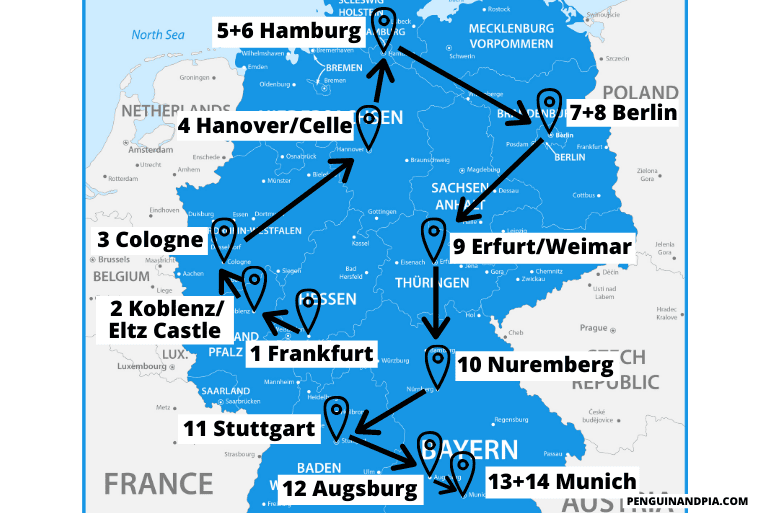
Our version here is written as an “incomplete route” from Frankfurt to Munich. However, as with most of our itineraries, you are welcome to reverse the direction if that works better for you and/or start and end in the same city. So, to see a big part of the country, your 14 day Germany itinerary could look something like this:
Day 1: Frankfurt Day 2: Koblenz / Eltz Castle Day 3: Cologne Day 4: Hanover or Celle Day 5+6: Hamburg Day 7+8: Berlin Day 9: Erfurt or Weimar Day 10: Nuremberg Day 11: Stuttgart Day 12: Augsburg Day 13+14: Munich
Once again we begin this itinerary in Frankfurt since it is an easy city to get to. As we have mentioned before, there are a few things to see in the city so you can start exploring on day one!
Frankfurt is also a great city to pick up a rental car. Since many international (business) travellers fly into Frankfurt, there should be many cars available with automatic transmissions. In smaller German towns you’ll find that this is not always the case.
Accommodation in Frankfurt: If you are making a stop in Frankfurt, you can check here for accommodations and hotels in Frankfurt .
As for accommodation options, the Motel One Frankfurt-Römer has parking available and is located in the city centre close to the Main River. That’s important if you have a car with you but it’s also walkable to the train station, so you know.
Another great hotel option that is even closer to the train station is Fleming’s Express Hotel Frankfurt . This hotel is known for its prime location to the north of the station, its tasty breakfast, nice decor, and fair price. This is definitely a popular place you should at least look into if you are travelling by train around Germany.
Day 2: Koblenz / Eltz Castle
On day two of this itinerary, you’ll be on your way to Koblenz, a small German city on the Rhine river. You can either explore the city or use it as a base to visit one of the many castles close by.
Our suggestion would be a visit to Eltz Castle which is a beautiful medieval castle surrounded by a forest. Please keep in mind that the castle is not open year round. You can check opening hours here .
You could also visit Eltz Castle as a day trip from Frankfurt but then you’d have to return to Frankfurt at the end of the day. This wouldn’t make much sense unless you want to spend some more time in Frankfurt anyway, as Cologne (your next destination) is closer to Koblenz and Eltz Castle than Frankfurt.
The drive from Frankfurt to Koblenz should take around 1 hr 30 minutes by car . If you want to take the train , the journey would take between 1 hr 30 minutes and 2 hrs 15 minutes . From Koblenz, it is only about a 30 minute drive to Eltz Castle.
Accommodation in Koblenz: Since Koblenz isn’t that large, you should have no problem finding and choosing an accommodation that works for you. You can check here for accommodations and hotels in Koblenz .
If you want a popular option right in the heart of the city centre, you should see the Sander Hotel . This hotel is located within walking distance to the rivers as well as restaurants and shops in the centre. If you travel by car to Koblenz, they have onsite parking which is handy. That said, you can also easily walk from the hotel to the train station in minutes.
Day 3: Cologne
The next stop on your 14 day Germany itinerary is Cologne, a city we have mentioned already in some of the previous itineraries. As you might know, the highlight of the city is the Cologne cathedral which is quite an impressive sight. As the city is located on the Rhine river, a boat tour might also be a great activity depending on the time of year you are visiting.
Getting to Cologne from Koblenz takes around 1 hr 15 minutes by car and between 50 minutes and 1 hr 15 minutes by train . The train tracks follow the Rhine river for part of the journey which allows for some beautiful views!
Accommodation in Cologne : There are lots of great places to stay in Cologne. You can check here for accommodations and hotels in Cologne .
We recently stayed at the Lindner Hotel City Plaza which was great value for money. The breakfast buffet is incredible and it’s an easy, short walk into the city centre near the Cathedral. It also has parking available for those with a car.
If you want to stay a little closer to the river and the Old Town, check out the CityClass Hotel Residence am Dom . With many things around to keep you busy – like attractions, food, and/or drinks – you’re just a short walk to the central train station if you stay here.
For those looking for a hostel, Cologne Downtown Hostel was a great stay for Eric a number of years ago. It’s really popular, in a great location, and has a nice rooftop balcony to enjoy.
Day 4: Hanover or Celle
Day 4 of this itinerary will take you to either Hanover or Celle depending on your preference. Celle is a noticeably smaller city/town than Hanover and the two places are only a few minutes apart.
Getting from Cologne to Hanover will take approximately 3 hrs 10 minutes by car and between 2 hrs 40 minutes and 3 hrs 5 minutes by train .
Accommodation in Hanover: Since Hanover is a well-travelled city for people moving around Germany, there are a number of accommodation options in and around the city centre. You can check here for accommodations and hotels in Hanover .
To stay very close to the central train station in the city centre, you should see the Hotel Loccumer Hof . The location makes it great if you are travelling by train and on foot. They also have onsite parking if you are arriving to Hanover with a car!
To the south of this hotel, the Arthotel ANA Prestige am neuen Rathaus is an option right across from the New Town Hall. This hotel has a beautiful, light style and is also close to the water/parks. Complete with breakfast and onsite parking, you can’t go wrong here!
If you want to spend a night in a smaller German city instead, then Celle is a good option as it is not far from Hanover. That will make it easy to reach the next stop on your itinerary without too much of a detour. The journey from Cologne to Celle would be slightly longer and take around 3 hrs 30 minutes by car and 3 hrs 19 minutes by train .
Accommodation in Celle: Celle isn’t that big at all – so there are only a handful of places to stay. That said, there are still some great options. You can check here for accommodations and hotels in Celle .
Of note, check out Hotel Borchers . This hotel – one of only a handful located in the heart of “city centre” is a top pick with a tasty breakfast and an underground car park. You can also walk there from the Celle train station which is located not too far across town.
Must-see Attractions in Celle:
- Celle Castle
- Bomann Museum
- French Garden
Day 5+6: Hamburg
An itinerary across a large part of the country wouldn’t really feel complete without including Hamburg. Since there is quite a bit to see in this hanseatic city, you’ll spend two nights in the city to give you more time to explore.
Getting from Hanover to Hamburg will take you approx. 1 hr 45 minutes by car and between 1 hr 15 minutes and 2 hrs 30 minutes by train . As mentioned before, this varies depending on the type of train connection you choose.
The journey from Celle to Hamburg will be approximately 15 minutes shorter at 1 hr 30 minutes by car . If you opt for the train, you can expect travel times between 1 hr 10 minutes and 2 hrs .
Accommodation in Hamburg : Since Hamburg is a well-travelled city, it makes sense that there are loads of places and areas to stay in. You can check here for accommodations and hotels in Hamburg .
The Mövenpick Hotel Hamburg might work for those with a car since they have onsite parking. This old water tower is a different hotel than you might be used to but it’s a great experience overall.
Something closer to the central station to get to on foot would be the ARCOTEL Rubin Hamburg which is located in St. Georg. This is an area with shops and restaurants and is very much part of the city centre.
Those looking for a budget accommodation can check out Generator Hamburg which is a popular hostel close to the train station. If you’re ever unsure or want more advice, we have a detailed guide on where to stay in Hamburg .
Day 7+8: Berlin
Of course, we couldn’t forget to include a stop in the capital of the country when planning a longer trip through Germany. Since there is so much to do and see in Berlin you will spend two nights there.
This will also give you some more time to recover from all the driving you have done so far on this journey. Getting from Hamburg to Berlin takes approximately 3 hrs 20 minutes by car (obviously traffic depending) and just about 1 hr 50 minutes by train .
Accommodation in Berlin : There are lots of hotel options in Berlin. You can check here for accommodations and hotels in Berlin .
The Park Plaza Wallstreet Berlin Mitte is a good option in the city centre for those coming to Berlin with a car while the NH Collection Berlin Mitte am Checkpoint Charlie is located right at the attraction “Checkpoint Charlie” in the city centre.
A great option for a hostel/hotel where Eric stayed a few years back is PLUS Berlin . You can find it near the famous East Side Gallery which is a very popular attraction to check out.
As mentioned a few times now, we also have more articles on t hings to see in Berlin and a one day Berlin itinerary .
Day 9: Erfurt or Weimar
For the following day you have the choice between Erfurt or Weimar as your next destination. Both are small cities in the state of Thuringia with Weimar being smaller than Erfurt. If you know anything about Martin Luther, an important figure in the Protestant reformation, then you might have heard of one or both of these places before.
If you’re looking for a place with a beautiful old town and some nice churches as well as buildings for you to explore, then we’d really recommend Erfurt. We had a great time during the days we spent there. The city also has some really nice, cozy cafes if that is something that you care about.
Getting to Erfurt from Berlin will take a while – but it is a great stop on the way to the south of Germany. You can expect the journey to take approx. 3 hrs 40 minutes by car and just around 1 hr 50 minutes by ICE (fast train) .
Accommodation in Erfurt: With Erfurt being a smaller city with a smaller central area to explore, finding a place to stay isn’t too difficult. You can check here for hotels and accommodations in Erfurt .
When we visited Erfurt, we booked the Gästehaus in der Gotthardtstraße . This was a simple guesthouse with a nice host and cozy rooms located just a short walk north of the Krämerbrücke. There’s also a small parking lot onsite if you’re coming to Erfurt with a car.
For a stay that is more central, check out Hotel Krämerbrücke Erfurt . It’s located basically right beside the Krämerbrücke making it a great option if you are travelling by train and you’re on foot.
Once again, if you want to learn some more about Erfurt before you visit the city, check out our detailed Erfurt Guide here .
If you instead preferred to learn some more about the well-known German writers Goethe and Schiller – or about Germany’s dark past – then you should plan to visit Weimar instead.
Two of the highlights there are Goethe’s and Schiller’s House – now turned into museums. Close to Weimar there’s also the Buchenwald Memorial which was a former Nazi concentration camp. This was the first KZ-Memorial Lisa ever visited. It was a somber experience, but also an important one in regards to understanding more about Germany’s past.
The journey from Berlin to Weimar will be slightly shorter than to Erfurt – at least by car. It’ll take approx. 3 hrs 15 minutes by car and around 2 hrs 20 minutes by train .
Accommodation in Weimar : There are a handful of places to stay in Weimar since it’s a smaller city – but you still have good options. You can check here for accommodations in Weimar .
In particular, check out Amalienhof Hotel und Apartment . This classic and very popular hotel is just south of the heart of the city centre. It features parking onsite and an excellent breakfast. It’s also not too far to walk to the train station if you are arriving on foot.
Must-see Attractions in/close to Weimar:
- Buchenwald Memorial
- Goethe’s House
- Schiller’s House
Day 10: Nuremberg
On day 10 of your itinerary, you’ll drive – or take the train – from Erfurt/Weimar to Nuremberg. This Franconian city has also been mentioned in some of the shorter itineraries.
The journey from Erfurt to Nuremberg will take approx. 2 hrs 40 minutes by car in a southern direction. The drive from Weimar to Nuremberg will just be a couple minutes longer.
If you decide to take the train, the journey would take between 1.5 hrs and 2 hrs from Weimar and between 1 hr 10 minutes and 1 hr 30 minutes from Erfurt .
Accommodation in Nuremberg : Nuremberg is a city with loads of history and attractions so it’s very popular. As such, you will find hotels and accommodations all over the city – from the old town to the surrounding areas. You can check here for accommodations and hotels in Nuremberg .
We booked a stay at Five Reasons Hotel and Hostel and we would recommend it. You can find the place inside the massive old city walls so the location was great – walkable to the central train station and also to go find top attractions.
On the same trip, friends of our stayed at the Sheraton Carlton Nuremberg . It was close to where we stayed and they really enjoyed it. There’s this great pool on an upper floor with city views as well as a parking lot across the street if you travel to Nuremberg by car. The train station is close as is the old town by walking so it’s great option overall, too.
Day 11: Stuttgart
The following day you will be on your way from Nuremberg to Stuttgart – once again, a city we have mentioned multiple times now during this article. From Nuremberg, it’ll take you around 2 hrs 15 minutes by car and between 2 hrs 10 minutes and 2 hrs 30 minutes by train to get to Stuttgart.
As we’ve mentioned before, if you are driving and have the time, you could take a small detour and stop in Rothenburg ob der Tauber for a stroll through its beautiful old town. We’ll leave that up to you!
Accommodation in Stuttgart: You can check here for accommodations and hotels in Stuttgart .
The Abalon Hotel ideal has parking for those with a car while the Pension am Heusteig is a guesthouse close by but is easy to get to by the metro system if you arrive by train to central station and you are walking.
Day 12: Augsburg
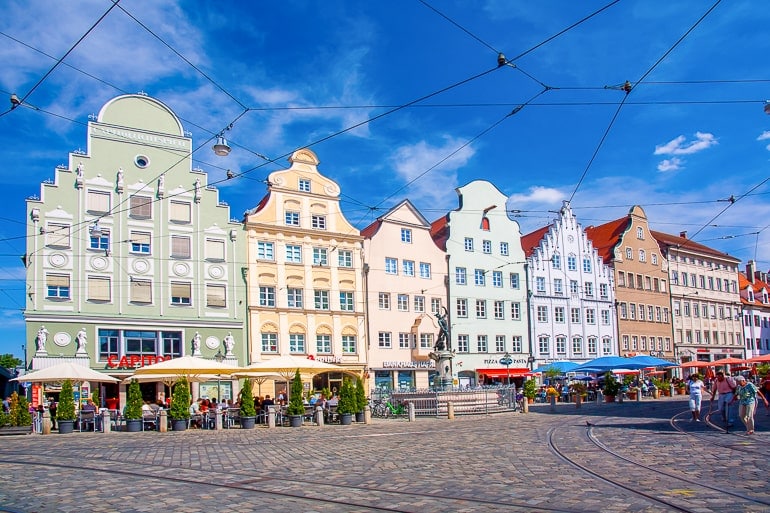
On day 12 you’ll be on your way from Stuttgart to Augsburg, a small city in Bavaria and one of Germany’s oldest cities. Around Germany, most people have heard of Augsburg because of its “Fuggerei” – a historic social housing complex where rent has increased very slowly over the centuries. It’s certainly worth a visit!
It’ll take you around 2 hrs by car to get from Stuttgart to Augsburg. If you opt for the train , then you can expect the journey to take approx. 1 hr 40 minutes .
Accommodation in Augsburg: In Augsburg, you will find a number of places to stay around the city centre. You can check here for accommodations and hotels in Augsburg .
For a reliable stay, check out Hotel Augusta . This popular hotel – located right in the city centre – features breakfast and has parking available if you are travelling to Augsburg by car.
The nice thing about Augsburg is that because it’s a smaller city, you can easily walk to the hotel from the train station if you are arriving by train.
You might also check out City Hotel Ost am Kö which is another hotel in the heart of the centre walkable to the station. It also has breakfast and parking garage right nearby.
Must-see Attractions in Augsburg:
- Augsburg Cathedral
- Perlach Tower
Day 13+14: Munich
On your second to last day of this itinerary you will drive from Augsburg to Munich. That’s the last stop on your two week Germany adventure. In Munich, there is more than enough to see to spend two days in the city.
Munich also has an airport with good international connections in case you’re coming from overseas and need to take a plane to get back home. If that’s not the case, we’d encourage you to see whether the train would be an alternative to get you back home as well.
The journey from Augsburg to Munich should take just less than 1 hr by car and between 30 and 48 minutes by train. So it’s certainly one of the shortest transitions mentioned in this article.
Accommodation in Munich: If you’re exploring Munich while in Germany, there is no shortage of places to stay and areas to check out. You can check here for accommodations and hotels in Munich . For this itinerary, remember to book your Munich accommodation for two nights.
We really liked our stay at the H2 Hotel München Olympiapark . From the really good breakfast, nice rooms, and excellent location with metro access nearby – you cannot beat the price for Munich. There’s also parking available if you’re travelling with a car to Munich.
For a spot right in the heart of Munich’s charming old town, check out the Platzl Hotel Superior . This is a trendy hotel that puts you super close to all the action at busy Marienplatz and is steps from Hofbräuhaus, the beer hall made famous decades ago. You can also catch the metro or walk to the central train station from here.
If you are looking for more details on accommodations in this city, we wrote a detailed guide on where to stay in Munich .
To learn more about the city – as we have mentioned before – check out our post on Munich in a day if you want more details about the city!
And there you have it – one massive Germany guide with more than one Germany itinerary to suit your travel needs! Whether you’re looking for a short 5 day or a wild 14 day itinerary – we’re sure you’ll have a great time exploring Germany. We’re actually really happy to have created this post – Lisa especially. It’s always fun to help others explore your home country!
As always, Happy Germany Itinerary Waddlin’, – L&E
- Compare flights on Skyscanner
- Check for Hotel Deals or Book A Hostel
- Get A Rental Car (depending on the destination)
- Research plug types and possibly get a travel adapter
- Go over our packing list
Pin it for later!
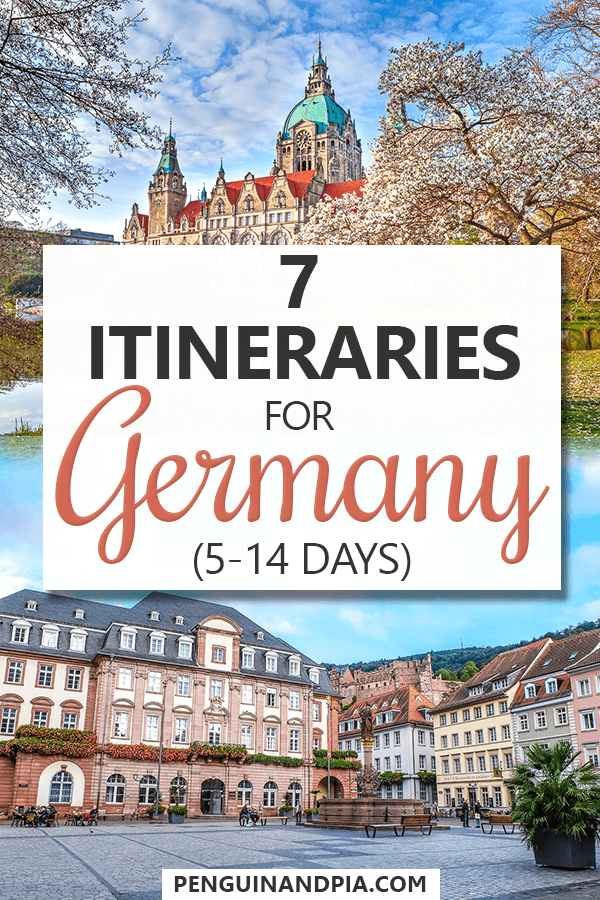
As an Amazon Associate we earn from qualifying purchases.
Destinations
Privacy policy
Disclaimer & Affiliate Disclosure
Terms of use
© 2024 Creativlier Media Inc.
The best way to travel in Germany between cities
Germany has many beautiful places worth visiting. But besides the beauty of the country, it is also one of the largest in the European Union. So what to do if you are planning to travel Germany, to see as many places as possible and all this perhaps even in a very short time?
Don’t waste time by making yourself an overview of how to travel from city to city: Here you can get all the possibilities and the best way to travel in Germany at once.
Traveling by Car
Germany is a nation of car drivers and also car manufacturers. The inventor of the car was German, just as the man who thought out the engine. You know BMW, Audi, Mercedes and of course the Autobahn. The last one is the reason why traveling by car is an excellent opportunity to come around in the Bundesrepublik. The country has one of the largest and also best-equipped highway systems in the world. You can get everywhere by using a car (watch Tom Hanks talking about his experiences on the Autobahn here ). There are many areas where you can drive as fast as you want, and the Autobahn is (still) free of toll. So it is always a good way to get around very quickly – at least if you don’t get stuck in a traffic jam. As an alternative, you can also use the Landstraßen where you can see much more of the countryside.
Mitfahrgelegenheit
If you don’t have an own car, there is the possibility to join a Mitfahrgelegenheit (car pooling). There are many different platforms like blablacar.de on the internet that offer those lifts. They cost about 5 or 6 Euros per 100 Kilometers.
Travelling by Hitchhiking
If you are on a low budget trip, hitchhiking can also be a possibility. Germans are rather open to pick up hitchhikers, and it is common to do. Also, it is mostly very safe to ride with a stranger. But beware: If you are hitchhiking on an Autobahn, only do it from the service areas. It is forbidden to catch rides on the Autobahn itself or the motorway slip. A sign with your direction can be helpful.
Travelling by Bus
A rather new way of traveling in Germany is the so-called Fernbus. These modern and comfortable buses connect almost every major city and also the smaller ones getting better connections every month. Those buses are equipped with Wifi and toilets, but can be very crowded on weekends. But after all, they are a cheap way of coming around. Of course, they are also delicate to get stuck in traffic.
Travelling by Plane
There are many international and even regional airports in Germany, but mostly only the long distances, for example from Munich to Hamburg, are worth flying. Germany is just too small to go by plane inside the country. There are cheaper ways that are also more environmentally friendly. If you are flexible and booking a few weeks before, you can get a domestic flight for about 120 Euros.
Travelling by Train
The German railroad system is very well established. There are not only regional trains but also high-speed trains called ICE that connect the major cities of Germany. Unfortunately, the Deutsche Bahn is rather expensive and has a very complicated pricing system. An excellent way to get a cheap ticket is to have a look on ltur.de . There you can get cheap tickets always from one week before the date of travel. If you are flexible and not fixed on Friday or Sunday, you can get a one-way ticket even all the way through Germany for 27 Euros.
- Tour Account ›
- Travel Forum ›
- Travel Forum
- Car or Train for ...
Car or Train for travel in Germany?
Hi, for four people, would you recommend to rent a car or take the train to visit towns in Germany, maybe also adjacent countries? Thank you!
It depends on which towns and which adjacent countries. But for Germany the answer is usually train.
I have always used trains ( and bicycles ). I can think of several itineraries where a car would be prefered, but realistically, that would be after several trips there.
We lived 6 years in Germany with our own car and loved traveling in the countryside and visiting small towns. Driving in cities was often more of a hassle than it was worth. We used a train enough to get a taste for it.
When we started returning for vacations, we wanted to see towns. We learned to prefer trains. They usually take you right near the old town (Altstadt) centers where we preferred to stay and to sight-see. We have made 19 trips since 2006, all by train.
I would not totally rule out rental cars for a drive into the Alps or similar, but especially as I age, I think we will stick to trains. Better exercise to boot. You can of course combine rental cars with trains.
Thank you for the responses! I was wondering if it was more cost effective (and flexible) to rent a car rather than four train tickets. I understand that within cities cars would be more of a hassle. Do you buy train tickets online? Is this pretty straight forward?
I was wondering if it was more cost effective (and flexible) to rent a car rather than four train tickets. I understand that within cities cars would be more of a hassle. Do you buy train tickets online? Is this pretty straight forward?
Buying train tickets online is very simple. The easiest way is to use the Deutsche Bahn website or app. For the website, just use this link, which is in English: https://reiseauskunft.bahn.de/bin/query.exe/en You can buy a direct point-to-point ticket between cities, but there are also regional offers, like the Bayern pass, which lets you go anywhere in Bavaria on a single day pass (from 9 am till midnight (I think)). And right now there is a special this summer where you can buy a ticket for €9 and travel anywhere using regional (not express) trains for the months of June, July and August.
You can also search for tickets and buy them with the app (called the DBNavigator), which I highly advise. Not only is it quick, but if you keep your credit card info stored on it, you can buy one at the last minute by jumping onto a train, grabbing your phone and buying the ticket. I had to do that in Berlin when only had a minute or two to catch it. I had it paid for in about a minute, and 2 minutes later the conductor came by, so I was able to show him my ticket without paying a huge fine. It's also handy because you can see all of your purchased tickets at a glance. And if you buy tickets on the website, as long as you are logged in to your account, it will add them to the app.
The Man in Seat 61 is a good place to familiarize yourself with train travel in Germany. It tells you about the various trains (ICE, IC, regional, etc.), what kind of tickets to buy, do you really need 1st class (generally, no), and so on. It's a very helpful website.
You can use that to check distances between cities, prices, type of trains, etc. Right now, with car rental prices going through the roof, there is probably no appreciable distance between the two.
I just got back from a month long trip to Germany and used trains almost the entire time without problem. The only time I rented a car was for 4 days in a small town outside of Münster as I was researching some family history and going to some obscure places. But trains will get you just about everywhere.
I usually buy my train tickets from a ticket automat. There was a learning curve the first time or two that I used it. It requests the same input and is about as complicated as this ticket format on Die Bahn. There is an English option.
https://reiseauskunft.bahn.de/bin/query.exe/en
You can use this template to plan a trip and see how it would go.
Usually there are train departures about every hours to a given destination. There are usually discounts for group travel within or between Germany states (Land = State in Germany). You can get steep discounts on faster trains for longer trips by paying in advance. I would use the template above to plan a trip and get a feel for the process.
Cars might seem less complicated but parking, one way streets in town and traffic backups on the autobahns are obstacles. Plus traffic is pretty heavy in Germany; it is easy to find yourself stuck in the wrong lane when moving from one autobahn to another.
I suggest taking the train. Get the tickets for the regional trains from the DB ticket machine, much less stress than having a rental car when those towns you want to see are expected to have lots of tourists thinking the same as you, ie, getting there by car.
I go by train in Germany almost exclusively. By car, when I am driven , only to those small towns and villages in Brandenburg that get only German tourists, if any.
To adjacent countries (Belgium, Denmark, Czech Rep, Poland, etc) the train is the only way to go.
Part 2 here....By train I mean getting around by public transport, train, trams, buses, the S-Bahn and U-Bahn, what is covered in those networks of a city, and if needed, on super rare occasions, taking a taxi.
and in June, July, August of this year you can have unlimited local and regional trains for the entire month for 9€ per person (the whole month, not a single trip) which includes local buses, trams and U-bahn (subway).
The only thing you can't do with that special ticket is use long distance trains which are in types ICE - IC - EC.
So since the car can't compete on price or convenience it can compete on privacy.
You haven't said which adjacent countries you are interested in?
Just returned from Germany where two of us traveled exclusively by train. Costs were €290 for all the trains we took. 30 days, 10 cities. You can compare that to renting a car. We went over into Strasbourg and Luxembourg, also by train. Most cities you would want to be in the city and have no use for the car at all.
We've been renting cars and driving in Germany for 30 years- mostly doing small towns and countryside but we've done drives from Frankfurt to Munich and Berlin to Frankfurt- never had an issue finding parking in the big cities and then we switch to foot or light rail if we're exploring a city-
With 4 people and the baggage, I'd recommend going with a car rental - you'll likely save significantly on time and money being able get up and go when you want to, pull over and divert to sites that catch your eye without having to lean on train schedules.
Trains are great if you're staying in city centers and you travel light, sleeping near the station or grabbing local transport to get around towns..but I always like having a car, even with the recent increase in costs to rent -
Rail service in Germany is extensive, efficient, safe and inexpensive, better in almost every way than in the rest of Europe. If you think Germany's rail system is less than desirable, you probably won't like trains anywhere.
You can of course go pretty much anywhere in Germany by car. Naturally there are fewer train tracks than roads, but that said, you can get almost anywhere you'd like to go in Germany by train. Germany has something like 5,500 train stations. What you need to do however is book within a reasonable distance of the train station, as Craig indicates. It makes no sense to be taking a long connecting bus ride or a taxi every time you need to reach a train station for your next journey.
As for staying in CITIES, I'll respectfully disagree with Craig that it's a pre-requisite for train travel. Thousands of Germany's small towns have rail service and make for great places to stay - or travel bases. Just 80 cities have populations of 200,000 or more. The bulk of those 5,500 rail stations lie in much smaller places. Both commuters and visitors (including me!) board the train in small towns multiple times per week to sightsee or to get to/from school/work.
Large cities are generally very bad places for a car - everything works against you. Traffic, widespread pedestrian zones, parking fees everywhere you go. And of course you're paying for your rental car while it sits idle in a city like Munich or Frankfurt for 3-4 days.
Still, some travelers are just car people. If your concept of travel is firmly tied to the enjoyment you get from driving, and if stopping places that catch your eye is central to your enjoyment, then you really have just one choice. Pulling the emergency-stop handle on a train will not result in the sort of fun sightseeing you had in mind. But spontaneity by train is possible with thoughtful planning. Train travelers CAN build in spontaneous travel if they wish by taking short day trips from a well-located base town (where they leave their bags for the day) to other places of interest near their base town. Hop off the train for an hour somewhere, and an hour or two later, when another one comes along, you hop back on to continue your journey.
When I travel solo in Germany, I always take pubic transport, no use having a rental car unless I am going out to villages, and that would only be seeing them in Brandenburg. I've avoided getting a rental car since I can get a ride out there. Germany's public transport net, a combination of S-U-Bahn, regional trains and buses, is so extensive that you can get just about anywhere. This sort of accessibility precludes the need for a rental car. Plus, I don't want to pay for gas by the liter.
Culturally, it's also an eye-opener (if you want that aspect ) taking public transport to the small towns and villages as regards to the locals.
This topic has been automatically closed due to a period of inactivity.

IMAGES
VIDEO
COMMENTS
3. The German Castle Road. Best for medieval castles and baroque palaces. Mannheim-Bayreuth; approximately 600km (373 miles); allow four to five days. The towns and countryside between Mannheim and Bayreuth retain some of southern Germany's most impressive medieval castles and baroque palaces.
Day 4: Blaubeuren & Munich. Today, you'll drive all the way to Munich. Instead of going the shortest route or following Germany's Romantic Road, though, take the highway A7 south towards Ulm and stop in Blaubeuren. Blaubeuren is famous for the Blautopf, an impossibly blue pond.
A deposit of 800 euro is required to rent a car in Germany and will be held against your credit card until the rental is returned undamaged. It cost an extra 20 euro to add a second driver. Cars are not allowed to travel to Africa; sorry your Germany to Africa road trip is not permitted. I guess people try to smuggle rental cars into Africa.
The German Fairy Tale Road. Frankfurt - Steinau - Marburg - Kassel - Gottingen - Hamelin - Bremen. Distance 660km. Duration 7 days. Drive Time 10 hours. This central to north Germany road trip from Frankfurt does not technically start in the city, but Frankfurt is the perfect place to fly into and pick up a rental car.
The type of rental car you choose for a road trip in Germany depends primarily on how much space you need. An economical car is particularly useful for longer trips. You should calculate beforehand whether unlimited mileage will pay off for your route.. Comprehensive insurance is always important and you may want to register a second driver so that you can take turns behind the wheel.
Renting A Car In Germany. Renting a car in Germany is an easy process. You can reserve a car online or at car rental agencies located at major airports, train stations, and cities. We use Discover Cars to find the best rental cars, and if you can plan ahead you can find great prices. Our advice is to stick with major car companies like Hertz ...
Another good way to save money on the rental car is to book it in advance as early as possible. Early spring can be a good time to visit Germany - statistically, March is one of the cheapest months to rent a vehicle. Despite the common assumption, there are speed limits on about 50% of German autobahns.
From Route 66 to Flower Power and 20.000 Leagues under the Sea, each unit has a story to tell, punctuated by inspired design and vibrant memorabilia. A food truck and a German-style beer garden round up BaseCamp's facilities. From Stuttgart to Berlin, a guide to the best museums and experiences for car lovers in Germany.
The Romantic Road is a 350-kilometer (220-mile) tourist route that runs from Würzburg to Füssen in southern Germany. The route was devised by travel agents in the 1950s to promote tourism in the region. The Romantic Road passes through a number of picturesque towns and villages, including Rothenburg ob der Tauber, Dinkelsbühl, and Nördlingen.
Germany Road Trip Planner. If you're planning a road trip in Germany then you've come to the right place! For over 60 years Auto Europe has been helping travelers plan the perfect trip. From finding the perfect vehicle for a road trip in Germany to route suggestions, handy travel guides, travel tips and more - Auto Europe's award-winning customer service department and savvy web team is here ...
Driving in Germany is part of the vacation experience for many visitors to Europe. Scenic routes lead you through some of the best areas of Germany including the Black Forest and the "Castle Road" where you will travel back in time on a route lined with more than 70 castles and palaces. There are car-lovers' attractions like the BMW factory, a racetrack you can drive on, and international car ...
Traveling to Germany By Train, Bus or Car. Traveling to Germany from other European countries by train, bus or car is easy. Train travel is generally simple, comfortable, and quick. Most train stations in Germany are located in the city center, so it's easy to get to your lodging via taxi or public transportation.
7. Eat Local on Your Road Trip Through Germany. Once you run out of snacks you're gonna need a place to eat! I think this almost goes without saying, but do your best to eat at the local German bars and restaurants. The traditional food here is some of the best in Europe, especially if you're a meat-lover.
In this post, you will find the information to travel to Germany by camper van, car, or RV (motorhome). We tell you our 15-day itinerary in the van, the places we visited, and where we stayed at night—everything you need to know to plan your road trip.. Germany is an amazing country, with big cities, charming towns, fairytale castles, lots of green areas, and many histories.
There are many ways to explore Germany, depending on your itinerary, personal taste, and budget.Find out how you can best travel around the country from renting a car and flying down the Autobahn, to hopping on a plane, to enjoying a relaxing train ride.These are the people that invented the term wanderlust and travel in Germany is proof that it's not always about the destination, sometimes it ...
Here are a few of my top Germany Car Rental Tips/ Things to Know. When driving in Europe, you can expect the majority of cars to be manual transmission. Therefore, if you need an automatic car, you'll definitely want to book ahead. ... Germany Travel Guide, friend, & Germany trip planning bestie. As US Expats living in Germany ourselves who ...
Driving licence laws in Germany. Visitors must be aged 18 or over and hold a full, valid driving licence to legally drive in Germany. Riders of mopeds or motorcycles up to 125cc must be aged 16 or over. Driving licences issued in the UK, the EU and EEA countries are accepted. International driving permits are recognised, but not required.
Lots of good news for your electric car journey through Germany: with around 47,000 e-charging points , Germany is among the top five countries for e-mobility. With good preparation and a fully-charged smartphone or tablet, you can begin your tour by electric car with confidence. Charging on the go is convenient in many places, and it allows ...
So, whether you're looking for the best week in Germany or a Germany itinerary that covers 5 days or 14 days - here's our master guide with 7 detailed Germany itineraries by train and/or by car! We've got cities, attractions, hotels and accommodations, directions, and distances to help you plan the best Germany travel route for you!
The blood-alcohol limit for driving in Germany is very low (.05%), and passengers, but not the driver, are allowed to consume alcoholic beverages in the car. Note that seatbelts must be worn at ...
Berlin - Dresden. Day: 3. 123 miles | 197.907 Km*. Pick up your rental car and drive from Berlin to Dresden where we have arranged your overnight stay, This will allow you a glimpse of the varying charms of Saxony's 1000 years history. Dresden's historical center is located on the left bank of the river Elbe.
Traveling by Car. Germany is a nation of car drivers and also car manufacturers. The inventor of the car was German, just as the man who thought out the engine. You know BMW, Audi, Mercedes and of course the Autobahn. The last one is the reason why traveling by car is an excellent opportunity to come around in the Bundesrepublik.
The legal age to drive in Germany is 18, and you must hold a full, valid driving licence. If you plan to rent a vehicle in Germany, you will likely need to have had your licence for at least 1 to 3 years. Vehicle insurance documents. Always carry your insurance certificate with you in case you're stopped and asked to present proof of insurance.
But for Germany the answer is usually train. Posted by stephen. Greeley, co, usa. 05/26/22 03:20 PM. 2396 posts. I have always used trains ( and bicycles ). I can think of several itineraries where a car would be prefered, but realistically, that would be after several trips there. Posted by Gary Mc. Salt Lake City.
Germany's ADAC automotive club protested against the measure. ... Proponents also argue a limit would lead to fewer accidents, as traveling slower reduces a car's braking distance. It would also ...
In March, the total new plug-in electric car registrations in Germany amounted to 47,400, down 22% year-over-year. The market share decreased to 18.0%.